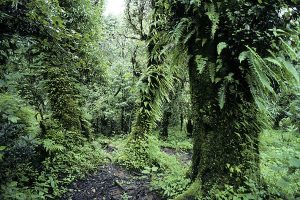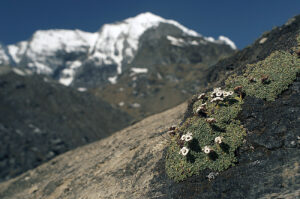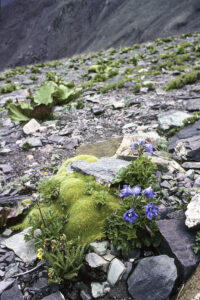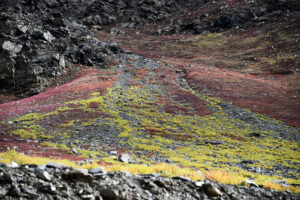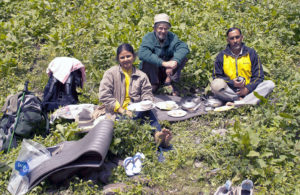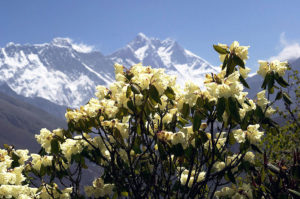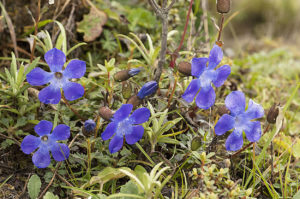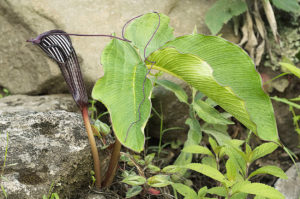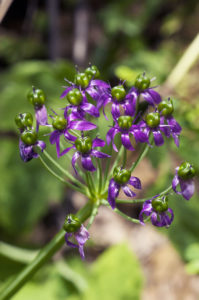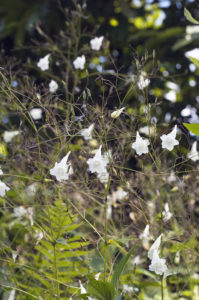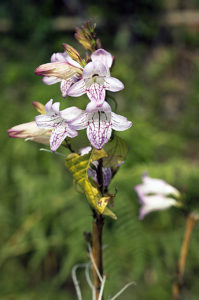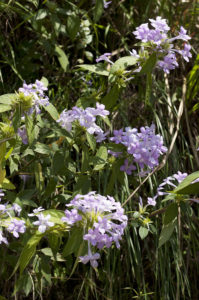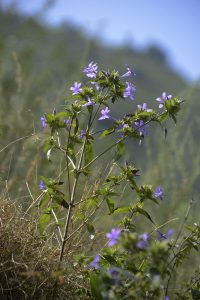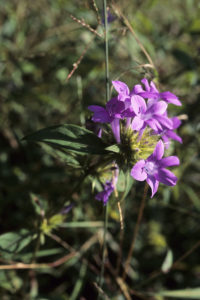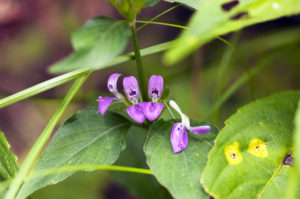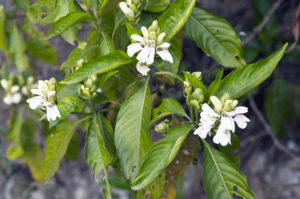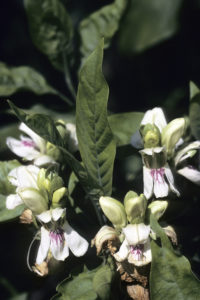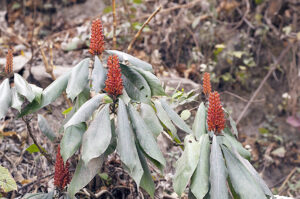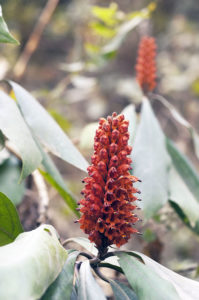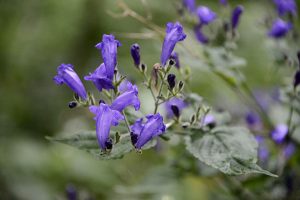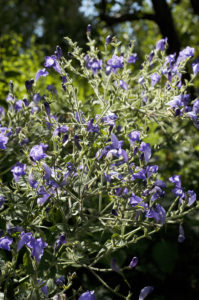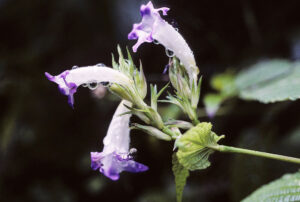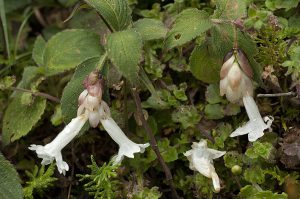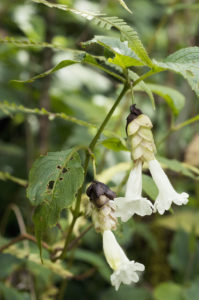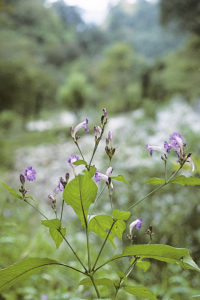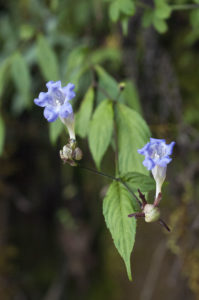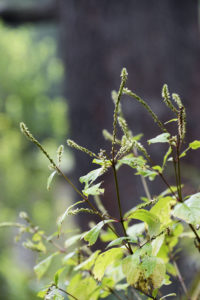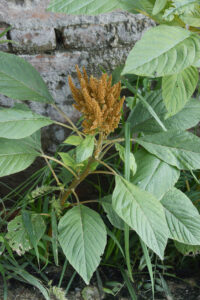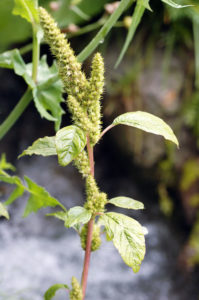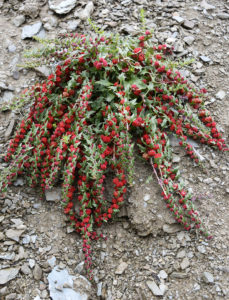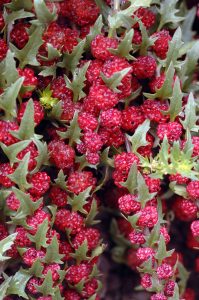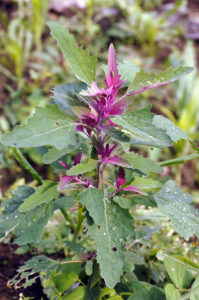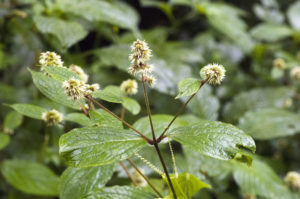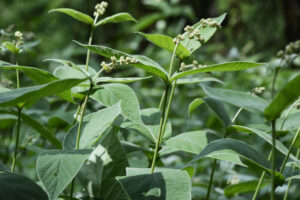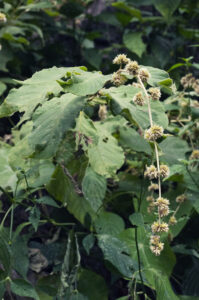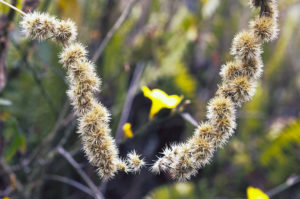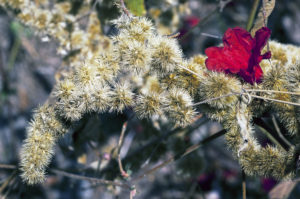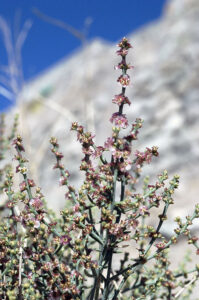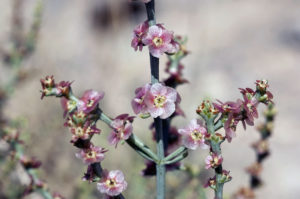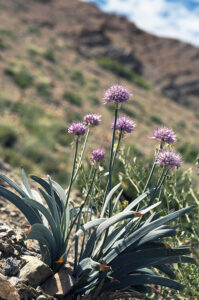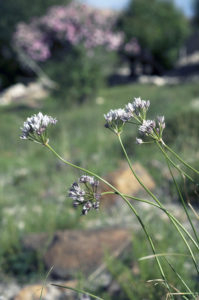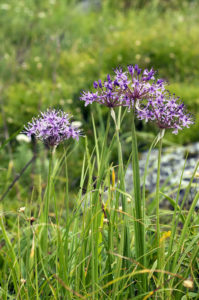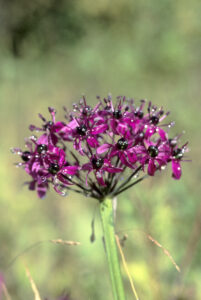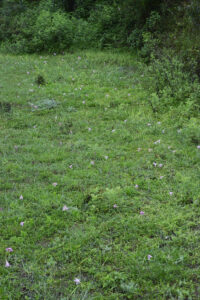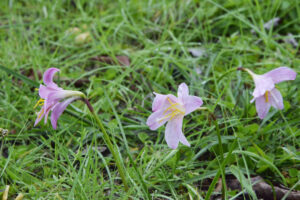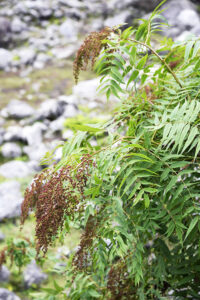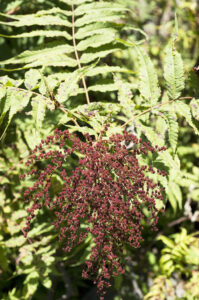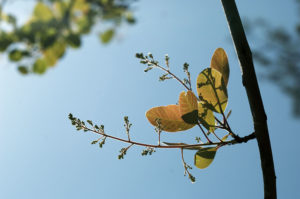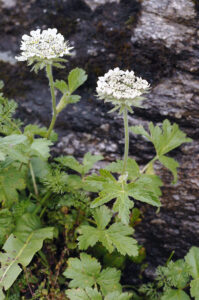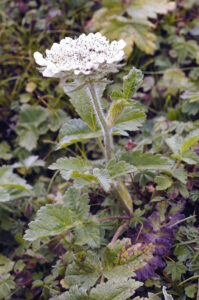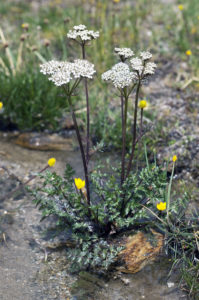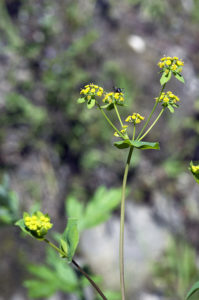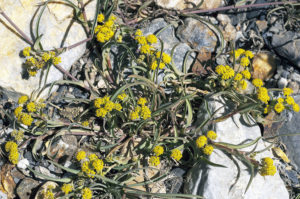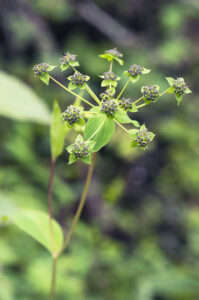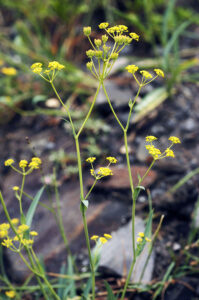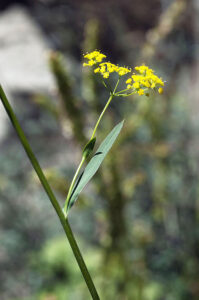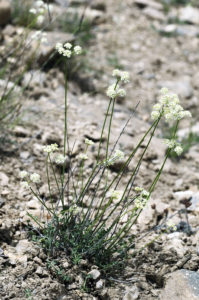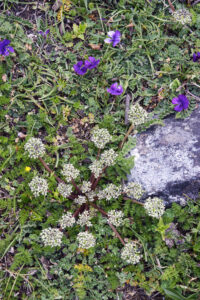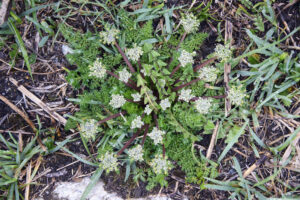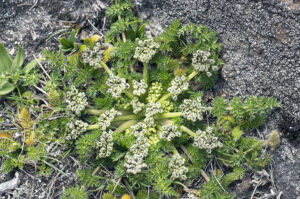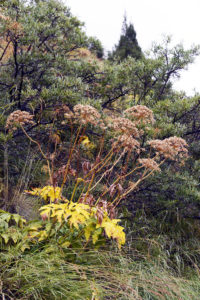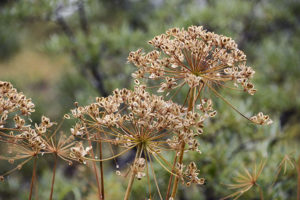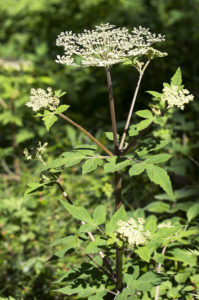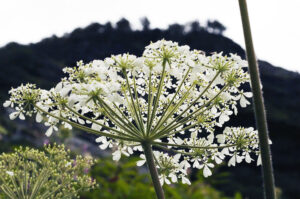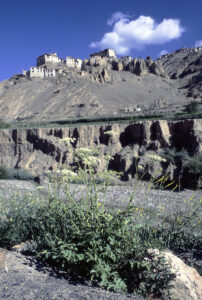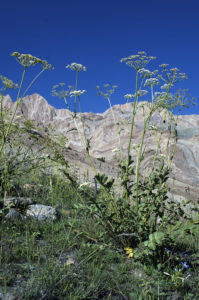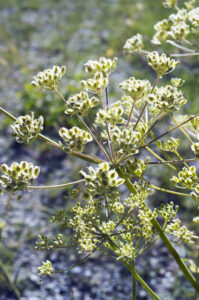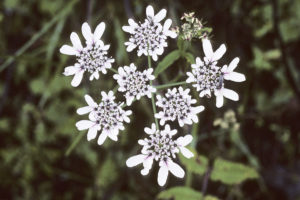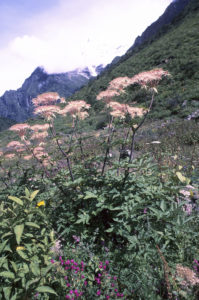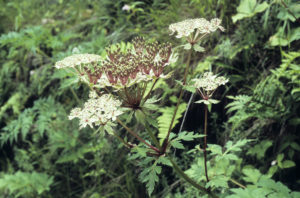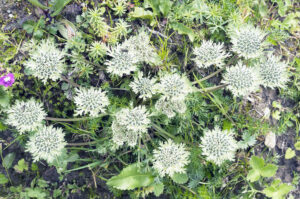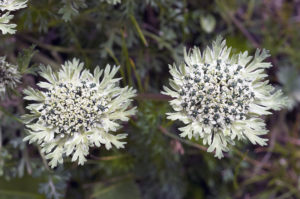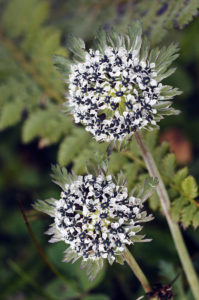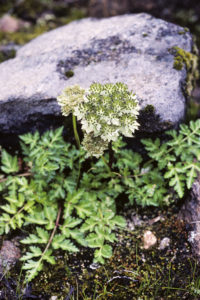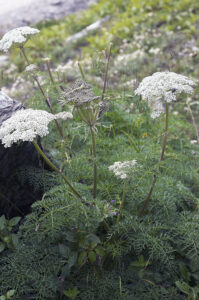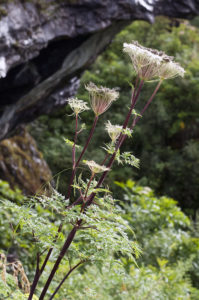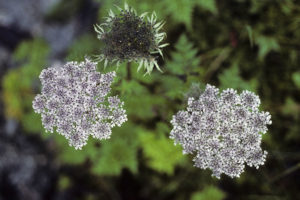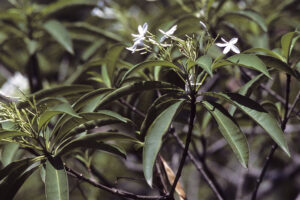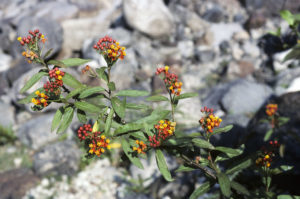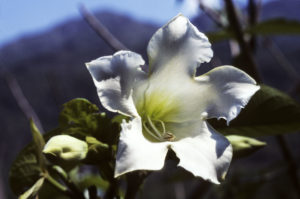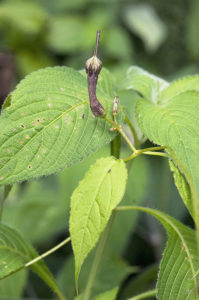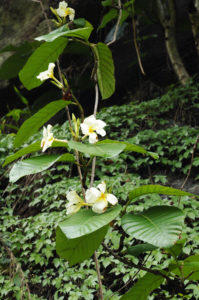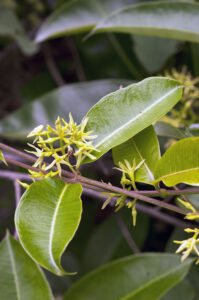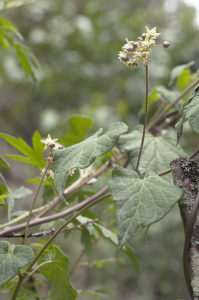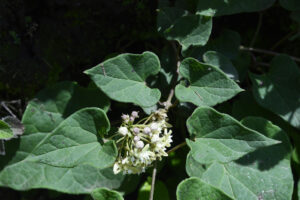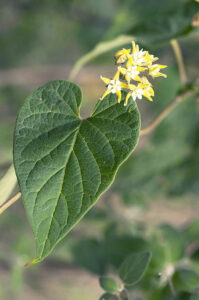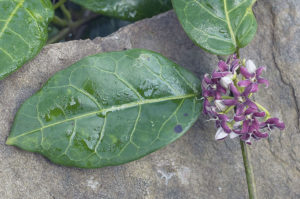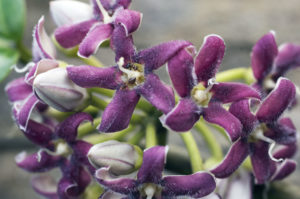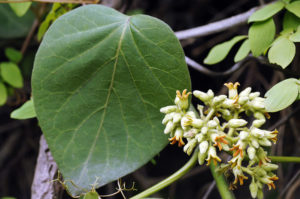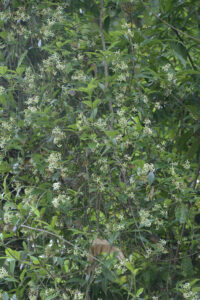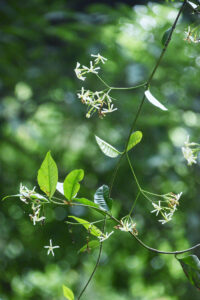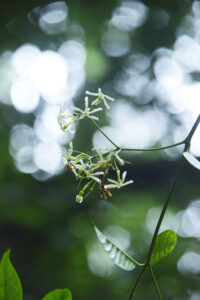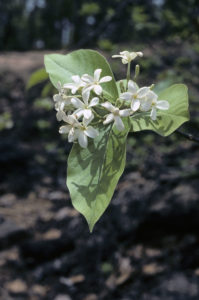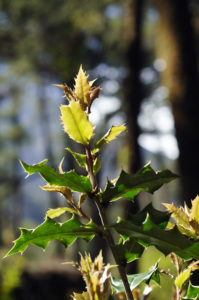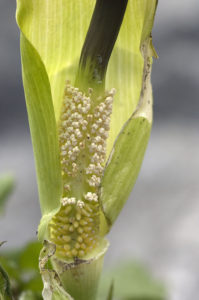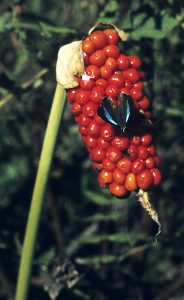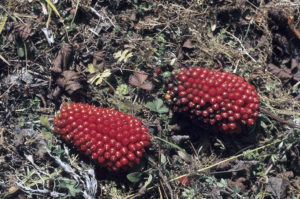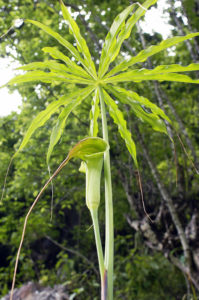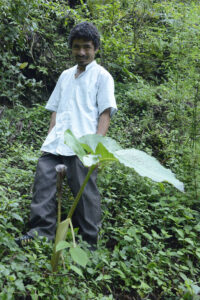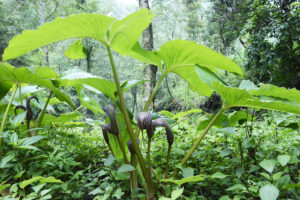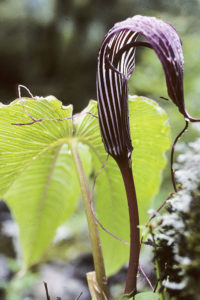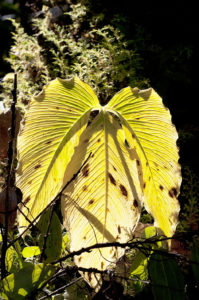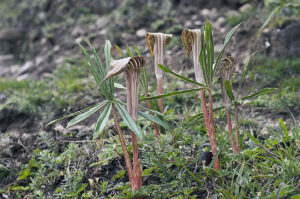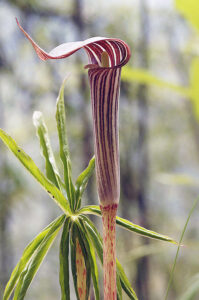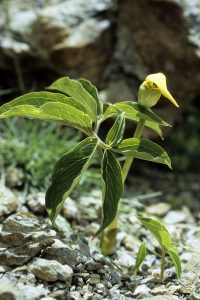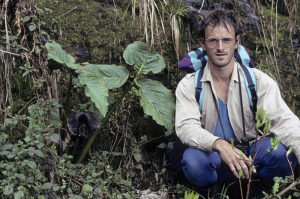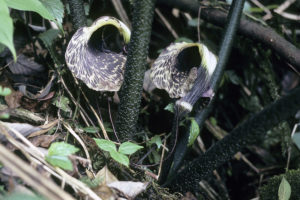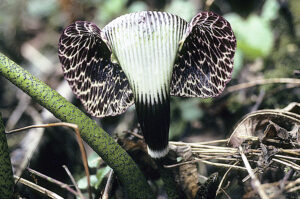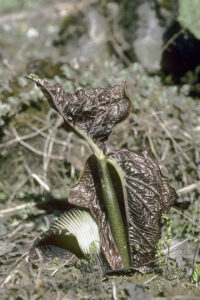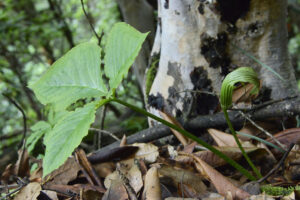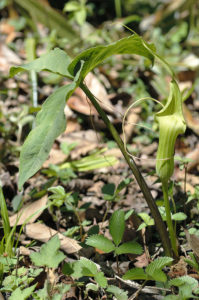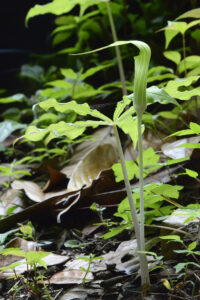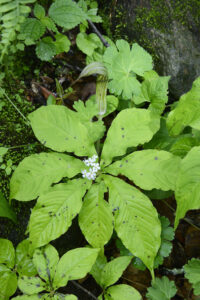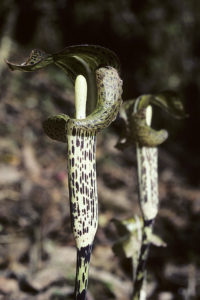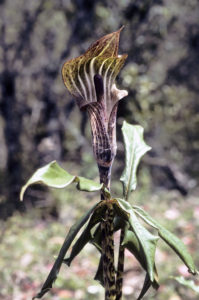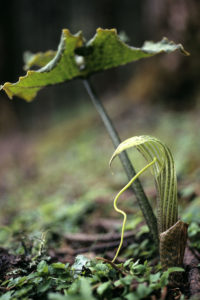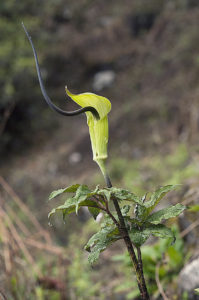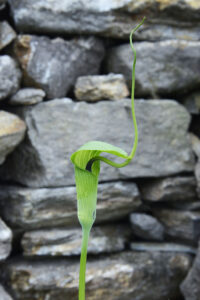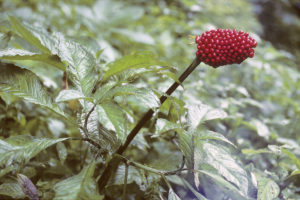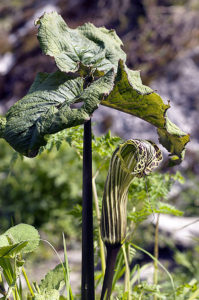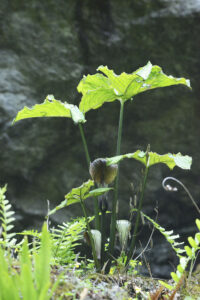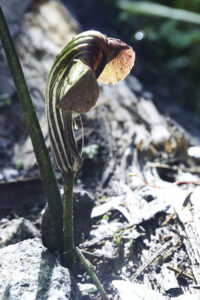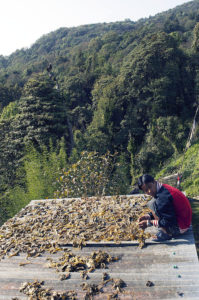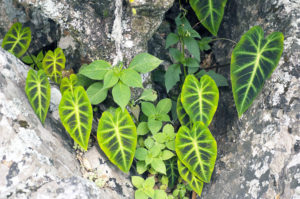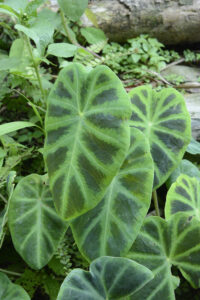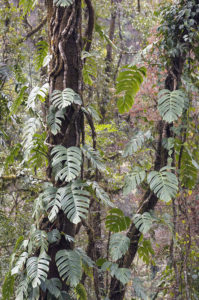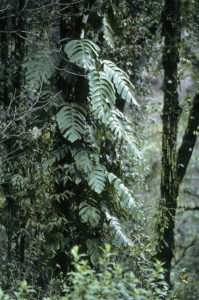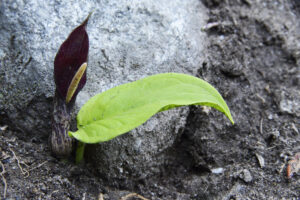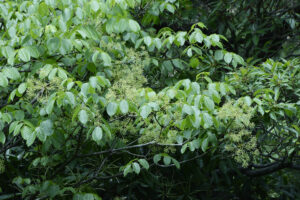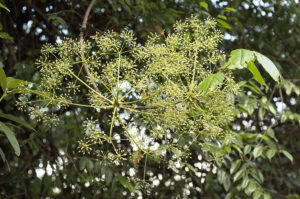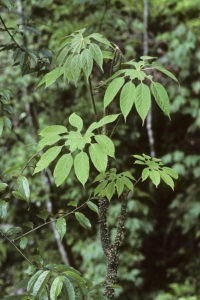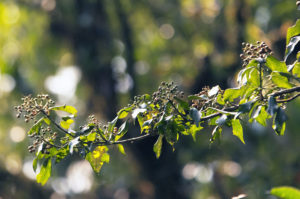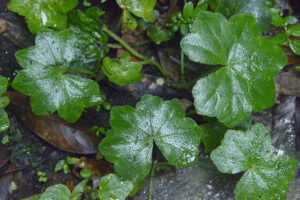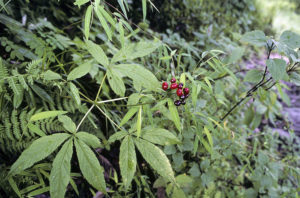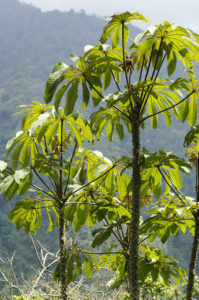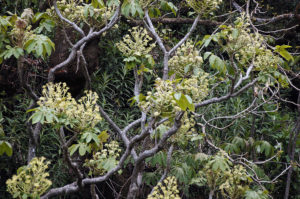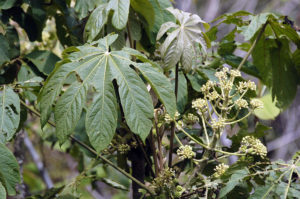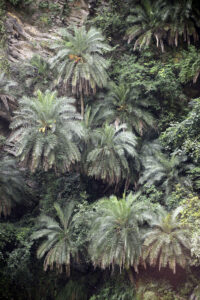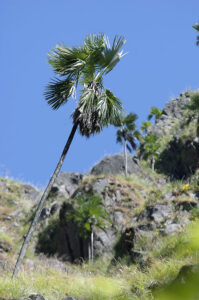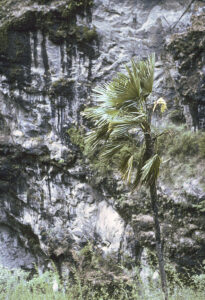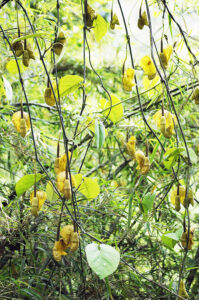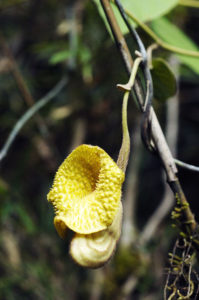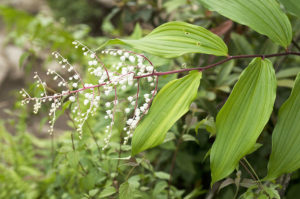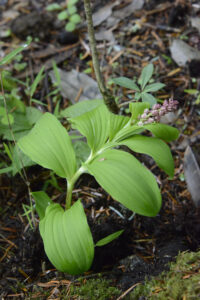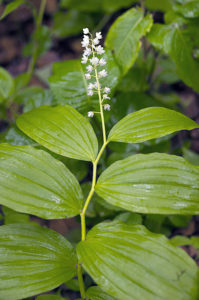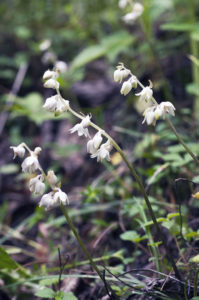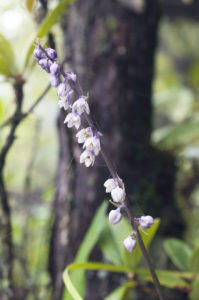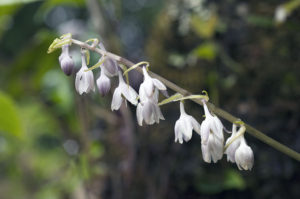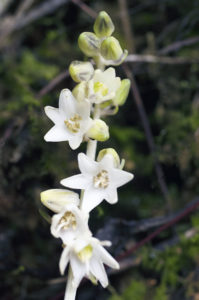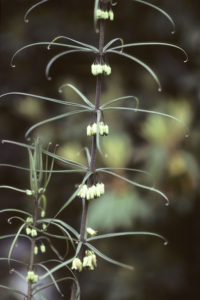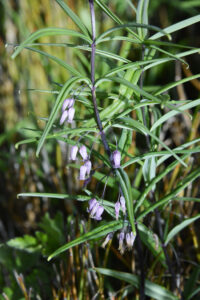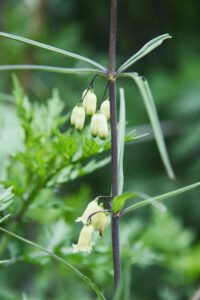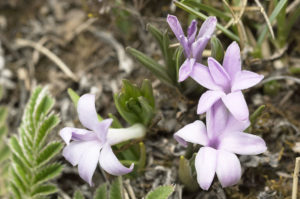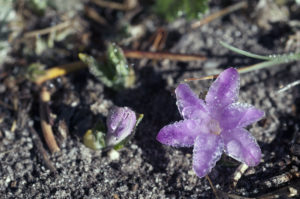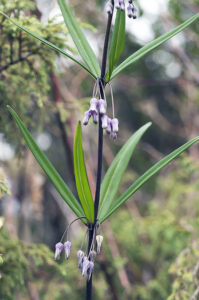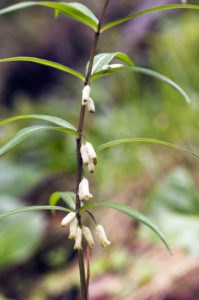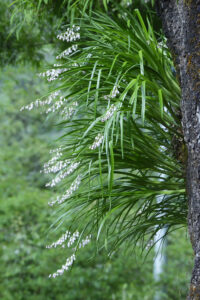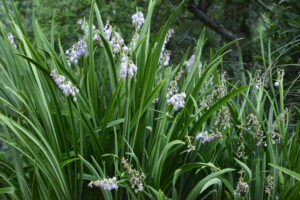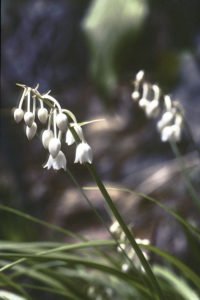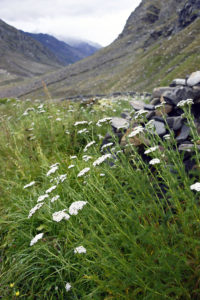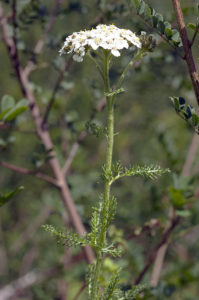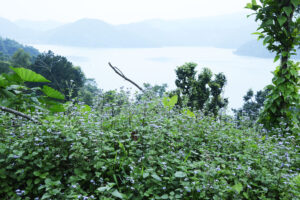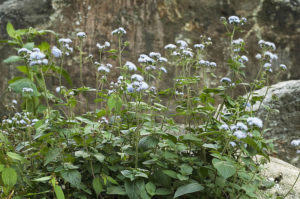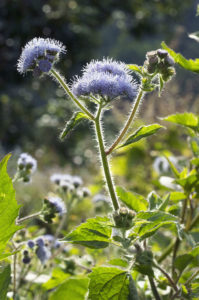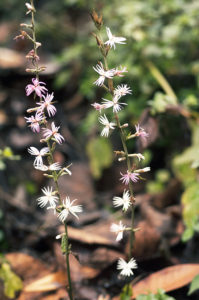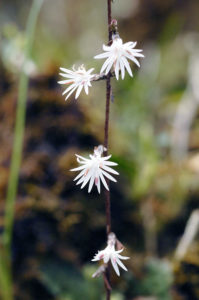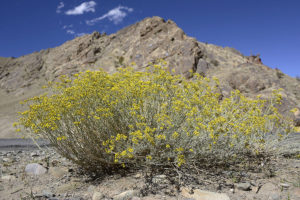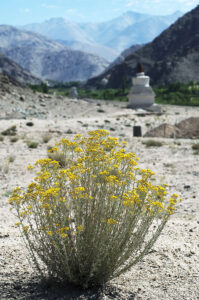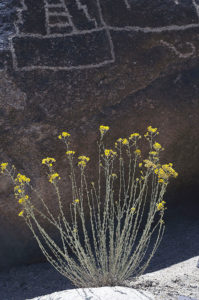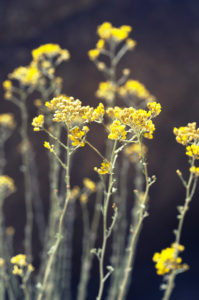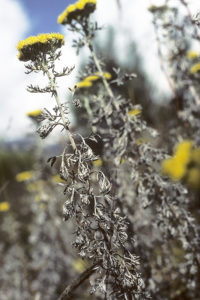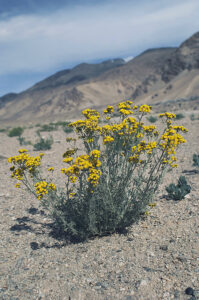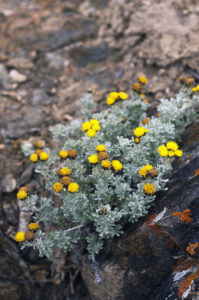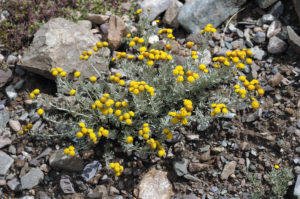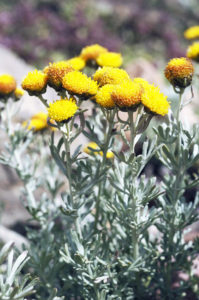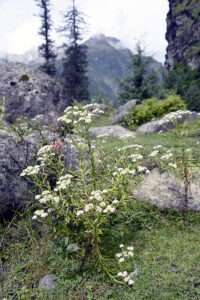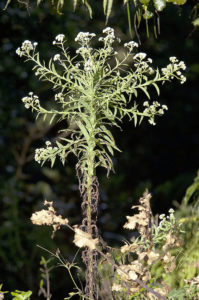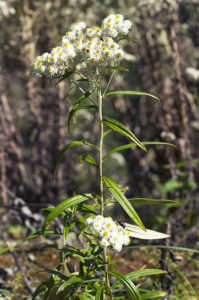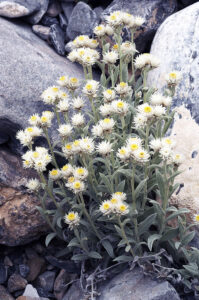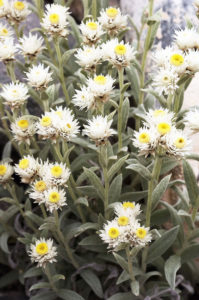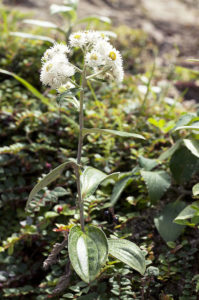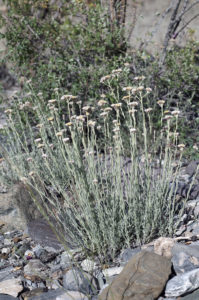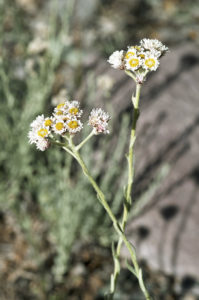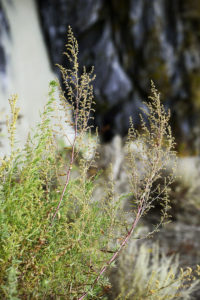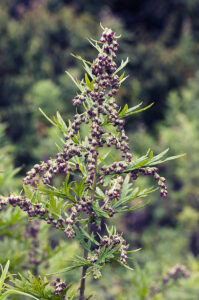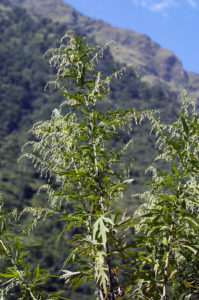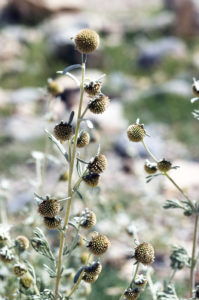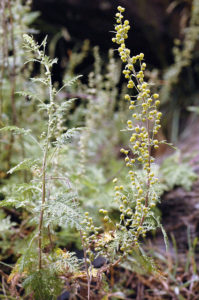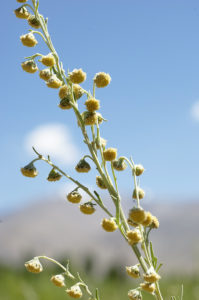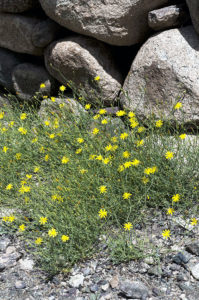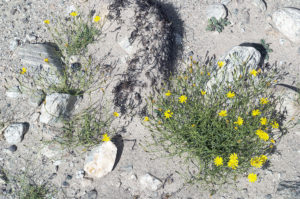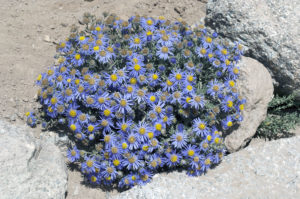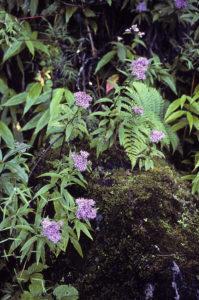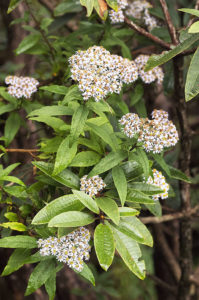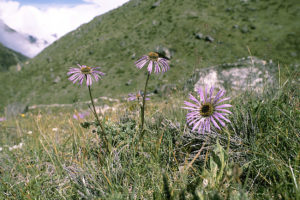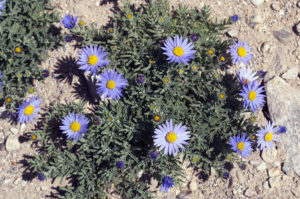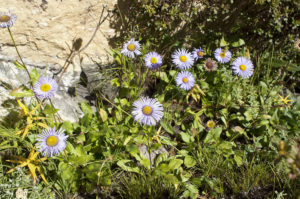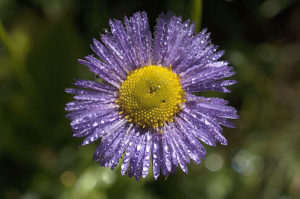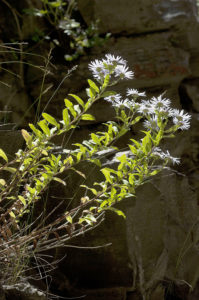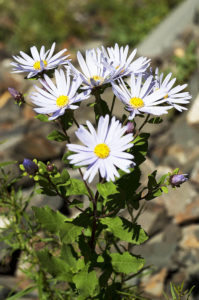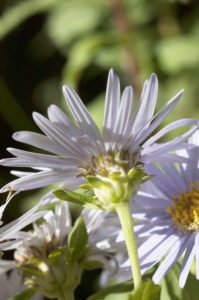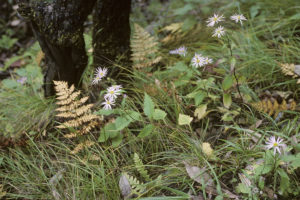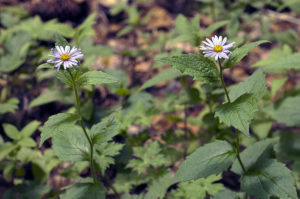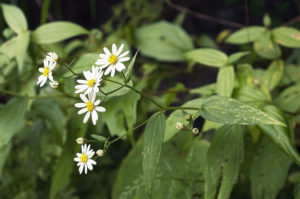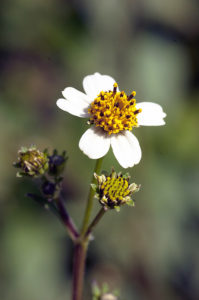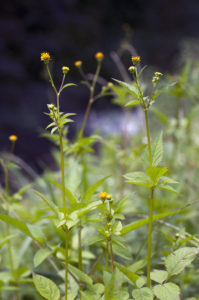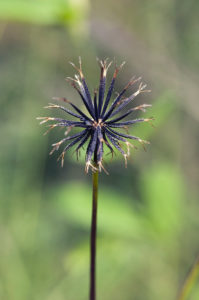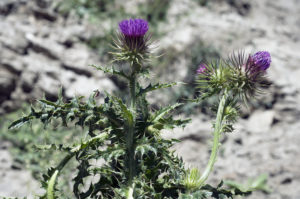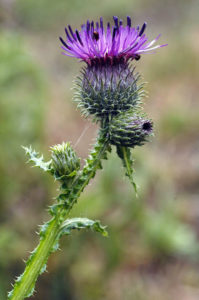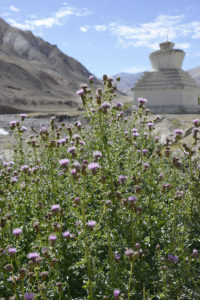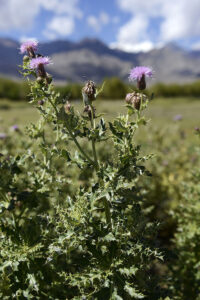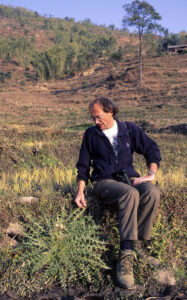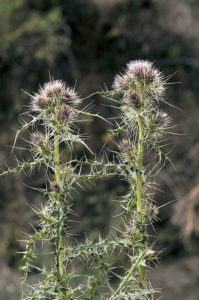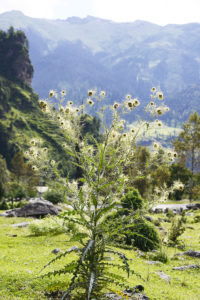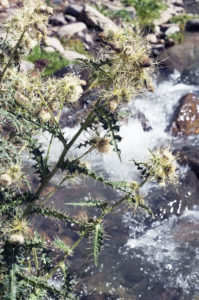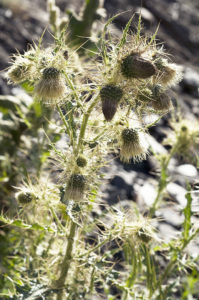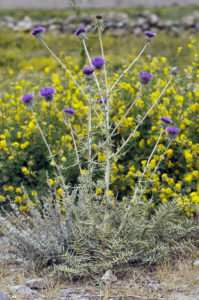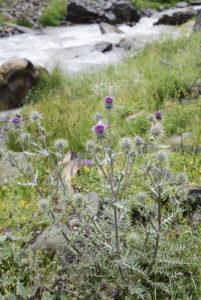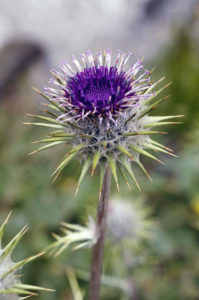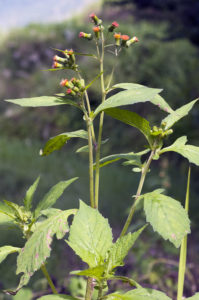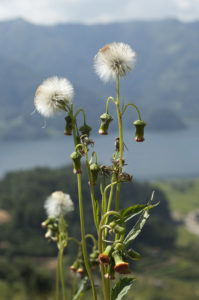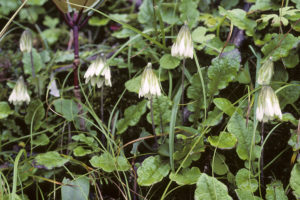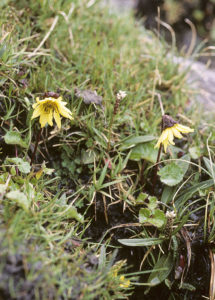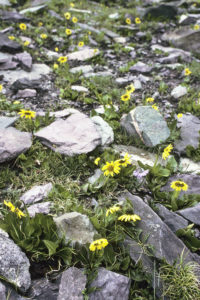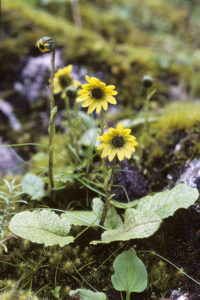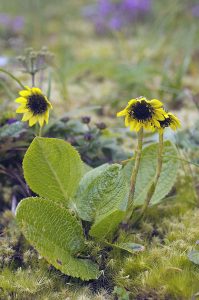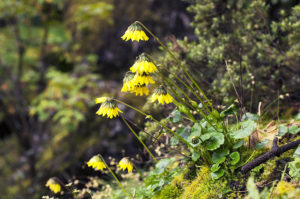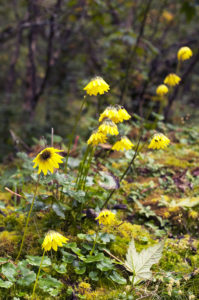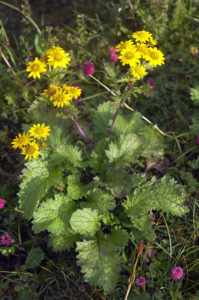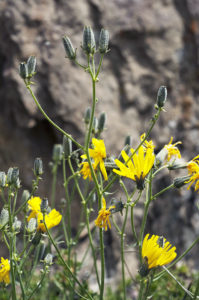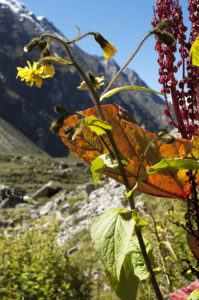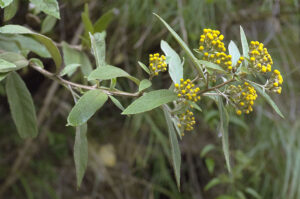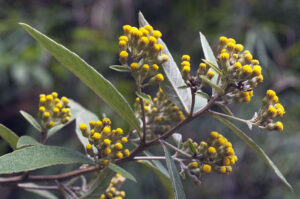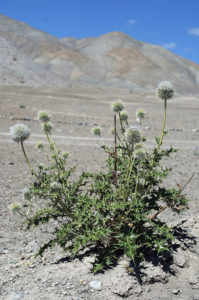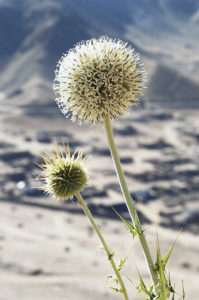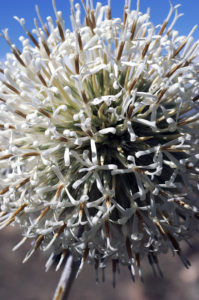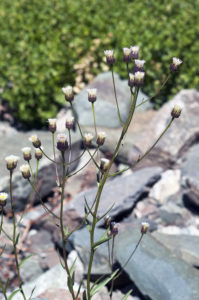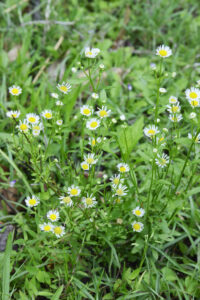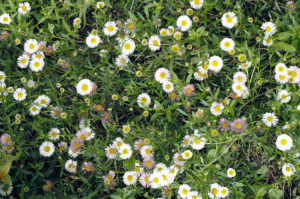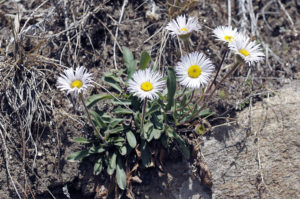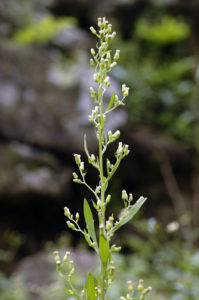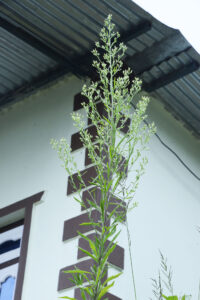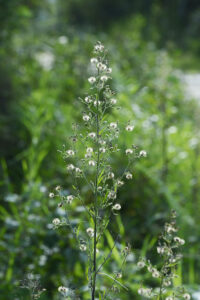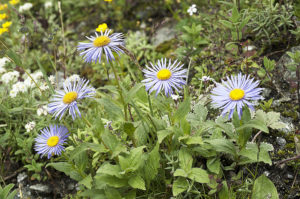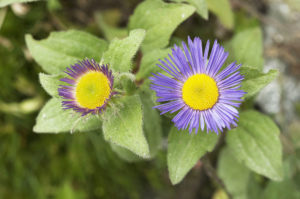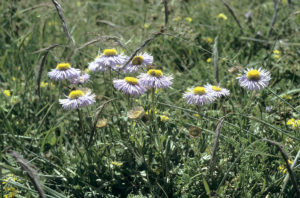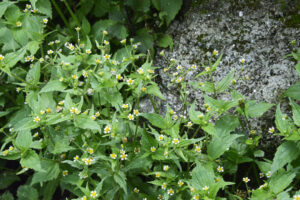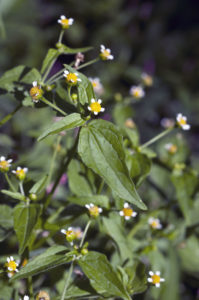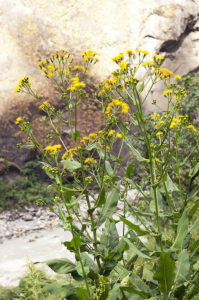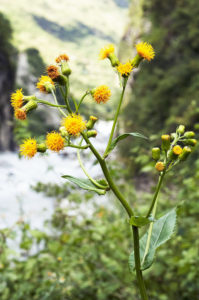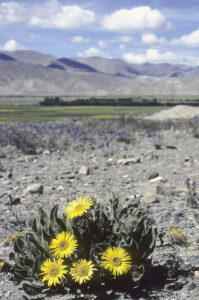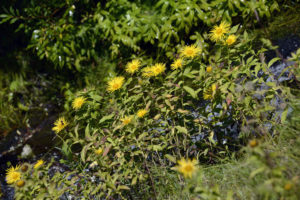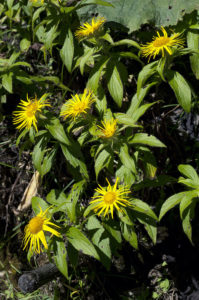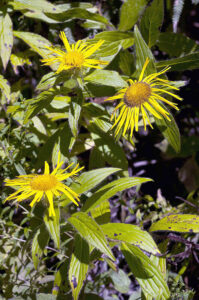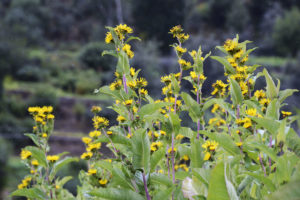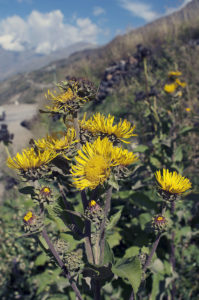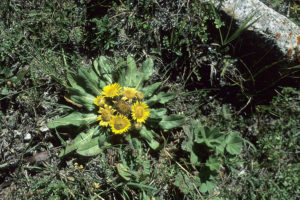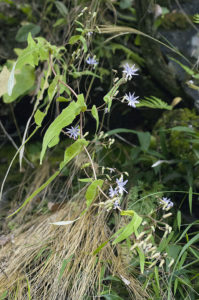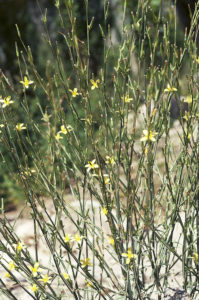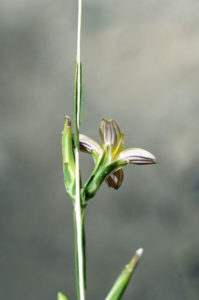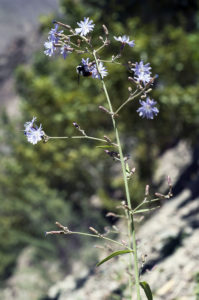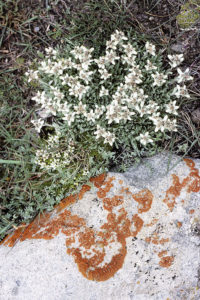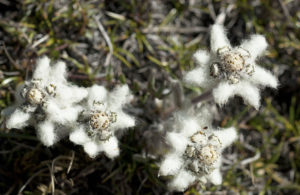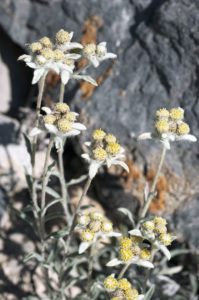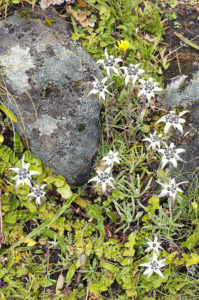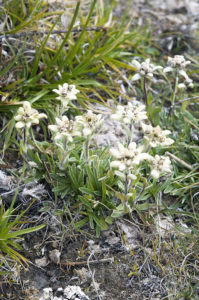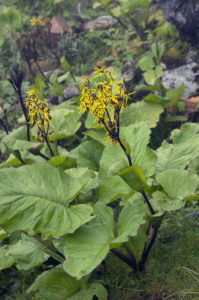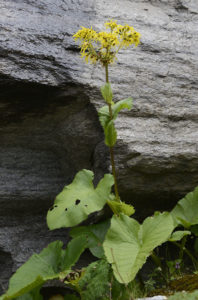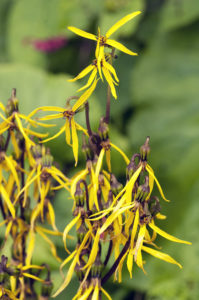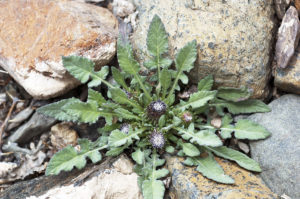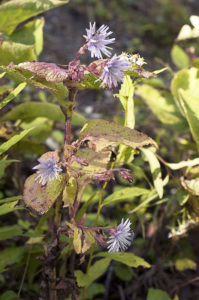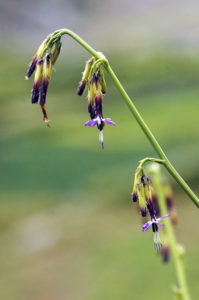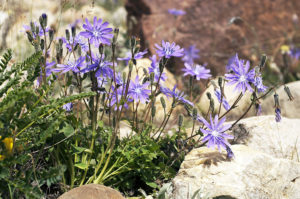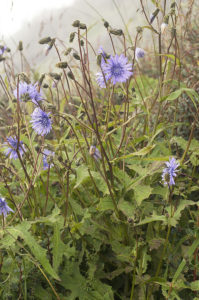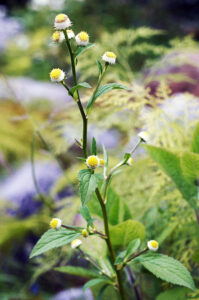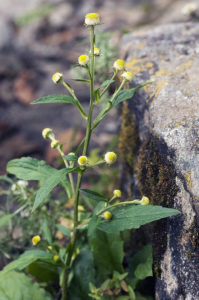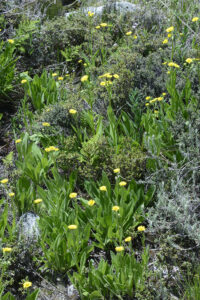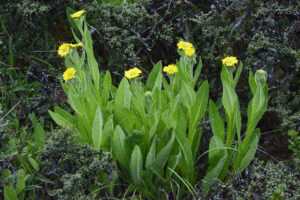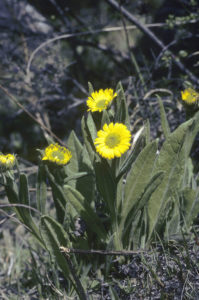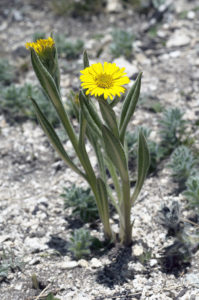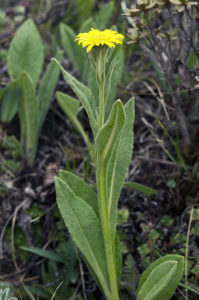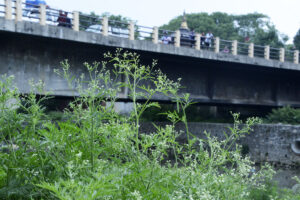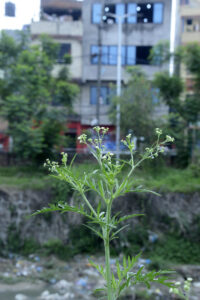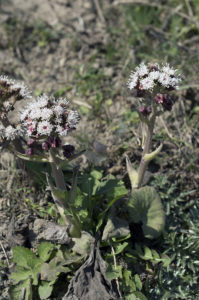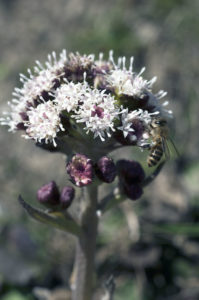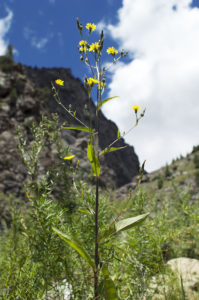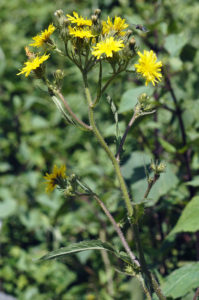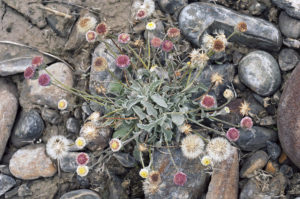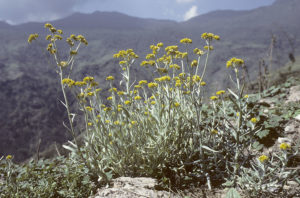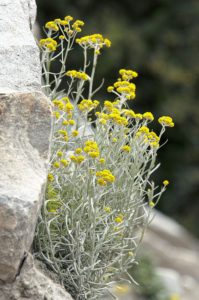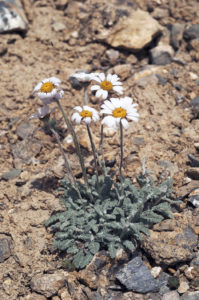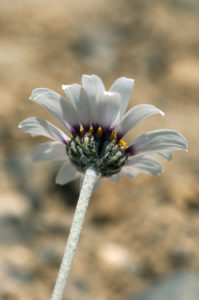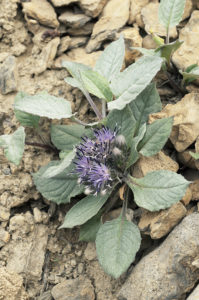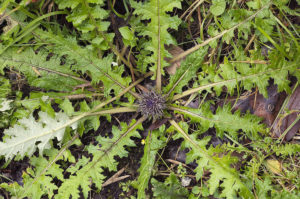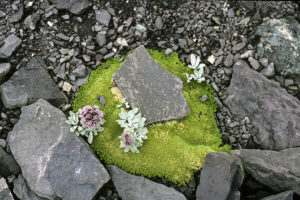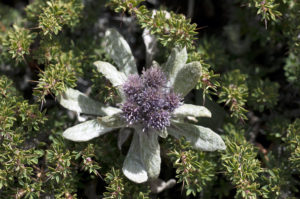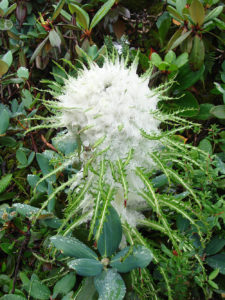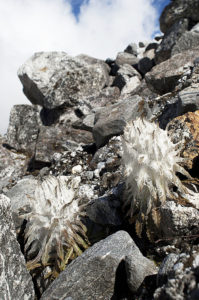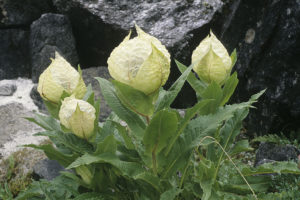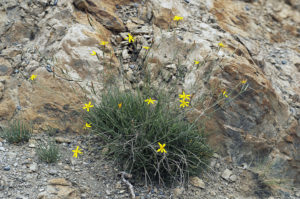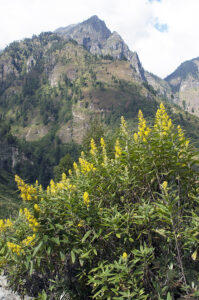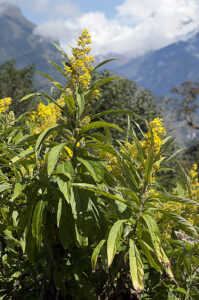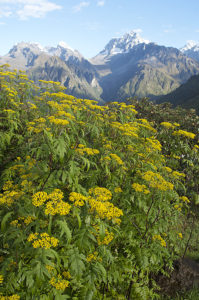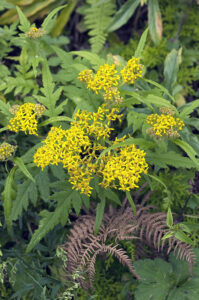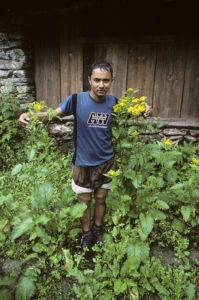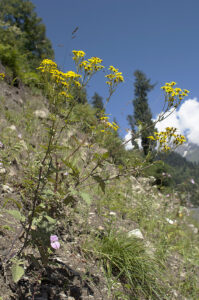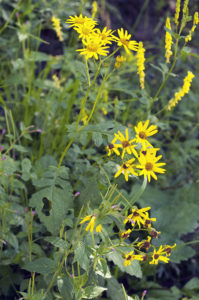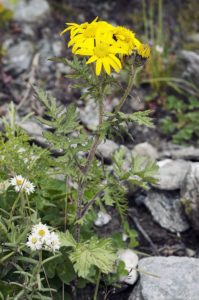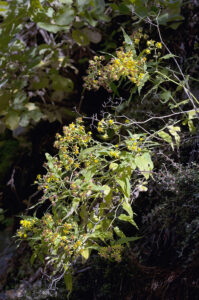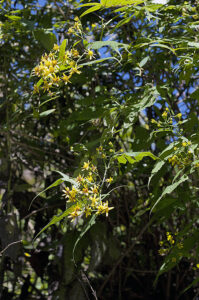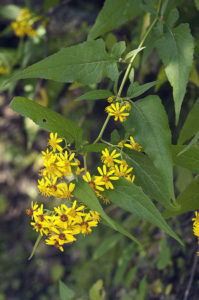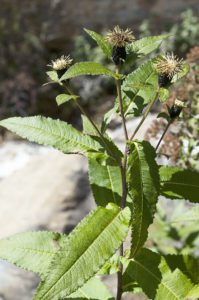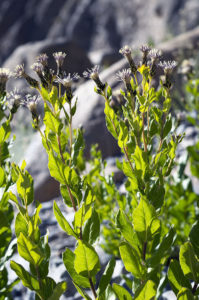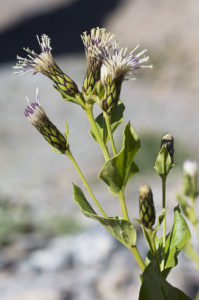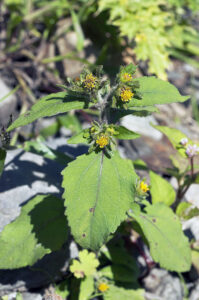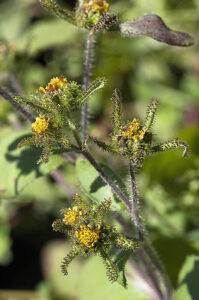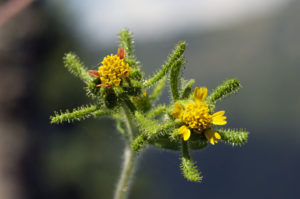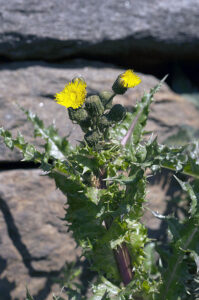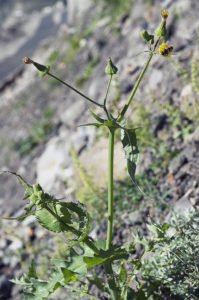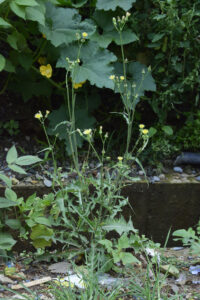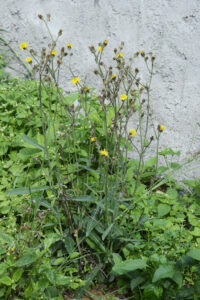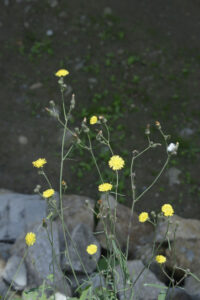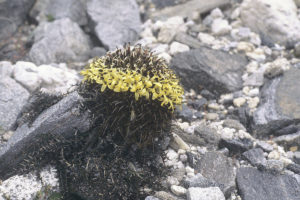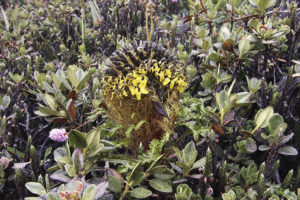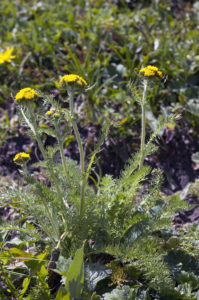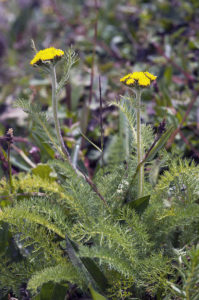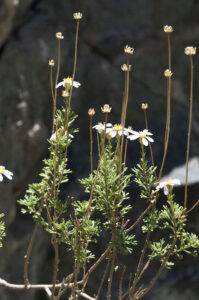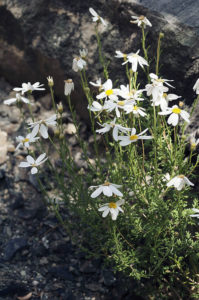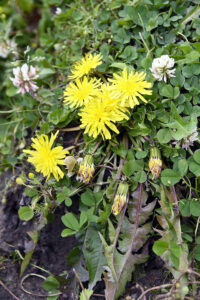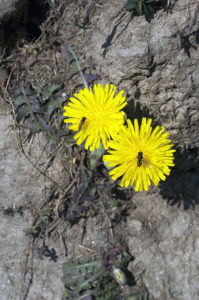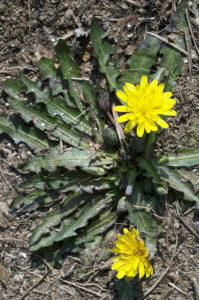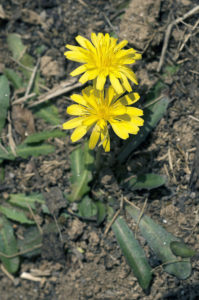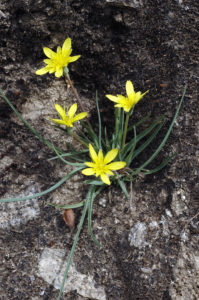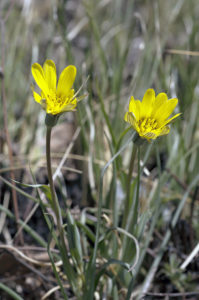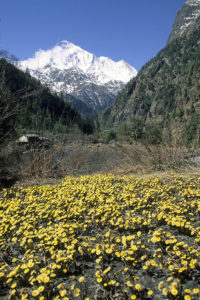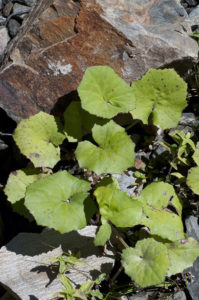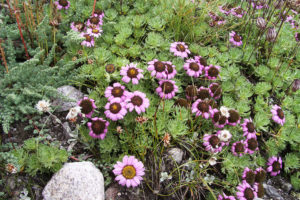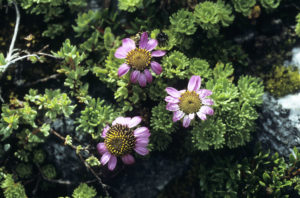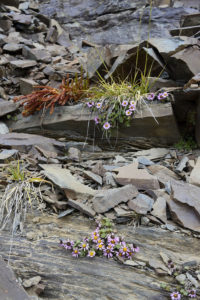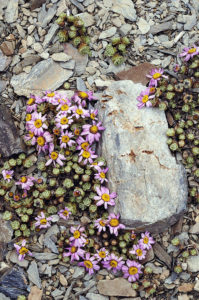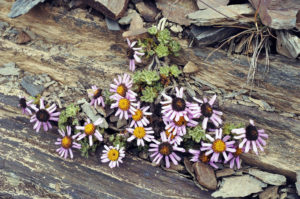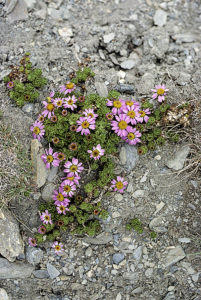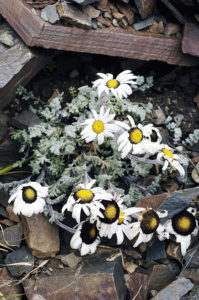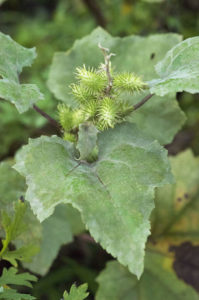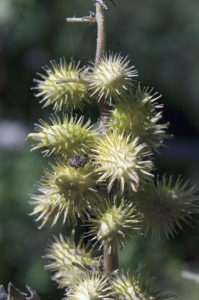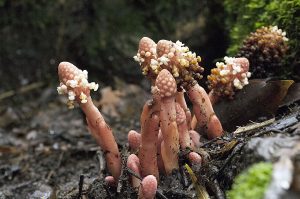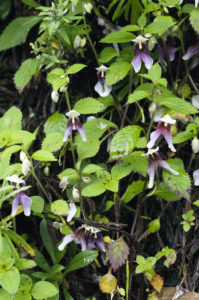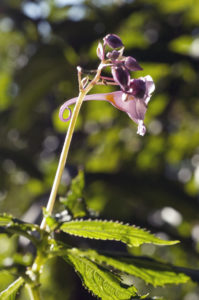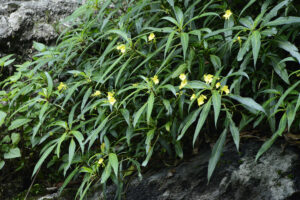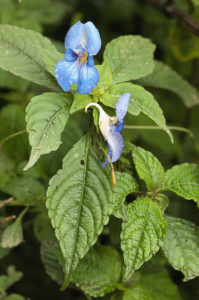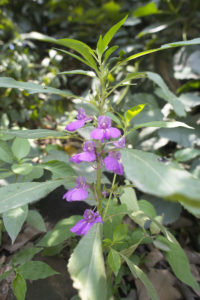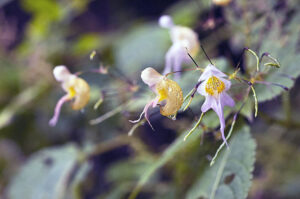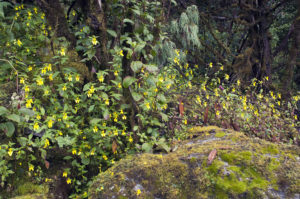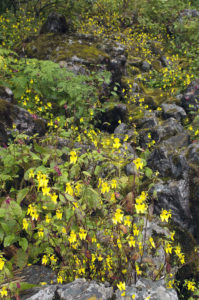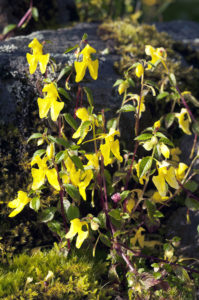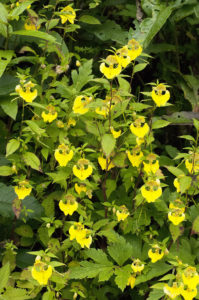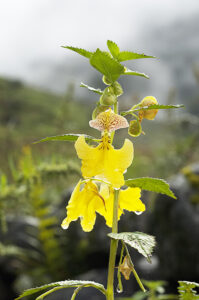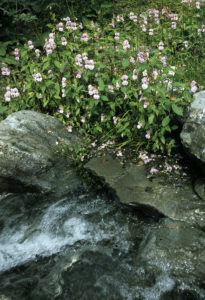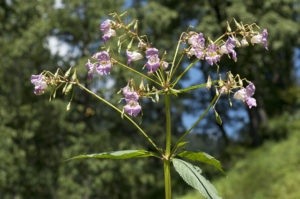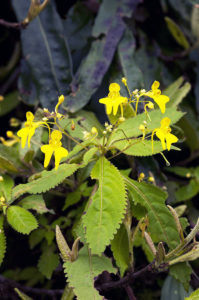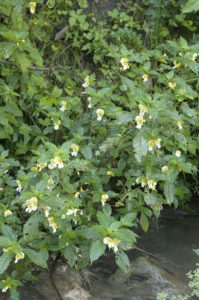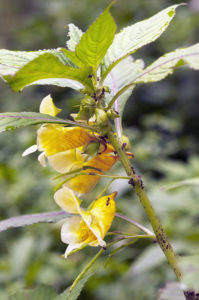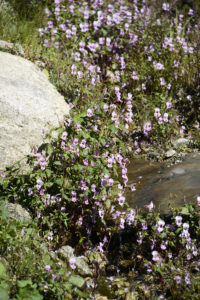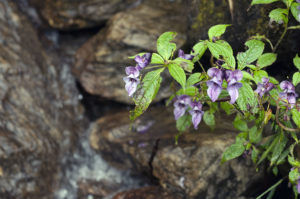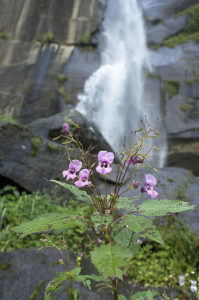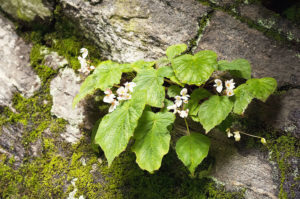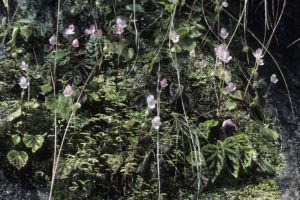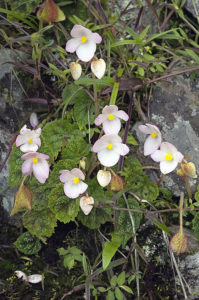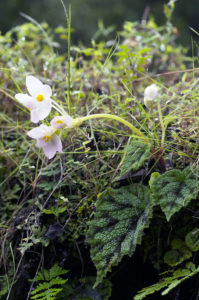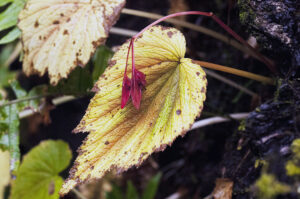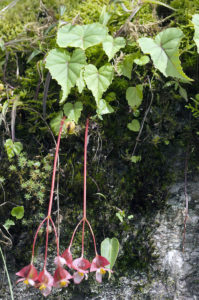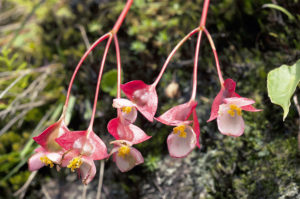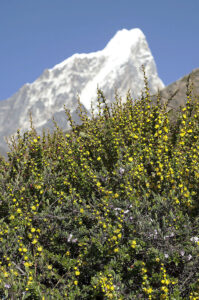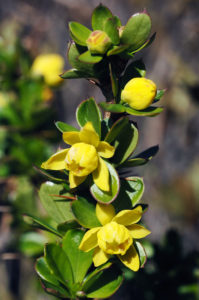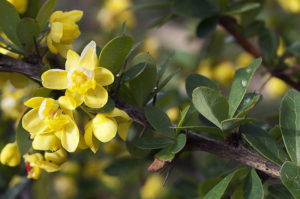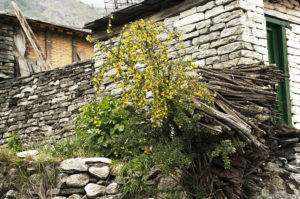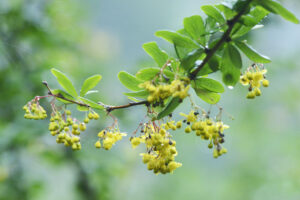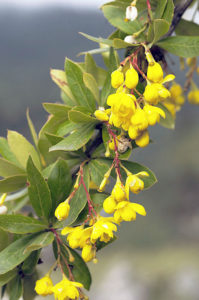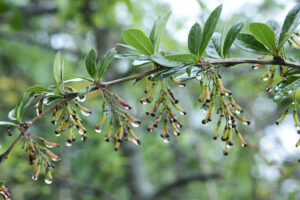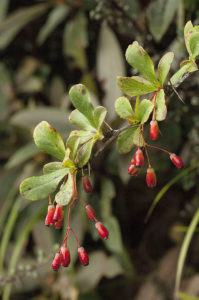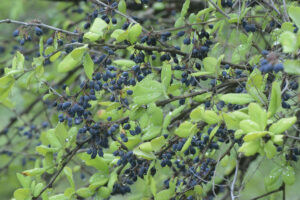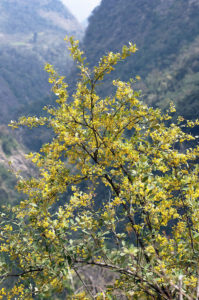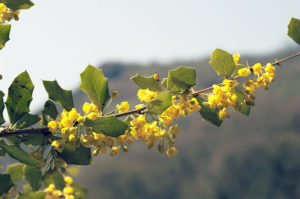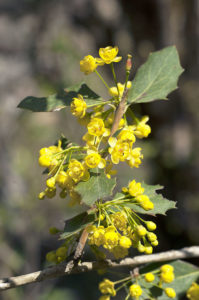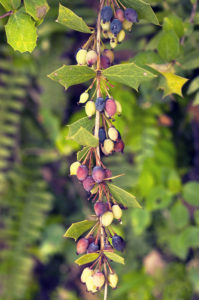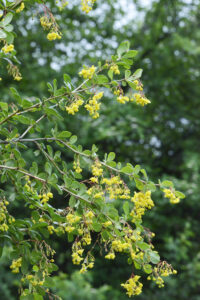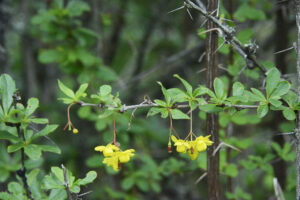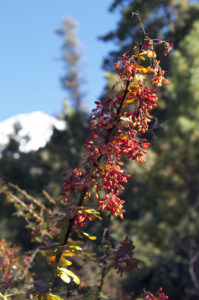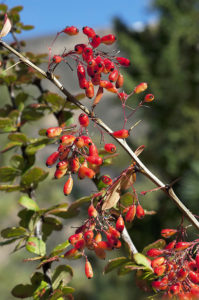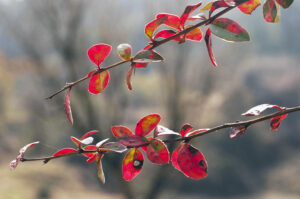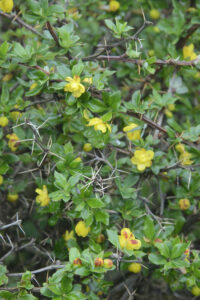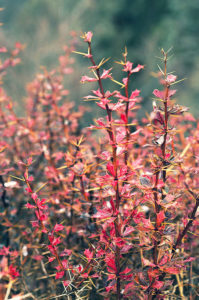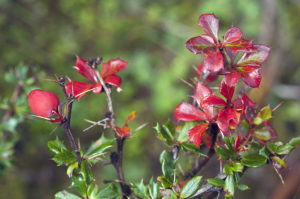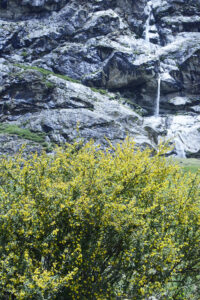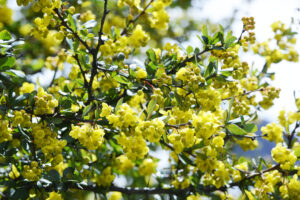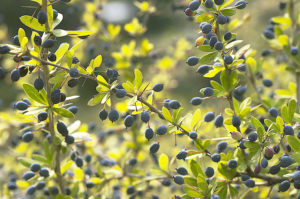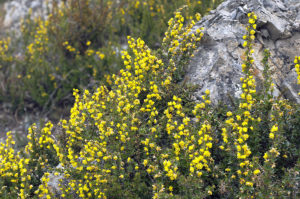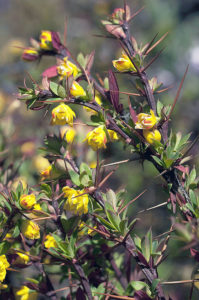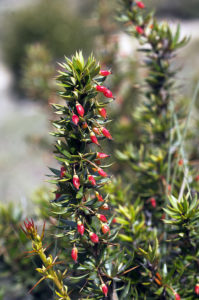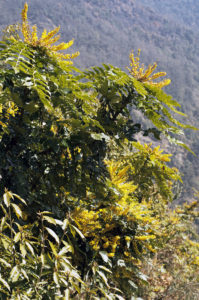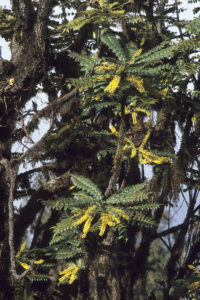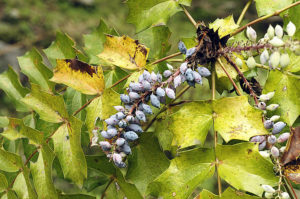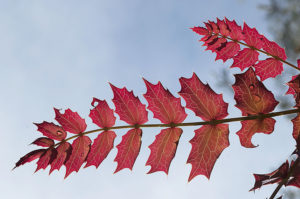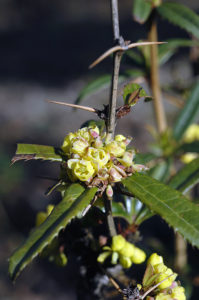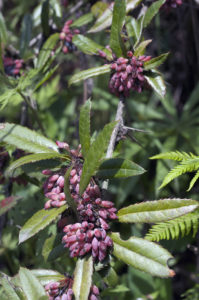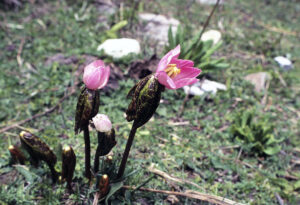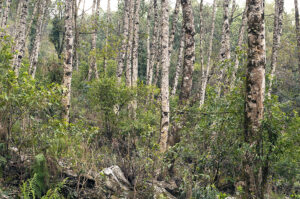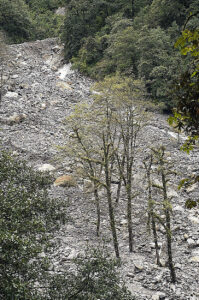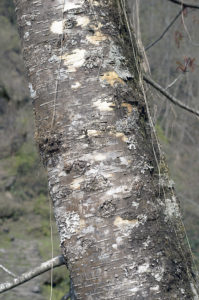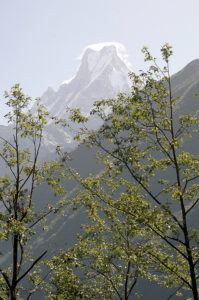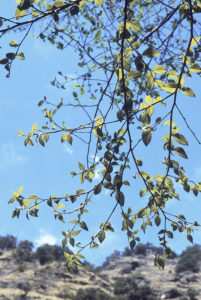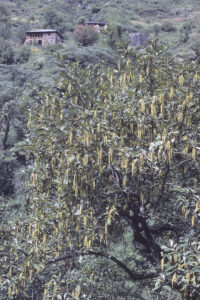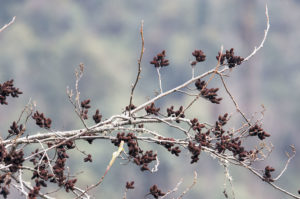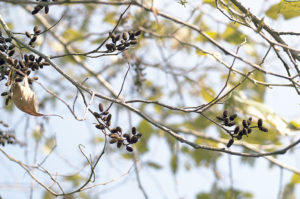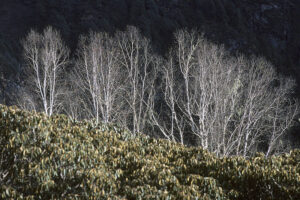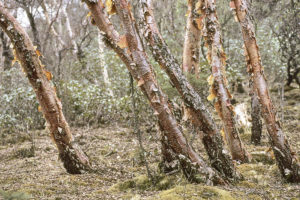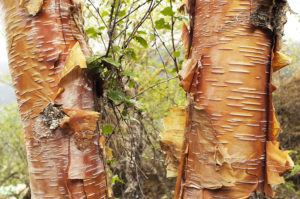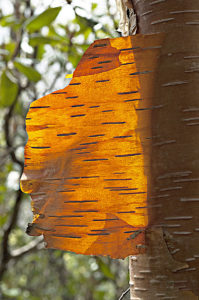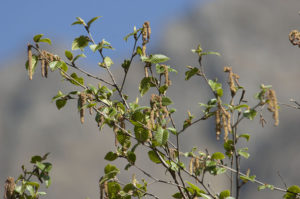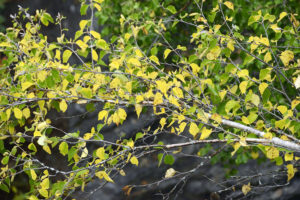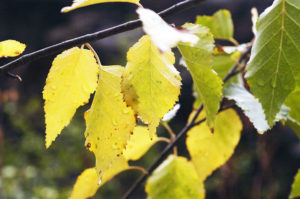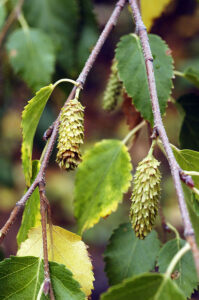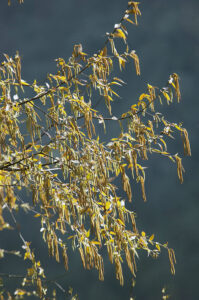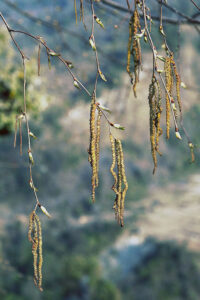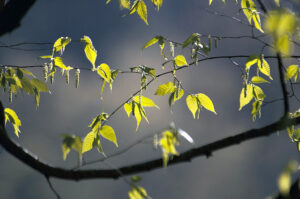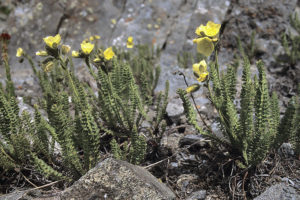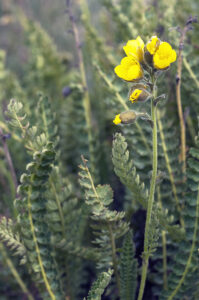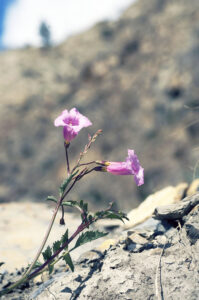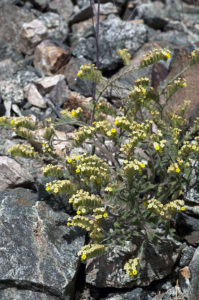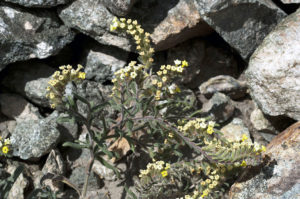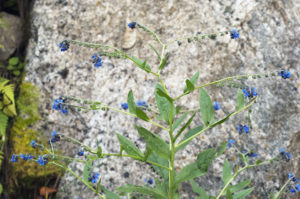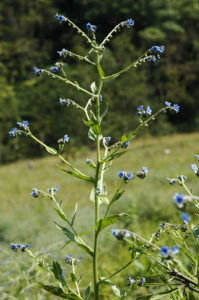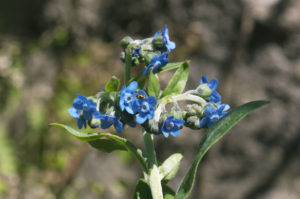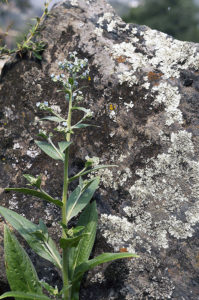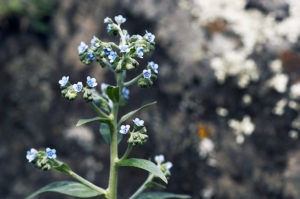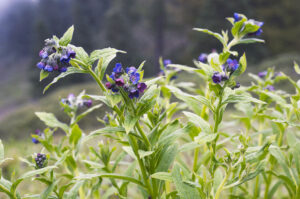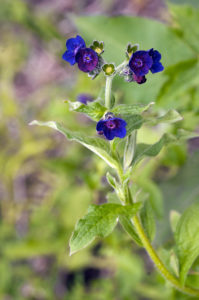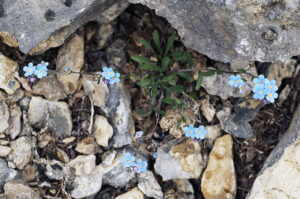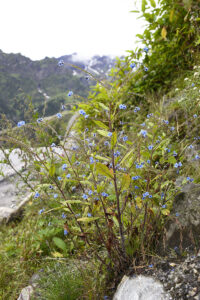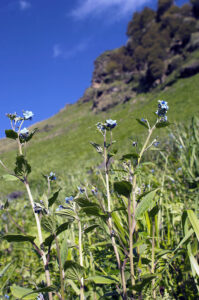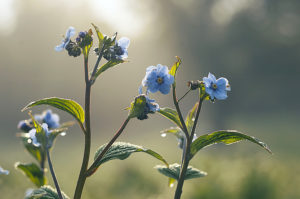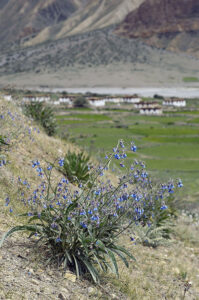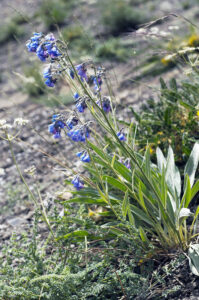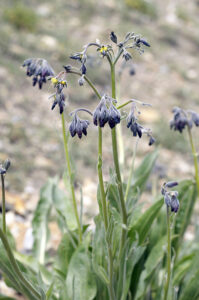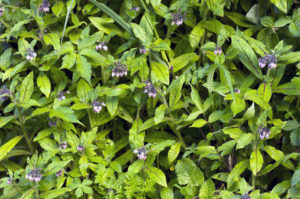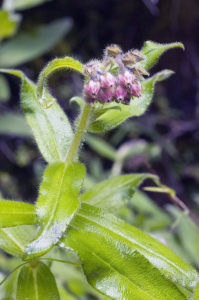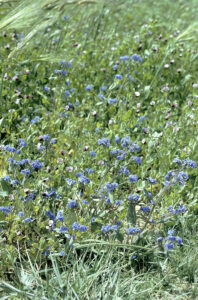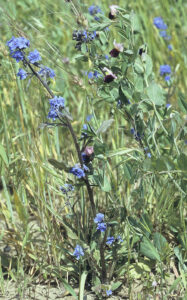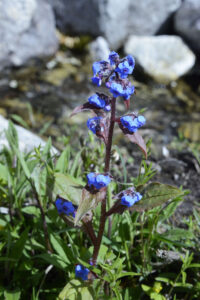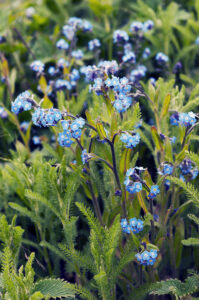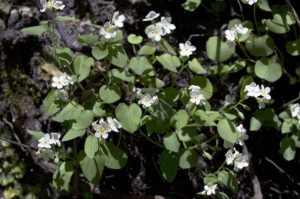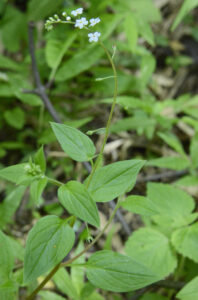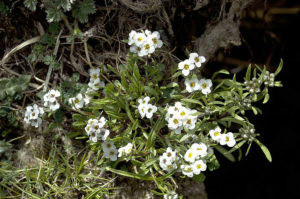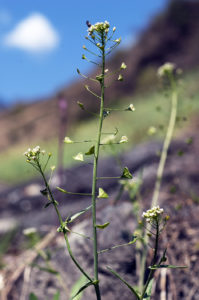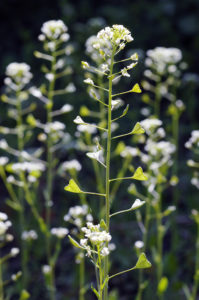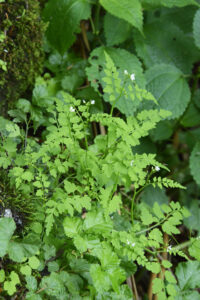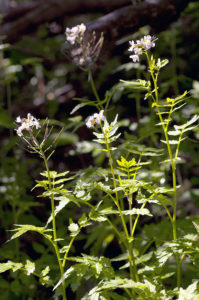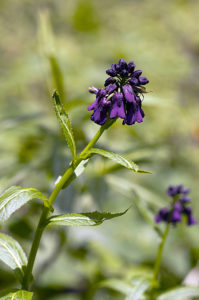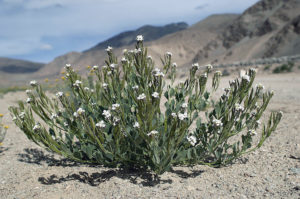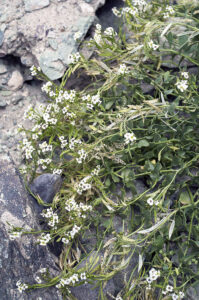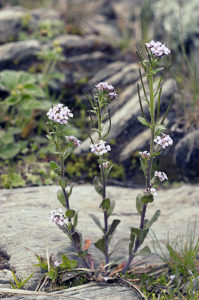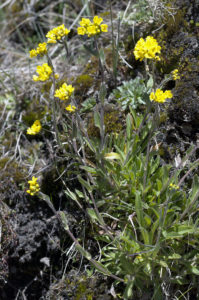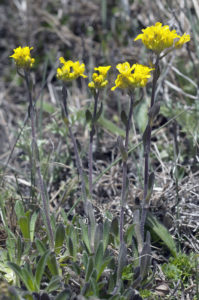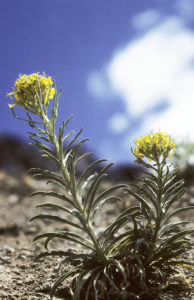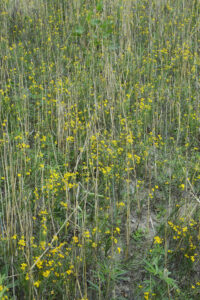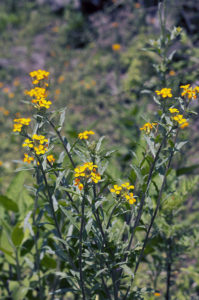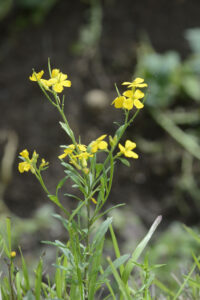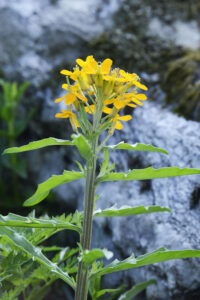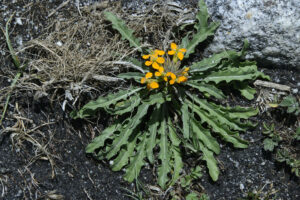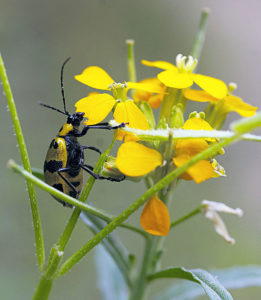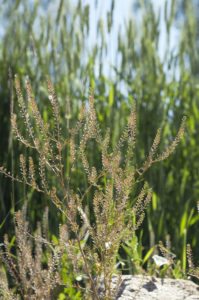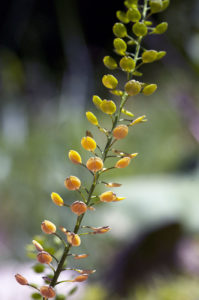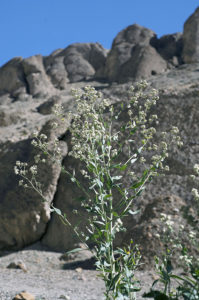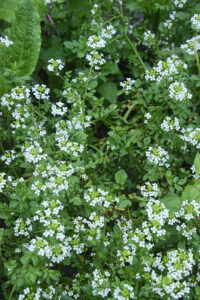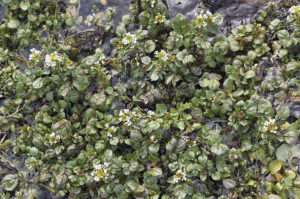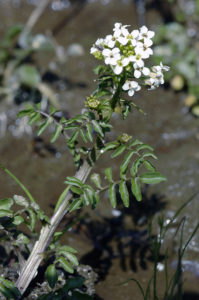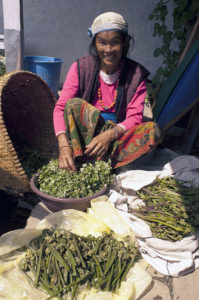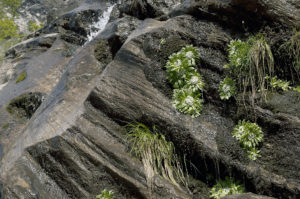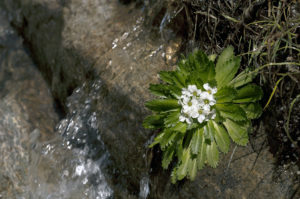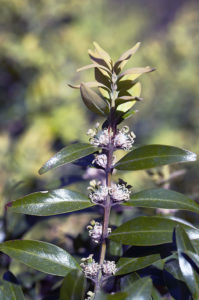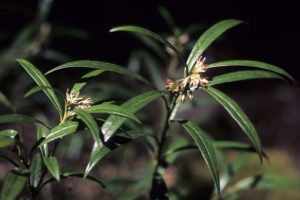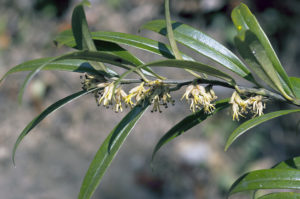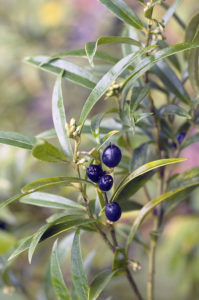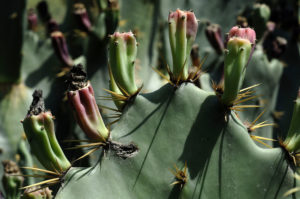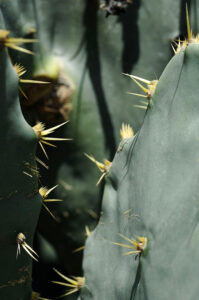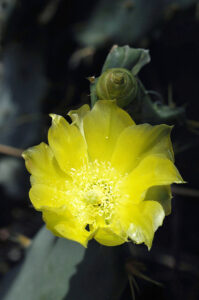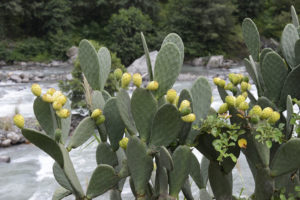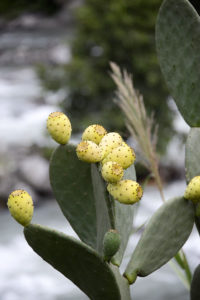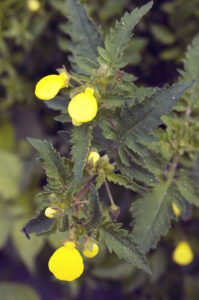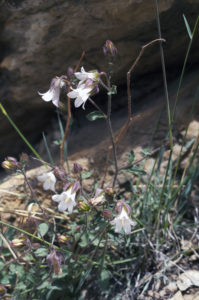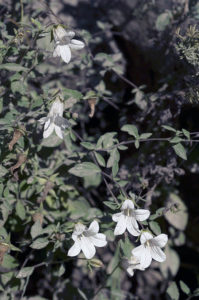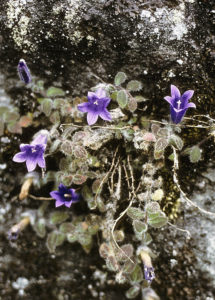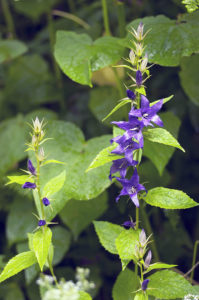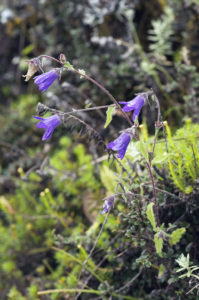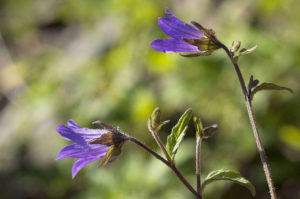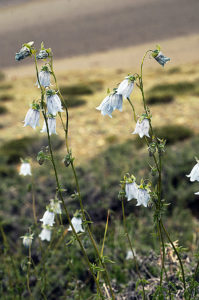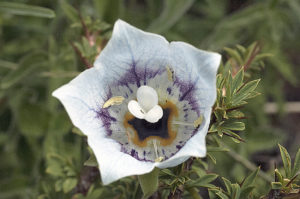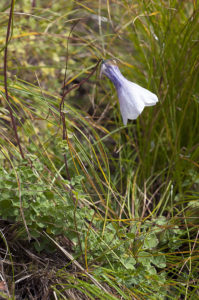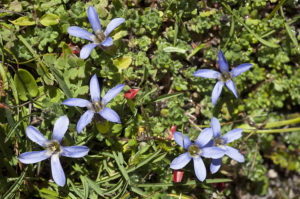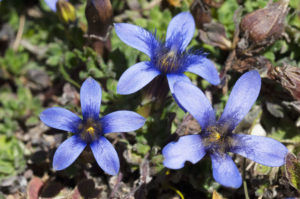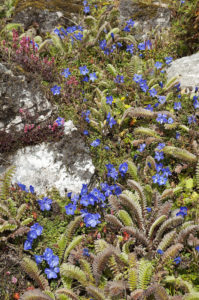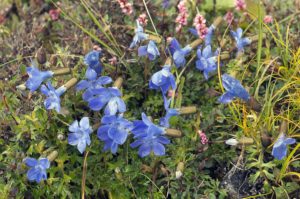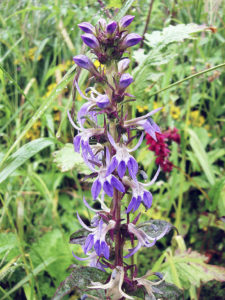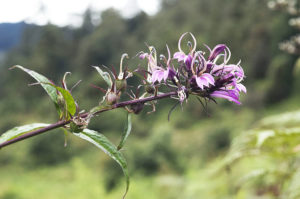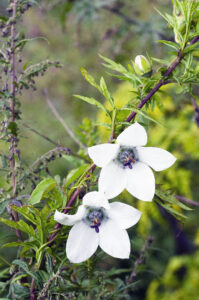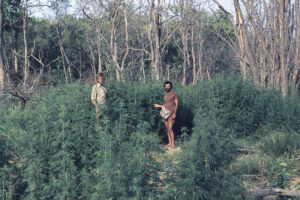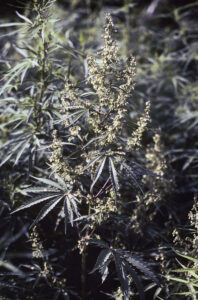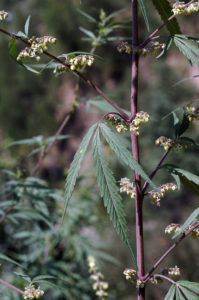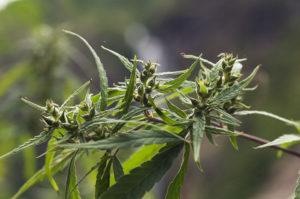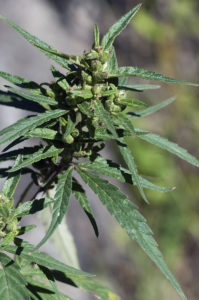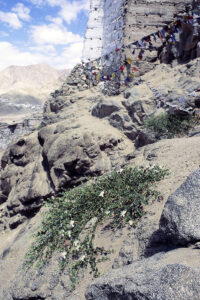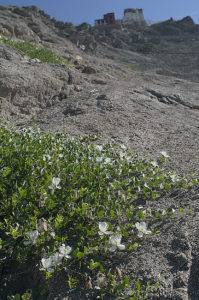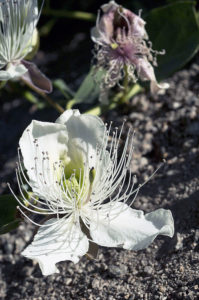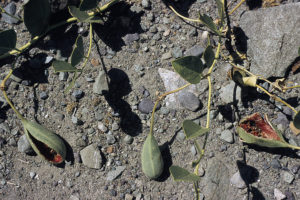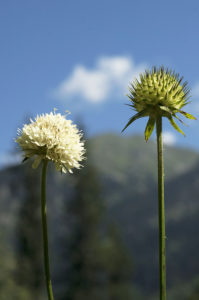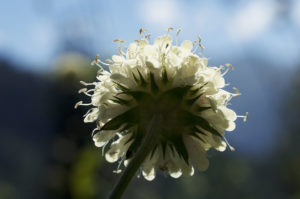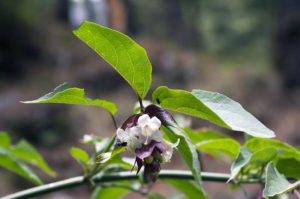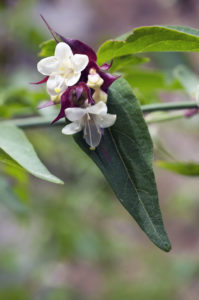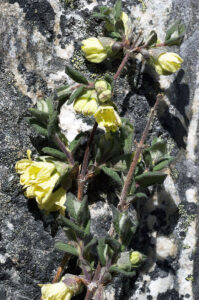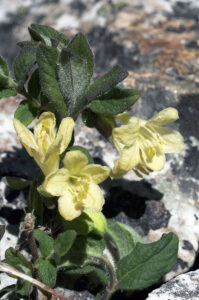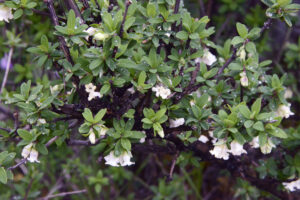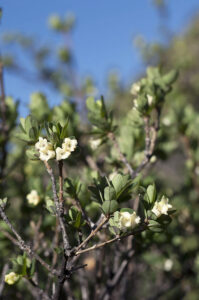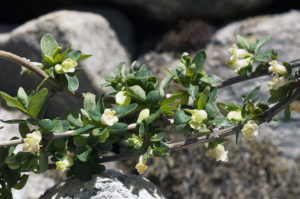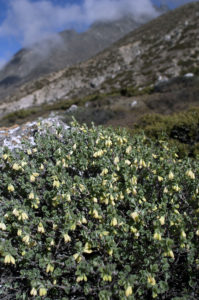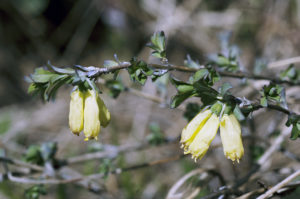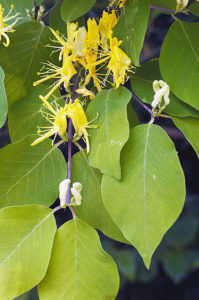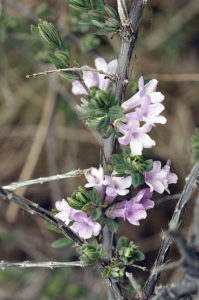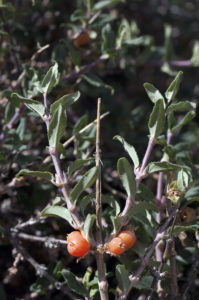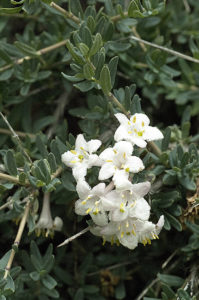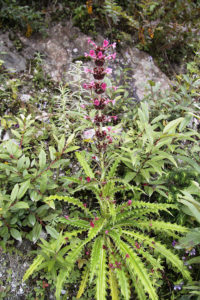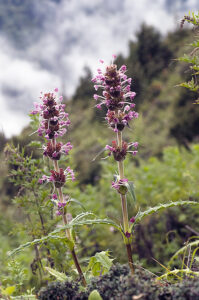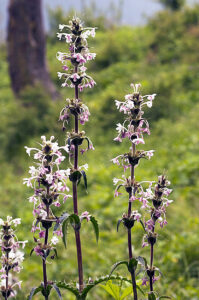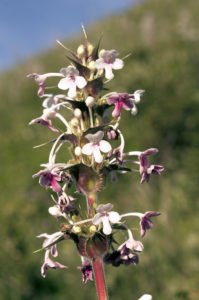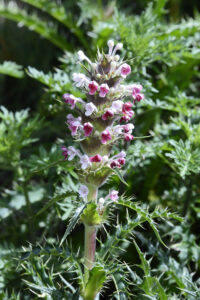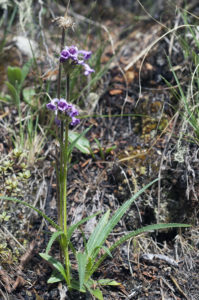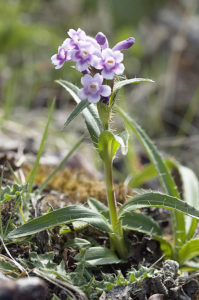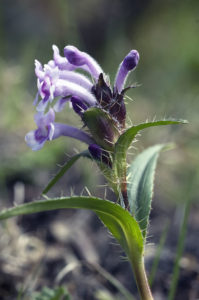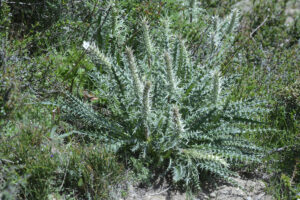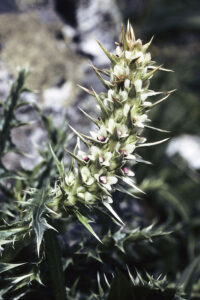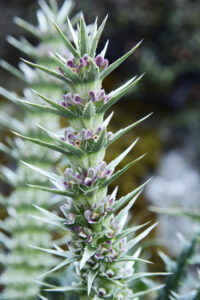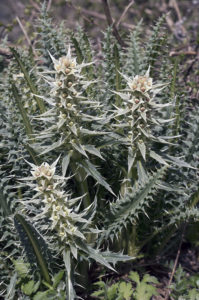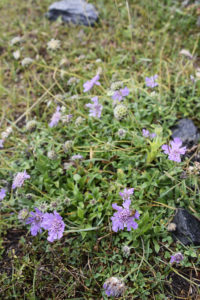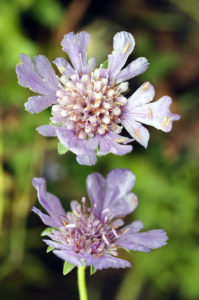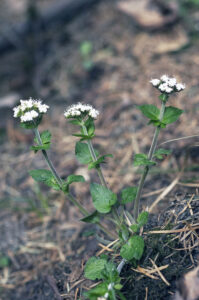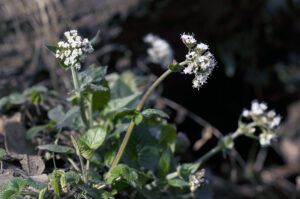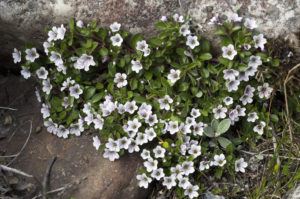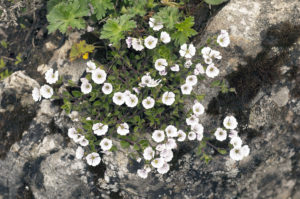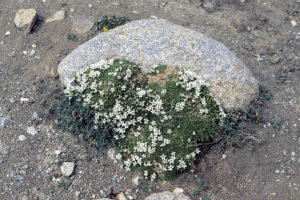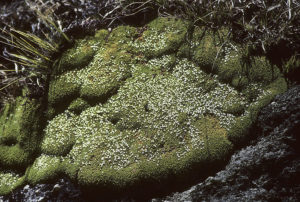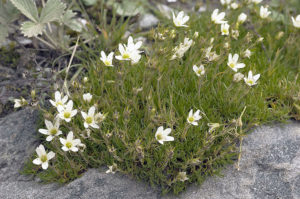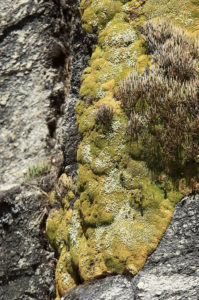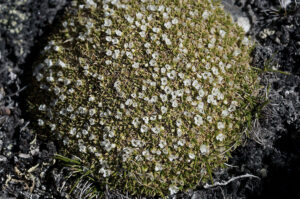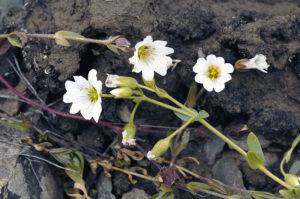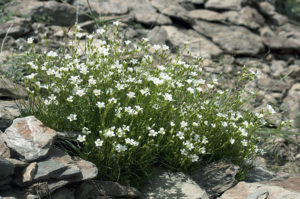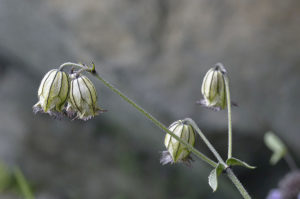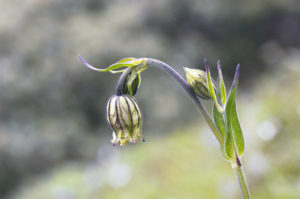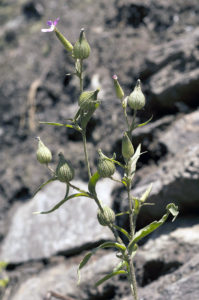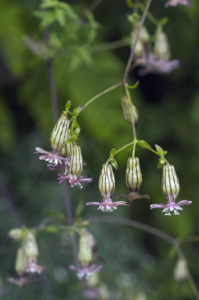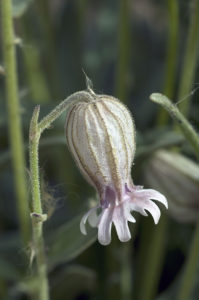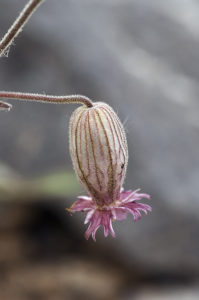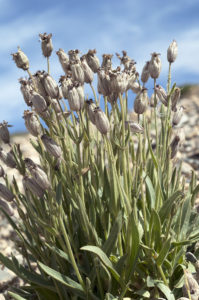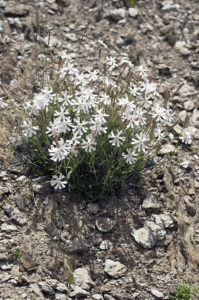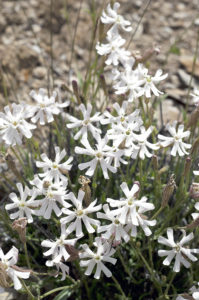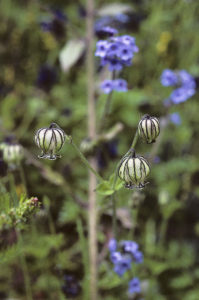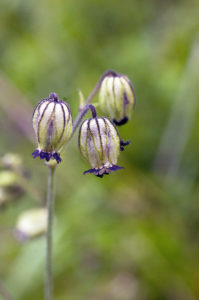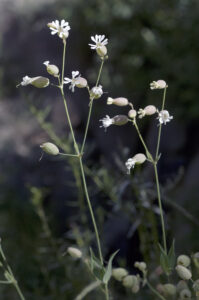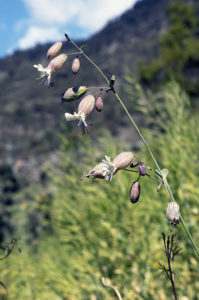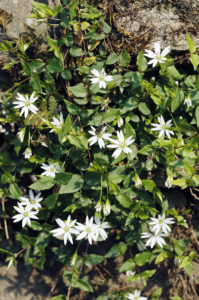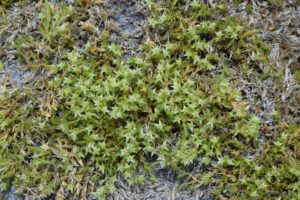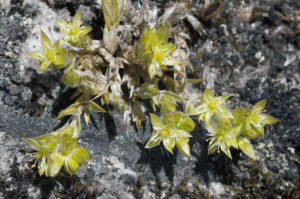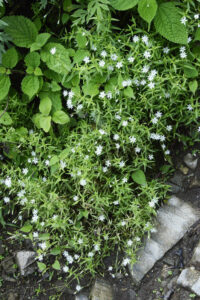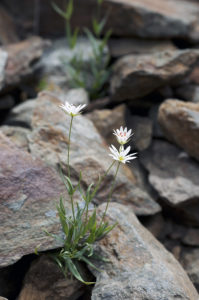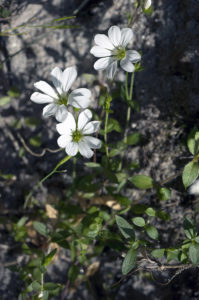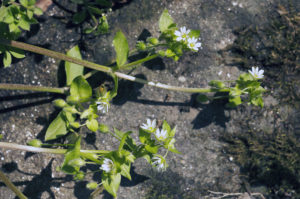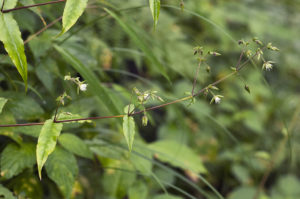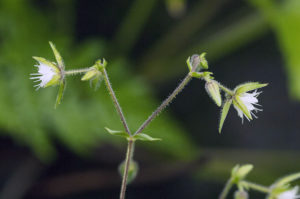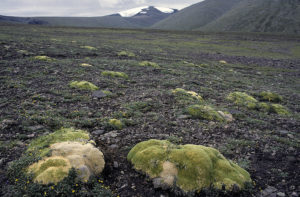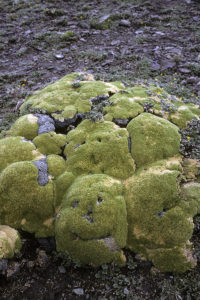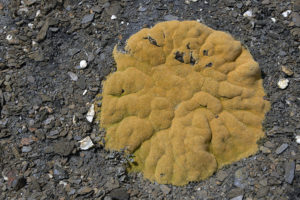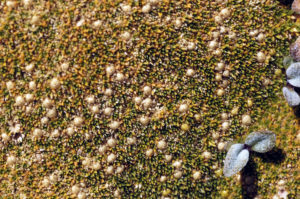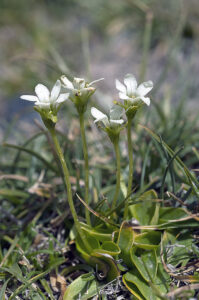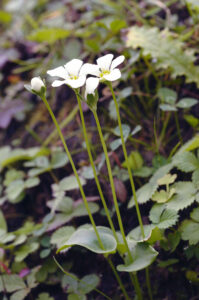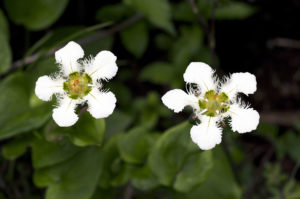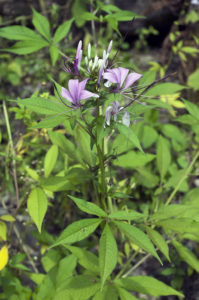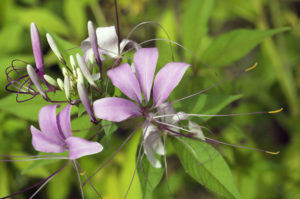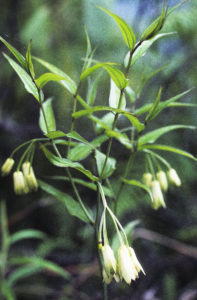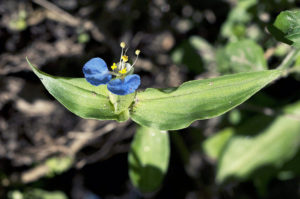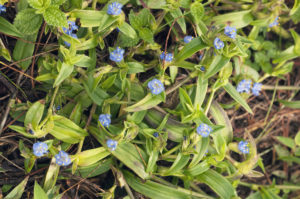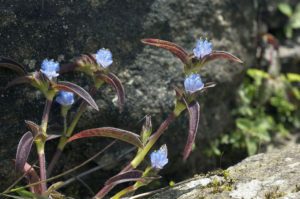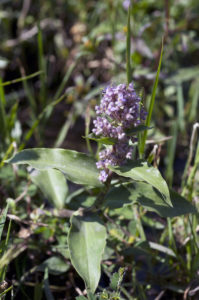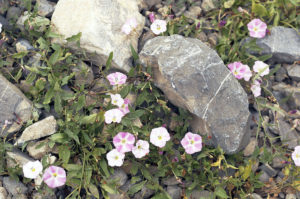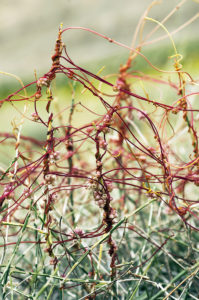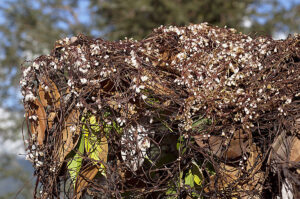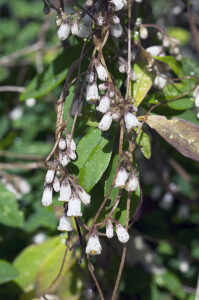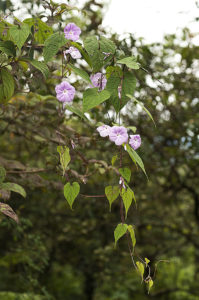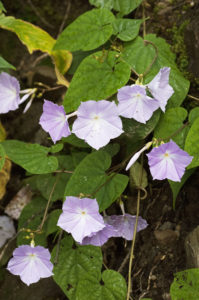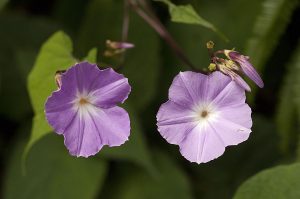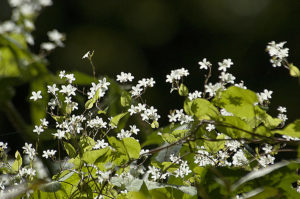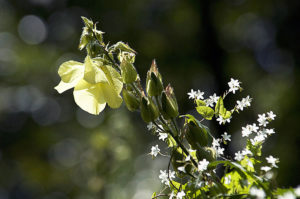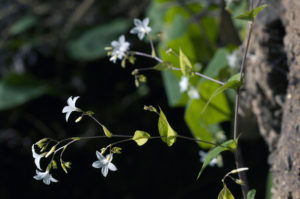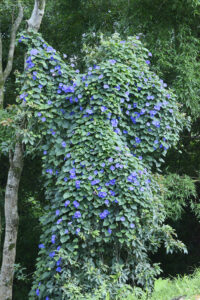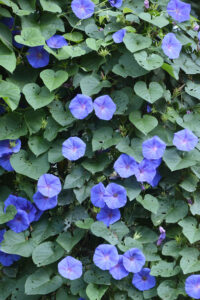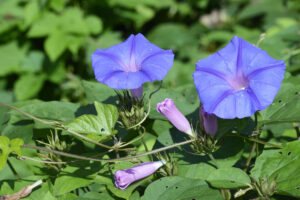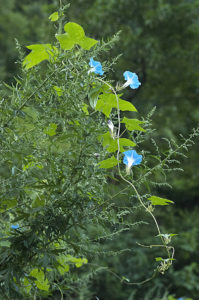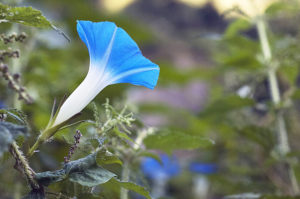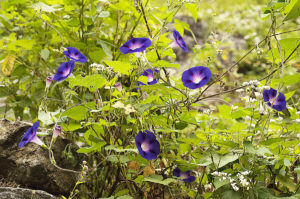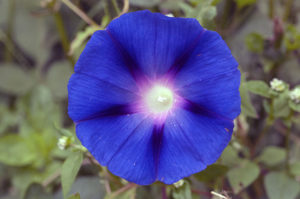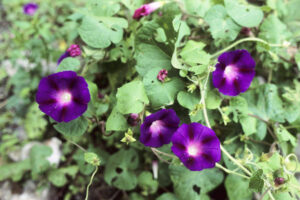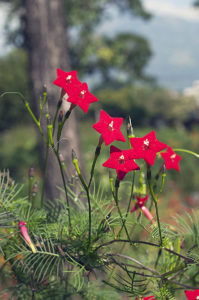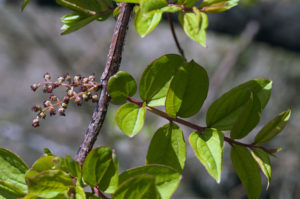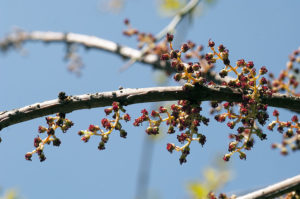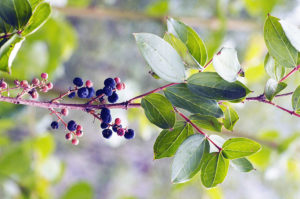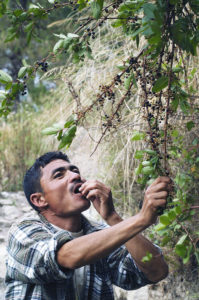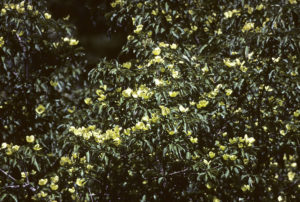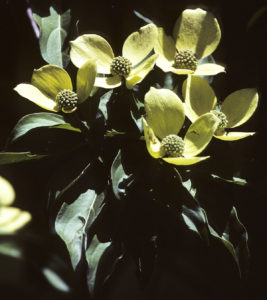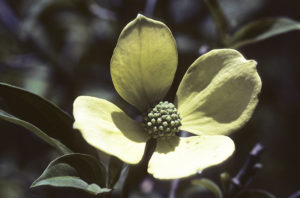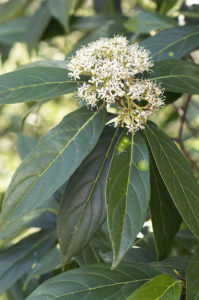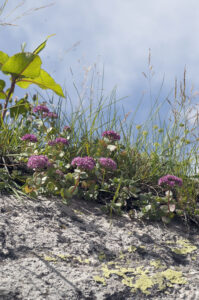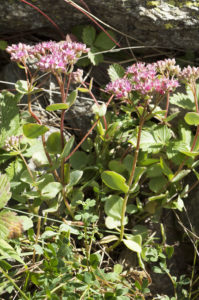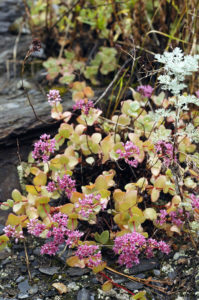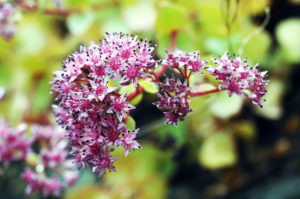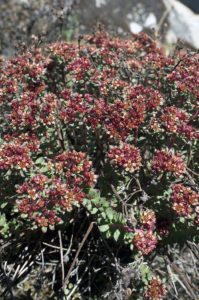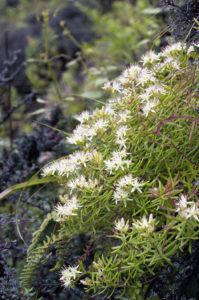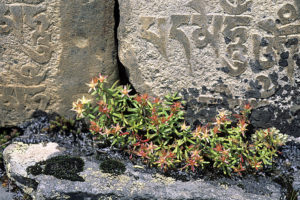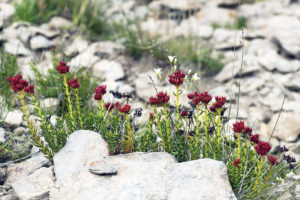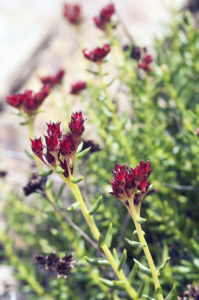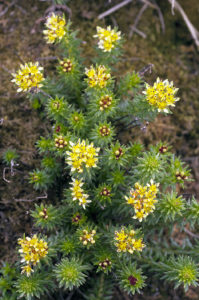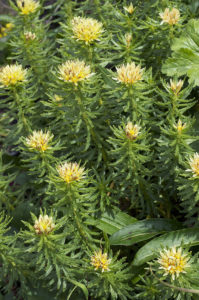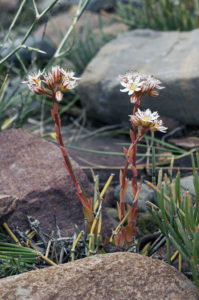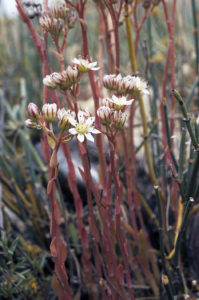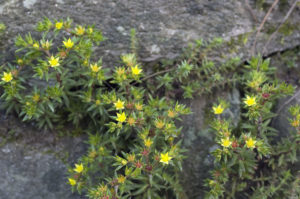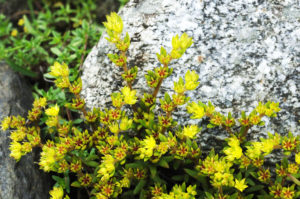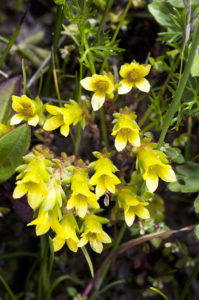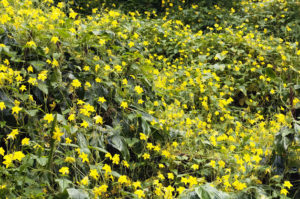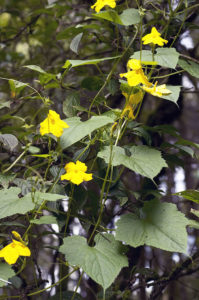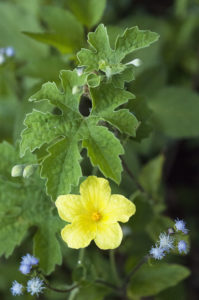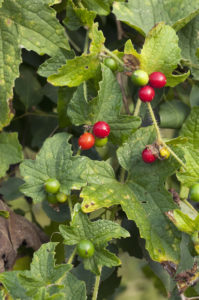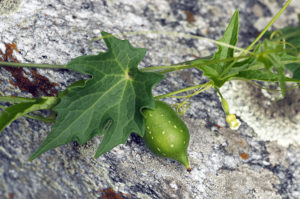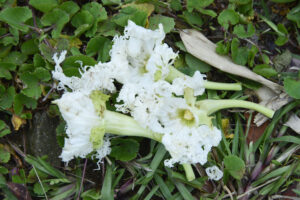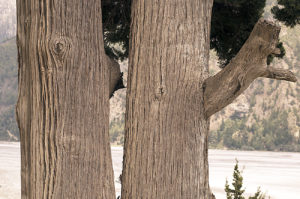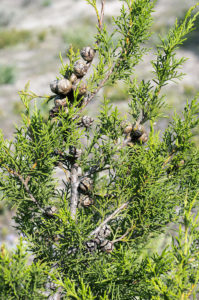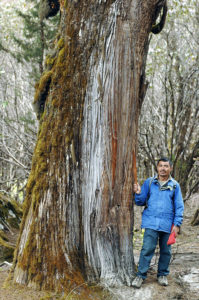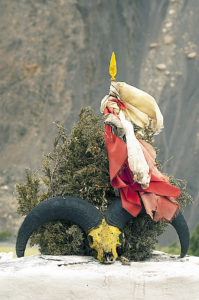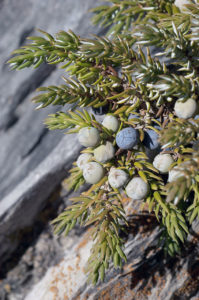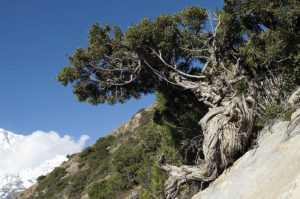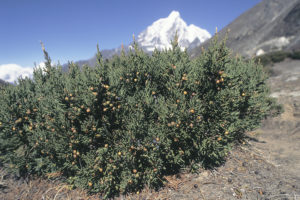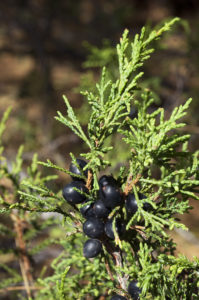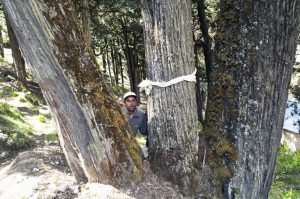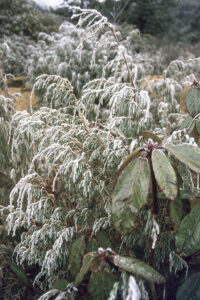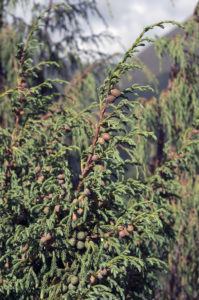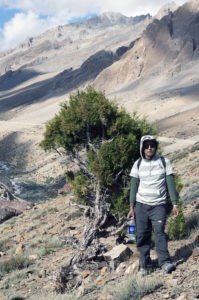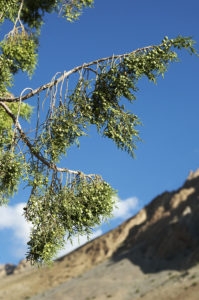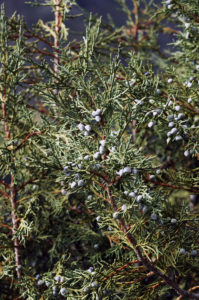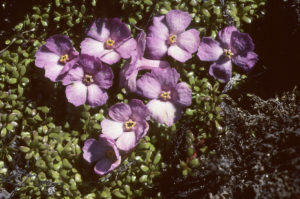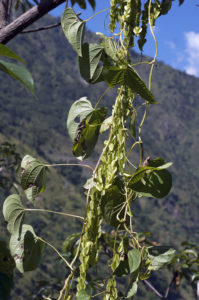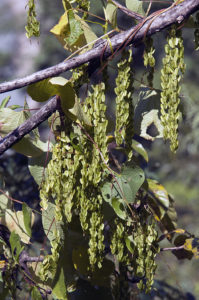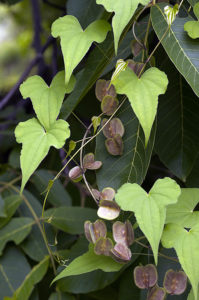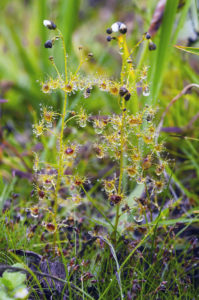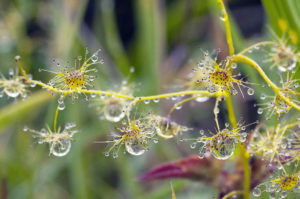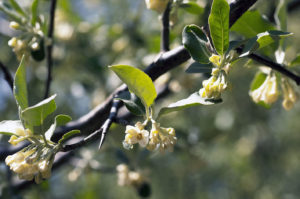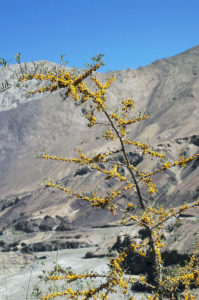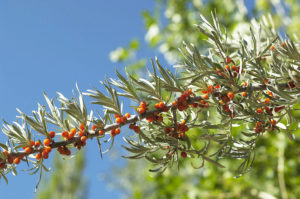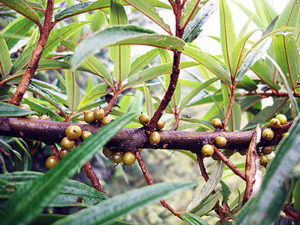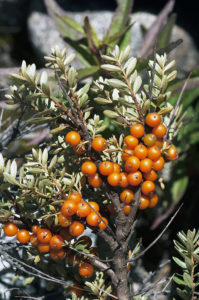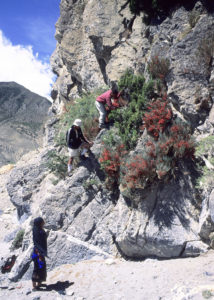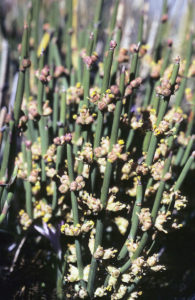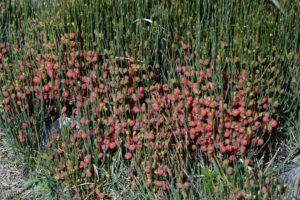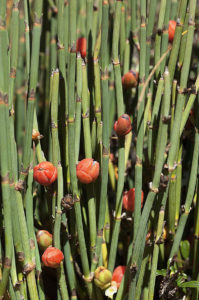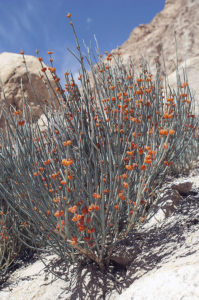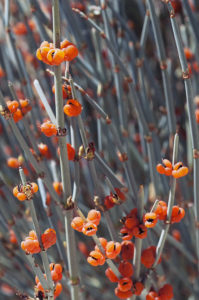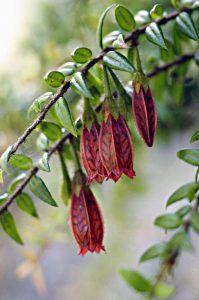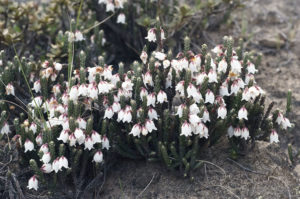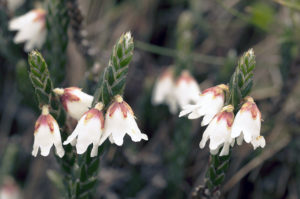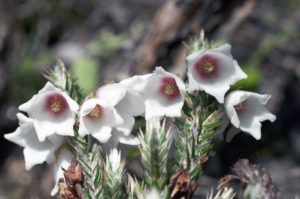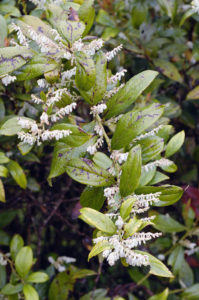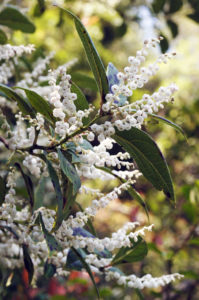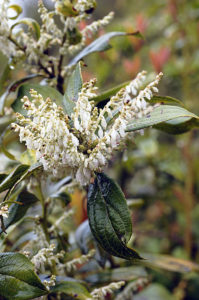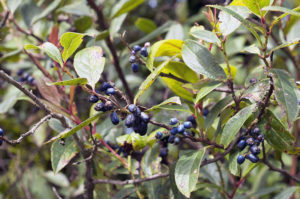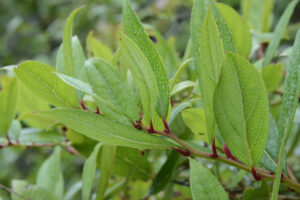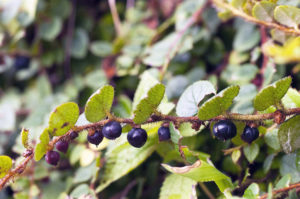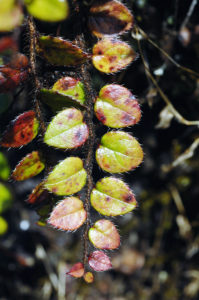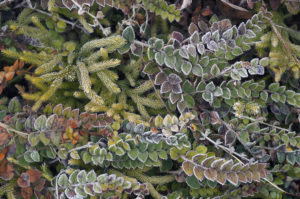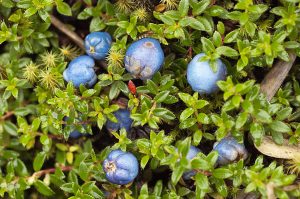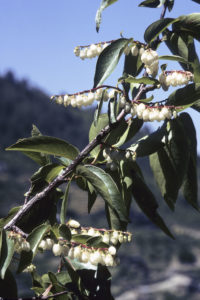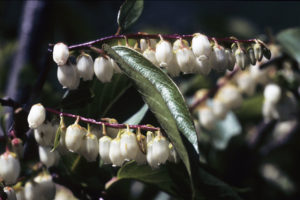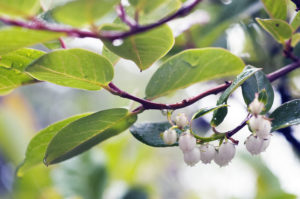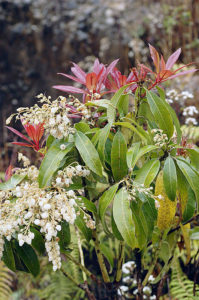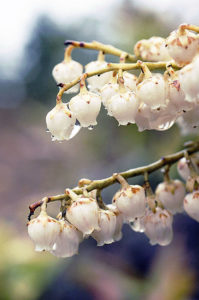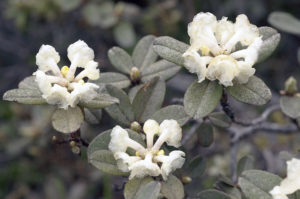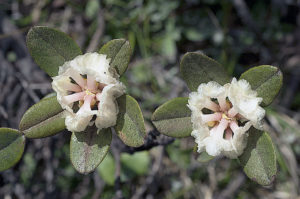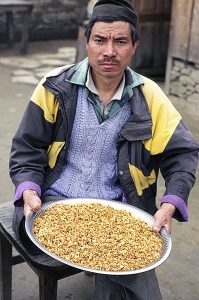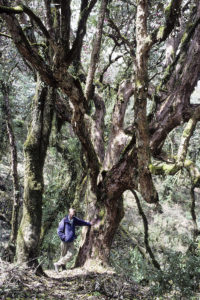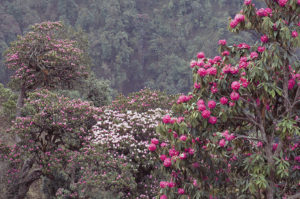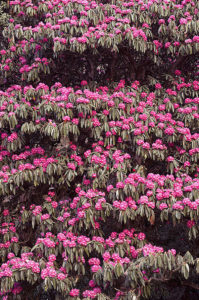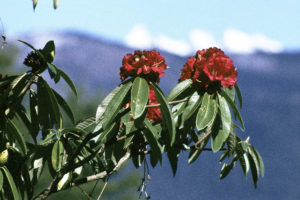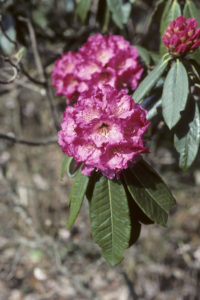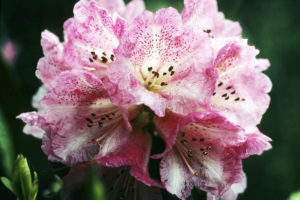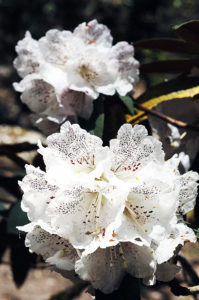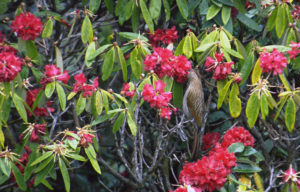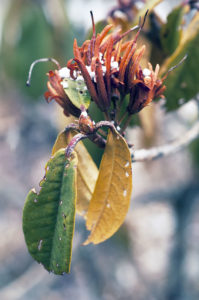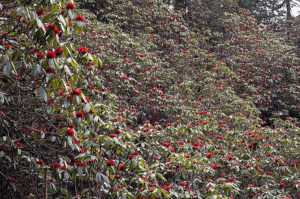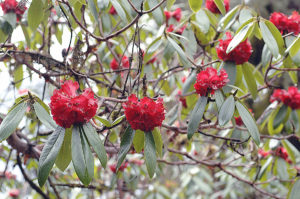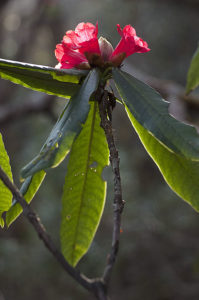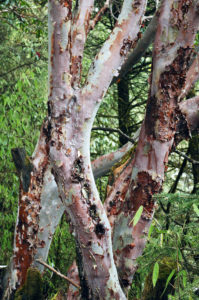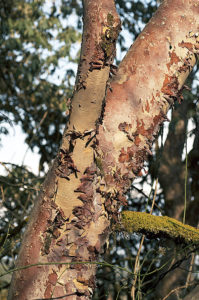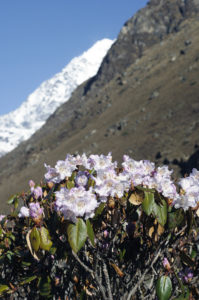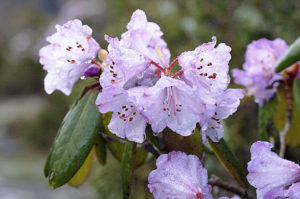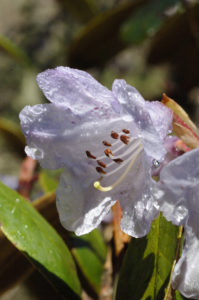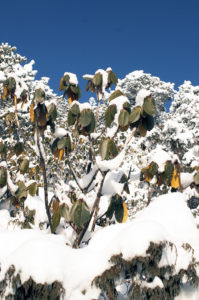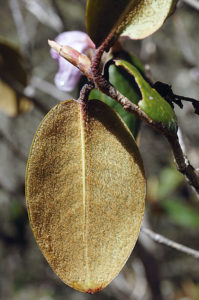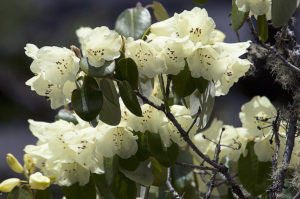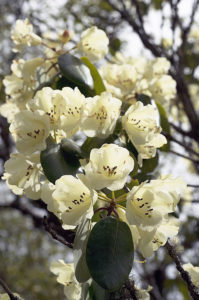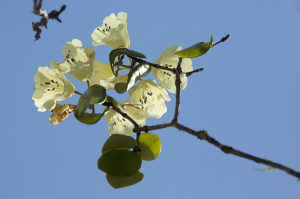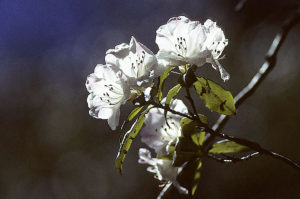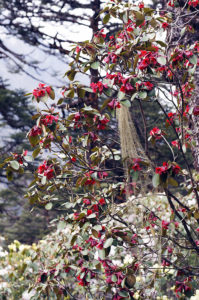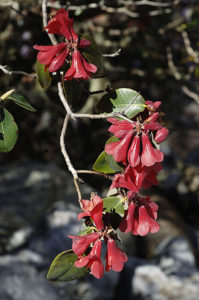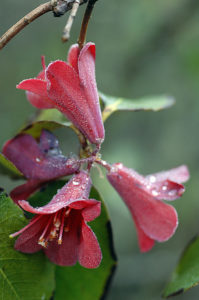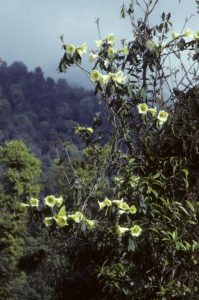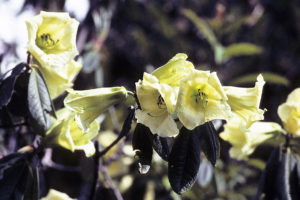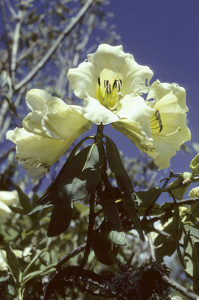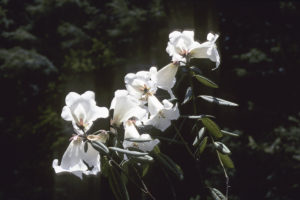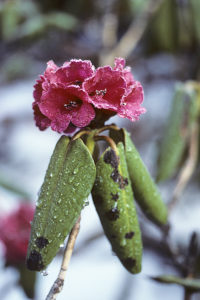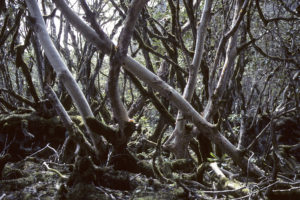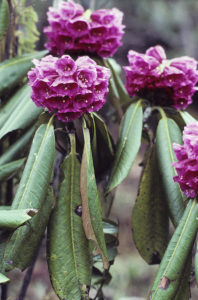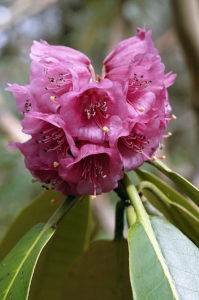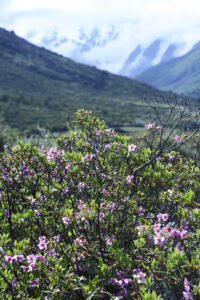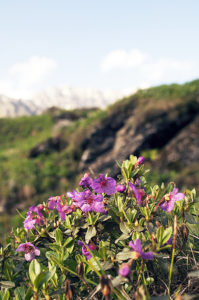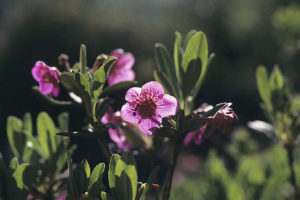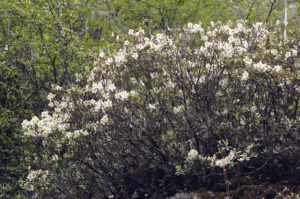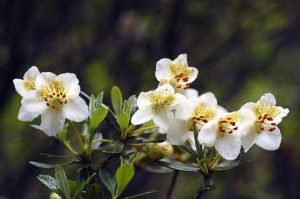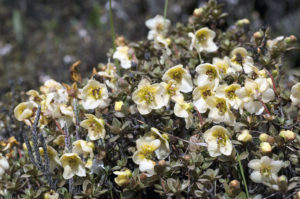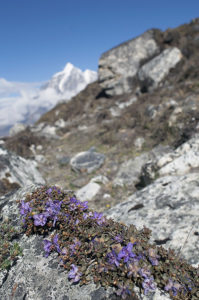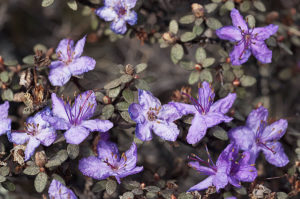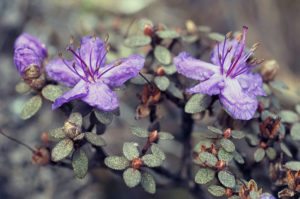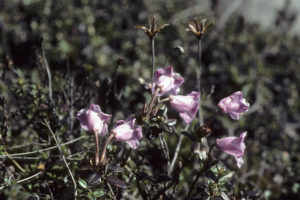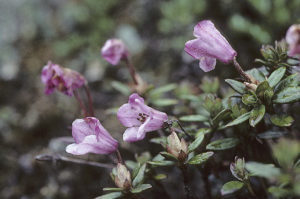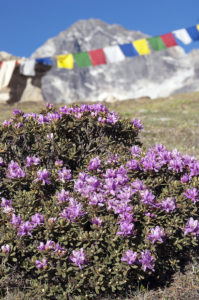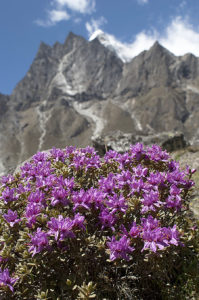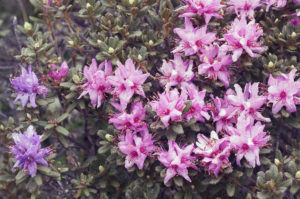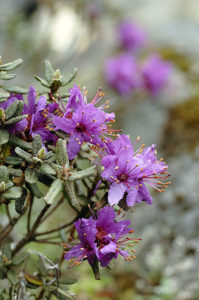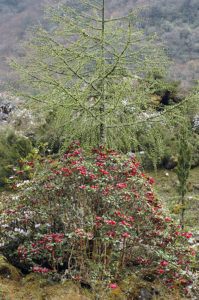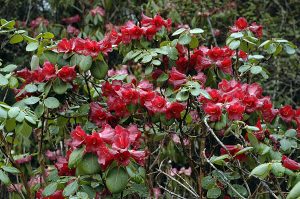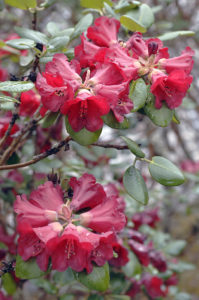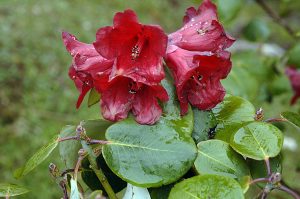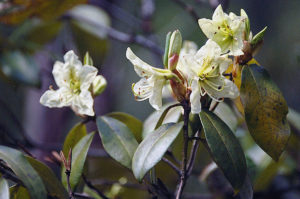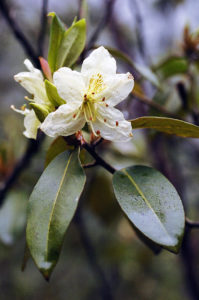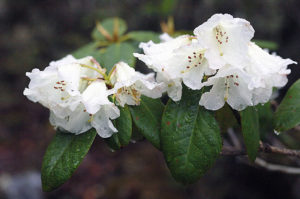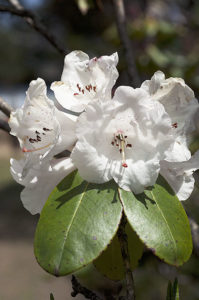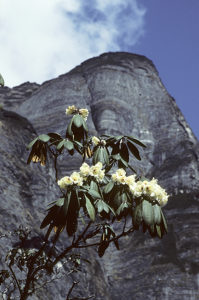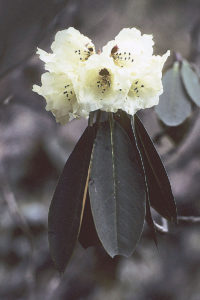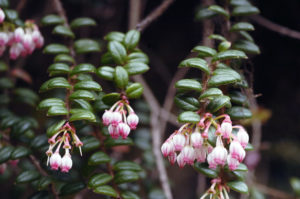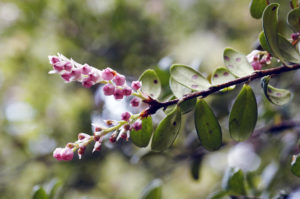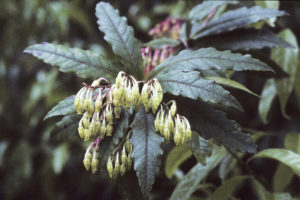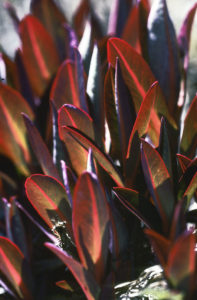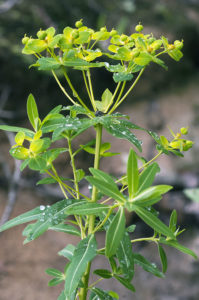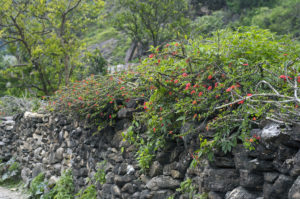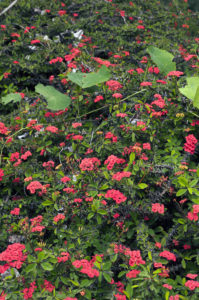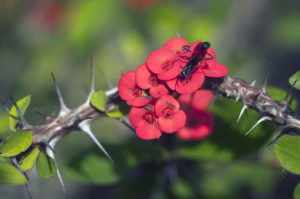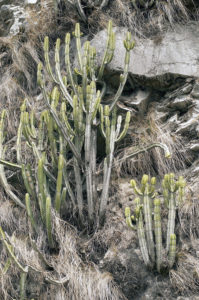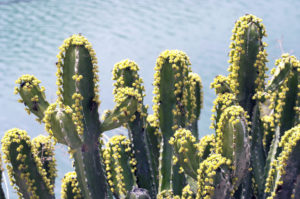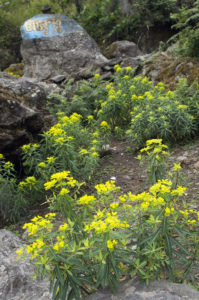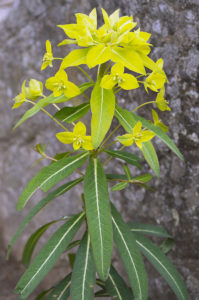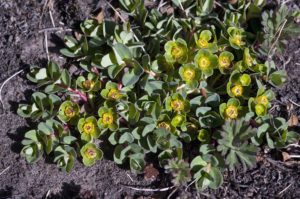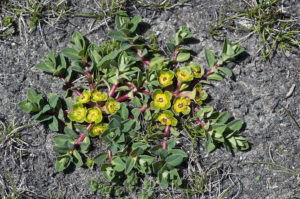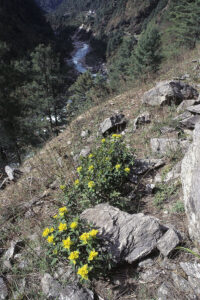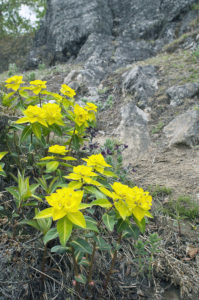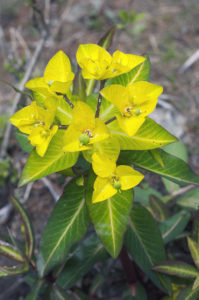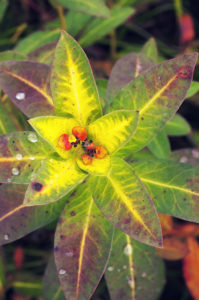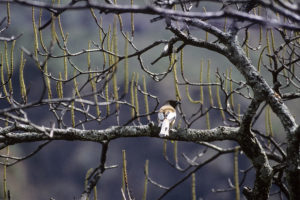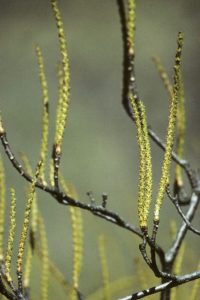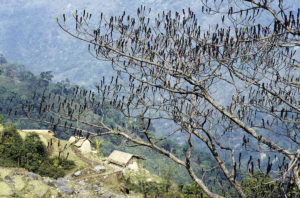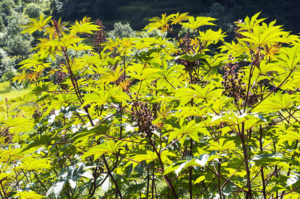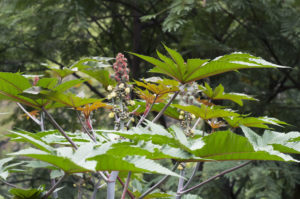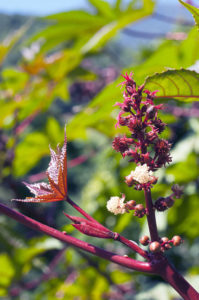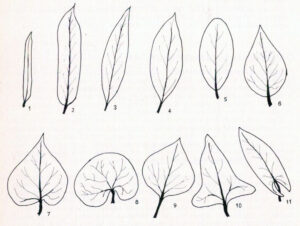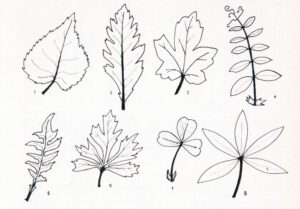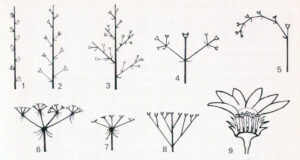Himalayan flora 1
During the peak of the monsoon, this oak forest in the Rolwaling Valley, central Nepal, is incredibly lush, the great trees heavily laden with epiphytes such as mosses, ferns, and Begonia flowers. (Photo copyright © by Kaj Halberg)
Contrasting sharply with the lushness in the picture above, this saxifrage, Saxifraga andersonii, grows on a barren rock in a high-altitude, alpine landscape around Annapurna Base Camp, central Nepal. As a means of protection against cold and evaporation, this plant forms compact cushions up to 10 cm across. (Photo copyright © by Kaj Halberg)
Rich vegetation on the Kongmaru La Pass (5274 m), Markha Valley, Ladakh, with green cushions of Thylacospermum caespitosum, the yellow-flowered Biebersteinia odora, a blue larkspur, Delphinium brunonianum, and an aster (Aster). In the background leaves of a rhubarb (Rheum). (Photo copyright © by Kaj Halberg)
Rocky landscape near the Bara Lacha La Pass (c. 3900 m), Lahaul, Himachal Pradesh, showing autumn foliage of two species of pinkweed, red Koenigia tortuosa and orange-yellow Bistorta affinis. (Photo copyright © by Kaj Halberg)
Introduction
The word Himalaya is from the Sanskrit hima (‘snow’) and alaya (‘abode’), thus ‘The Abode of Snow’. The Himalaya consists of a long arch of gigantic mountains, stretching from northern Pakistan southeast to the northern tip of Myanmar – a distance of more than 2,500 km. In these mountains are the Earth’s largest concentration of very high peaks, fourteen of which reach an altitude of more than 8,000 m, whereas hundreds are more than 7,000 m high. (For comparison, the highest mountain outside Central Asia, Aconcagua in Argentina, is a mere 6,962 m.)
The borders of the Himalaya are not well defined. To the northwest, the Karakoram Mountains (which some authorities consider a part of the Himalaya, others do not) merge into the Hindu Kush and Pamir Mountains. To the north and northeast, several mountain chains in Ladakh, Tibet, and China are a continuation of the Himalaya proper.
As a result of the great span in altitude and precipitation – besides various other factors such as micro-climate and soil composition – flora and fauna of the Himalaya are indeed diverse. In these mountains, two bio-geographical regions meet, the Indo-Malayan Region, which includes most of the Indian Subcontinent, Indochina, southern China, Taiwan, the Philippines, and western Indonesia, eastwards to Borneo and Bali, and the Palaearctic Region, which includes Europe, northern Africa, and northern Asia, southwards to northern Arabia, Iran, the northern parts of the Himalaya, northern China, and Japan.
In most areas of the Himalaya, flora and fauna from the Indo-Malayan Region dominate, but in northern Pakistan, Kashmir, Ladakh, and far northern Nepal, Sikkim, Bhutan, Arunachal Pradesh, and Myanmar, at altitudes above c. 3,500 m, there is a large element of species from the Palaearctic Region.
The Himalaya is home to an overwhelming abundance of plant species. In Nepal alone, c. 6,500 species of seed plants have been found, and the number in the entire mountain range exceeds 10,000, of which about 4,000 are endemic to the area. To this number, add hundreds of species of ferns, clubmosses, mosses, and lichens.
When the monsoon has passed over the Himalaya from the south, almost all its humidity has already fallen as rain. Thus, the Tibetan Plateau north of the mountains receives very little rainfall. In many places, the annual mean precipitation is less than 100 mm, most of which falls as snow in the winter. For this reason, the major part of the landscape is dry and rather barren, with lush and green areas mainly found along rivers and around the numerous lakes of the region.
My experience with the rich and varied plant life at a number of Himalayan locations are related on the page Plant hunting in the Himalaya.
Because of the huge number of pictures, I present them on 3 separate pages:
1: Acanthaceae to Euphorbiaceae
2: Fabaceae to Primulaceae
3: Ranunculaceae to Zygophyllaceae, and ferns, lycopods, and lichens.
I am aware that lichens, strictly speaking, are not plants, but I include them anyway, as most people regard them as plants.
Acknowledgements
When describing the plants, I have relied heavily on two excellent books, Flowers of the Himalaya (Oxford University Press, 1984), written by Oleg Polunin and Adam Stainton, and Flora Simlensis. A Handbook of the Flowering Plants of Simla and the Neighbourhood (Thacker, Spink & Co., 1921), written by Sir Henry Collett. The former book is still available on the market, but, unfortunately, only a limited number of species in it are illustrated in colour.
The websites wikipedia.org, Flora of China (efloras.org/flora_page.aspx?flora_id=2), Flora of Pakistan (efloras.org/flora_page.aspx?flora_id=5), and powo.science.kew.org have also been of great value.
The vast majority of the information on usage of plants has been borrowed from Narayan Manandhar’s delightful book Plants and People of Nepal (Timber Press, 2002). My sincerest thanks to Mr. Manandhar. Tibetan Medicinal Plants, by T.J. Tsarong, published by Tibetan Medical Publications, India, 1994, has also been valuable.
Regarding the etymology, I have relied on the website Wiktionary, and on J. Corneliuson, Växternas namn. Vetenskapliga växtnamns etymologi. Språkligt ursprung och kulturell bakgrund, published by Wahlström & Widstrand, 1997 (in Swedish).
I am also indebted to my friend Ajai Saxena, who has provided more than two dozen pictures. Together, we have made several botanical trips in the Himalaya, sometimes accompanied by Ajai’s wife Madhu.
Madhu and Ajai Saxena and staff, ready for a botanical expedition into the Great Himalayan National Park, Himachal Pradesh, June 2007. (Photo copyright © by Kaj Halberg)
Lunch is ready, Great Himalayan National Park. (Photo copyright © by Kaj Halberg)
Himalayan flora 1: Acanthaceae to Euphorbiaceae
Rhododendron campylocarpum is very common in the Khumbu area, eastern Nepal, here photographed near the Tengboche Monastery. The peaks in the background are Nuptse (7879 m, left), Sagarmatha (Everest) (8850 m, behind Nuptse), and Lhotse (8511 m, centre). (Photo copyright © by Kaj Halberg)
Cyananthus lobatus was named for its large, lobed leaves, or maybe for the large, rhombic, spreading lobes. In this picture, it has found its way up through a dwarf rhododendron near Cholang Pati, Langtang National Park, central Nepal. (Photo copyright © by Kaj Halberg)
The spadix of Arisaema costatum is rather grotesque, having an extremely long, whip-like tip. – Surkhe, Solu, eastern Nepal. (Photo copyright © by Kaj Halberg)
Allium wallichii, just beginning to form fruits, Ghangyul (2500 m), Helambu, central Nepal. (Photo copyright © by Kaj Halberg)
The plants mentioned below are arranged alphabetically according to family name, genus name, and specific name. A glossary, showing the most frequently used ‘technical’ botanical terms, is found at the bottom of the page.
On this page, Tibet (in Chinese Xizang), Qinghai, and Xinjiang are treated as separate areas. The term ‘western China’ indicates Chinese territories just east of Tibet and Qinghai. The term ‘south-western China’ encompasses the provinces Yunnan, Guizhou, and Sichuan.
I would be grateful to receive information on any errors on this page, or if you are able to identify any of the species left unidentified. You may use this address: respectnature108@gmail.com.
Acanthaceae Acanthus family
This huge family, counting about 229 genera with c. 4,000 species of herbs, shrubs, climbers, or trees, is distributed in most parts of the world. In subtropical valleys of the Himalaya, members of this family are conspicuous, comprising about 30 genera.
A popular name of this family is bear’s breeches family. This strange name builds on a misunderstanding. A medieval Latin name of the plant, which Swedish botanist Carl Linnaeus (1707-1778), later named Acanthus mollis, was Acanthus sativus branca ursina (‘cultivated spiny (plant with) bear bracts’), alluding to the curved bracts of the inflorescence, which, to those who named the plant, apparently resembled a bear’s claws. Over time, branca was corrupted to breech, leading to the name bear’s breeches.
An unidentified member of Acanthaceae, Pokhara, Nepal. (Photo copyright © by Kaj Halberg)
Asystasia
This genus, comprising about 70 species, is widespread in the Tropics. It has a single member in the Himalaya.
The generic name is derived from Ancient Greek a (‘without’) and systis (‘consistency’), referring to the radially symmetrical flowers of the genus, an uncommon trait in Acanthaceae.
Asystasia macrocarpa
A shrubby herb with showy, pinkish-white or pale purplish flowers, to 3 cm long, conspicuously netted with purple within. The elliptic leaves are to 15 cm long. This species is common at altitudes up to 2,100 m, distributed from Uttarakhand eastwards to Bhutan.
The specific name, derived from Proto-Indo-European makros (‘to increase’) and the Greek karpos (‘fruit’), refers to the large fruit, a cylindrical capsule to 3.5 cm long.
Flower size and colour To 3 cm long, pinkish-white or pale purplish.
Height to 1.5 m.
Habitat Shrubberies, waste areas.
Flowering Mar.-Apr.
Asystasia macrocarpa, Hille, Annapurna, central Nepal. (Photo copyright © by Kaj Halberg)
Barleria Bush-violet
A genus with about 300 species, found in tropical regions of Africa and Asia, with a single species in tropical America, yellow barleria (B. oenotheroides), which is illustrated on the page In praise of the colour yellow. 2 species occur in the Himalaya.
The genus was named in honour of French Dominican monk and botanist Jacques Barrelier, Latinized into Jacobus Barrelierus (1606-1673), who spent several years in Spain and 23 years in Rome. The text to his work Hortus Mundi ou Orbis botanicus was destroyed by fire after his death, but his numerous drawings were preserved. French botanist and physician Antoine de Jussieu (1686-1758) published the drawings in 1714, titled Plantae per Galliam, Hispaniam et aliam observatae.
Barleria cristata
This much-branched, shrubby herb, growing to 2 m tall, but usually below 1 m, is widespread in tropical and subtropical Asia, ranging from Pakistan eastwards to southern China and Taiwan, southwards to Sri Lanka, Java, and New Guinea. However, it seems to be absent from most Indonesian islands. In the Himalaya, it is common at elevations between 600 and 2,600 m.
The leaves are short-stalked, dark green above and pale green below, elliptic or ovate, to 10 cm long and 4 cm wide, long-pointed, hairy along the veins. The flowers are in axillary or terminal clusters, calyx-lobes sharply pointed, corolla funnel-shaped, blue, violet, or pink, to 6.5 cm long, with rounded, spreading lobes, to 2.5 cm long.
This plant is widely cultivated as an ornamental plant. In Tamil Nadu, South India, it is often strung into garlands, worn by women in their hair.
In Nepal, a paste of the leaves is applied to boils and pimples, and juice of the root is used for indigestion, juice of the leaves for bronchitis. In Thailand, the plant is utilized as a tonic, diuretic, and blood purifier.
The specific name is Latin, meaning ‘crested’. It may refer to the inflorescence, which, with a bit of imagination, resembles a cock’s crest.
Flower size and colour To 6.5 cm long, blue, violet, or pink.
Height to 2 m, but usually below 1 m.
Habitat Shrubberies, open slopes.
Flowering May-Oct.
Barleria cristata, Bahundanda, Lower Marsyangdi Valley, Annapurna, central Nepal. (Photo copyright © by Kaj Halberg)
Blue-flowered form of Barleria cristata, photographed near Manikaran, Parvati River Valley, Himachal Pradesh. (Photo copyright © by Kaj Halberg)
Pink-flowered form of Barleria cristata, Garhwal, Uttarakhand. (Photo copyright © by Kaj Halberg)
Dicliptera Foldwing
A genus with about 100 species, found in tropical, subtropical, and temperate regions around the world. 2 species occur in the Himalaya.
The generic name is from the Greek diklis (‘folding doors’) and pteron (‘wing’), alluding to the winged capsule, which, at maturity, is opening into two symmetrical parts, exposing the seeds.
Dicliptera bupleuroides
This herb, growing to 90 cm tall, has ovate or lanceolate, long-pointed leaves, to 12 cm long and 6 cm wide, but usually smaller, margin entire, wavy, sometimes with a few weak teeth. The flowers are arranged in small stalked clusters in the leaf axils, or sometimes at the end of branches. The corolla is to 1.5 cm long, pink with purple blotches inside, lower lip broadly ovate, pointed, to 6 mm long, upper lip oblong, about 6 mm long, with 3 tiny teeth.
This plant grows in shady places at altitudes between 500 and 2,000 m, from Afghanistan eastwards to south-western China and thence southwards to Indochina.
The specific name means ‘like Bupleurum‘, members of the umbellifer family (Apiaceae), see below. To me, any similarity to these plants is very hard to see.
Flower size and colour To 2 cm long and across, pink.
Height to 90 cm.
Habitat Forests, shrubberies, along trails.
Flowering Most of the year.
Dicliptera bupleuroides, Ropa, Tirthan Valley, Himachal Pradesh. (Photo copyright © by Kaj Halberg)
Justicia
This huge genus, counting about 700 species, is distributed in most warmer areas of the globe. 4 species have been observed in the Himalaya.
The generic name was given in honour of Scottish horticulturalist Sir James Justice (1698-1763), whose works on gardening, The Scots Gardener and The British Gardener, were much used in Britain and Ireland.
Justicia adhatoda Malabar nut
This strong-smelling shrub, which may sometimes grow to 4 m tall, was previously known as Adhatoda vasica. The former name is a corruption of the Sinhalese name of the plant, ada thoda, whereas the name vasica is a Latinized version of its Sanskrit name, vasaka.
The branches are sometimes 4-angled, downy when young, later smooth. The leaves are short-stalked, elliptic-lanceolate, entire, to 25 cm long and 7 cm wide, with prominent veins. The flowers are in compact terminal and axillary spikes to 7 cm long, with conspicuous overlapping bracts. The corolla is to 3 cm long, white with purple or red streaks and dots, 2-lipped, the upper lip down-curved, with 2 lobes, the lower lip with 3 large rounded lobes. The capsule is club-shaped, hairy, to 3 cm long.
This plant is distributed from Afghanistan across the Indian Subcontinent to south-western China and Indochina, in the Himalaya found up to altitudes around 1,600 m.
It is toxic, and is therefore avoided by grazing animals, often forming extensive growths. It is sometimes planted as a goat-proof hedge around vegetable gardens. In Ayurvedic medicine it is widely used in treatment of cough, bronchitis, and asthma, and also for peptic ulcers and itchy skin.
Flower size and colour To 3 cm long, white, streaked or dotted with purple or red.
Height to 4 m, but often much lower.
Habitat Shrubberies, waste places, along roads.
Flowering Dec.-Apr.
Justicia adhatoda, Hille, Annapurna, central Nepal. (Photo copyright © by Kaj Halberg)
Justicia adhatoda, growing in an abandoned plot, Kathmandu, Nepal. (Photo copyright © by Kaj Halberg)
Phlogacanthus
This genus, which is characterized by showy inflorescences, contains more than 40 species, distributed in Tropical Asia. 4 species are found in the lower valleys of the Himalaya.
The generic name is derived from the Greek floga (‘flame’) and anthos (‘flower’), referring to the colourful flowers of the genus.
Phlogacanthus thyrsiformis
This evergreen shrub, which is also known as P. thyrsiflorus, is very pretty in winter or early spring, when it displays numerous dense, cylindrical spikes, to 30 cm long, of brick-red or orange-red flowers, to 2.5 cm long, situated above a dense cluster of large leaves, to 25 cm long. It is found up to 1500 m elevation, from Uttarakhand eastwards to Myanmar.
The flowers are eaten as a vegetable, but the taste is quite bitter. Medicinally, the plant is used for cough, colds, and asthma.
The specific name means ‘formed like a thyrse’, derived from Ancient Greek thyrsos, a wand wreathed in ivy and vine-leaves with a pine-cone at the top, carried by devotees of Dionysos, the wine god. The inflorescence resembles a pine cone.
Flower size and colour To 2.5 cm long, brick-red or orange-red.
Height to 2.5 m.
Habitat Forests, banks.
Flowering Dec.-Mar.
Phlogacanthus thyrsiformis, near Fakot, Uttarakhand. (Photos copyright © by Kaj Halberg)
Strobilanthes
A genus with around 250 species worldwide, distributed in warmer parts of Asia and in Madagascar. About 25 species are found in the Himalaya, many of them very similar and difficult to identify.
The generic name is derived from the Greek strobilos (‘cone’) and anthos (‘flower’), thus ‘cone-shaped flower’, introduced in 1826 by German-Dutch botanist Karl Ludwig von Blume (1796-1862), alluding to the appearance of the young inflorescence of a Javanese species, Strobilanthes cernua.
Strobilanthes atropurpurea
This species, previously known as Strobilanthes wallichii or Pteracanthus alatus, may be identified by the rather short, inflated, strongly curved flowers, which are dark blue, pale blue, or sometimes a combination of white and blue, or white and purple. It is widespread in the Himalaya, from Pakistan eastwards to Myanmar, between 1,500 and 3,600 m altitude. Juice of the plant is applied to wounds.
This plant is especially common in coniferous forests, flowering at intervals of often several years.
The specific name is from the Latin ater (‘dark’) and purpureus (‘purple’), alluding to the flower colour.
The obsolete specific name wallichii refers to Danish physician and botanist Nathaniel Wallich (1786-1854), who made a career as botanist in India. From 1808, he was employed as surgeon in the Danish settlement Frederiksnagore (today Serampore), near Calcutta (today Kolkata). However, due to the Danish alliance with Napoleon, many Danish colonies were seized by the British, who were enemies of Napoleon. When the British East India Company took over Frederiksnagore, Wallich was imprisoned, but was released in 1809 due to his scholarship. From 1814, he became an assistant surgeon in the East India Company.
Wallich was involved in the early development of the Royal Botanic Garden, Calcutta, serving there until 1846, when he retired from the service. He went on numerous expeditions, and also offered his assistance to many plant collectors, who made a stop in Calcutta on their way to the Himalaya. Wallich prepared a catalogue of more than 20,000 plant specimens, and he published two books, Tentamen Florae Nepalensis Illustratae and Plantae Asiaticae Rariores.
After his retirement he stayed in London, where he became vice-president of the Linnean Society.
Flower size and colour To 3 cm long, dark blue, pale blue, or whitish-purple.
Height to 60 cm.
Habitat Forests, shrubberies.
Flowering Jun.-Oct.
Strobilanthes atropurpurea, Naggar, south of Manali, Himachal Pradesh. (Photo copyright © by Kaj Halberg)
White-and-purple-flowered form of Strobilanthes atropurpurea, Bireth Nallah, Great Himalayan National Park, Himachal Pradesh. (Photo copyright © by Kaj Halberg)
Strobilanthes attenuata Nettle-leaved strobilanthes
A large, shrubby herb, to 1 m tall, with large, hairy, heart-shaped, long-pointed, serrated leaves, to 12 cm long and 7.5 cm wide, a conspicuous calyx with a small tube, deeply divided into unequal, linear lobes, to 12 mm long, and slightly curved flowers. It is distributed from Afghanistan eastwards to central Nepal, at altitudes between 2,000 and 3,500 m.
The specific name is Latin, meaning ‘reduced’. What it refers to is not clear. Formerly, this plant was called Strobilanthes alatus or Pteracanthus urticifolius, the name urticifolius referring to the nettle-like leaves.
Flower size and colour To 3.5 cm long, blue, or blue with a whitish throat.
Height to 1 m.
Habitat Forests, shrubberies, grasslands.
Flowering Jun.-Oct.
Strobilanthes attenuata, Manali, Himachal Pradesh. (Photo copyright © by Kaj Halberg)
Flowers of Strobilanthes attenuata, covered in raindrops from a recent shower, Shyabru, Langtang National Park, central Nepal. (Photo copyright © by Kaj Halberg)
Strobilanthes nutans
As opposed to other members of this genus, the white flowers of S. nutans are pendent, and their base is covered by conspicuous, white or brownish, overlapping bracts. Stem and flower stalks are densely hairy. This species is found in Nepal at medium altitudes.
It was first collected in 1821 by Danish physician and botanist Nathaniel Wallich (1786-1854), who studied the Indian and Himalayan flora in the early 1800s (see Strobilanthes atropurpurea above). Formal publication had to await the third volume of Wallich’s Plantae Asiaticae Rariores, from 1832, where it was described as a new species under the name Goldfussia nutans by German botanist Christian Nees von Esenbeck (1776-1858), the then expert on the Acanthaceae. (Source: Curtis’s Botanical Magazine 2014, 31 (2): 168-179, Royal Botanic Gardens, Kew)
The specific name is Latin, meaning ‘nodding’, referring to the pendent flowers.
Flower size and colour To 3 cm long, white.
Height to 50 cm.
Habitat Shrubberies.
Flowering Jul.-Sep.
Strobilanthes nutans, Kutumsang, Langtang National Park, central Nepal. A species of spikemoss (Selaginella) and unripe berries of Hemiphragma heterophyllum, of the plantain family (Plantaginaceae), are also seen. (Photos copyright © by Kaj Halberg)
Strobilanthes nutans, Chipling, Helambu, central Nepal. (Photo copyright © by Kaj Halberg)
Strobilanthes penstemonoides var. dalhousieana
This tall herb has rather long, slender flowers and large, ovate, long-pointed leaves, to 15 cm long, which are either sessile or tapering into a winged stalk. It is common at altitudes between 1,800 and 2,600 m, distributed in the major part of the Himalaya.
The specific name means ‘resembling Penstemon’, alluding to the likeness of the flowers of this species to those of the genus Penstemon, the beardtongues, which are native to North America. The name is derived from Ancient Greek penta (‘five’) and stemon (‘stamen’). The variety name was given in honour of Lady Dalhousie, wife of George Ramsay, the 9th Earl of Dalhousie, who was governor-general in India in the first half of the 1800s. Lady Dalhousie was an avid collector of plants.
Flower size and colour To 4 cm long, dark blue, pale blue, or white-and-blue.
Height to 90 cm.
Habitat Forests, shrubberies.
Flowering Jul.-Oct.
Strobilanthes penstemonoides var. dalhousieana, Great Himalayan National Park, Himachal Pradesh. (Photo copyright © by Kaj Halberg)
Strobilanthes penstemonoides var. dalhousieana, Shermatang (2500 m), Helambu, central Nepal. (Photo copyright © by Kaj Halberg)
Aceraceae (maple family), see Sapindaceae on page Himalayan flora 3.
Adoxaceae (moschatel family), see Viburnaceae on page Himalayan flora 3.
Agavaceae (agave family), see Asparagaceae.
Amaranthaceae Cockscomb family
This worldwide family contains about 174 genera with 2,100 to 2,500 species of herbs or shrubs, rarely trees or climbers. Many of the species were formerly in the goosefoot family (Chenopodiaceae), which is now regarded as a subfamily, Chenopodioideae, of the amaranth family. About 17 genera occur in the Himalaya.
Achyranthes
A genus of about 15 species of herbs, sometimes shrubby, widely distributed in tropical and subtropical regions. 2 species are found in the Himalaya.
The generic name is derived from Ancient Greek akhyron (‘straw’, ‘chaff’) and anthos (‘flower’), referring to the prickly, chaff-like inflorescence. Popular names of these plants include prickly chaff-flower and devil’s horsewhip, likewise alluding to the flowers.
Achyranthes aspera
The stem of this herb is 4-edged, to 1.2 m tall, leaves broadly obovate or elliptic, to 13 cm long and 8 cm wide, apex abruptly narrowed to a short point. The flowers are dull green, sometimes tinged with purple, to 5 mm long, crowded on a terminal spike, which may be up to 40 cm long. Bracts and bracteoles are spiny, to 4.5 mm long, with 2 wings, to 2 mm long, at the base.
This plant has a very wide distribution, found in southern Europe, Africa, and warmer areas of Asia, eastwards to Taiwan. In the Himalaya, it is found up to an elevation of 2,300 m.
The specific name is from the Latin asper (‘rough’, ‘sharp’), alluding to the spiny bracts.
Flower size and colour To 5 mm long, dull green, sometimes tinged with purple.
Height to 1.2 m.
Habitat Open areas, waste places, roadsides, riverbanks.
Flowering May-Oct.
Achyranthes aspera, Manali, Himachal Pradesh. (Photo copyright © by Kaj Halberg)
Amaranthus Pigweed, amaranth
A worldwide genus of about 75 species, of which about 6 have become naturalized in the Himalaya, and at least 2 others are cultivated.
The generic name is derived from Ancient Greek a (‘not’, ‘without’) and maraino (‘to wither’), given in reference to the flowers, which last a very long time.
Amaranthus hybridus Smooth pigweed, green amaranth
This herb sometimes grows to 2 m tall, but is usually much lower. The stem is branched, leaves ovate or rhombic, to 4.5 cm long and 2.5 cm broad, hairy below, nearly smooth above, margin wavy, tip either pointed, or rounded with a short, needle-like point. Bracts are conspicuous, to 4 mm long, lanceolate, long-pointed, longer than the flowers, which are green, petals to 2 mm long.
It is native to eastern North America, but has become widely naturalized worldwide in warmer areas. In the Himalaya, it may be observed up to elevations around 2,600 m.
Flower size and colour Petals to 2 mm long, green.
Height to 2 m, but usually much lower.
Habitat Open slopes, waste areas, roadsides.
Flowering Jul.-Sep.
Amaranthus hybridus, growing next to an old wall, Kathmandu. (Photo copyright © by Kaj Halberg)
Amaranthus spinosus Spiny amaranth, spiny pigweed
Stem erect, to 1 m tall, much branched, green or purplish, with longitudinal lines, smooth or slightly downy. Leaf-stalk to 8 cm long, smooth, often with a small spine at the base, which gave rise to the specific name. Leaf blade ovate, rhombic, or broadly lanceolate, to 12 cm long and 6 cm wide, smooth, tip pointed or rounded, with a minute spine. Inflorescences terminal or axillary, to 25 cm long, male flowers usually in the terminal spike, bracts very spiny, petals green, transparent at the margin, to 2.5 mm long.
Presumably, this plant is native to the neotropics, but has been introduced to most subtropical and tropical regions. In the Himalaya, it may be found up to elevations around 3,200 m.
In Nepal, tender parts of the plant are cooked as a vegetable. It is also widely used in traditional medicine for a large number of ailments, including fever, diarrhoea, urinary trouble, stomach problems, gonorrhoea, boils, and eczema.
Flower size and colour Petals to 2.5 mm long, green, transparent at the margin.
Height to 1 m.
Habitat Waste areas, roadsides, gardens.
Flowering Jul.-Nov.
Amaranthus spinosus, Kielang, Lahaul, Himachal Pradesh. (Photo copyright © by Kaj Halberg)
Blitum Goosefoot
This genus, comprising 12 species, occurs in Europe, North Africa, Asia, Australia, and the Americas. A single species is found in the Himalaya.
The generic name is derived from the Greek bliton, the ancient name of the purple amaranth (Amaranthus blitum).
Formerly, these plants were placed in the goosefoot genus (Chenopodium). However, recent genetic research has shown that they are more closely related to spinach (Spinacia), which has caused them to be moved to a separate genus. (Source: S. Fuentes-Bazan et al. 2012: A novel phylogeny-based generic classification for Chenopodium sensu lato, and a tribal rearrangement of Chenopodioideae (Chenopodiaceae). Willdenowia 42:16-18)
Blitum virgatum Leafy goosefoot, strawberry sticks
When in fruit, this plant, formerly known by the name Chenopodium foliosum, is easily identified by its bright red, edible, succulent fruit clusters. Leaves and inflorescences are also edible, spinach-like in taste.
The stem, which may be either white, green, yellowish, or red, is erect or ascending, many-branched, to 1 m tall. The leaves are fleshy, triangular or ovate, coarsely toothed, lower ones to 9 cm long and 3 cm broad, gradually smaller up the stem. Inflorescences are dense green spikes in the leaf axils.
This species is widely distributed, growing in fallow fields and on open slopes, from central and southern Europe eastwards across the Middle East to Central Asia, with the eastern limit in Gansu, southwards to northern Africa, Iran, and the Himalaya, eastwards to central Nepal. In the Himalaya, it is found at elevations between 1,500 and 3,800 m. Due to its gorgeous fruits, it is widely cultivated elsewhere around the globe.
The specific name is derived from the Latin virga (‘staff’), presumably referring to the many straight stems of this plant. The popular name strawberry sticks was given in allusion to the bright red, edible berries.
Flower size and colour Tiny, green.
Height to 1 m.
Habitat Fallow fields, open slopes.
Flowering May-Aug.
Fruiting Blitum virgatum, growing at Lake Deepak Tal, Lahaul, Himachal Pradesh. (Photos copyright © by Kaj Halberg)
Chenopodium Goosefoot
This genus, containing about 170 species, is almost worldwide, but most abundant in temperate and subtropical zones. The generic name, derived from Ancient Greek khen (‘wild goose’) and podion, diminutive of poús (‘foot’), was given in allusion to the outline of the leaves of several species.
Chenopodium giganteum
This upright, many-branched, shrubby herb, which may grow to 3 m tall, is most probably a cultivar, originating in India, developed from the widespread white goosefoot (C. album). It may instantly be identified by the younger leaves, which are of a gorgeous magenta, reddish, or golden yellow colour, changing into green with age.
The stout stem, with a diameter of up to 5 cm at the base, is green, reddish-green, or purplish. Leaves are long-stalked, dark green or bluish-green above, pale green below, triangular, rhombic, or ovate, to 20 cm long and 16 cm wide, often with farina on the underside, margin irregularly toothed and wavy. Younger leaves are much smaller, often lanceolate or ovate, magenta, reddish, or golden yellow. Inflorescences are terminal or axillary clusters of tiny, green flowers.
A popular name of this plant is tree spinach, and young shoots and leaves are cooked like spinach. It is widely cultivated in the Himalaya and often escapes cultivation, found up to elevations around 3,600 m.
The stout stems are used for making walking-sticks.
Flower size and colour Tiny, green.
Height to 3 m, but often much lower.
Habitat Fields, waste areas, along trails.
Flowering Aug.-Oct.
Chenopodium giganteum, near Chiruwa, Tamur Valley, eastern Nepal. (Photo copyright © by Kaj Halberg)
Cyathula Pasture-weed
About 27 species of these shrubs or shrubby herbs are distributed in Asia, Pacific Islands, Africa, and the Americas. 3 species occur in the Himalaya.
The fruit is a globular or ovate head, prickly in some species, and often remaining on the plant throughout the winter.
The generic name is derived from the Greek kyathos, a small ladle, alluding to the flower shape.
Cyathula capitata
A slender, branched herb with dark purple or yellowish-brown stem. The broadly ovate leaves are to 14 cm long and 7 cm broad, abruptly narrowed to a tail-like end. The ellipsoid flowerheads, to 4 cm long, are solitary or few together. The flowers are divided into fertile ones, which are dark purple, and sterile ones, which are whitish or yellowish, to 4 mm long.
This plant is distributed from Kashmir and southern Tibet eastwards to south-western China and northern Vietnam. In the Himalaya, it is found at altitudes between 1,300 and 3,000 m.
The specific name is Latin, meaning ‘forming a head’, alluding to the shape of the inflorescence.
Flower size and colour To 4 mm long, two colour morphs, dark purple, and whitish or yellowish.
Height to 1 m.
Habitat Shrubberies, open areas.
Flowering Aug.-Sep.
Cyathula capitata, Changdam, Langtang National Park, central Nepal. (Photo copyright © by Kaj Halberg)
Cyathula tomentosa
Stems and branches of this shrub are densely downy, hence its specific name, from the Latin tomentosum (‘having a mass of rough hairs’). The leaves are lanceolate to elliptic, pointed, to 17 cm long and 5 cm broad. The tiny greenish-white flowers are in dense globular heads, to 4 cm across. However, there are only 1-2 regular flowers in each cluster, surrounded by many imperfect flowers, which are reduced to a single sepal with a spiny, hooked tip. The flower-heads are arranged in long, axillary or terminal spikes. The fruit is very spiny, often remaining on the plant until spring.
This species occurs at altitudes between 1,400 and 2,400 m, from Himachal Pradesh eastwards to south-western China. Juice of the root is taken for constipation, fever, and peptic ulcer. The squeezed root is used for washing clothes, and it is strewn in streams to stupefy fish.
Flower size and colour In dense globular heads to 4 cm across, petals greenish-white, tiny.
Height to 3 m.
Habitat Shrubberies, open areas.
Flowering Jun.-Aug.
Cyathula tomentosa, Pairo, Langtang National Park. (Photo copyright © by Kaj Halberg)
Cyathula tomentosa, Pairo, Trisuli River Valley, Langtang National Park, central Nepal. (Photo copyright © by Kaj Halberg)
Cyathula tomentosa, Chamje (1400 m), Lower Marsyangdi Valley, Annapurna, central Nepal. (Photo copyright © by Kaj Halberg)
Fruits from the previous year of Cyathula tomentosa, Tirkhedunga, Annapurna, central Nepal. The flowers in the background in the upper picture are yellow flax (Reinwardtia indica), and the fallen flower in the lower picture is Rhododendron arboreum. (Photos copyright © by Kaj Halberg)
Haloxylon
A genus of about 11 species of shrubs or small trees, found from the Mediterranean eastwards to Central Asia. One species is found in dry Tibetan areas of the Himalaya.
The generic name is derived from the Greek halo (‘saline’) and xylon (‘tree’), referring to the fact that these plants often grow in saline habitats.
Haloxylon griffithii ssp. wakhanicum
This small shrub, to 80 cm tall, is distributed in desert areas at altitudes between 3,000 and 3,600 m, from Afghanistan eastwards to Pakistan and Ladakh. It has whitish or blue-green branches, and pink or pinkish-white flowers in the leaf axils, petals ovate, to 1.5 mm long. The fruit is winged, white, pinkish, or yellowish, to 8 mm across.
The specific name honours British physician and botanist William Griffith (1810-1845), who spent most of his adult life in India and Myanmar. After a brief stay in Madras, he was assigned as a surgeon to Tenasserim, Myanmar. During the following years, he explored various parts of Myanmar, Sikkim, and the region around Shimla, north-western Himalaya. Subsequently, he was appointed as surgeon in Malacca, where he died of a parasitic liver disease, only 35 years old.
The subspecific name refers to the Wakhan Corridor in eastern Afghanistan. Presumably, the type specimen was collected there.
Flower size and colour To 1.5 mm long, pink or pinkish-white.
Height to 80 cm.
Habitat Deserts.
Flowering Jul.-Aug.
Haloxylon griffithii ssp. wakhanicum, photographed near Leh, Ladakh. (Photos copyright © by Kaj Halberg)
Amaryllidaceae Amaryllis family
A family with about 75 genera and 1,600 species, mainly found in tropical and subtropical areas around the world. About 5 genera occur in the Himalaya.
Allium Onion
A huge genus with more than 1,000 species of herbs, distributed mainly in temperate and subtropical regions of the Northern Hemisphere, with some species in southern Africa. The core area of the genus is temperate areas of Asia, and no less than 70 species are found in the Himalaya, the major part in dry Tibetan areas.
The inflorescence of these plants is very distinctive, consisting of a compact globular umbel on an unbranched stem. Initially, the umbel is enclosed in a papery spathe, which splits into lobes, when the stalked flowers unfold.
The generic name is the old Latin name of garlic (A. sativum), which is described in detail on the page Plants: Plants in folklore and poetry.
At one time, these plants were placed in the family Alliaceae, which is now regarded as a subfamily, Allioideae, of Amaryllidaceae.
Allium carolinianum
A stout plant, to 50 cm tall, with rather broad, bluish-green, curved leaves and a dense umbel, to 3.5 cm across, of pink to reddish flowers. This species grows on dry, stony slopes, at altitudes between 3,000 and 5,100 m, from Pakistan to western Nepal, and also in Central Asia.
Fresh leaves are edible, and dried leaves are used as a flavouring agent. The plant also has medicinal value, as it is used to expel intestinal worms.
The specific name presumably refers to one of the numerous kings bearing the name Charles, in German Karl, and in the Latinized form Carolus.
Flower size and colour To 9 mm long, pink or reddish.
Height to 50 cm.
Habitat Stony slopes.
Flowering Jul.-Aug.
Allium carolinianum is fairly common in Spiti, Himachal Pradesh, where this picture was taken. (Photo copyright © by Kaj Halberg)
Allium oreoprasum
The 3-5 olive-green leaves of this plant are narrow and linear, to 5 mm broad, and much shorter than the stem. The rather few, long-stalked flowers are white or pink with a purple mid-vein. The petals are elliptic, to 7 mm long and 4 mm broad. The leaves are edible.
In the Himalaya, this species is restricted to dry Tibetan borderlands, found from Pakistan eastwards to western Nepal, and is also widespread in Central Asia, at altitudes between 2,700 and 5,000 m.
The specific name may be derived from Spanish orear, ultimately from the Latin aura (‘air’, ‘breeze’), and Proto-Indo-European prasum (‘leek’), thus ‘the airy leek’. It is a graceful plant!
Flower size and colour To 7 mm long and 4 mm wide, white or pink.
Height to 40 cm.
Habitat Open stony areas.
Flowering Jun.-Aug.
Allium oreoprasum is common in Ladakh, here observed at Honupatta. Rosa webbiana is seen in the background. (Photo copyright © by Kaj Halberg)
Allium wallichii
As opposed to most other onion species, this plant thrives in humid areas, distributed from Pakistan eastwards to south-western China, at altitudes between 2,300 and 4,800 m. It is easily identified by its large umbel, to 7 cm across, the red or purple (rarely white) flowers, with lanceolate to elliptic, blunt, long-stalked petals, to 1 cm long, and the flat, keeled leaves, which are to 2 cm broad.
The leaves are edible, and the bulbs are used for diarrhoea, cough, and colds.
This plant was named in honour of Danish physician and botanist Nathaniel Wallich (1786-1854), who studied the Indian and Himalayan flora in the early 1800s (see Strobilanthes atropurpurea above).
Flower size and colour Petals to 1 cm long and 2 mm broad, red or purple.
Height to 90 cm.
Habitat Shrubberies, meadows, river banks.
Flowering Jul.-Sep.
Allium wallichii, Thangshyap (3200 m), Langtang National Park, central Nepal. (Photo copyright © by Kaj Halberg)
Allium wallichii, near Ghora Tabela, Langtang National Park, central Nepal. (Photo copyright © by Kaj Halberg)
Zephyranthes
Today, this genus, according to Plants of the World Online, contains about 185 species, found in tropical and subtropical America. 2 species have become naturalized in the Himalaya.
The generic name is derived from Zephyrus, the Greek God of the West Wind, who re-awakened nature every spring, and anthos (‘flower’).
Zephyranthes carinata Rosepink zephyr lily, pink rain lily
This gorgeous plant, a native of Mexico, is widely cultivated as an ornamental in the Himalaya and has become naturalized in many places. Leaves several, linear, keel-shaped, to 30 cm long and 8 mm wide. Flower stalk about as long as the leaves, purple just below the solitary, terminal, flower, tube whitish, to 2.5 cm long, lobes obovate, pink or rose-coloured, to 6 cm long, tip rounded or pointed, stamens yellow, thread-like, style white, slender, stigma 3-lobed.
The specific name is derived from the Latin carina (‘keel’), alluding to the shape of the leaves.
Flower size and colour Tube to 2.5 cm long, whitish, lobes to 6 cm long, pink or rose-coloured.
Height to 30 cm.
Habitat Fields, open areas.
Flowering Summer and autumn.
Zephyranthes carinata, naturalized in a fallow field, near Pati Bhanjyang, Helambu, central Nepal. (Photos copyright © by Kaj Halberg)
Anacardiaceae Sumac family
This family, comprising about 83 genera with c. 860 species, is native to tropical and subtropical areas around the world, with a few species occurring in temperate regions. Several species are economically important fruit and nut crops, including the cashew tree (Anacardium occidentale).
The family name is from the Greek ana (a prefix) and kardia (‘heart’), alluding to the thick, heart-shaped stalk of the cashew nut.
Rhus Sumac
Sumacs are a genus of c. 35 species, distributed in subtropical and temperate areas, especially around the Mediterranean, and in Asia, Australia, and North America. Many other species, which were formerly placed in Rhus, have been transferred to the genera Searsia and Toxicodendron.
Rhus is the Ancient Greek name of sumac, which is derived from Ancient Syriac summaq (‘red’), referring to the red fruits of the genus. They have an acrid taste and are used as a spice in the Middle East. In North America, the fruits of staghorn sumac (Rhus typhina) are soaked in cold water to make ‘pink lemonade’, a refreshing beverage, rich in vitamin C.
Rhus chinensis Chinese sumac
This deciduous shrub or small tree, sometimes growing to 12 m tall, was previously known as Rhus javanica var. chinensis. It is native from the Indian Subcontinent and southern Tibet eastwards to southern China, Taiwan, Korea, and Japan, and thence southwards through Indochina to Sumatra. It often forms thickets, easily spreading by means of suckers, growing from the lowlands up to an altitude of c. 2,800 m.
The leaves are very large, to 40 cm long, pinnate, with 5-13 toothed leaflets, to 12 cm long and 5 cm wide. The inflorescence is also very large, to 30 cm long, consisting of countless tiny yellowish-green flowers. The fruit is a globular drupe, to 5 mm in diameter, turning reddish-brown at maturity.
Tannins are extracted from galls of this species, popularly called Chinese galls, which are also widely used in traditional Chinese medicine for a variety of ailments, including cough, diarrhoea, dysentery, and intestinal bleeding. The fruit is edible when cooked. It has an acid flavour.
Flower size and colour To 3 mm across, yellowish-green.
Height to 12 m.
Habitat Forests, shrubberies.
Flowering Aug.-Sep.
Fruiting Rhus chinensis, Solang Nallah, Manali, Himachal Pradesh. (Photos copyright © by Kaj Halberg)
Searsia
A genus of about 110 species, formerly placed in the genus Rhus. These plants are mainly restricted to southern Africa, with 3 species in eastern Asia.
The genus is named in honour of Paul B. Sears (1891-1990), who was head of the Yale School of Botany.
Searsia parviflora
This much-branched shrub, to about 3 m tall, has leaves with three large, rounded leaflets, the terminal one larger than the lateral ones, margin irregularly toothed. Young parts are densely covered in greyish down. The inflorescence is a spreading cluster of tiny, yellowish, fragrant flowers. The drupe is ovoid, to 5 mm across, orange-yellow or red when ripe, shining.
This plant is widespread in the Indian Subcontinent, eastwards to Myanmar. In the Himalaya, it is found from Uttarakhand eastwards to Bhutan, at elevations between 700 and 1,100 m.
The specific name is Latin, meaning ‘small-flowered’. Some authorities place this species in the genus Toxicodendron, the poison sumacs.
Flower size and colour Tiny, yellowish.
Height to 3 m.
Habitat Forests.
Flowering Apr.-May.
Flowers and young leaves of Searsia parviflora, Lower Asi Ganga Valley, Uttarakhand. (Photo copyright © by Kaj Halberg)
Apiaceae (Umbelliferae) Carrot family
A huge worldwide family, containing about 434 genera with c. 3,700 species of herbs. About 40 genera occur in the wild in the Himalaya, and several others are cultivated.
The inflorescence of this family is unique. In almost all species, the flowers are arranged in terminal umbels, which may be simple, usually with bracts at the base, and each of the stalks, the so-called primary rays, ending in a flower. More commonly, the umbel is compound, consisting of a number of primary rays, each ending in a secondary umbel. Each of these umbels usually has small bracts, bracteoles, at the base, and a number of secondary rays, each ending in a flower. Usually, the secondary umbels together form a flat-topped inflorescence, mostly with white, yellow, pink, or purple flowers, rarely blue or bright red. The flowers have five petals and stamens. This also accounts for the sepals, if they are present. They are usually missing, however.
The family name is derived from the name of honey bees, genus Apis, referring to the fact that many plants of the family are much visited by bees and other nectar-sucking insects, in particular hovering flies.
An unidentified umbellifer, Rohtang La Pass, Himachal Pradesh. (Photos copyright © by Kaj Halberg)
Another unidentified umbellifer, possibly a species of Pimpinella, Polo Kongga La Pass (4600 m), Ladakh. (Photo copyright © by Kaj Halberg)
Bupleurum Hare’s-ear, thoroughwax
A large genus of herbs or shrubs, comprising about 190 species, varying from tiny plants a few cm tall, to stately plants, almost 3 m high. The bracteoles are sometimes large and may attract pollinators. Almost all of these plants are native to the Palaearctic Northern Hemisphere, with one species in North America and one in southern Africa. About 8 species occur in the Himalaya and Ladakh.
The generic name is derived from Ancient Greek bous (‘ox’) and pleuron (‘rib’), alluding to the shape of the roots. The name hare’s-ear refers to B. rotundifolium, some of whose leaves are shaped as a hare’s ears, whereas thoroughwax is a corruption of a German name of these plants, Durchwachs (‘growing through’), alluding to the stem of some species, which appears to grow through the leaves.
The roots of several species of hare’s-ear are an important ingredient in the traditional Chinese medicine chai hu, utilized for a huge number of ailments, including respiratory problems, dizziness, menstrual irregularity, cough, fever, and influenza. The name literally means ‘kindling of the barbarians’. Presumably, some Chinese observed the ‘barbarians’ using dried hare’s-ear stems as kindling.
Bupleurum candollei
This tall herb has ovate, sessile stem leaves, to 12 cm long, more or less clasping the stem. The primary umbel is encircled by 2-4 unequal, ovate bracts that resemble leaves. The secondary umbels are to 1 cm across, surrounded by 4-5 ovate bracteoles. The tiny flowers are yellow, to 2 mm across. This plant grows in forests and on open grassy slopes, at altitudes between 2,400 and 4,000 m, from Pakistan eastwards to south-eastern Tibet.
The specific name honours Swiss botanist Augustin Pyrame de Candolle (1778-1841), who created a new natural plant classification system.
Flower size and colour To 2 mm across, yellow.
Height to 1 m.
Habitat Forests, open grassy slopes.
Flowering Jun.-Aug.
Bupleurum candollei, Solang Nallah, Himachal Pradesh. (Photo copyright © by Kaj Halberg)
Bupleurum gracillimum
This prostrate plant has many creeping branches, to 35 cm long. The leaves are linear, to 6 cm long, upper leaves shorter. Inflorescences are bright yellow. This species is found in humid areas of the Tibetan Plateau, such as meadows and along streams, from Pakistan eastwards to south-western China, at altitudes between 3,000 and 4,300 m.
The specific name is Latin, meaning ‘very slender’. What it refers to is not clear.
Flower size and colour To 1.5 mm across, yellow.
Height Stem to 1 cm tall, or absent, branches creeping, to 35 cm long.
Habitat Meadows, along streams.
Flowering Jul.-Sep.
Bupleurum gracillimum, Lossar, Spiti, Himachal Pradesh. (Photo copyright © by Kaj Halberg)
Bupleurum longicaule
This slender herb has narrow, lanceolate, long-pointed leaves, to 10 cm long, and inflorescences are usually purple or blackish-brown, but may be yellow. The secondary umbels, each about 1 cm across, are subtended by ovate, abruptly pointed bracteoles, longer than the flowers, making the umbels resemble small stars. This species is distributed from Pakistan eastwards to south-western China, at altitudes between 1,000 and 4,400 m.
The specific name is Latin, meaning ‘long-stemmed’.
Flower size and colour To 1.5 mm across, blackish-brown, dark purple, or yellow.
Height to 70 cm.
Habitat Forests, grassy areas, open slopes.
Flowering Jun.-Sep.
Bupleurum longicaule, Tragshindo La, Solu, eastern Nepal. (Photo copyright © by Kaj Halberg)
Bupleurum marginatum
A tall herb with linear or lanceolate, pointed leaves, to 16 cm long and 1.5 cm wide, having a narrow white margin. Umbels are yellow-flowered, to 4 cm across, terminal as well as in the leaf axils. The bracteoles are tiny, to 2.5 mm long and 1 mm wide, shorter than the flower stalks. This plant is found in a wide variety of habitats, from Pakistan eastwards to south-western China, at 700 to 4,000 m altitude.
Previously, this species was regarded as a variety of the Eurasian sickle-leaved hare’s-ear (B. falcatum).
Flower size and colour To 2 mm across, yellow.
Height to 1.2 m.
Habitat Forests, open slopes, grasslands, river banks, roadsides.
Flowering Jun.-Sep.
Bupleurum marginatum, Sissu, Lahaul, Himachal Pradesh. (Photo copyright © by Kaj Halberg)
Bupleurum marginatum, Kielang, Lahaul, Himachal Pradesh. (Photo copyright © by Kaj Halberg)
Carum Caraway
About 20 species of herbs, found in the northern temperate zone. 2 species occur in the Himalaya.
The generic name probably derives from the Sanskrit karavi, which became karon in Ancient Greek, but mainly used for the related cumin (Cuminum cyminum). In Latin, karon became carum, over time changed to mean caraway. This name was used in England as early as 1440, or earlier, derived from the Arabic name of the plant, al-karawya.
Carum carvi Common caraway
The stem is usually solitary, to 70 cm tall, but often much lower. The basal and lower leaves are twice or thrice pinnate, oblong-lanceolate in outline, ultimate segments linear. Upper leaves are much smaller. Umbels are to 6 cm across, usually without bracts. If they are present, they are linear, to 1.1 cm long, entire. Rays are 3-10, extremely unequal, 0.6-4 cm long, bracteoles absent. Secondary umbels are 4-15-flowered. Petals are tiny, white or pinkish. The fruit is oblong or ellipsoid, to 5 mm long, and 2 mm wide, ridged.
This plant is distributed from Europe and North Africa eastwards to Central Asia, western China, and the north-western parts of the Himalaya, eastwards to Nepal. In the Himalaya, it grows at elevations between 2,000 and 4,300 m.
Caraway was mentioned as a medicinal plant by Greek physician, pharmacologist, and botanist Pedanius Dioscorides (died 90 A.D.), author of De Materia Medica, five volumes dealing with herbal medicine. The aromatic fruits contain a volatile oil, utilized as a carminative. They are also widely used in desserts, liquors, bread, puddings, and other food, and as a fragrant component in soaps, lotions, and perfumes.
The specific name probably derives from the Sanskrit karavi, explained under the genus above.
Flower size and colour Tiny, white or pinkish, umbels to 6 cm across.
Height to 70 cm, but often much lower.
Habitat Grasslands, open slopes.
Flowering May-Aug.
Carum carvi, Honupatta, Ladakh. (Photo copyright © by Kaj Halberg)
Cortia
This small genus of 3-4 species is restricted to Central Asia, from Afghanistan eastwards to Bhutan. 2 species are found in the Himalaya.
The generic name was given in honour of Italian Jesuit priest and naturalist Bonaventura Corti (1729-1813), who was the first to discover motion of molecules in plant cells.
Cortia depressa
A prostrate plant, often stemless, the primary umbels spreading out star-like, rays to 10 cm long, secondary umbels to 1.5 cm across, with white, pink, or dark red flowers. Bracts are twice compound, primary rays very unequal. Bracteoles are 1-2-compound, as long as the flowers. The leaves, to 8 cm long, are twice-pinnate, resembling parsley leaves. This plant is restricted to meadows in drier areas, from Pakistan eastwards to Bhutan, at altitudes between 3,600 and 4,800 m.
In Nepal, tender parts are cooked as a vegetable, and the fruit is used as a substitute for cumin (Cuminum cyminum). Juice of the root is taken for fever.
Flower size and colour To 2.5 mm across, white, pink, or dark red.
Height to 10 cm, but mostly stemless.
Habitat Meadows.
Flowering Jun.-Aug.
Cortia depressa, near Kyangjin Gompa, Upper Langtang Valley, central Nepal. In the upper picture, Tibetia himalaica is also seen, and the plant competing in the lower picture is a species of dandelion (Taraxacum). (Photos copyright © by Kaj Halberg)
Cortia depressa, Dole, Gokyo Valley, Khumbu, eastern Nepal. (Photo copyright © by Kaj Halberg)
Heracleum Hogweed, cow-parsnip
This large genus, comprising about 148 species, is distributed throughout the temperate Northern Hemisphere, and is also found in montane areas in tropical regions, as far south as Ethiopia. 7 species have been observed in the Himalaya.
The fruit of these plants is characteristic, strongly compressed and ribbed, the lateral ribs with a broad wing. Inside the fruit are club-shaped resin canals, clearly visible against the light.
The generic name was applied in 1753 by Swedish botanist Carl Linnaeus (1707-1778), alluding to the immensely strong Ancient Greek mythological hero Herakles (Hercules), undoubtedly referring to the profuse growth of many of these plants.
The common name hogweed refers to the former usage of some species as pig feed, whereas cow-parsnip, used from about 1548, presumably alludes to some species being eaten by cattle.
Heracleum candicans
This tall plant may be identified by the white-felted underside of the large, pinnately lobed leaves, to 60 cm long. The upper leaves have large boat-shaped sheaths. The primary rays are numerous, to 30 cm long, hairy, often without bracts, sometimes with 5-8 linear bracts, to 1 cm long. The secondary umbels are about 2.5 cm across, with tiny bracteoles. This species grows in a variety of habitats in drier areas, from Pakistan eastwards to south-western China, at altitudes between 1,800 and 4,800 m.
The specific name is derived from the Latin candicare (‘to be whitish’), referring to the white-felted underside of the leaves.
Flower size and colour To 1.5 mm across, white.
Height to 2 m.
Habitat Forest margins, shrubberies, meadows, grassy slopes, river banks.
Flowering May-Jul.
Fruiting Heracleum candicans, Kardung Gompa, near Kielang, Lahaul, Himachal Pradesh. The shrub in the background is willow-leaved sea-buckthorn (Hippophae salicifolia, Elaeagnaceae). (Photos copyright © by Kaj Halberg)
Heracleum nepalense
This plant resembles H. candicans, but the leaves are hairless on the underside, except along the veins. It grows in much wetter habitats, found from Himachal Pradesh eastwards to south-western China, at altitudes between 1,800 and 4,000 m.
In Nepal, juice of the root is taken for diarrhoea, and roasted fruits are chewed to treat cough, diarrhoea, and dysentery. Powdered fruits are used as spice.
Flower size and colour To 1.5 mm across, white.
Height to 1.6 m.
Habitat Shrubberies, forests, grassy slopes, roadsides.
Flowering Jun.-Sep.
Heracleum nepalense, Phakding, Khumbu, eastern Nepal. (Photo copyright © by Kaj Halberg)
Heracleum nepalense, Rohtang La Pass, Himachal Pradesh. (Photo copyright © by Kaj Halberg)
Heracleum pinnatum
A slender plant with pinnate leaves, to 25 cm long, usually with 3 pairs of ovate, toothed leaflets, to 3 cm long. The primary rays are numerous, long, usually without bracts. Bracteoles are lanceolate, hairy. Secondary rays also numerous, umbels about 1 cm across. This species is distributed in arid country, from Pakistan eastwards to Himachal Pradesh, at altitudes between 3,000 and 4,500 m. It is common in Ladakh.
In Ladakh, the plant is cut for fodder, and juice of the root is used for wounds, inflammation, fever, haemorrhage, and abdominal cramps.
Flower size and colour To 1.5 mm across, white.
Height to 50 cm.
Habitat Stony river banks, screes, steppe, open slopes.
Flowering Jun.-Aug.
Heracleum pinnatum, Lamayuru, Ladakh. The plant with yellow flowers is ribbed melilot (Melilotus officinalis, Fabaceae). The buildings in the background are part of a Buddhist monastery complex, a gompa. These structures are described in depth on the page Religion: Buddhism. (Photo copyright © by Kaj Halberg)
Heracleum pinnatum, Honupatta, Ladakh. (Photo copyright © by Kaj Halberg)
Fruiting Heracleum pinnatum, Honupatta. The resin canals in the fruits are clearly seen against the light. (Photo copyright © by Kaj Halberg)
Heracleum wallichii
Slender plant, stem 30-60 cm tall, hairy beneath the nodes. Upper leaves are usually with 3-6 lanceolate, long-pointed, toothed leaflets, to 5 cm long. The inflorescence is very characteristic, as the outer petals are much larger than the inner, with two lobes to 8 mm long. Bracts and bracteoles are few and small. It is distributed in humid areas from central Nepal eastwards to Bhutan, at altitudes between 3,600 and 4,100 m.
In folk medicine, the root is utilized as an aphrodisiac and as a tonic.
The specific name honours Danish physician and botanist Nathaniel Wallich (1786-1854), who studied the Indian and Himalayan flora in the early 1800s (see Strobilanthes atropurpurea above).
Flower size and colour Central flowers tiny, to 1 mm across, outer ones with lobes to 8 mm long, all flowers white.
Height to 60 cm.
Habitat Shrubberies, open places.
Flowering Jul.-Sep.
Heracleum wallichii, Gopte, Langtang National Park, central Nepal. (Photo copyright © by Kaj Halberg)
Pleurospermum
This genus is distinguished by the very large and conspicuous bracts and bracteoles, the latter usually with a broad white margin. About 50 species are distributed from eastern Europe eastwards to northern and central Asia. The stronghold of the genus is the Himalaya and western China. 9 species are found in the Himalaya, varying from prostrate to tall plants.
The generic name is derived from the Greek pleuron (‘ribbed’) and sperma (‘seed’), alluding to the winged fruits of the genus.
Pleurospermum benthamii
A large plant, easily identified by its dense masses of white or pink flowers, with inflorescences to 20 cm across, and the large bracts and bracteoles, which are either white or pink with a white margin. The leaves are triangular in outline, to 25 cm long, pinnate, the leaflets ovate or lanceolate. This species is found in humid areas, from central Nepal eastwards to south-western China, at 2,200 to 4,300 m altitude.
The specific name was given in honour of English botanist George Bentham (1800-1884), who is best known for his taxonomic classification of plants, in collaboration with British botanist Joseph Dalton Hooker (1817-1911) (see Rhododendron dalhousiae). Their work, published as Genera Plantarum (1862-1883), served as a foundation for modern plant taxonomy. Bentham became president of the Linnaean Society in 1861, and a fellow of the Royal Society in 1862.
Flower size and colour Petals to 3 mm long, white or pink.
Height to 1.7 m.
Habitat Shrubberies, alpine pastures, river banks.
Flowering Jun.-Aug.
Pink is a common flower colour of Pleurospermum benthamii in the Upper Rolwaling Valley, central Nepal, where this picture was taken. The red flowers in front are a lousewort, Pedicularis megalantha. (Photo copyright © by Kaj Halberg)
White-flowered form of Pleurospermum benthamii, near Beding, Rolwaling Valley. (Photo copyright © by Kaj Halberg)
Pleurospermum govanianum
Usually stemless, sometimes to 15 cm tall. The leaves are twice or thrice pinnate, carrot-like, shorter than the inflorescence. The primary rays are ascending, bearing secondary umbels, to 2 cm across, with conspicuous, deeply divided, greenish-white bracteoles, to 1.5 cm long. This plants is distributed in dry areas, from Pakistan eastwards to Uttarakhand, at altitudes between 3,000 and 4,800 m.
The specific name was given in honour of British surgeon and botanist George Govan (1787-1865), superintendent of the Botanical Garden of Saharanpur, northern India. He often corresponded with the famous Danish botanist and physician Nathaniel Wallich (1786-1854), the foremost authority on Indian and Himalayan flora in the early 1800s (see Strobilanthes atropurpurea above).
Flower size and colour To 2 mm across, white.
Height to 15 cm, but mostly stemless.
Habitat Open slopes, rocky areas.
Flowering Aug.
Pleurospermum govanianum, Rohtang La, Himachal Pradesh. (Photos copyright © by Kaj Halberg)
Pleurospermum hookeri
Like P. govanianum, but usually with a short stem, sometimes to 30 cm long. Leaves triangular in outline, twice pinnate, to 13 cm long, leaflets ovate, toothed or lobed. Upper leaves have turned into a woolly sheath. Umbels to 7 cm across, bracteoles conspicuous, lanceolate, white, to 1 cm long. This plant grows in more humid areas than the previous species, from Pakistan eastwards to south-western China, at 2,700 to 5,400 m altitude.
In Nepal, the seeds are used as a spice, and also pickled. Juice of the root is taken for dyspepsia, rheumatism, diarrhoea, haemorrhoids, and skin problems.
The specific name honours British botanist Joseph Dalton Hooker (1817-1911), who described numerous new plant species in the eastern Himalaya (see Rhododendron dalhousiae).
Flower size and colour Petals to 1.2 mm long, white or pinkish.
Height to 30 cm, but usually much lower.
Habitat Open pastures, meadows, river banks.
Flowering Jul.-Sep.
Pleurospermum hookeri, Gosainkund, Langtang National Park, central Nepal. (Photo copyright © by Kaj Halberg)
Selinum Milk parsley
A small genus of 8 species, distributed in Europe and Asia. 6 species occur in the Himalaya, several of which are used medicinally, others are burned as dhup (incense) in temples, and some are harvested as cattle fodder.
The generic name is a Latinized version of selinon, the old Greek name of celery (Apium graveolens).
Selinum wallichianum
This species, formerly called S. tenuifolium, is common from Kashmir eastwards to south-western China, at altitudes between 2,600 and 4,200 m. It is a tall plant with large leaves, to 25 cm long and 20 cm wide, which are divided 3-5 times into very fine segments. Primary rays are numerous, up to 30, bracts linear, to 10 cm long, but sometimes absent. The umbels are to 10 cm across, with linear, white-margined bracteoles, to 2 cm long.
In Nepal, the seeds are utilized as a spice, and tender parts are cooked as a vegetable. A paste of the root is used for fever and pain.
This species was named in honour of Danish physician and botanist Nathaniel Wallich (1786-1854), who studied the Indian and Himalayan flora in the early 1800s (see Strobilanthes atropurpurea above).
Flower size and colour To 2 mm across, white.
Height to 1.5 m.
Habitat Grassy areas, shrubberies.
Flowering Jul.-Sep.
Selinum wallichianum, Rohtang La, Himachal Pradesh. (Photo copyright © by Kaj Halberg)
Selinum wallichianum, Gopte, Langtang National Park, central Nepal. (Photos copyright © by Kaj Halberg)
Apocynaceae Dogbane family
This almost worldwide family contains about 415-425 genera with c. 4,500 species of trees, shrubs, or climbers, rarely herbs. About 35 genera occur in the Himalaya.
The family name is derived from Ancient Greek apo (‘away’) and kyon (‘dog’), alluding to the toxic dogbane (Cionura erecta), which was formerly utilized to poison dogs.
A large number of genera in this family formerly constituted the milkweed family (Asclepiadaceae), which is today regarded as a subfamily, Asclepiadoideae, of the dogbane family. Many members of this subfamily are remarkable for the complex mechanisms they have developed for pollination. Some species group their pollen into pollinia, similar to orchids. The foul-smelling flowers of some genera attract flies, which pollinate the flowers. The flowers of some genera have 5 cup-like structures, called the corona. The cups are filled with nectar, which attracts insects.
Alstonia
About 60 species of trees or shrubs, native to warmer areas of Asia, northern Australia, some Pacific islands, Central America, and Africa. 3 species occur in the Himalaya.
The generic name was given in honour of Scottish botanist Charles Alston (1683-1760), keeper of the Royal Botanic Garden in Edinburgh 1716-1760.
Alstonia neriifolia
An erect or spreading shrub to 2 m tall. Leaves are stalkless, in whorls of 3 or 4, sessile, linear or narrowly elliptic, to 22 cm long and 2.5 cm wide, pointed, with very numerous veins that are nearly at a right angle to the central vein. The leaves resemble those of oleander (Nerium), hence the specific name. Inflorescences are dense terminal clusters, corolla white, with a tube about 2 cm long, and spreading, slightly overlapping lobes, to 1.5 cm long.
According to Kew Gardens, this plant is restricted to Nepal, Bhutan, and northern Bangladesh. Other sources, including eflora of China, claim that it has a far wider distribution, from India and Sri Lanka eastwards to southern China, and thence through Indochina to Indonesia. In the Himalaya, it is found from eastern Nepal eastwards to Bhutan, at elevations up to 1,000 m.
Medicinally, leaves and roots are used to cure abscesses.
The specific name refers to the similarity of the leaves to those of oleander (Nerium oleander).
Flower size and colour Tube to 2 cm long, lobes to 1.5 cm long, white.
Height to 2 m.
Habitat Shrubberies, rocks.
Flowering May.
Alstonia neriifolia, growing on a rock, Lower Kabeli Valley, eastern Nepal. (Photo copyright © by Kaj Halberg)
Asclepias Milkweed
A large genus with about 120 species of shrubby herbs, native to the Americas. Some species have become naturalized in the Old World, a single species in the Himalaya. Flowers of this genus have 5 cup-like structures, called the corona. The cups are filled with nectar, which attracts insects. An amusing description of the peculiar pollination method in the genus is found on the page Plants: Plants in folklore and poetry.
The genus was described in 1753 by Swedish naturalist Carl Linnaeus (1707-78), the name alluding to Asclepius, the Greek god of healing.
Asclepias curassavica Scarlet milkweed
This striking plant grows to about 1 m tall. Leaves are lanceolate or oblong, to 15 cm long and 4 cm wide, smooth, tip pointed. The flowers are in umbel-like clusters, 10-20-flowered. The corolla is bright red or sometimes purple, to 9 mm long, corona yellow or orange, lobes oblong, to 8 mm long and 3 mm wide.
It is native to Tropical America, but is widely cultivated and has become naturalized in numerous tropical and subtropical areas. In Australia, it is regarded as an unwanted weed in some areas. In the Himalaya, it may be observed up to altitudes around 1,500 m.
According to Kew Bulletin (1897), it has insecticidal properties, being especially obnoxious to fleas. Infected rooms are thoroughly swept with brooms, made from this plant, supposedly causing the pests to disappear.
The specific name is derived from Curaçao, a Caribbean island, where the type specimen was collected.
Flower size and colour See above.
Height to 1 m.
Habitat Shrubberies, open areas.
Flowering Most of the year.
Asclepias curassavica, Bhulbhule, Lower Marsyangdi Valley, Annapurna, central Nepal. (Photo copyright © by Kaj Halberg)
Beaumontia
A small genus of 9 woody climbers, found from India eastwards to southern China, and thence southwards through Indochina and western Indonesia to Java. A single species occurs in the lower parts of the Himalaya.
The generic name was given in honour of a British noblewoman, Diana Beaumont (c. 1776-1831), daughter of Sir Thomas Wentworth, the 5th Baronet.
Beaumontia grandiflora
A woody climber, to 20 m long, with elliptic leaves to 30 cm long and 15 cm wide, smooth, with 8-20 pairs of lateral veins. The large flowers are arranged in long, terminal clusters, to 25 cm across, with up to 20 white, cream-coloured, or pale yellow flowers, with a pale green base, tube funnel-shaped, to 13 cm long and 10 cm across, with large rounded lobes, to 4 cm long.
This beautiful plant is distributed from central Nepal eastwards to south-western China, and northern Thailand, Laos and Vietnam. It is widely cultivated elsewhere as an ornamental. In the Himalaya, it is growing up to elevations around 1,500 m.
Root and leaves are used medicinally in the treatment of fractures, injury, and rheumatism. Coarse ropes are made from fibres of young branches.
The specific name is Latin, meaning ‘large-flowered’.
Flower size and colour Tube to 13 cm long and 10 cm across, petals white, cream-coloured, or pale yellow, with pale green base.
Length to 20 m.
Habitat Forests, shrubberies, open areas.
Flowering Apr.-Jun.
Beaumontia grandiflora, Bhulbhule, Lower Marsyangdi Valley, Annapurna, central Nepal. (Photos copyright © by Kaj Halberg)
Ceropegia
A genus of herbs, native to sub-Saharan Africa, Arabia, Tropical Asia, and Australia. The majority are climbers, with a few erect plants. There are at least 180 species, of which 7 have been observed in the Himalaya.
The generic name is derived from the Greek keros (‘wax’) and pege (‘fountain’). It was applied in 1753 by Swedish botanist Carl Linnaeus (1707-1778), to whom the inflorescence apparently resembled a fountain of wax. These plants have many common names, including parasol flower, bushman’s pipe, and string of hearts.
The flowers are unique, having a tubular corolla with five petals, which are usually fused at the tips, forming a cage-like structure. This is an adaption for pollination by flies, which are momentarily trapped in this ‘cage’. In their effort to escape, they move about inside the flower, thus pollinating it.
Ceropegia pubescens
The stem of this climber is about 1 m long, twining. The leaves are long-stalked, ovate, downy, long-pointed, to 15 cm long and 6 cm wide. The axillary inflorescences have up to 8 flowers, the tube is purplish-brown with whitish base, to 3.5 cm long, yellow at the apex (the ‘cage’). This plant is found at elevations between 900 and 3,200 m, from central Nepal eastwards to south-western China.
In Nepal, juice of the bark is applied to skin problems and wounds.
The specific name is Latin, meaning ‘downy’.
Flower size and colour Tube to 3.5 cm long, purplish-brown with whitish base, yellow at apex.
Length to 1 m.
Habitat Forests, shrubberies.
Flowering Jul.-Sep.
Flower bud of Ceropegia pubescens, Chipling, Helambu, central Nepal. The yellow corolla has not yet opened. (Photo copyright © by Kaj Halberg)
Chonemorpha
A genus with about 15 species of large woody climbers, found in tropical and subtropical Asia.
The generic name is from the Greek konos (‘cone’, ‘funnel’) and morphe (‘form’ or ‘shape’), referring to the shape of the corolla.
Chonemorpha fragrans
A very large climber, sometimes growing to 30 m long. The large leaves are short-stalked, opposite, broadly ovate, to 45 cm long and 30 cm wide, with 10-12 pairs of veins, tip pointed or rounded. The fragrant flowers are white, yellow and hairy in the throat, to 8 cm across, lobes obovate, to 3.5 cm long, tube to 4.5 cm long.
This species is distributed from the Indian Subcontinent eastwards to southern China, and thence southwards through Indochina and the Philippines to Indonesia. In the Himalaya, it is found from Uttarakhand eastwards to Myanmar, at elevations up to 1,800 m.
Flower size and colour To 8 cm across, tube to 4.5 cm long, white with yellow throat.
Length to 30 m.
Habitat Forests, shrubberies.
Flowering May-Jul.
Chonemorpha fragrans, climbing up a rock wall near Mitlung, Tamur Valley, eastern Nepal. (Photo copyright © by Kaj Halberg)
Cryptolepis
A genus of about 35 species, found in sub-Saharan Africa and tropical and subtropical areas of Asia.
The generic name is derived from Ancient Greek kryptos (‘hidden’ or ‘concealed’) and lepis (‘scale’), alluding to the lobes of the corona (a crown-like appendage inside the corolla), which are scale-like and deeply hidden inside the flower.
Cryptolepis buchananii
A woody climber, native from the Indian Subcontinent eastwards to Indochina and southern and eastern China. The smooth and shining leaves are short-stalked, oblong or elliptic, to 18 cm long and 7.5 cm wide, base broadly wedge-shaped, tip rounded or acute, underside whitish. The pale yellow flowers are arranged in axillary clusters, shorter than the leaves, corolla tube about 2 mm long, petals linear-lanceolate, to 7 mm long and 2 mm wide.
This plant is wide used in traditional medicine, used for a variety of ailments, including loss of appetite, fever, and skin diseases, including leprosy. It is regarded as a good blood purifier.
The specific name presumably refers to John Buchanan (1819-1898), a Scottish botanist and scientific illustrator, whose work appeared in a wide range of scientific publications. In 1851, he emigrated to New Zealand, where he prepared illustrations for the first 18 volumes of the Transactions of the New Zealand Institute.
Flower size and colour Petals to 7 mm long and 2 mm wide, pale yellow.
Habitat Shrubberies.
Flowering Mar.-Aug.
Cryptolepis buchananii, Galeshwor, Lower Kali Gandaki Valley, Annapurna, central Nepal. (Photo copyright © by Kaj Halberg)
Cynanchum Stranglewort
This genus of erect or twining shrubs, comprising about 300 species, is widely distributed in temperate, subtropical, and tropical regions, with about 5 species in the Himalaya. Flowers of this genus have 5 cup-like structures, called the corona. The cups are filled with nectar, which attracts insects.
The generic name is derived from Ancient Greek kyon (‘dog’) and ancho (‘to strangle’), alluding to the toxicity of some species.
Cynanchum auriculatum
This twining shrub may be identified by the deeply heart-shaped, long-stalked, pointed leaves, to 11 cm long and 7 cm wide, and the axillary, very long-stalked, many-flowered inflorescences. The corolla is white, greenish-white, yellowish, pink, or purple, to 1.2 cm across, with a short tube, and spreading, lanceolate or oblong lobes, to 8 mm long and 3 mm wide. The corona is white, very deeply 5-lobed, lobes elliptic, fleshy, to 4.5 mm long.
It is quite common at altitudes between 1,800 and 3,700 m, from Pakistan eastwards to Bhutan and south-western China. In Chinese, it has a very peculiar name, 牛皮消 (niu pi xiao), which translates as ‘leather eater’, probably alluding to its great toxicity. Nevertheless, young fruits are cooked as a vegetable in parts of Nepal. Presumably, the toxicity disappears during the cooking.
The specific name is Latin, meaning ‘eared’. What it refers to is not clear.
Flower size and colour See above.
Habitat Shrubberies.
Flowering Jun.-Aug.
The commonest flower colour of Cynanchum auriculatum is greenish-white, here photographed at Benkar, Khumbu, eastern Nepal. (Photo copyright © by Kaj Halberg)
White-flowered form of Cynanchum auriculatum, Sherpagaon, Langtang Valley, central Nepal. (Photo copyright © by Kaj Halberg)
Yellow-flowered form of Cynanchum auriculatum, Shakti, Sainj Valley, Great Himalayan National Park, Himachal Pradesh. (Photo copyright © by Kaj Halberg)
Marsdenia
This genus of about 150 species is widespread, native to tropical regions in Asia, Africa, Australia, and the Americas. 5 species occur in the Himalaya.
The genus was named in honour of Irish orientalist, linguist, numismatist, and plant collector William Marsden (1754-1836), whose works include The history of Sumatra: containing an account of the government, laws, customs and manners of the native inhabitants, with a description of the natural productions, and a relation of the ancient political state of that island (1784), Grammar and Dictionary of the Malay Language (1812), and Travels of Marco Polo (translated from the Italian by Marsden, 1818).
Marsdenia lucida
This stout climber has elliptic or ovate leaves, to 12 cm long, shining, with a short-pointed apex. The dense, many-flowered flower clusters are axillary, consisting of numerous red, pink, or purple flowers, to 1.2 cm across, which are very hairy in the throat, with 5 spreading, fleshy, hairy lobes. It is found from Himachal Pradesh eastwards to Bhutan, at altitudes between 2,100 and 2,700 m.
In Nepal, the stems are utilized as fences.
The specific name is Latin, meaning ‘bright’ or ‘shining’, alluding to the shiny leaves.
Flower size and colour To 3.5 mm long, red, pink or purple.
Habitat Forests, shrubberies.
Flowering Aug.-Sep.
Marsdenia lucida, Shermatang (2500 m), Helambu, central Nepal. Note the ants in one of the flowers. (Photos copyright © by Kaj Halberg)
Marsdenia roylei
A soft-haired, climbing shrub, easily identified by its stalked, heart-shaped, pointed, shining leaves, to 15 cm long, and dense, branched, axillary clusters of small, orange or yellow, fleshy flowers, to 6 mm across, hairy in the throat, with 5 spreading, fleshy lobes.
This plant is found from Pakistan eastwards to Myanmar, at elevations between 900 and 2,400 m. In Nepal, juice of the stem is used in treatment of gastric troubles and peptic ulcers. A silky-white, strong fibre is obtained from the stems, used for making ropes.
In local folk medicine, juice of the stem is used in treatment of gastric troubles and peptic ulcers.
The specific name was given in honour of British surgeon and naturalist John Forbes Royle (1798-1858), who is chiefly known for his works Illustrations of the Botany and other branches of Natural History of the Himalayan Mountains, and Flora of Cashmere.
Flower size and colour To 6 mm across, orange or yellow.
Habitat Forests, shrubberies.
Flowering May-Jun.
Marsdenia roylei, Chomrong, Modi Khola Valley, Annapurna, central Nepal. (Photo copyright © by Kaj Halberg)
Marsdenia roylei, Mitlung, Tamur Valley, eastern Nepal. (Photo copyright © by Kaj Halberg)
Trachelospermum Climbing dogbane
This genus of woody climbers contains about 10 species, found from Pakistan eastwards to Japan, and thence southwards through Indochina and the Philippines to Indonesia. 2 species occur in the Himalaya.
The generic name is derived from Ancient Greek trakhelos (‘neck’) and sperma (‘seed’), thus ‘neck-like seed’. What it refers to is not clear.
Trachelospermum lucidum
An evergreen climber with milky latex. Leaves opposite, elliptic or lanceolate, to 15 cm long and 2.5 cm wide, long-pointed, smooth and shining above, paler beneath, nerves very conspicuous. Leaf-stalk to 8 mm long, hairy, with axillary glands. Flowers in 3-branched clusters, short-stalked, calyx short, bright green, corolla tube to 1 cm long, greenish, with a hairy throat, lobes white, narrow, spreading, linear or wedge-shaped, to 1 cm long.
This species is distributed from Pakistan eastwards to northern Thailand, found at altitudes between 300 and 2,200 m.
The specific name is derived from the Latin lucidus (‘bright’ or ‘shining’), alluding to the leaves.
In Nepal, juice of root is given to treat fever. Stems are sometimes used for binding.
Flower size and colour Tube to 1 cm long, greenish, lobes white, to 1 cm long.
Length/height Sometimes several metres.
Habitat Forests, shrubberies.
Flowering Apr.-Jul.
Trachelospermum lucidum, between Pairo and Bamboo, Lower Langtang Valley, central Nepal. (Photos copyright © by Kaj Halberg)
Wrightia
About 23 species of trees or shrubs, native to tropical Asia, Australia, and Africa.
The generic name honours Scottish physician and botanist William Wright (1735-1819), who spent several years on Jamaica. In 1783, he was a joint founder of the Royal Society of Edinburgh. In 1796, he joined a 2-year-long expedition, led by Sir Ralph Abercromby (1734-1801), exploring the Caribbean.
Wrightia arborea
A tree, growing to 20 m tall, with a trunk up to 35 cm in diameter. The elliptic or obovate leaves, to 18 cm long and 8.5 cm wide, are smooth above, downy-hairy below, with 10-15 pairs of impressed veins. The flowers are arranged in terminal clusters, with a stalk up to 1 cm long, corolla white, greenish, yellowish, or pinkish, tube to 1 cm long, with 5 elliptic or ovate, slightly spiralling lobes, to 1.6 cm long.
It is distributed from India and Sri Lanka eastwards to southern China, Indochina, and the Malayan Peninsula. In the Himalaya, it grows up to elevations around 1,500 m.
The bark is utilized medicinally for kidney problems, and bark and root are regarded as an antidote against snake bites and scorpion stings. An indigo-coloured dye can be obtained from seeds, root, and leaves. The wood is light, soft and fine-textured, suitable for carving and turnery, and it is also used to make pencils, wooden shoes, and packaging.
Flower size and colour Tube to 1 cm long, lobes to 1.6 cm long, white, greenish, yellowish, or pinkish.
Height to 20 m.
Habitat Forests, shrubberies.
Flowering May-Oct.
Wrightia arborea, Khandbari, Arun Valley, eastern Nepal. (Photo copyright © by Kaj Halberg)
Aquifoliaceae Holly family
Ilex Holly
This is the sole genus of the family, comprising about 480 species of evergreen or deciduous trees, shrubs, or climbers, distributed almost worldwide. The fruit is a berry-like drupe, containing 1 or 2 nuts.
In Ancient Rome, ilex was the name of the holm oak (Quercus ilex). In 1753, Swedish naturalist Carl Linnaeus (1707-1778) adopted this name as the generic name of hollies, probably due to the similarity of the leaves of the common holly (Ilex aquifolium) to those of the holm oak. The ancient name of holly was acrifolium, from Proto-Italic akris (‘sharp’) and the Latin folium (‘leaf’), which was later changed into aquifolium.
Ilex dipyrena Himalayan holly
A shrub or small tree to 15 m tall, rarely more, with greyish bark. Leaves are bright green and glossy above, paler beneath, leathery, smooth, elliptic or oblong in outline, to 10 cm long and 4 cm wide, margin densely spiny, tip with a sharp spine. On older trees, the leaves often become spineless. Flowers are greenish-white, to 6 mm across, in small axillary clusters. The fruit is red when ripe, globular, to 6 mm across.
It is distributed from Pakistan eastwards to Myanmar and western China, growing at elevations between 1,500 and 3,400 m.
In Nepal, ripe fruits are eaten raw, and the wood is utilized as fuel.
The specific name is derived from Proto-Indo-European dwis (‘two’) and Ancient Greek pyren (‘stony fruit’), alluding to the fact that each fruit usually contains 2 nuts.
Flower size and colour To 6 mm across, greenish-white.
Height to 15 m, rarely more.
Habitat Forests, shrubberies.
Flowering Apr.-Jul.
Fruiting Jun.-Dec.
Ilex dipyrena with new leaves, Changdam, Langtang National Park, central Nepal. (Photo copyright © by Kaj Halberg)
Araceae Arum family
A very large, worldwide family, comprising 106 genera with about 4,000 species of herbs, rarely woody climbers. The inflorescence is very distinctive, with a large, often brightly coloured blade, the spathe, which encircles a central club-shaped axis, the spadix, on which numerous tiny flowers are clustered, male flowers above, females below. The tip of the spadix often has a flowerless part, the appendage. In many species, the flowers are foul-smelling, attracting flies that pollinate the flowers. The fruit is a club-like cluster of berries, remaining on the spadix when the spathe has withered. About 20 genera are found in the Himalaya.
Arisaema Cobra plant, Jack-in-the-pulpit
A large genus with about 200 species, distributed in southern and eastern Asia, southwards to Indonesia, and also in eastern Africa, southern Arabia, eastern North America, and Mexico. The largest concentration of species is in eastern Asia. About 20 species are found in the Himalaya.
The generic name is derived from the Greek arisamos (‘conspicuous’, ‘distinguished’), naturally alluding to the spectacular appearance of these plants. In some species, spathe and spadix have a thread-like tip, which is sometimes up to 1 m long. The berries are bright red.
A common name of the genus is Jack-in-the-pulpit. To some people, the flower resembles a person in a pulpit: ‘Jack’ is the flowering club, and the ‘pulpit’ is the spathe. Another name is cobra plant, referring to the cobra-like spathe on some species. The Nepalese name of the genus is sarpa ko makai (‘snake maize’), likewise alluding to the cobra-like spathe, and to the cluster of fruits, which resembles a maize cob.
Part of the spathe has been removed from this Arisaema tortuosum, exposing the flowers, males above, females below. – Ghat, Khumbu, eastern Nepal. (Photo copyright © by Kaj Halberg)
Berry cluster of an unidentified Arisaema species, photographed near the village of Lata, Uttarakhand. A butterfly is sitting on the cob. (Photo copyright © by Kaj Halberg)
Arisaema fruits are often lying on the ground, when the rest of the plant has withered. These fruits of an unidentified species were observed in Helambu, central Nepal. Leaves and a single fruit of Himalayan strawberry (Fragaria nubicola, Rosaceae) are also seen. (Photo copyright © by Kaj Halberg)
Arisaema consanguineum
This species is easily identified by its single, radiate leaf, having 11-20, linear or lanceolate leaflets with elongated, thread-like tips. The spathe is pale green with thin, vertical, white stripes and a thread-like tip, to 15 cm long. The green spadix is hidden inside the spathe.
It is distributed from Uttarakhand and southern Tibet eastwards to northern China, and thence southwards to Taiwan and Indochina. In the Himalaya, it is found at elevations between 1,600 and 3,000 m.
In Nepal, the leaves are eaten as a vegetable, and the rhizome is used medicinally to treat stroke and paralysis, and to expel phlegm.
The specific name is Latin, meaning ‘with blood’, which may refer to the red fruits.
Flower size and colour See above. Spathe, including tube, to 12 cm long, plus tip to 15 cm.
Height to 1 m.
Habitat Forests, shrubberies.
Flowering May-Jul.
Arisaema consanguineum, Sekathum, Ghunsa Valley, eastern Nepal. (Photo copyright © by Kaj Halberg)
Arisaema costatum
The spathe of this plant is dark purple with white stripes, the tip to 4 cm long. The thread-like tip of the spadix is quite grotesque, sometimes growing to a length of 1 m, and often lying on the ground. The leaves have many parallel lateral veins, raised beneath, with ovate leaflets, to 20 cm long. The outer two are asymmetrical with broad outer base and narrow, wedge-shaped inner base.
This species is restricted to central and eastern Nepal, where it is common at altitudes from 1,900 to 2,800 m.
The specific name is Latin, meaning ‘ribbed’, alluding to the conspicuous veins on the leaves.
Flower size and colour See above. Spathe, including tube, to 12 cm long, plus tip to 4 cm.
Height to 20 cm.
Habitat Forests, shrubberies.
Flowering May-Jun.
Dawa Tamang admires large specimens of Arisaema costatum, Helambu, central Nepal. (Photos copyright © by Kaj Halberg)
The spadix of Arisaema costatum has an extremely long, whip-like tip, here photographed at Tharke Ghyang, Helambu, central Nepal. (Photo copyright © by Kaj Halberg)
Autumn leaf of Arisaema costatum, Tharke Ghyang, Helambu. The raised veins beneath are clearly seen against the light. A species of sagebrush (Artemisia) is growing in the background. (Photo copyright © by Kaj Halberg)
Arisaema erubescens
This plant is easily recognized by its 7-14 radiating, long-pointed, narrow leaflets, and the spathe, which is striped white and reddish-brown, often with a down-curved tip. The leaf-stalk is yellowish, with reddish-brown, vertical stripes.
It grows in forests and shrubberies at altitudes from 1,900 to 2,600 m, from central Nepal eastwards to Myanmar.
The specific name is Latin, meaning ‘reddening’, alluding to the reddish-brown streaks on stalks and spathe.
Flower size and colour See above. Spathe, including tube, to 19 cm long, plus tip to 3 cm.
Height to 50 cm.
Habitat Forests, shrubberies.
Flowering May-Jun.
Arisaema erubescens, Choplong, Khumbu, eastern Nepal. (Photo copyright © by Kaj Halberg)
Close-up of Arisaema erubescens, Amjilassa, Ghunsa Valley, eastern Nepal. (Photo copyright © by Kaj Halberg)
Arisaema flavum
This plant has a small yellow spathe with a short blade, 2-4 cm long, dark purple on the lower part inside. The yellow spadix is hidden inside the spathe. Usually, there are two leaves, which are curved, with 5-11 leaflets, to 12 cm long and 4 cm broad. It is distributed in dry, desert-like areas, from Yemen eastwards to Central Asia. In the Himalaya, it is found from Pakistan eastwards to Bhutan, at altitudes between 1,700 and 4,500 m. Locally, the young leaves are eaten as a vegetable.
The specific name is Latin, meaning ‘yellow’, referring to the yellow spathe.
Pehr Forsskål (1732-1763) was an outstanding Swedish naturalist, who participated in the Royal Danish Expedition to Arabia (1761-1767). During this expedition, he described hundreds of new species, plants as well as animals. In Yemen, he described this species, naming it Arum flavum. His fascinating, albeit short, life is described on the page People: Pehr Forsskål – brilliant Swedish scientist.
Flower size and colour See above. Spathe, including tube, to 6 cm long, plus tip to 2 cm.
Height to 35 cm.
Habitat Dry open areas.
Flowering May-Jul.
Arisaema flavum, photographed near Tok Tso Lake, Lhatze, Tibet. (Photo copyright © by Kaj Halberg)
Arisaema griffithii
This striking plant can be identified by its very short flower stalk and the curled-up, very large spathe, to 20 cm long, with large, ear-like flaps to 15 cm across, netted with yellow and purple. The spathe is often situated at ground-level. The spadix has a whip-like appendage, 20-80 cm long. The two leaves are trifoliate, with broad, rhombic leaflets, to 40 cm long.
This species is found in forests from central Nepal eastwards to Myanmar, at altitudes between 2,400 and 3,000 m.
The specific name honours British physician and botanist William Griffith (1810-1845), who spent most of his adult life in India and Myanmar. After a brief stay in Madras, he was assigned as a surgeon to Tenasserim, Myanmar. During the following years, he explored various parts of Myanmar, Sikkim, and the region around Shimla, north-western Himalaya. Subsequently, he was appointed as surgeon in Malacca, where he died of a parasitic liver disease, only 35 years old.
Flower size and colour See above. Spathe, including tube, to 20 cm long, 15 cm across.
Height to 60 cm.
Habitat Forests.
Flowering May-Jun.
My companion Lars Nørgaard Hansen, seated near a large specimen of Arisaema griffithii, Tashigaon, Makalu-Barun National Park, eastern Nepal. (Photo copyright © by Kaj Halberg)
Arisaema griffithii, Tashigaon. (Photos copyright © by Kaj Halberg)
This leaf of Arisaema griffithii is unfolding next to a flower, Barun Valley, Makalu-Barun National Park. (Photo copyright © by Kaj Halberg)
Arisaema intermedium
The spathe is pale green or yellowish, sometimes with white or purple vertical stripes, and a tail-like tip to 10 cm long. The spadix has a very long, whip-like appendage, to 45 cm, usually purple at the base and white or yellowish on the upper part. The leaf-stalk is much longer than the flower-stalk. The trifoliate leaves are single or in pairs.
This plant is found at altitudes between 2,100 and 3,000 m, from Kashmir eastwards to Sikkim.
Flower size and colour See above. Spathe, including tube, to 24 cm long, plus tip to 10 cm.
Height to 50 cm.
Habitat Forests.
Flowering May-Jun.
Arisaema intermedium, between Cholang Pati and Shyabru, Langtang National Park, central Nepal (top), and near Gyapla, Ghunsa Valley, eastern Nepal. In the lower picture, leaves of Fragaria nubicola are seen in the foreground. (Photos copyright © by Kaj Halberg)
Arisaema jacquemontii
This plant resembles A. intermedium, with a green spathe, often with white stripes, and a tail-like, up-curved, green or purple tip, to 8 cm long. However, the dark purple spadix has no whip-like appendage. It is hidden inside the spathe, or only slightly protruding. The leaves are palmate, with 3-9 long-pointed leaflets, to 14 cm long and 4 cm broad. It is distributed in drier areas, from Afghanistan eastwards to south-eastern Tibet, at 2,300 to 4,000 m altitude.
The leaves are dried and fermented to make gundruk (see below), and the corms are cooked like potatoes.
The specific name honours French botanist and geologist Venceslas Victor Jacquemont (1801-1832), who explored several areas in India, including Ladakh. He died of cholera in Bombay (today Mumbai), only 31 years old.
Flower size and colour See above. Spathe, including tube, to 16 cm long, plus tip to 8 cm.
Height to 70 cm.
Habitat Forests, open slopes.
Flowering Jun.-Aug.
Arisaema jacquemontii with 3 leaflets, Kyangjin Gompa, Langtang National Park, central Nepal. (Photo copyright © by Kaj Halberg)
Arisaema jacquemontii with 6 leaflets, Bamboo, Langtang National Park, central Nepal. (Photo copyright © by Kaj Halberg)
Arisaema jacquemontii with 7 leaflets, between Changdam and Riverside, Langtang Valley, central Nepal. Flowers of Androsace geraniifolia are peeping up through the leaf. (Photo copyright © by Kaj Halberg)
Arisaema nepenthoides
This species is often called cobra plant, referring to the spathe, which resembles the spread-out hood of a cobra. It is reddish-green or whitish, mottled or striped with brown. The spadix is thick, greenish, and club-like, protruding from the mouth of the spathe. The usually two leaves are palmate, with 5 elliptic, glossy leaflets, to 12 cm long. Leaf- and flower-stalks are mottled purple and whitish.
This plant grows in forests and shrubberies at altitudes between 2,000 and 3,300 m, from central Nepal eastwards to south-western China.
The specific name refers to its similarity to pitcher plants of the genus Nepenthes.
Flower size and colour See above. Spathe, including tube, to 18 cm long.
Height to 90 cm.
Habitat Forests, shrubberies.
Flowering May-Jun.
Arisaema nepenthoides, Tadapani, Annapurna, central Nepal. (Photo copyright © by Kaj Halberg)
Arisaema nepenthoides, Deorali, near Gorjegaon, eastern Nepal. (Photo copyright © by Kaj Halberg)
Arisaema propinquum
The spathe of this species is to 15 cm long, dark purple or green, with purple or white stripes and vertical ribs inside, often paler near the pointed tip, which is 1-4 cm long. The spadix has a whip-like appendage, to 20 cm long. The leaf-stalk is long, to 70 cm, often brown-spotted. The leaflets of the trifoliate leaves are ovate, to 20 cm long and 15 cm broad.
This plant is found from Kashmir eastwards to south-eastern Tibet, at 2,400 to 4,000 m altitude.
The specific name is Latin, meaning ‘resembling’. What it refers to is not clear.
Flower size and colour See above. Spathe, including tube, to 15 cm long, plus tip to 4 cm.
Height to 70 cm.
Habitat Forests, shrubberies.
Flowering May-Aug.
A form of Arisaema propinquum with greenish spathe, Propang Danda, Langtang National Park, central Nepal. (Photo copyright © by Kaj Halberg)
Arisaema tortuosum
The spathe of this tall plant is green, sometimes purplish, and the tip, to 12 cm long, is pointing forward above the spadix. It is easily identified by the purplish, velvety spadix, whose appendix is partly horizontal, partly pointing 7-12 cm upwards. There are usually two stalked leaves with 5-7 ovate or oblanceolate leaflets, to 19 cm long, but in Pakistan and Kashmir, var. curvatum has up to 13 leaflets.
This species is widespread and very common in the Himalaya, from Pakistan eastwards to south-western China, at elevations between 1,300 and 3,000 m.
Locally, ripe fruits are cooked for food, and the corm and fresh fruit are used as an insecticide. In Pakistan, an extract of the rhizome is utilized to expel intestinal worms in cattle.
The specific name is Latin, meaning ‘twisting’, presumably alluding to the spadix.
Flower size and colour See above. Spathe, including tube, to 19 cm long, plus tip to 12 cm.
Height to 1.5 m.
Habitat Forests, shrubberies.
Flowering May-Jul.
The spadix of Arisaema tortuosum is purple at the base, but the appendage may be either purple or green. – Lukla, Khumbu, eastern Nepal (top), and between Cholang Pati and Shyabru, Langtang National Park, central Nepal. (Photos copyright © by Kaj Halberg)
Fruiting Arisaema tortuosum, Mane Danda, between Chipling and Gul Bhanjyang, Helambu, central Nepal. (Photo copyright © by Kaj Halberg)
Arisaema utile
This plant is common in forests from Himachal Pradesh eastwards to Bhutan, at altitudes between 1,800 and 4,300 m. The spathe is to 15 cm long, dark purple with white ribs near the base. The margin is netted with transparent veins, and the apex is notched, with a pointed tip, 1-3 cm long. The purple spadix appendage is whip-like, to 22 cm long. The single leaf is trifoliate, with red-margined leaflets, to 25 cm long and 18 cm broad.
This species is much utilized for making gundruk (see below), a fact reflected in the specific name, which means ‘useful’ in the Latin.
Flower size and colour See above. Spathe, including tube, to 15 cm long, plus tip to 3 cm.
Height to 50 cm.
Habitat Forests, open slopes.
Flowering May-Jul.
Arisaema utile, photographed in the Annapurna area, central Nepal. (Photo copyright © by Kaj Halberg)
Arisaema utile, between Riverside and Ghora Tabela, Langtang Valley, central Nepal. (Photos copyright © by Kaj Halberg)
Gundruk
Outside the summer months, fresh vegetables are often difficult to find in rural areas of the Himalaya. A widespread method of obtaining nutrients from vegetables at times, when fresh ones are not available, is to make gundruk – fermented leaves of certain cultivated plants, including cabbage, mustard, and radish, and of various wild plants, such as Arisaema utile, a buttercup, Ranunculus diffusus, and Nepalese dock (Rumex nepalensis).
Two methods are utilized to make gundruk. One is to wash the leaves and leave them to dry for a day, after which the last juice is beaten out of them. They are then stuffed firmly into a container, which is tightly closed, making it airtight. About a week later, the fermented leaves are taken out and left to dry in the sun, after which they are stored in a dry place for later use. Another method is to boil the leaves for a short time and then stuff them tightly in a container. After a short period of time, the juice is removed and boiling water added. The leaves are then left to ferment for 4-5 days, before being dried in the sun. (Source: Manandhar, N.P. 2002. Plants and People of Nepal. Timber Press)
Gundruk can be kept for about a year. The fermented leaves emit a characteristic fragrance, and they have a unique, strong, and lovely taste – at least in my opinion.
Drying leaves of Arisaema utile on a roof top, to make gundruk, Annapurna area, central Nepal. (Photo copyright © by Kaj Halberg)
Remusatia
A small genus with 4 species, 3 in southern Asia, and one distributed from Africa eastwards to Tropical Asia, Australia, and the Pacific. The genus was named in honour of French sinologist Jean-Pierre Abel-Rémusat (1788-1832), who is best known as the first professor of sinology at the Collège de France. 2 species occur in the Himalaya.
Remusatia pumila
This small herb, which may be ground-living or epiphytic, was previously called Gonatanthus pumilus. It is found at altitudes between 1,000 and 2,500 m, from Himachal Pradesh eastwards to south-western China and Southeast Asia.
The spathe has a short, green tube, to 2 cm long, which is constricted, where it meets the yellow, slender, very long vertical blade, to 21 cm long. The tip of the purple spadix is exposed in the mouth of the spathe. The spathe-tube is persisting, enclosing the yellow berries. The leaves are ovate to heart-shaped, pointed, to 15 cm long and 10 cm broad, dark green to purplish above, purple beneath, pale green along veins on both sides. In Nepal, young leaves are cooked as a vegetable.
The specific name is Latin, meaning ‘dwarf’.
Flower size and colour See above. Spathe, including tube, to 23 cm long.
Height to 30 cm.
Habitat Shrubberies, banks.
Flowering Jun.-Aug.
Leaves of Remusatia pumila, Ghare, Annapurna, central Nepal. The dark-green plant to the right is Crassocephalum crepidioides (Asteraceae). (Photo copyright © by Kaj Halberg)
Close-up of the leaves, Bandipur, central Nepal. (Photo copyright © by Kaj Halberg)
Rhaphidophora
This genus of evergreen woody climbers, comprising about 100 species, is very widely distributed, from the Indian Subcontinent and southern Tibet eastwards to southern China and Taiwan, and thence southwards tp New Guinea, eastern Australia, and the western Pacific, and also in tropical areas of western Africa. 2 species occur in the Himalaya.
The generic name is derived from Ancient Greek rhaphis (‘needle’) and phoros (‘bearing’), referring to the trichosclereids – sharp, needle-like cells in the tissue, which serve the purpose of protecting the plant from grazing herbivores.
Rhaphidophora decursiva
This large species is quite common, climbing up tree trunks, distributed from Uttarakhand and southern Tibet eastwards to eastern China, southwards to Sri Lanka and Indochina. In the Himalaya, it usually occurs below 1,500 m altitude, occasionally found up to 2,200 m.
The stem is thick, green, yellow, or brown, to 20 m long and 5 cm in diameter. The leaves are numerous, large, broadly ovate, glossy green, to 70 cm long and 50 cm wide, pinnately divided, with 8-15 pairs of lobes. The spathe is pale yellow, to 20 cm long and 12 cm thick. The spadix is shorter, grey-green, cylindrical. The berries, which are white, greenish-white, or yellow, mature one year after flowering.
Stem and leaves are used medicinally for a number of ailments, including fractures, swellings, lumbago, snake bites, colds, cough, and bronchitis.
The specific name is Latin, meaning ‘running down’, presumably referring to the climbing habit of the plant.
Flower size and colour See above. Spathe, including tube, to 20 cm long and 12 cm thick.
Height to 20 m.
Habitat Forests.
Flowering May-Aug.
Rhaphidophora decursiva, climbing on trees, Jhinu Danda, Modi Khola Valley, Annapurna, central Nepal. (Photos copyright © by Kaj Halberg)
Sauromatum
The native range of this genus, containing about 10 species, is from Pakistan eastwards to northern China, southwards to Indonesia, and also in tropical Africa. 3 species occur in the Himalaya.
The generic name is confusing. In Greek, sauros means ‘lizard’, whereas matum is either from mattues (‘delicious’), or from maten (‘of no use’), thus the direct opposite meaning. According to J. Corneliuson, Växternas namn. Vetenskapliga växtnamns etymologi, the latter meaning is probably the correct one, as the plant is foul-smelling, thus ‘of no use to lizards’. The author, Nathaniel Wallich (1786-1854) (see Strobilanthes atropurpurea above), did not give any explanation of this strange name.
Sauromatum diversifolium
Previously, this species was placed in the genus Typhonium. As the specific name implies, it has very diverse leaves. Usually there is only a single leaf, to 15 cm long and 10 cm wide, arrow-shaped, spear-shaped, heart-shaped, entire, or divided. Outside, the spathe is usually green, but sometimes with purple stripes or spot (as in the picture below), inside dark purple, or green with purple stripes, to 20 cm long, tip long-pointed. The spadix is cylindrical, either purple or yellowish, to 12 cm long, protruding from the spathe.
This plant grows in open areas at elevations between 2,300 and 4,300 m, from Himachal Pradesh eastwards to northern Indochina and the Yunnan Province.
In Nepal, young leaves are cooked as a vegetable.
Flower size and colour See above. Spathe, including tube, to 20 cm long.
Height to 20 cm.
Habitat Shrubberies, open slopes.
Flowering Jun.-Jul.
Sauromatum diversifolium, between Thangshyap and Mundo, Langtang Valley, central Nepal. (Photo copyright © by Kaj Halberg)
Araliaceae Ivy family
This almost worldwide family contains about 43 genera with c. 1,450 species of trees or shrubs, rarely climbers or herbs. Most species are found in the Tropics. About 13 genera occur in the Himalaya.
Aralia
A large genus with around 75 species of small trees, shrubs, or climbers, most of which are found in Asia, a few in the Americas. In Asia, they occur from Afghanistan eastwards to Japan, and thence northwards to Ussuriland (south-eastern Siberia), southwards to Indonesia and New Guinea. 3 species are found in the Himalaya.
The generic name is of unknown origin.
Aralia leschenaultii
This woody climber, or sometimes a small tree, previously known as Pentapanax leschenaultii, is found from Uttarakhand eastwards to south-western China, and in South India. In the Himalaya, it grows at 1,600 to 3,700 m elevation. The leaves are compound, with 3-5 large, toothed leaflets, to 15 cm long. The inflorescence is large, branched, to 40 cm across, consisting of clusters of umbels, each to 4 cm across.
The specific name honours French botanist and ornithologist Jean-Baptiste Leschenault de la Tour (1773-1826), who was chief botanist on Nicolas Baudin’s expedition to Australia 1800-1803.
Flower size and colour To 5 mm across, white.
Height to 15 m.
Habitat Forests, banks.
Flowering May-Jul.
Aralia leschenaultii, between Shyabru and Pairo, Lower Langtang Valley, central Nepal. (Photo copyright © by Kaj Halberg)
Aralia leschenaultii, Surkhe, Khumbu, eastern Nepal. (Photo copyright © by Kaj Halberg)
Brassaiopsis
This genus, comprising about 45 species of heavily spined trees and shrubs, is distributed from India eastwards to southern China, and thence southwards through Indochina and western Indonesia to Java. 6 species have been observed in the Himalaya.
Brassaiopsis mitis
This small tree, to 6 m tall, spiny on the trunk, is found in forests at altitudes between 1,200 and 2,400 m, from eastern Nepal eastwards to Bhutan. The leaves are highly characteristic, large, to 60 cm across, palmate, rounded in outline, with 7-12 lobes, which are constricted near the base. The leaf-stalk is very long, to 60 cm. The inflorescence is a panicle, to 50 cm long, consisting of umbels, each about 5 cm across, with small cream-coloured flowers.
The specific name is Latin, meaning ‘mild’, perhaps alluding to the leaf-stalks having no spines.
Flower size and colour Petals to 3 mm long, cream-coloured.
Height to 6 m.
Habitat Forests.
Flowering May-Jul.
Brassaiopsis mitis, Tashigaon, Makalu-Barun National Park, eastern Nepal. (Photo copyright © by Kaj Halberg)
Hedera Ivy
This well-known genus of 12-15 species of evergreen woody climbers is native to the major part of Europe, eastwards through Turkey to the Caucasus, the Himalaya, China, Taiwan, and Japan, and also in North Africa, the Canary Islands, and Madeira. Hedera is the classical Latin name of ivy. 1 species occurs in the Himalaya.
Hedera nepalensis Himalayan ivy
This woody liana, to 30 m long, climbs into tall trees by aerial roots. The leaves are leathery, dark-green, and glossy. There are two kinds, the commonest one heart-shaped, to 7 cm long, strongly angular, with 3-7 points, and another, ovate or lanceolate, to 15 cm long, surrounding the inflorescences. The numerous yellow-green flowers are tiny, in globular umbels to 2 cm across, which are arranged in domed clusters up to 8 cm across. The globular fruit is to 6 mm across, at first yellow, later black.
This plant is distributed from Afghanistan eastwards to south-western China, at elevations between 1,800 and 3,200 m. In Nepal, the foliage is lopped for fodder, and a decoction of the plant is used for skin problems.
Flower size and colour Petals to 3 mm long, yellowish-green.
Height to 30 m.
Habitat Forests.
Flowering Sep.-Nov.
Unripe fruits of Hedera nepalensis, Pothana, Modi Khola Valley, Annapurna, central Nepal. (Photo copyright © by Kaj Halberg)
Hydrocotyle Pennywort
This genus contains about 177 species of small, creeping plants, found worldwide, except in northern Asia, north-western North America, certain areas of northern Africa, and the polar regions. About 5 species occur in the Himalaya.
These plants were previously placed in the family Apiaceae, but, following generic research, they have been moved to Araliaceae.
Hydrocotyle nepalensis
Stem creeping, to 45 cm long, leaf-stalk to 25 cm long, but mostly much shorter, blade rounded or kidney-shaped, to 5 cm long and 9 cm across, sparsely hairy above and below, margin with 5-7 shallow lobes, tip of lobes rounded or pointed. The small, many-flowered umbels are axillary or terminal, short-stalked, petals tiny, white, sometimes with purplish stains.
It is distributed from western Nepal eastwards to northern Indochina and central China. It grows in moist places, in the Himalaya at elevations between 600 and 3,600 m.
Some authorities regard this plant as a subspecies of the widespread H. javanica.
In Nepal, juice of this species is given in cases of fever and cough, and is also applied to boils.
Flower size and colour Petals tiny, white.
Length to 45 cm.
Habitat Moist places, often along streams.
Flowering May-Nov.
Leaves of Hydrocotyle nepalensis after a rain shower, Pairo, Lower Langtang Valley, central Nepal. A tiny inflorescence is seen in the centre of the picture. (Photo copyright © by Kaj Halberg)
Panax Ginseng
This much praised genus contains 12 species, of which the American ginseng (P. quinquefolius) is found in eastern North America, the remaining 11 species in eastern Asia, from south-eastern Siberia through China and Korea to the Himalaya and Vietnam. A single species occurs in the Himalaya. Several species are highly threatened due to over-collecting.
The generic name is derived from the Greek pan (‘all’) and akos (‘to cure’), applied by Swedish botanist Carl Linnaeus (1707-1778) in allusion to the usage of this genus in traditional Chinese medicine. The name ginseng is a corruption of the Chinese word 人參 (ren shen), meaning ‘man-root’, referring to the root, which resembles a human torso with two legs (see photo on the page Plants: Plants in folklore and poetry).
Panax pseudoginseng Himalayan ginseng
This herb, to 75 cm tall, has 4-6 long-stalked, compound leaves, arising from a common point at the tip of the stem, with 5 broadly lanceolate, serrated leaflets, the two lower ones smaller than the remaining three. The single inflorescence is a long-stalked umbel, containing 20-50 flowers, arising from the same point as the leaves. The ovoid fruit is red at first, then black. This plant grows in forests from central Nepal eastwards to south-western China, and also in Thailand. In the Himalaya, it is found at altitudes between 2,100 and 4,300 m.
Himalayan ginseng is widely used in traditional medicine for a large number of ailments, including nosebleed, intestinal bleeding, stroke, dizziness, and sore throat. The Naga people of north-eastern India take a powder made from the dried root orally to treat heart problems, diabetes, cancer, tuberculosis, and ulcers, and also as an aphrodisiac. They also eat the leaves as a vegetable.
The specific name presumably alludes to the inferior quality of this plant, compared to the true ginseng.
Flower size and colour Petals to 2 mm long, greenish-yellow or white.
Height to 75 cm.
Habitat Forests.
Flowering Jun.-Jul.
Fruiting Panax pseudoginseng, Lower Rolwaling Valley, central Nepal. (Photo copyright © by Kaj Halberg)
Trevesia
This genus of small trees, comprising about 8 species, is characterized by spiny trunks and large, palmately lobed leaves. These plants grow in forests, found from Nepal and Bangladesh eastwards to southern China, and thence southwards to Indonesia. A single species occurs in the Himalaya.
The genus was named in honour of the family Treves de Bonfigli, of Padua, Italy, who supported botanical research in the 18th Century.
Trevesia palmata
A small tree, to 8 m tall, with short spines on the stem. The leaf stalks, also often prickly, are to 80 cm long, terminating in large leaves, to 60 cm across, which are deeply palmately divided, with long-pointed, serrated lobes. The branched inflorescence is to 45 cm long, with many umbels of small yellowish flowers. The fruit is almost globular, compressed, to 1.8 cm across, with united styles, which are persistent.
This species occurs from central Nepal and Bangladesh eastwards to southern China, and in Indochina. In the Himalaya, it is found at altitudes from 250 to 2,500 m.
It is often cultivated as an ornamental, the foliage is lopped for fodder, and flower buds are cooked as a vegetable. Locally, it is utilized in traditional medicine.
Flower size and colour Small, yellowish.
Height to 8 m.
Habitat Forests, shrubberies.
Flowering Mar.-Oct.
Trevesia palmata, Amjilassa, Lower Ghunsa Valley, eastern Nepal. (Photos copyright © by Kaj Halberg)
Arecaceae Palm family
This huge family, comprising about 183 genera and c. 2,450 species of trees, shrubs, or climbers, is distributed mainly in tropical and subtropical regions around the world, with a few species extending into temperate areas. About 10 wild genera occur in the Himalaya, and several others are cultivated.
The compound leaves, in most species growing fan-like from the top of the plant, are often very large and decorative. Numerous pictures, depicting palm leaves, may be seen on the page Nature: Nature’s patterns.
The type species of the family is the betel palm (Areca catechu), whose name is derived from a local South Indian name of this species, either from the Tamil areec, or from the Malayalam atekka.
Phoenix Date palm
A genus of 14 species, distributed from the Canary Islands and Africa across the Middle East, Arabia, and the Indian Subcontinent to Indochina and southern China, and thence southwards to the Philippines and Indonesia. A single species occurs in the Himalaya.
The generic name is derived from phoinikos, the Greek word for the cultivated date palm (P. dactylifera), used by Greek scholar and botanist Theophrastos (c. 371-287 B.C.), and also by Roman naturalist Pliny the Elder (23-79 A.D.). It may refer to the Phoenicians, or to Phoenix, son of Amyntor and Cleobule in Homer’s Iliad, or to the phoenix, the sacred bird of Ancient Egypt. (Source: U. Quattrocchi 2000. CRC World Dictionary of Plant Names)
Phoenix sylvestris Indian date palm
The trunk of this stout tree, growing to 13 m tall, is often covered in persistent leaf-bases, topped by a crown of feathery, pinnate leaves, to 5 m long, leaflets to 60 cm long, with a spiny stalk. The small flowers are in large clusters, to 60 cm across. The fruit is a fleshy berry, yellow or reddish-brown, to 3 cm long. It contains a single, hard-shelled seed.
This species is found in the entire Indian Subcontinent and in Myanmar. In the Himalaya, it is distributed from Himachal Predesh eastwards to western Nepal, growing up to an altitude of 1,500 m.
A sweet juice, which is obtained from the top of the trunk, is taken as a beverage, and sugar is also made from it. Mats and baskets are produced from the leaves.
The specific name is Latin, meaning ‘growing in woods’, derived from silva (‘forest’).
Height to 13 m.
Habitat Rocky slopes, open areas.
Flowering May-Jun.
Phoenix sylvestris, Beas River Gorge, near the town of Pandoh, Himachal Pradesh. (Photo copyright © by Kaj Halberg)
Trachycarpus
A small genus with 8 species, distributed from Uttarakhand eastwards to China and northern Vietnam. 3 species occur in the Himalaya.
The generic name is derived from the Greek trakhys (‘rough’) and karpos (‘fruit’).
Trachycarpus martianus
Younger trunks of this species are covered in old leaf-bases, but with age, the leaf-bases are shed with the withered leaves, leaving the trunk smooth and ringed, to 12 m tall. The leaves are fan-shaped in outline, to about 1 m across, palmately divided about half-way into 30-40 linear lobes. The spiny leaf-stalk is about 1 m long. The much-branched flowering stems are shorter than the leaf-stalks, flowers whitish. Initially, the fruit is yellow, later dark, to 1 cm across.
This plant has two separate populations, one in the Lower Marsyangdi Valley, central Nepal, and one in the Khasia Hills, Meghalaya, north-eastern India. Reputed occurrence in Assam, Sikkim, Myanmar, and southern China has not been confirmed.
In the Khasi Hills, a traditional head cover is made from the leaves.
The species was named in honour of German botanist and explorer Karl Friedrich Philipp von Martius (1794-1868). In 1817, the king of Bavaria, Maximilian I Josef, sent von Martius and Johann Baptist von Spix on an expedition to Brazil, where they travelled up the Amazon River to Tabatinga, and they also explored some of its larger tributaries. On his return to Europe in 1820, von Martius was appointed keeper of the botanical garden in Munich.
Height to 12 m.
Habitat Open slopes.
Trachycarpus martianus, Chamje (1400 m), Lower Marsyangdi Valley, Annapurna, central Nepal. In the bottom picture, a powerful gust of wind blows the leaves in one direction. (Photos copyright © by Kaj Halberg)
Aristolochiaceae Birthwort family
A family of herbs, shrubs, or lianas, with 7-8 genera and 450-600 species, primarily found in tropical and subtropical regions. 2 genera occur in the Himalaya.
Aristolochia Dutchman’s pipe
Members of this large genus, comprising 400-500 species of shrubs or herbs, rarely woody lianas, are usually known as birthwort, pipevine, or Dutchman’s pipe. They are widely distributed in tropical, subtropical, and temperate regions of the Old World, including Australia. 6 species occur in the Himalaya.
The scientific name is derived from the Greek aristos (‘best’) and locheia (‘childbirth’), alluding to the ancient belief that these plants were an effective remedy against infections caused by childbirth. The English name birthwort also refers to this usage, as well as their usage to induce abortion. The names pipevine and Dutchman’s pipe refer to the flower shape of many species, which resembles an old-fashioned tobacco pipe.
Aristolochia griffithii
This climbing shrub has very conspicuous solitary flowers, which are either bright yellow, or brownish-purple with yellow spots, to 12 cm long, with a tube about 8 cm long, and a wide, rounded mouth, to 10 cm wide, which is blood-red or yellow-spotted in the purplish form. The flowers are foul-smelling, attracting flies, which pollinate the plant. The large, heart-shaped leaves are to 28 cm long and 26 cm broad, with a pointed tip.
It is distributed from central Nepal eastwards to Myanmar and the Yunnan Province, at elevations between 1,800 and 2,900 m.
The specific name honours British physician and botanist William Griffith (1810-1845), who spent most of his adult life in India and Myanmar. After a brief stay in Madras, he was assigned as a surgeon to Tenasserim, Myanmar. During the following years, he explored various parts of Myanmar, Sikkim, and the region around Shimla, north-western Himalaya. Subsequently, he was appointed as surgeon in Malacca, where he died of a parasitic liver disease, only 35 years old.
Flower size and colour See above.
Habitat Climber on forest trees and shrubs.
Flowering Apr.-Jul.
Yellow-flowered form of Aristolochia griffithii, Gyapla, Lower Ghunsa Valley, eastern Nepal. (Photos copyright © by Kaj Halberg)
Asclepiadaceae (milkweed family), see Apocynaceae.
Asparagaceae Asparagus family
Today, the worldwide asparagus family includes 114 genera with a total of c. 2,900 species. A large number of genera, which were formerly placed in various other families, have recently been moved to this family.
Five of these genera are Chlorophytum, Maianthemum, Ophiopogon, Polygonatum, and Theropogon, all presented below. Originally, these plants were all members of the huge lily family (Liliaceae), but Chlorophytum was since moved to the family Anthericaceae, and later to the agave family (Agavaceae), which is now treated as a subfamily, Agavoideae, of the asparagus family. The remaining four genera were formerly members of the Solomon’s-seal family (Convallariaceae), but were then transferred to the lily-of-the-valley family (Ruscaceae), which is today regarded as a subfamily, Nolinoideae, of the asparagus family.
Chlorophytum Spider plant
This is a genus of almost 200 species, native to tropical and subtropical areas of Africa, Asia, and Australia. 3 species occur in the Himalaya.
The generic name means ‘pale green plant’, derived from Ancient Greek khloros (‘pale green’) and phyton (‘plant’).
Chlorophytum nepalense
The leaves of this species are all basal, linear, pointed, to 60 cm long and 2 cm broad, and the leafless stem is to 90 cm long. The flowers are arranged in a long terminal cluster, erect or drooping, 1-3 flowers in the axils of bracts. This plant is quite common at elevations between 1,400 and 3,000 m, from central Nepal eastwards to south-western China.
Young leaves are locally cooked as a vegetable, and the root is used medicinally for gout.
Flower size and colour Petals to 1.4 cm long and 3 mm wide, white with yellow anthers.
Height to 90 cm.
Habitat Rocks, open slopes, forest-edges.
Flowering Jul.-Sep.
Chlorophytum nepalense, Kutumsang, Langtang National Park, central Nepal. (Photo copyright © by Kaj Halberg)
Maianthemum May lily, false Solomon’s seal
Today, this genus contains about 40 species, including species that were formerly placed in the genus Smilacina. These plants are native to woodlands in Europe, Asia, and North America. 3 species occur in the Himalaya. The fruit is a berry.
The generic name is derived from the Latin Maia (‘May’) and the Greek anthemon (‘flower’), referring to a European species, M. bifolium, which blooms in May.
Maianthemum oleraceum
The stem of this tall plant is zig-zagged, hairless or downy. Leaves are 4-9, alternate, ovate or broadly lanceolate, to 20 cm long and 6 cm wide, hairy along the margin. The inflorescence is a panicle, up to 15 cm long, consisting of many racemes with small, stalked, solitary flowers, petals white, sometimes purplish or red, to 6 mm long and 3.5 mm wide. The berry is red when ripe, to 7 mm across.
This species is distributed from eastern Nepal eastwards to Myanmar and south-western China, at elevations between 2,100 and 4,200 m.
The specific name is derived from the Latin holus (‘vegetable’) and aceus (‘resembling’).
Flower size and colour Petals to 6 mm long and 3.5 mm wide, white, purplish, or red.
Height to 80 cm.
Habitat Forests.
Flowering May-Jul.
Fruiting Aug.-Oct.
Maianthemum oleraceum, Surkhe, Khumbu, eastern Nepal. (Photo copyright © by Kaj Halberg)
Maianthemum purpureum
The stem is erect, unbranched, leafy, sometimes downy, to 60 cm tall. The almost stalkless, 3-9 leaves are in 2 ranks, alternate, oblong or elliptic, pointed, to 13 cm long and 6.5 cm broad, margin hairy. The inflorescence is a terminal panicle, usually pendulous, but sometimes erect. As opposed to the above species, the branches of the panicle are short. The petals are white or purplish, elliptic, to 6 mm long and 3 mm broad. The berry is red when ripe, to 7 mm across.
A rather common plant in forests at altitudes between 2,400 and 4,200 m, occurring from Himachal Pradesh eastwards to Myanmar and south-western China.
In Nepal, young parts of this plant are eaten as a vegetable.
Flower size and colour Petals to 6 mm long and 3 mm broad, white or purplish.
Height to 60 cm.
Habitat Forests.
Flowering Apr.-Jul.
Fruiting May-Sep.
The flowers of Maianthemum purpureum are purple or white, here photographed between Riverside and Ghora Tabela, Langtang Valley, central Nepal (top), and near Nara, Great Himalayan National Park, Himachal Pradesh. (Photos copyright © by Kaj Halberg)
Ophiopogon
A genus of about 67 species, native to warmer areas of Asia, with a single species in the Himalaya.
The generic name is derived from the Greek ophis (‘snake’) and pogon (‘beard’), presumably referring to the grass-like appearance of these plants.
Ophiopogon intermedius
A tufted plant with many grass-like, linear leaves, all basal, to 70 cm long and 15 mm broad, margin finely toothed. The flowering stem is to 50 cm tall, with a long, spike-like cluster of numerous small racemes, each with 2-3 white or purplish, drooping, funnel-shaped, rather short-stalked flowers, petals oblong or ovate, to 7 mm long and 2.5 mm wide, usually spreading. The berries are blue.
This species is found at elevations between 1,200 and 3,000 m, from Afghanistan and the Indian Subcontinent eastwards to eastern China and Indochina.
Theropogon pallidus (below) is very similar, but its flowers are long-stalked, densely clustered at the tip of the stem, and the petals are rarely spreading out fan-like.
Flower size and colour Petals to 7 mm long and 2.5 mm wide, white or purplish.
Height Flowering stem to 50 cm long, leaves to 70 cm.
Habitat Shady forests, shrubberies.
Flowering May-Jul.
Ophiopogon intermedius, Surkhe, Khumbu, eastern Nepal. (Photo copyright © by Kaj Halberg)
Ophiopogon intermedius, Deorali, Solu, eastern Nepal. (Photos copyright © by Kaj Halberg)
Close-up of the flowers, Surkhe, Khumbu, eastern Nepal. (Photo copyright © by Kaj Halberg)
Polygonatum Solomon’s seal
These plants, comprising about 63 species, are distributed in temperate areas of the Northern Hemisphere, with most species occurring in Asia. 10 species are found in the Himalaya. The 6 petals are fused to form a tube or funnel. The fruit is a red or black berry.
The generic name is derived from the Greek polys (‘much’, ‘many’) and gonos (‘knee’), alluding to the rhizome, which has several joints. The common name is a translation of the Medieval Latin name of these plants, sigillum Solomonis, alluding to grooves on the rhizome, which, to those who named it, apparently resembled royal seals. Another interpretation is that the cut root has marks, which resemble Hebrew characters.
Polygonatum cirrhifolium
This plant, to 1.2 m tall, has leaves in several whorls up the stem, each whorl with 3-6 linear or lanceolate leaves, to 15 cm long and 1.5 cm broad, with in-rolled margin and a thread-like, coiled tip. The short-stalked, pendulous flowers are arranged in clusters of 2-4 in the leaf-whorls. The petals are white, purplish, or greenish, to 1.2 cm long, fused into a tube, with short, spreading lobes. The berry is red or purplish when ripe, to 9 mm across.
This species grows at altitudes between 1,500 and 4,600 m, from Himachal Pradesh eastwards to Myanmar and south-western China. It is prominent in Upper Langtang Valley, central Nepal.
In Nepal, the rhizome is used as a tonic. Young plants are picked and dried, to be cooked as a vegetable in winter, when cultivated vegetables are scarce.
The specific name is derived from the Greek kirrhos (‘orange’, ‘tawny’) and the Latin folium (‘leaf’). For me, the connection is hard to see, but the type specimen may have had tawny leaves.
Flower size and colour Petals to 1.2 cm long, white, purplish, or greenish.
Height to 1.2 m.
Habitat Forests, shrubberies.
Flowering May-Jul.
Fruiting Aug.-Oct.
Polygonatum cirrhifolium, Changdam (top), and Thangshyap, Langtang National Park, central Nepal. (Photos copyright © by Kaj Halberg)
Stems of Polygonatum cirrhifolium have been cut into small pieces to dry in the sun, Thangshyap, Langtang National Park, central Nepal. (Photo copyright © by Kaj Halberg)
Polygonatum hookeri
This species differs from most other members of the genus by its very short stems that grow from the creeping rhizome. They may even sometimes be absent. The blunt, linear or oblong leaves are crowded, to 9 cm long and 8 mm broad. The flowers, which often occur before the leaves, are single or few, borne in the axils of the lower leaves. They are pink or purple, forming a funnel to 2.5 cm long, with spreading lobes, to 1 cm long. The berry is red when ripe, to 8 mm across.
It is distributed from Uttarakhand eastwards to Myanmar and south-western China, at elevations between 2,900 and 5,000 m.
The specific name honours British botanist Joseph Dalton Hooker (1817-1911), who described numerous new plant species in the eastern Himalaya (see Rhododendron dalhousiae).
Flower size and colour Funnel to 2.5 cm long, pink or purple.
Height to 10 cm, stem often absent.
Habitat Shrubberies, open areas.
Flowering May-Jun.
Fruiting Sep.-Oct.
Polygonatum hookeri, Kyangjuma, Khumbu, eastern Nepal. (Photo copyright © by Kaj Halberg)
Early in the morning, this flower of Polygonatum hookeri is covered in frozen dew, Tughla, Khumbu, eastern Nepal. (Photo copyright © by Kaj Halberg)
Polygonatum verticillatum Whorled Solomon’s seal
This plant resembles P. cirrhifolium, but the leaves are pointed, with uncoiled tips, in whorls of 3-8, to 20 cm long and 3 cm broad. Flowers are in clusters of 2-4 in the leaf-axils, to 1.2 cm long, petals purple, or white with purplish or green tips. The berry is red at first, purple when ripe, to 9 mm across.
It is widely distributed, from Europe eastwards to Central Asia. In the Himalaya, it is found at elevations between 1,500 and 4,700 m, from Pakistan eastwards to Myanmar.
Young shoots are edible when cooked. In Nepal, a paste of the root is given to dogs as a health tonic.
The specific name is Latin, meaning ‘whorled’, referring to the arrangement of the leaves.
Flower size and colour Petals to 1.2 cm long, purple, or white with green tips.
Height to 80 cm.
Habitat Forests, shrubberies.
Flowering May-Jul.
Fruiting Sep.-Oct.
Purple-flowered form of Polygonatum verticillatum, Sanasa, Khumbu, eastern Nepal. (Photo copyright © by Kaj Halberg)
White-flowered form of Polygonatum verticillatum, Dhela, Great Himalayan National Park, Himachal Pradesh. (Photo copyright © by Kaj Halberg)
Theropogon
There is only a single species in this genus. The generic name is derived from the Greek theros (‘summer’) and pogos (‘beard’), alluding to the flowering time and tufted habit of this plant.
Theropogon pallidus
A gregarious plant with an erect, leafless stem to 35 cm tall. The 6-10 leaves are linear, curved, to 40 cm long and 1.2 cm broad, with a raised mid-vein. This species very much resembles Ophiopogon intermedius (above), but the pink or white, drooping flowers are clearly bell-shaped, long-stalked, arranged in a dense terminal cluster, to 8 cm long, up to 14 together. The petals, which are oblong or ovate, to 8 mm long and 4 mm broad, are usually not spreading out fan-like. The berry is mottled green when ripe.
This plant is distributed from Uttarakhand eastwards to Bhutan and the Yunnan Province, at elevations between 1,800 and 3,500 m, sometimes epiphytic, or growing on rocks. It is prominent in the central part of the Langtang Valley, central Nepal.
Flower size and colour Petals to 8 mm long and 4 mm broad, white or pink.
Height Flowering stem to 35 cm long, leaves to 40 cm long.
Habitat Shady rocks, forest slopes.
Flowering May-Aug.
Pink-flowered form of Theropogon pallidus, between Rimche and Changdam, Langtang Valley, central Nepal. In the upper picture, it grows on a tree. (Photos copyright © by Kaj Halberg)
White-flowered form of Theropogon pallidus, Brabal, Langtang National Park, central Nepal. (Photo copyright © by Kaj Halberg)
Asteraceae (Compositae) Daisy family
This worldwide family is one of the largest, comprising about 1,620 genera with c. 24,000 species of herbs or shrubs, rarely climbers or trees.
The inflorescence consists of many individual flowers, called florets, which are grouped densely together to form a flower-like structure, the flowerhead, technically called the capitulum. The flowerhead is surrounded by an involucre, consisting of densely packed green bracts, often erroneously called a calyx. The central disc florets are symmetric, and the corolla is fused into a tube. The outer ray florets are asymmetric, the corolla having one large lobe, which is often erroneously called a petal. In some species, ray florets, or sometimes disk florets, are absent. About 112 genera occur in the Himalaya.
Achillea Yarrow, milfoil, sneezewort
A large genus of about 200 species, found mainly in Europe and temperate areas of Asia. English herbalist John Gerard (c. 1545-1612) informs us that during the Trojan War the Greek hero Achilles used yarrow to stop bleeding on wounded soldiers. Hence, the name Achillea was applied to the genus by Swedish naturalist Carl Linnaeus (1707-1778). 2 species occur in the Himalaya.
Achillea millefolium Common yarrow
This plant is widespread, distributed in temperate areas of Eurasia and North America. In the Himalaya, it is restricted to the western part, eastwards to Uttarakhand, found at altitudes between 1,100 and 3,600 m. It mainly grows in disturbed areas, along trails and ditches, and in fallow fields. The greyish-green leaves are very finely dissected, aromatic, to 10 cm long. Flowerheads are numerous, sometimes up to 50, borne in a flat or slightly domed cluster to 30 cm across. Ray florets are white, much larger than the tiny yellowish or cream-coloured disc florets. The entire flowerhead is only to 8 mm across.
The specific name is Latin, meaning ‘thousand-leaved’, referring to the many fine segments of the leaves. The popular name milfoil is a corruption of the Latin name, and the name thousand-weed also refers to the leaves. In parts of south-western United States, it is called plumajillo (Spanish for ‘little feather’), likewise alluding to the leaves. The name yarrow is a corruption of gearwe, an ancient Anglo-Saxon name for the plant.
The medicinal usage of this species is described on the page Plants: Plants in folklore and poetry. In the Himalaya, it is utilized for menstrual cramps, colic, fever, and infections, and as a diuretic.
Flower size and colour Flowerheads to 8 mm across, ray florets white, disc florets yellowish or cream-coloured.
Height to 90 cm.
Habitat Trails, banks, fallow fields.
Flowering Aug.-Oct.
Achillea millefolium, growing along a stone wall, Koksar, Lahaul, Himachal Pradesh. (Photo copyright © by Kaj Halberg)
Achillea millefolium, Solang Nallah, Himachal Pradesh. (Photo copyright © by Kaj Halberg)
Ageratum Goat-weed, whiteweed, bluemink
A genus of about 40 species, native to the Americas, with most species in Mexico and Central America. Many species have become widely naturalized worldwide in tropical and subtropical areas, often regarded as invasive weeds. The generic name is derived from the Greek a (‘without’) and geras (‘old age’), alluding to the fact that these plants flower for a long period of time. 2 species occur in the Himalaya.
Ageratum conyzoides Goat-weed
This species has become naturalized in almost all tropical and subtropical areas of the world. It is common in the Himalaya, growing in disturbed areas up to an altitude of 2,000 m. This softly-hairy plant may grow to 90 cm tall, but is often much lower. The leaves are lanceolate to ovate, to 8 cm long, with rounded teeth along the margin. Flowerheads are bluish or white, to 6 mm across, without ray florets, in flat or domed clusters, terminal or axillary.
Locally, the plant is used for epilepsy, and as an insect repellent. Dried powder of it is applied to wounds, a paste of the leaves to boils, a paste of the root to disrupted bones, and juice of the flowers for rheumatism and scabies. Squeezed leaves are used against head lice.
The specific name is Latin, meaning ‘resembling Conyza’, a large genus of composites, known as horseweed, butterweed, or fleabane. They are closely related to the genus Erigeron (below).
Bluemink (A. houstonianum) is also commonly naturalized in the Himalaya. It is very similar to goat-weed, but may be identified by its sticky-hairy involucral bracts, which are glabrous or sparsely hairy in goat-weed.
Flower size and colour Flowerheads to 6 mm across, disc florets only, bluish or white.
Height to 90 cm.
Habitat Trails, banks, fallow fields.
Flowering Apr.-Oct.
Large growth of Ageratum conyzoides in a field of taro (Colocasia esculenta) (the huge leaves), Begnas Tal, central Nepal. (Photo copyright © by Kaj Halberg)
Ageratum conyzoides, Jagat, Lower Marsyangdi Valley, Annapurna, central Nepal. (Photo copyright © by Kaj Halberg)
Ageratum conyzoides, Sarangkot, Pokhara, central Nepal. (Photo copyright © by Kaj Halberg)
Ainsliaea
This genus, counting about 50 species of herbs, is restricted to Asia, found from Afghanistan eastwards to eastern China, Korea, and Japan, and also in Indochina, the Philippines, and Sumatra. 2 species are found in the Himalaya.
The generic name honours British surgeon Sir Whitelaw Ainslie (1767-1837), author of Materia Indica (1826).
Ainsliaea aptera
In March and April, the slender, leafless stems of this remarkable plant, to 1 m tall, display numerous white or pink, cylindrical flowerheads, to 2 cm long, arranged in small clusters up the stem. After fruiting, the stems wither. In June, the rootstock produces several broadly triangular or ovate leaves, hairless, to 10 cm long, and during the rainy season, from July to September, new stems shoot up, bearing leaves, flower buds, and numerous flowerheads, in which the florets do not open, but nevertheless produce seeds. These stems persist during the winter, when the leaves fall off, and in spring the remaining flower buds on the stem produce perfect flowers.
The specific name means ‘wingless’ in the Greek, alluding to the leaf stalk, which is not winged, as opposed to other members of the genus. This plant is distributed from Afghanistan eastwards to Bhutan, growing in forests and shrubberies, at altitudes from 1,200 to 3,600 m.
A. latifolia is similar, but the leaves have broadly winged stalks, and flowers and leaves occur simultaneously in spring. It is quite common in the Himalaya at elevations between 1,500 and 3,500 m, and is also found in China, Indochina, Malaysia, the Philippines, and Sumatra.
Flower size and colour Flowerheads to 2 cm long, white or pink.
Height to 1 m.
Habitat Forests, shrubberies.
Flowering Mar.-May.
Ainsliaea aptera, Sinuwa, Modi Khola Valley, Annapurna, central Nepal. (Photo copyright © by Kaj Halberg)
Ainsliaea aptera, Tharepati, Langtang National Park, central Nepal. (Photo copyright © by Kaj Halberg)
Ajania
These plants, comprising c. 36 species, are restricted to Temperate Asia. They were formerly included in the genus Tanacetum (see below). About 5 species occur in the Himalaya.
The genus is named for the Russian harbour city Ayan, on the coast of the Sea of Okhotsk.
Ajania gracilis
This species, which was previously named Tanacetum gracile, is common from Kazakhstan, Mongolia, and southern Russia southwards to Iran, Pakistan, and Ladakh, growing in stony areas between 2,800 and 3,600 m altitude. It can be identified by the tiny leaves and the tiny yellow flowerheads, only 3-4 mm in diameter. Leaves and flowers are fragrant, and essential oil is extracted from them.
The specific name is Latin, meaning ‘slender’, alluding to the stems.
Some authorities call this plant Ajania fruticulosa. However, according to Flora of China, this name is reserved for a species, which grows further north in Central Asia.
Flower size and colour Flowerheads to 4 mm across, yellow.
Height to 60 cm.
Habitat Stony slopes.
Flowering Jul.-Sep.
Ajania gracilis, near Hemis Gompa, Ladakh. (Photo copyright © by Kaj Halberg)
Ajania gracilis, Upshi, Ladakh. The building in the background is a chorten, a Tibetan style Buddhist stupa. Such structures are described in detail on the page Religion: Buddhism. (Photo copyright © by Kaj Halberg)
Ajania gracilis, near Saspol, Ladakh, photographed in front of a boulder with a pictograph. – Artwork from this area is presented on the page Culture: Folk art around the world. (Photos copyright © by Kaj Halberg)
Ajania nubigena
This plant, formerly called Tanacetum nubigenum, may be identified by its many grey-woolly stems, to 30 cm tall, and the long-stalked, twice or thrice-pinnate grey-woolly leaves. The flowerheads are yellow, to 5 mm across, borne in dense, rounded, terminal clusters. It grows on stony or sandy slopes at altitudes between 3,600 and 4,800 m, distributed from Uttarakhand eastwards to Bhutan and western China.
The specific name is derived from the Latin nubes (‘cloud’) and genus (‘born of’), alluding to the plant growing at high altitudes.
Flower size and colour Flowerheads to 5 mm across, yellow.
Height to 30 cm.
Habitat Stony or sandy slopes.
Flowering Jul.-Sep.
Ajania nubigena, Upper Kali Gandaki Valley, Mustang, central Nepal. (Photo copyright © by Kaj Halberg)
Ajania tibetica
Formerly called Tanacetum tibeticum, this plant is similar to A. nubigena, but has larger foliage and larger flowerheads, to 8 mm across. It grows on dry slopes between 3,900 and 5,400 m altitude, from Kazakhstan and Tibet southwards to Pakistan, Ladakh, and Himachal Pradesh, eastwards to the Sichuan Province.
Flower size and colour Flowerheads to 8 mm across, yellow.
Height to 20 cm.
Habitat Stony slopes.
Flowering Jul.-Sep.
Ajania tibetica, photographed near the Puga Marshes, Ladakh. (Photo copyright © by Kaj Halberg)
Ajania tibetica, Honupatta, Ladakh. (Photo copyright © by Kaj Halberg)
Ajania tibetica, Bara Lacha La Pass, Lahaul, Himachal Pradesh. (Photos copyright © by Kaj Halberg)
Allardia, see Waldheimia.
Anaphalis Pearly everlasting
The majority of these herbs, comprising c. 110 species, are distributed in tropical and subtropical Asia, with only relatively few in temperate areas of Asia, Europe, and North America. About 20 species occur in the Himalaya. Members of this genus have no ray florets, but very conspicuous, floret-like involucral bracts.
The generic name is derived from the Greek ana, which, in this connection, means ‘exceedingly’, and phalos (‘white’), referring to the white bracts of the flowerheads. The name pearly everlasting stems from the specific name of a Eurasian species, A. margaritacea, from the Greek margarites (‘pearl’), likewise alluding to the pearly-white bracts.
Anaphalis busua
This tall species, previously named A. araneosa, may be identified by the many terminal branches, each with a domed cluster, to 15 cm across, of numerous tiny white flowerheads, and by the narrow, linear, pointed leaves, to 6 cm long and 7 mm broad, with decurrent basal lobes. It is found at altitudes between 1,800 and 3,600 m, from Pakistan eastwards to Bhutan and south-western China.
The flowers are brought as offerings at Hindu and Buddhist shrines. In Nepal, juice of the plant is applied to wounds.
In the Sino-Tibetan language of the Garo people of the Garo Hills, Assam, busua means ‘to cough’. It is possible that this people used the plant against cough.
Flower size and colour Flowerheads to 6 mm across, disc florets yellow, bracts white.
Height to 1.2 m.
Habitat Open places, shrubberies.
Flowering Jul.-Oct.
Anaphalis busua, Solang Nallah, Manali, Himachal Pradesh. (Photo copyright © by Kaj Halberg)
Anaphalis busua, Tharke Ghyang, Helambu, central Nepal. (Photo copyright © by Kaj Halberg)
Anaphalis margaritacea Common pearly everlasting
Also named A. cinnamomea, this species has a very wide distribution, found in the major part of North America, southwards to northern Mexico, and from south-eastern Siberia southwards through China and Japan to northern Indochina and the Himalaya, westwards to Pakistan. It has also become widely naturalized in Europe. In the Himalaya, it grows at altitudes between 1,800 and 3,400 m.
The stem is erect, with alternate lanceolate leaves, to 12 cm long and 2 cm wide, bright green above, greyish- or cinnamon-woolly beneath. Flowerheads are in dense terminal clusters, to 15 cm across.
The specific name is explained above, see genus.
Flower size and colour Flowerheads to 8 mm across, disc florets yellow, bracts white.
Height to 60 cm.
Habitat Forest margins, grasslands, open areas.
Flowering Aug.-Nov.
Anaphalis margaritacea, Koto, Upper Marsyangdi Valley, Annapurna, central Nepal. (Photo copyright © by Kaj Halberg)
Anaphalis nubigena
This low plant, to 10 cm tall, or sometimes stemless, grows in rocky areas and along streams at altitudes between 3,000 and 4,500 m, from Pakistan across the southern part of the Tibetan Plateau to south-western China. The white-woolly leaves, spatulate to oblong, to 3 cm long and 2 cm wide, are densely clustered in a rosette.
The specific name is derived from the Latin nubes (‘cloud’) and genus (‘born of’), alluding to the plant growing at high altitudes.
Flower size and colour Flowerheads to 1.5 cm across, disc florets yellow, bracts white.
Height to 10 cm.
Habitat Slopes, among rocks, along streams.
Flowering Jun.-Sep.
Anaphalis nubigena, Honupatta, Ladakh. (Photos copyright © by Kaj Halberg)
Anaphalis triplinervis
Easily identified by the broadly ovate leaves with 3 or 5 parallel nerves, green above and white-woolly below, often ending in a small, black, sharp tip. Flowerheads rather large, to 1 cm across, in branched clusters. This plant is very common at elevations between 1,800 and 3,300 m, from Afghanistan eastwards to Bhutan. Flowers are brought as offerings in Hindu and Buddhist shrines. In Nepal, a paste of the flowers is applied to wounds.
Flower size and colour Flowerheads to 1 cm across, disc florets yellow, bracts white.
Height to 60 cm.
Habitat Forest margins, open areas.
Flowering Jul.-Oct.
Anaphalis triplinervis, Kutumsang, Langtang National Park, central Nepal. (Photo copyright © by Kaj Halberg)
Anaphalis virgata
The long, thin stems of this plant gave rise to the specific name, which is Latin, meaning ‘staff’. The small flowerheads, to 4 mm across, are arranged in small terminal clusters. It is restricted to dry areas at altitudes between 3,000 and 4,000 m, from Xinjiang and western Tibet southwards to Iran, Pakistan, Ladakh, and northern Nepal.
Flower size and colour Flowerheads to 4 mm across, disc florets yellow, bracts white.
Height to 50 cm.
Habitat Open dry areas.
Flowering Jul.-Oct.
Anaphalis virgata, Honupatta, Ladakh. (Photos copyright © by Kaj Halberg)
Artemisia Mugwort, wormwood, sagebrush
These plants constitute a huge, worldwide genus, comprising between 200 and 400 species. About 25 species are found in the Himalaya, the major part in dry Tibetan areas.
The genus is named for Artemis, the Greek goddess of wilderness and wild animals, hunting, childbirth and virginity, protector of young girls, and also bringer and reliever of disease in women. In his Herbarium, Roman philosopher and scholar Lucius Apuleius (c. 124-170 A.D.) writes: “Of these worts that we name Artemisia, it is said that Diana found them and delivered their powers and leechdom to Chiron the Centaur, who first from these worts set forth a leechdom, and he named these worts from the Greek name of Diana, Artemis.”
The role of Artemisia species in folklore and traditional medicine is described on the page Plants: Plants in folklore and poetry.
Artemisia dracunculus Tarragon, estragon
A very aromatic plant, which may be identified by its bright green foliage and the upper leaves, which may be linear or tripartite, entire or toothed, to 3.7 cm long. The inflorescence is shaped like a narrow pyramid, formed by numerous long, axillary spikes of tiny yellowish flowerheads, to 3 mm across.
This very widespread species grows in arid areas, from Europe and the Middle East eastwards to China, and is also widespread in North America. In the Himalaya, it is found at altitudes between 2,700 and 4,700 m, from Pakistan eastwards to Uttarakhand.
In Europe, it is cultivated as a condiment, and it yields an aromatic oil. In Asia, it is used medicinally, and as winter fodder for sheep in Tibet.
The specific name is derived from Ancient Greek drakon (‘dragon’, ‘serpent’) and ion, a diminutive suffix, thus ‘little dragon’. The plant was seemingly so named due to its coiled roots. The common names are derived from the specific name.
Flower size and colour Flowerheads to 3 mm across, yellowish.
Height to 1.5 m.
Habitat Open areas.
Flowering Jul.-Oct.
Artemisia dracunculus, Bahar River, near Kielang, Lahaul, Himachal Pradesh. (Photo copyright © by Kaj Halberg)
Artemisia dubia
This tall, shrubby herb is many-branched, branches to 35 cm long, or even more. Leaves are almost sessile, green with a greyish tinge above, bright green below, with small white dots, ovate or elliptic in outline, lower leaves cut into 5 or more lanceolate, pointed segments, entire or toothed, to 5 mm broad, upper leaves with only 3 segments. The flowerheads are reddish or brownish, to 4 mm across, arranged in spike-like, axillary clusters, to 30 cm long.
This plant is common in open areas, from Pakistan and Central Asia eastwards to Japan and northern Thailand. In the Himalaya, it grows at elevations between 1,200 and 3,500 m.
The specific name means ‘doubtful’ in the Latin. When he named this plant, Danish physician and botanist Nathaniel Wallich (1786-1854) (see Strobilanthes atropurpurea above) presumably doubted its validity.
Flower size and colour Flowerheads to 4 mm across, reddish or brownish.
Height to 2 m.
Habitat Open areas, fallow fields.
Flowering Jul.-Oct.
Artemisia dubia, Cholang Pati, Langtang National Park, central Nepal. (Photo copyright © by Kaj Halberg)
Artemisia indica
A tall plant, to 1.5 m, many-branched, leaves sessile, greyish-green, deeply cut into lanceolate segments, lower leaves to 8 cm long, with 7 or 9 segments, upper leaves much smaller, 3-lobed or entire. The flowerheads are yellowish, to 4 mm long and 2 mm wide, arranged in long, drooping panicles, to 18 cm long.
This species is distributed from India eastwards to northern China, Japan, Korea, and Taiwan, and thence southwards to Indonesia and the Philippines. In the Himalaya, it grows up to an altitude of 2,400 m.
In Nepal, juice of the plant is used for diarrhoea, dysentery, and abdominal pain. It is also used as an eyewash to treat conjunctivitis. A paste of the plant is applied to wounds. Juice of the root is taken as a tonic for the kidneys.
Flower size and colour Flowerheads to 4 mm long and 2 mm wide, yellowish.
Height to 1.5 m.
Habitat Open areas, fallow fields.
Flowering Aug.-Oct.
Artemisia indica, Ngadi, Lower Marsyangdi Valley, Annapurna, central Nepal. (Photo copyright © by Kaj Halberg)
Artemisia macrocephala
This plant is distributed from southern Russia and Mongolia across Xinjiang and Tibet to Iran, Afghanistan, Pakistan, and Ladakh, at altitudes between 1,500 and 5,500 m. It is usually unbranched, or with few short branches, and may easily be recognized by the relatively large flowerheads, growing to 1.5 cm across. The greyish-green leaves are deeply dissected, to 4 cm long and 1.5 cm wide.
The specific name is derived from Proto-Indo-European makros (‘to increase’), and the Greek kephale (‘head’), thus ‘with a large head’, alluding to the large flowerheads, compared to other members of the genus.
Flower size and colour Flowerheads to 1.5 cm across, brownish.
Height to 50 cm.
Habitat Dry steppes and slopes, waste areas.
Flowering Jun.-Sep.
Artemisia macrocephala, Pang, Ladakh. (Photo copyright © by Kaj Halberg)
Artemisia sieversiana
This tall species is widely distributed, from Russia southwards to Pakistan and Ladakh, and from eastern Europe eastwards to Japan. It also has a wide altitudinal range, found from sea level to 4,200 m. The branched inflorescence is a panicle to 30 cm long, with small yellow flowerheads. The pinnatifid, twice or thrice dissected, greyish-green leaves are broadly ovate, to 15 cm long and wide.
In local folk medicine, essential oil from this plant is utilized as an anti-inflammatory, a paste of the root is applied to boils, and a decoction of the plant is used to relieve joint pain.
The specific name honours German pharmacist and botanist Johann Sievers (1762-1795), who participated in a Russian expedition to the southern mountains of Siberia 1790-1795. During his travels, he collected a wide variety of plants.
Flower size and colour Flowerheads to 6 mm across, yellow.
Height to 1.5 m.
Habitat Roadsides, waste areas, steppes, slopes, forest margins.
Flowering Jun.-Oct.
Artemisia sieversiana, observed at Koksar, Lahaul, Himachal Pradesh (top), and near Leh, Ladakh. (Photos copyright © by Kaj Halberg)
Askellia
This small genus, comprising about 11 species, is distributed from the Middle East across Central Asia to eastern Siberia and North America. Formerly, these plants were included in the hawksbeard genus (Crepis). A single species is found in our area.
There are various interpretations of the generic name, some say it is derived from the Greek askelios (‘withered’), others suggest a (‘without’) and skelos (‘leg’).
Askellia flexuosa
This plant, previously named Crepis flexuosa, grows to 30 cm tall, but is often prostrate. The numerous branches are nearly leafless, ending in a profusion of small, pale yellow flowerheads, to 1 cm across. It is widespread and common, growing in a variety of habitats at altitudes from 800 to 5,100 m, from Kazakhstan, southern Russia, and Mongolia southwards to Nepal and Pakistan, westwards to the Middle East, and eastwards to western China.
The specific name is Latin, meaning ‘winding’, presumably alluding to the many stems pointing in all directions.
Flower size and colour Flowerheads to 1 cm across, pale yellow.
Height to 30 cm.
Habitat River plains, sandy and rocky areas, open slopes, meadows.
Flowering Jun.-Aug.
Askellia flexuosa is very common in Ladakh, here photographed near Kiara (top), and near the Puga Marshes. (Photos copyright © by Kaj Halberg)
Aster Aster
This huge genus has given name to the composite family. The ray florets of the major part of these attractive plants are bluish or lilac, whereas the disc florets are various shades of yellow or orange. A few species have white ray florets. Comprising about 152 species, the genus is almost worldwide, with about 13 species in the Himalaya. The generic name is Ancient Greek, meaning ‘star’, alluding to the spreading ray florets.
In former days, a large number of North American composites were included in this genus. However, following comprehensive research, the New World species have been transferred to the genera Almutaster, Canadanthus, Doellingeria, Eucephalus, Eurybia, Ionactis, Oligoneuron, Oreostemma, Sericocarpus, and Symphyotrichum.
An unidentified Aster, Polo Kongga La Pass (4600 m), Ladakh. (Photo copyright © by Kaj Halberg)
Aster albescens
A tall, branched shrub with lanceolate, long-pointed leaves, to 17 cm long and 3 cm wide, sessile or very short-stalked, margin entire or with tiny teeth. The numerous flowerheads, to 1 cm across, are arranged in terminal, flat-topped clusters, to 10 cm across, ray florets lilac, or sometimes whitish, narrow.
This plant is distributed from Kashmir eastwards to Myanmar and western China, at elevations between 1,500 and 4,200 m.
The specific name is Latin, meaning ‘becoming white’, alluding to the sometimes whitish ray florets.
Flower size and colour Flowerheads to 1 cm across, disc florets yellow, ray florets lilac or whitish.
Height to 4 m, but usually much lower.
Habitat Open areas, shrubberies.
Flowering Jun.-Sep.
Aster albescens, between Gyaltse and Simigaon, Rolwaling Valley, central Nepal. (Photo copyright © by Kaj Halberg)
Aster albescens sometimes has whitish ray florets. This specimen is growing up through a shrub of Rhododendron arboreum (Ericaceae), Magingoth, Langtang National Park, central Nepal. (Photo copyright © by Kaj Halberg)
Aster diplostephioides
This plant may grow to 50 cm tall, but is often much lower. The leaves are pale green, oblanceolate or linear, downy, to 15 cm long and 2.5 cm wide, narrowed to a long stalk at the base, margin entire or sparsely toothed. Most leaves are basal or on the lower stem, on the upper stem only a few, much smaller leaves. The solitary, terminal flowerheads are the largest of the genus, to 9 cm across, with numerous mauve or lilac, shaggy ray florets, to 2.5 cm long and 2 mm broad, disc florets initially black, later yellow or orange.
This species is partial to wet meadows, found at altitudes between 2,700 and 4,900 m, from Kashmir eastwards to Bhutan and the Yunnan Province.
The specific name is derived from the Greek diplos (‘double’) and stephanos (‘crown’, ‘wreath’), alluding to the ray florets, which are arranged in two or three rows.
Flower size and colour Flowerheads to 9 cm across, ray florets mauve or lilac, to 2.5 cm long and 2 mm broad, disc florets initially black, later yellow or orange.
Height to 50 cm, but often much lower.
Habitat Meadows, streamsides.
Flowering Jul.-Sep.
Aster diplostephioides, Upper Rolwaling Valley, central Nepal. (Photo copyright © by Kaj Halberg)
Aster flaccidus
An extremely variable plant, with many hairy stems to 30 cm tall, but often prostrate. Leaves often in a cluster from the rootstock, spatulate, oblong, or oblanceolate, 1-9.5 cm long and 0.5-1.6 cm wide, margin wavy, upper leaves often linear, small. Flowerheads are solitary, terminal, to 5 cm across, disc florets orange or yellow, ray florets very numerous, 30-60, blue, mauve, lavender-coloured, or pink, to 2.5 cm long and 2.5 mm wide.
It is distributed from Iran and Kazakhstan, eastwards to south-eastern Siberia, and thence southwards to Pakistan, Himachal Pradesh, and northern Nepal. In the Himalaya, it grows at elevations between 3,600 and 5,200 m.
Medicinally, it is utilized for pulmonary abscesses, tuberculosis, and pertussis.
The specific name is derived from the Latin flacceo (‘to be flabby or flaccid’) and idus (‘tending to’). It has many other meanings, including pendulous, feeble, and weak. It is not clear which one the name refers to.
Flower size and colour Flowerheads to 5 cm across, disc florets orange or yellow, ray florets blue, mauve, lavender-coloured, or pink, to 2.5 cm long and 2.5 mm wide.
Height to 30 cm, but often prostrate.
Habitat Open slopes, screes, grasslands.
Flowering Jul.-Sep.
Aster flaccidus, Namsang La (4800 m), Ladakh. (Photo copyright © by Kaj Halberg)
Aster himalaicus
A small plant with spreading or erect stems to 25 cm tall, but often much lower. The lower leaves are spatulate with a winged stalk, blade to 4 cm long and 2.5 cm wide, margin hairy. Upper leaves are sessile, much smaller. Flowerheads are terminal, solitary, to 4.5 cm across, ray florets, up to 50, are lilac, to 1.5 cm long and 0.7 mm wide, disc florets yellow, orange, or brownish-yellow.
This species grows in open areas between 3,600 and 4,800 m altitude, from central Nepal eastwards to Myanmar and south-western China.
Flower size and colour Flowerheads to 4.5 cm across, ray florets lilac, to 1.5 cm long and 0.7 mm wide, disc florets yellow, orange, or brownish-yellow.
Height to 25 cm, but often much lower.
Habitat Open slopes, rocky areas.
Flowering Jul.-Sep.
These pictures were all taken near the Kyanjin Gompa, Langtang National Park, central Nepal. Early in the morning, the flowerhead in the bottom picture was covered in rime, which by now has melted in the morning sun. (Photos copyright © by Kaj Halberg)
Aster indamellus
Stems are many, rising from a woody rootstock, to 50 cm tall, often branched above, with many oblong, sessile leaves, to 5 cm long and 2 cm broad, margin entire or with few teeth. Flowerheads are long-stalked, to 4 cm across, 4-7 gathered in a spreading, flat-topped cluster. Ray florets are mauve, whitish, blue, or pink, to 1.6 cm long and 2 mm wide, disc florets yellow.
This species is found at elevations between 1,900 and 4,200 m, from Afghanistan eastwards to central Nepal.
The specific name is composed of two parts, ind, short for Indian, and amellus, referring to the European Aster amellus, thus ‘the Indian (aster), resembling (Aster) amellus’.
Flower size and colour Flowerheads to 4 cm across, ray florets mauve, whitish, blue, or pink, to 1.6 cm long and 2 mm wide, disc florets yellow.
Height to 50 cm.
Habitat Open slopes, grassy areas, screes.
Flowering Aug.-Sep.
Aster indamellus, Kielang, Himachal Pradesh. (Photos copyright © by Kaj Halberg)
Aster thomsonii
The stems of this herb are erect, to 90 cm tall, branched, slightly bent at the joints. The leaves are sessile or short-stalked, sometimes clasping halfway round the stem, blade ovate or elliptic, long-pointed, to 10 cm long and 6 cm wide, margin coarsely toothed. Flowerheads are terminal, usually solitary, to 5 cm across, ray florets numerous, purplish, to 2 cm long and 3 mm wide, disc florets yellow.
This species mainly grows in forests at elevations between 2,100 and 3,300 m, from Pakistan eastwards to Uttarakhand.
The specific name was given in honour of British surgeon and botanist Thomas Thomson (1817-1878), who assisted in writing the first volume of Flora Indica.
Flower size and colour Flowerheads to 5 cm across, ray florets purplish, to 2 cm long and 3 mm wide, disc florets yellow or orange.
Height to 90 cm.
Habitat Forests, shrubberies.
Flowering Jun.-Sep.
Aster thomsonii and ferns, between Rolla and Gushaini, Great Himalayan National Park, Himachal Pradesh. (Photo copyright © by Kaj Halberg)
Aster thomsonii, Humkhani, Great Himalayan National Park, Himachal Pradesh. (Photo copyright © by Kaj Halberg)
Aster trinervius
This very variable herb is one of the few Himalayan asters with white ray florets. The stem is erect, sometimes to 2 m tall, simple or branched, smooth or downy. The leaves are variable, stalked or sessile, lanceolate to elliptic, coarsely toothed, to 15 cm long and 5.5 cm wide, often with 3 prominent nerves, which gave rise to the specific name. Flowerheads are to 2 cm across, few to many in a many-branched, flat-topped cluster, to 30 cm across. Ray florets are 6-15, most often white, but may also be purple, lavender, or reddish, to 1 cm long and 3 mm wide, disc florets yellow.
This species is widely distributed, from south-eastern Siberia southwards through most of China, Korea, and Japan to northern Indochina and the eastern half of the Himalaya, where it occurs from western Nepal eastwards to northern Myanmar, at elevations between 1,500 and 3,400 m.
In Nepal, juice of the root is taken for indigestion, and is also applied to boils.
Flower size and colour Flowerheads to 2 cm across, ray florets white, sometimes purple, lavender, or reddish, to 1 cm long and 3 mm wide, disc florets yellow.
Height to 2 m, but often much lower.
Habitat Forests, shrubberies, field margins.
Flowering Jul.-Oct.
Aster trinervius, Tal, Lower Marsyangdi Valley, Annapurna, central Nepal. (Photo copyright © by Kaj Halberg)
Bidens Bur-marigold
This genus of herbs, comprising between 150 and 250 species, is mainly native to warmer areas of North and South America. However, a large number of species have been accidentally introduced to many other warmer parts of the world. About 7 species occur in the Himalaya.
The generic name is from the Latin bi (’two’) and dens (’tooth’), alluding to the mostly 2 (sometimes 3 or 4) sharp, hooked teeth on the seeds, which easily get attached to animal pelts or people’s clothes, hereby often being spread a considerable distance from the mother plant. This way of seed dispersal has given rise to names like beggar-ticks, stickseed, farmer’s friend (sic!), needle grass, Spanish needles, stick-tight, cobbler’s pegs, Devil’s needles, and Devil’s pitchfork.
Bidens pilosa Downy bur-marigold
This ubiquitous plant is a pan-tropical and -subtropical weed of unknown origin, which has become a pest in many places, expelling native species. The leaves may be either ovate to lanceolate, to 10 cm long and 3 cm wide, or pinnate with 3-7 ovate to lanceolate lobes, to 8 cm long and 3 cm wide. This plant occurs in the entire Himalaya, from the lowland up to about 2,200 m altitude, growing in all types of open areas.
However, this is not only a troublesome weed, it also has medicinal properties. In traditional Chinese medicine, it has been used for a large number of ailments, including influenza, colds, fever, sore throat, appendicitis, hepatitis, malaria, and haemorrhoids. Due to its high content of fiber, it is beneficial to the cardiovascular system, and it has been used with success in treatment of diabetes.
The specific name is derived from the Latin pilus (‘hair’) and osus (‘full of’, ‘plenty’), thus ‘very hairy – not a suitable name, as it is not very hairy.
Other pictures, depicting this species, may be seen on the pages Plants: Urban plant life, and Nature: Invasive species.
Flower size and colour Flowerheads to 2 cm across, disc florets yellow, ray florets white, ray florets sometimes absent.
Height to 2 m, but often much lower.
Habitat Open areas.
Flowering Most of the year.
Close-up of a flowerhead of Bidens pilosa, Sarangkot, Pokhara, central Nepal. (Photo copyright © by Kaj Halberg)
A form of Bidens pilosa without ray florets, Shivapuri-Nagarjun National Park, central Nepal. (Photo copyright © by Kaj Halberg)
Fruiting Bidens pilosa, Mulkharka, Shivapuri-Nagarjun National Park. (Photo copyright © by Kaj Halberg)
Carduus Plumeless thistle
This genus of spiny herbs, comprising about 95 species, is widespread in Asia, Europe, and tropical Africa, with about 4 species in the Himalaya. These plants are very similar to those of the genus Cirsium (below), but differ in having simple seed hairs that do not form a plume.
The generic name is Latin, probably derived from Proto-Indo-European kars, which is ultimately from Sanskrit kaṣati (‘to scratch’ or ‘to rub’). The name naturally refers to the extremely spiny leaves and stems.
Carduus edelbergii
This stout, spiny plant was previously regarded as a variety, var. lucidus, of the widespread musk thistle (C. nutans). It is quite common in the Himalaya, growing in open areas at altitudes between 1,500 and 4,500 m, from Afghanistan eastwards to Himachal Pradesh. The leaves are pinnately lobed, very spiny, to 10 cm long, decurrent. The large flowerheads, born singly, are crimson, rarely white.
The specific name commemorates Danish botanist, geographer, and anthropologist Lennart Edelberg (1915-1981), who participated in three expeditions to Afghanistan, in 1948-1949, 1953-1954, and 1964, respectively.
Flower size and colour Flowerheads to 4 cm across, disc florets crimson (rarely white), ray florets absent.
Height to 1.2 m.
Habitat Open areas, field margins.
Flowering Jun.-Aug.
Carduus edelbergii, Kielang, Lahaul, Himachal Pradesh. (Photo copyright © by Kaj Halberg)
Carduus edelbergii, Sissu, Lahaul, Himachal Pradesh. (Photo copyright © by Kaj Halberg)
Cirsium Thistle
A huge genus of spiny herbs with about 400 species, distributed in temperate and subarctic regions of Eurasia, northern and eastern Africa, and Central and North America, southwards to Columbia, Zambia, the Malay Peninsula, and the Philippines. 7 species occur in the Himalaya.
The generic name is derived from Ancient Greek kirsion, according to Greek physician, pharmacologist, and botanist Pedanius Dioscorides (died 90 A.D.) the name of a kind of thistle, derived from kirsos (‘swollen vein’), alluding to its usage against swollen veins.
Cirsium arvense Creeping thistle, Canada thistle
This proliferous spiny herb is found in most temperate areas of Asia and Europe, and has also been accidentally spread elsewhere around the globe. In the Himalaya, it is restricted to the area from Pakistan eastwards to central Nepal, growing up to an altitude of c. 4,300 m. It is very common in Kashmir and Ladakh. It may be separated from other thistles by the rather small purplish, violet, or pink (rarely white) flowerheads, 1-2 cm across. In Nepal, a paste of the root is used for indigestion.
This species is a most troublesome weed in most cooler parts of the world. As far back as 1863, Danish research showed that a large creeping thistle can produce about 80 flowerheads in one season, and as flowerheads on average contain 120 flowers, one single plant is able to produce about 10,000 seeds per year! The invasiveness of this plant is described on the page Nature: Invasive species.
The specific name is Latin, meaning ‘growing in fields’.
Flower size and colour Flowerheads to 2 cm across, purplish, violet, or pink, rarely white.
Height to 1.6 m.
Habitat Open areas, fallow fields.
Flowering Mar.-Aug.
Cirsium arvense, Rumtse, Ladakh. The building in the background is a chorten (Tibetan style Buddhist stupa). Such structures are described in detail on the page Religion: Buddhism. (Photo copyright © by Kaj Halberg)
Cirsium arvense, near Shey Palace, Ladakh. (Photo copyright © by Kaj Halberg)
Cirsium verutum
This species is easily identified by the white spines, to 1 cm long, on leaves and involucral bracts, the terminal spine on the leaves longer than the lateral ones. The mostly pink flowerheads are to 2.5 cm across. It occurs in open areas, from Afghanistan eastwards to northern Vietnam, at altitudes between 750 and 3,900 m. In Nepal, the tender root is eaten fresh or in salads. A paste of the root is used for stomach ache and urinal disorders, and juice of the root for fever.
The specific name is derived from the Latin veru (‘javelin’, ‘dart’), naturally alluding to the spines.
Flower size and colour Flowerheads to 2.5 cm across, pink, mauve, or purple.
Height to 1.5 m.
Habitat Open areas, fallow fields.
Flowering Mar.-Aug.
Danish physician and ornithologist Jørgen Bech, sitting next to a large specimen of Cirsium verutum, Jamuna, Ilam, eastern Nepal. (Photo copyright © by Kaj Halberg)
Cirsium verutum, Landrung, Modi Khola Valley, Annapurna, central Nepal. (Photo copyright © by Kaj Halberg)
Cirsium wallichii
This is one of the commonest Himalayan thistles, an extremely variable plant, which grows to a height of almost 3 m, often with many branches. Its leaves are heavily armed with recurved spines, and it has numerous white or purplish flowerheads, measuring to 4 cm across. This species is found from Afghanistan eastwards to south-western China, at altitudes between 1,200 and 3,300 m.
The specific name was given in honour of Danish physician and botanist Nathaniel Wallich (1786-1854), who studied the Indian and Himalayan flora in the early 1800s (see Strobilanthes atropurpurea above).
In Nepal, juice of the root is taken for fever, and also dripped into sore eyes. A paste of the root is used for inflamed stomach, juice of the plant for constipation.
Flower size and colour Flowerheads to 4 cm across, white or purplish.
Height to 3 m.
Habitat Open areas.
Flowering May-Aug.
Cirsium wallichii, Solang Nallah, near Manali, Himachal Pradesh. (Photo copyright © by Kaj Halberg)
Cirsium wallichii, growing at a stream near Kielang, Lahaul, Himachal Pradesh. (Photos copyright © by Kaj Halberg)
Conyza canadensis, see Erigeron canadensis.
Cousinia
This huge genus is restricted to Asia, comprising about 600 species of spiny herbs. It was named for French philosopher Victor Cousin (1792-1867). 3 species occur in the Himalaya.
Cousinia thomsonii
This plant resembles a thistle, but the leaves, to 13 cm long and 3.5 cm wide, are pinnately divided, and the involucral bracts are heavily spined. It grows in arid areas between 3,000 and 4,300 m altitude, distributed from Afghanistan eastwards to western Nepal and south-western Tibet.
The specific name was given in honour of British surgeon and botanist Thomas Thomson (1817-1878), who assisted in writing the first volume of Flora Indica.
Flower size and colour Flowerheads to 6 cm across, pink, red, or purple.
Height to 45 cm.
Habitat Grasslands, open stony areas.
Flowering Jul.-Aug.
Cousinia thomsonii, Kaza, Spiti, Himachal Pradesh. In the background a field with cultivated sickle medick (Medicago falcata, Fabaceae). (Photo copyright © by Kaj Halberg)
Cousinia thomsonii, Sissu, Lahaul, Himachal Pradesh. (Photos copyright © by Kaj Halberg)
Crassocephalum Thickhead, rag-leaf
About 48 species, indigenous to Africa and Madagascar. Several species have been accidentally introduced to other parts of the world. 1 species occurs in our area. Some species are cultivated as vegetables and for medicine, especially in West Africa.
The generic name is from the Latin crassus (‘thick’, ‘stout’), and the Greek kephale (‘head’), alluding to the flowerheads, which are grouped in relatively large, robust inflorescences.
Crassocephalum crepidioides Red-flower rag-leaf
This plant, which may sometimes reach a height of 1.7 m, is native to Africa, but has become naturalized in warmer areas around the world. The numerous flowerheads, to 1 cm across, are in terminal clusters. Ray florets are missing, disc florets have a unique reddish-brown colour, more rarely orange or yellow. Leaves are mostly elliptic, to 12 cm long and 5 cm wide, hairless, margin irregularly toothed, sometimes pinnately lobed at the base.
This species is ubiquitous in the Himalaya, growing up to an altitude of about 2,000 m. It is used medicinally for indigestion and diarrhoea, and to invigorate the spleen. In Nepal, juice of the plant is applied to wounds, and young leaves and stems are eaten as a vegetable.
The specific name means ‘resembling Crepis’, another genus in Asteraceae.
Flower size and colour Flowerheads to 1 cm across, reddish-brown, rarely orange or yellow.
Height to 1.7 m, but often much lower.
Habitat Open areas, fallow fields, along trails.
Flowering Most of the year.
Crassocephalum crepidioides, Shivapuri-Nagarjun National Park, central Nepal. (Photo copyright © by Kaj Halberg)
Fruiting Crassocephalum crepidioides, Sarangkot, Pokhara, central Nepal. Phewa Lake is seen in the background. (Photo copyright © by Kaj Halberg)
Cremanthodium
Members of this genus, comprising altogether about 69 species, have beautiful yellow flowerheads. These plants are restricted to China and the Himalaya, with 13 species in the Himalaya.
The generic name may be derived from the Latin cremanto, from cremo (‘I burn something to ashes’), referring to the dark involucral bracts of these plants; and dium (‘divine’), alluding to their beauty.
An unidentified species of Cremanthodium, between Magingoth and Gopte, Langtang National Park, central Nepal. (Photo copyright © by Kaj Halberg)
Cremanthodium decaisnei
Stem solitary, erect, to 25 cm tall, but often much lower, like the involucral bracts covered in brown hairs. The basal leaves are long-stalked, kidney-shaped, often only 1 cm long and broad, but sometimes to 4.5 cm long and 5 cm wide, covered in brown hairs below. Stem leaves, if any, are tiny. The pale yellow flowerheads are nodding, to 6 cm across. The elliptic or oblong ray florets are to 2 cm long and 6 mm wide, apex with 3 teeth.
It is distributed from Pakistan eastwards to western China, growing at elevations from 3,500 to 5,400 m.
The specific name commemorates French botanist and agronomist Joseph Decaisne (1807-1882), who described numerous plant genera.
Flower size and colour Flowerheads to 6 cm across, disc florets brownish, ray florets pale yellow, to 2 cm long and 6 mm wide.
Height to 25 cm, but often much lower.
Habitat Grassy slopes, stony areas.
Flowering Jul.-Sep.
Cremanthodium decaisnei, Gosainkund, Langtang National Park, central Nepal. Bistorta vivipara is also seen. (Photo copyright © by Kaj Halberg)
Cremanthodium ellisii
Stem solitary, erect, green, to 60 cm tall, but often much lower. Basal leaves oblong, blunt, faintly toothed, to 19 cm long and 8 cm wide, stalk winged. Stem leaves are much smaller. Flowerheads usually solitary, nodding, to 7 cm across, disc florets greenish, ray florets bright yellow, sometimes reddish-purple, to 1.7 cm long and 7 mm wide. Involucral bracts are covered in greenish, blackish, or greyish hairs.
This plant is distributed in dry, stony areas, from Pakistan eastwards to western China, at elevations between 3,400 and 5,600 m.
The specific name commemorates British botanist Robert Ellis, who collected plants in the north-western Himalaya 1879-1883.
Flower size and colour Flowerheads to 7 cm across, disc florets greenish, ray florets bright yellow, sometimes reddish-purple, to 1.7 cm long and 7 mm wide.
Height to 60 cm, but often much lower.
Habitat Grasslands, riverbanks, open stony areas.
Flowering Jul.-Sep.
Cremanthodium ellisii, Kongmaru La Pass, Markha Valley, Ladakh. (Photo copyright © by Kaj Halberg)
Cremanthodium nepalense
This plant is found in central and eastern Nepal and extreme southern Tibet, growing on open slopes and among rocks, at altitudes from 2,800 to 4,800 m. The basal leaves are stalked, ovate, toothed, to 8 cm long and 5 cm wide, with impressed veins, apex rounded or slightly pointed. The stem has short black hairs and very small leaves. The single flowerhead is nodding, to 3 cm across, the yellow ray florets with 3 teeth at the apex.
Flower size and colour Flowerhead to 3 cm across, ray florets yellow, to 15 mm long and 3 mm wide, disc florets initially yellow, later black.
Height to 30 cm.
Habitat Grassy or rocky slopes, river banks.
Flowering Jul.-Aug.
Cremanthodium nepalense, Gopte, Langtang National Park, central Nepal. (Photos copyright © by Kaj Halberg)
Cremanthodium reniforme
Resembles C. nepalense, but the rounded leaves, which are broader than wide, are characteristic of this species, to 3.5 cm long and 7 cm wide, and the involucral bracts are covered in black hairs. The single flowerhead is nodding, to 7 cm across, the yellow ray florets with 3 teeth at the apex.
This species is distributed from Uttarakhand eastwards to the Yunnan Province of China, growing in shrubberies and open areas between 3,300 and 4,500 m altitude. It is rather common in Nepal.
The specific name means ‘kidney-shaped’ in the Latin, referring to the leaves.
Flower size and colour Flowerhead to 7 cm across, ray florets yellow, to 2 cm long and 8 mm wide, disc florets deep yellow or brown.
Height to 40 cm.
Habitat Shrubberies, open slopes, forest margins.
Flowering Jul.-Sep.
Cremanthodium reniforme, Tharepati, Langtang National Park, central Nepal. (Photos copyright © by Kaj Halberg)
Cremanthodium retusum
Stem solitary, erect, to 45 cm tall, with a cluster of 4-7 nodding or upright flowerheads, to 3.5 cm across. Involucral bracts 10-12, oblong, pointed or blunt, green. Ray florets yellow, elliptic, to 1 cm long and 3 mm wide, disc florets brownish-yellow. Lower leaves kidney- or heart-shaped, to 20 cm across, margin wavy, coarsely toothed, stem leaves are much smaller, sessile, stem-clasping, oblong in outline, deeply indented.
This plant is found from central Nepal eastwards to south-western China, at elevations between 3,000 and 4,500 m.
In a botanical context, retusum refers to a leaf having a rounded apex with a small notch. However, in this species the notch is far from being obvious.
Flower size and colour Flowerheads to 3.5 cm across, disc florets brownish-yellow, ray florets yellow, to 1 cm long and 3 mm wide.
Height to 45 cm.
Habitat Open slopes.
Flowering Jul.-Sep.
Cremanthodium retusum, Magingoth, Langtang National Park, central Nepal. Bistorta macrophylla is also seen. (Photo copyright © by Kaj Halberg)
Crepidiastrum
This genus contains about 18 species, found in central and eastern Asia, southwards to the Himalaya, Indochina, and the Philippines. A single species occurs in the Himalaya.
The specific name refers to Crepis, another genus in Asteraceae, and astron, Ancient Greek for ‘star’.
Crepidiastrum tenuifolium
This plant, formerly known as Youngia tenuifolia, may be identified by its thin, branched, sparsely hairy stems, and the dark green, narrowly cylindric involucre, whose bracts are covered in short, curly, greyish hairs. The numerous rosette leaves are stalked, narrowly elliptic, to 17 cm long and 5 cm wide, pinnately divided, with 6-12 pairs of lobes. Stem leaves similar, but gradually smaller and less divided up the stem. Ray florets 10-15, pale yellow.
It is distributed from Mongolia, south-eastern Siberia, and north-eastern China across Central Asia to Ladakh, growing at elevations between 1,500 and 4,000 m.
The specific name is from the Latin tenuis (‘thin’) and folium (‘leaf’).
Flower size and colour Flowerheads to 3 cm across, ray florets pale yellow, to 2 cm long and 2 mm broad.
Height to 70 cm.
Habitat Grassy and stony areas.
Flowering Jul.-Sep.
Crepidiastrum tenuifolium, Honupatta, Ladakh. (Photo copyright © by Kaj Halberg)
Dubyaea
This genus, comprising about 15 species, is restricted to south-western China and the Himalaya, with c. 4 species in the Himalaya. It was named for Swiss clergyman and botanist Jean Étienne Duby (1798-1885).
Dubyaea hispida
The specific name, from the Latin hispidus (‘rough’, ‘bristly-hairy’) refers to the stiff hairs on stem, leaves, and involucral bracts of this plant. The lower leaves have a winged stalk, leaf blade to 18 cm long and 6 cm wide, often lobed or pinnate at the base, upper leaves smaller and narrower, toothed or entire, clasping. Inflorescence with 2-7 flowerheads, yellow, nodding, to 2.5 cm across.
This species is distributed from Uttarakhand eastwards to south-western China, found between 2,700 and 4,500 m altitude.
Flower size and colour Flowerheads to 2.5 cm across, yellow.
Height to 60 cm.
Habitat Forest margins, meadows, shrubberies.
Flowering Jul.-Oct.
Dubyaea hispida, Langshisha, Langtang National Park, central Nepal. The plant to the right, with red fruits, is a species of rhubarb, Rheum australe (see Polygonaceae). (Photo copyright © by Kaj Halberg)
Duhaldea
A genus of about 12 species, native from the Indian Subcontinent eastwards to Indochina and southern China, with an isolated occurrence on Java.
The generic name commemorates French Jesuit historian Jean-Baptiste du Halde (1674-1743), who wrote an encyclopedia on the history, culture, and society of China, based on reports by Jesuit missionaries.
Duhaldea cappa
This shrub, growing to 3 m tall, was previously known as Inula cappa. It is an aromatic plant, often white-woolly on stem, underside of leaves, and inflorescence. Leaves thick and leathery, oblong or lanceolate, sharp-pointed, to 15 cm long and 3.5 cm broad. The tiny yellow flowerheads are gathered in terminal clusters, to 10 cm across, each head to 8 mm across. Ray florets are absent, or few and short.
It is distributed from Pakistan eastwards to Indochina and southern China, with an isolated occurrence on Java. In the Himalaya, it often forms dense growths at altitudes between 1,000 and 2,400 m.
In Nepal, juice of the root is used for peptic ulcer, indigestion, gastric problems, and fever, juice of the bark for menstrual disorder. Alcohol is also made from the plant.
The specific name is Latin, meaning ‘cloak’ or ‘cape’. What it refers to is not clear.
Flower size and colour Flowerheads to 8 mm across, disc florets yellow, ray florets, if present at all, few, yellow.
Height/length to 3 m.
Habitat Shrubberies, open slopes.
Flowering Aug.-Feb.
Duhaldea cappa, Tal, Lower Marsyangdi Valley, Annapurna, central Nepal. (Photos copyright © by Kaj Halberg)
Echinops Globe-thistle
Most members of this genus, comprising c. 120 species, are native to Europe and northern Asia, with some species reaching mountains in tropical Africa. 2 species occur in our area.
These plants are characterized by their thistle-like appearance, but are easily identified by the spherical flowerhead, which resembles a spiny ball. This inflorescence gave rise to the generic name, from the Greek ekhinos (‘hedgehog’) and ops (‘head’).
Echinops cornigerus
This plant grows in dry, stony areas, from Afghanistan eastwards to central Nepal, at altitudes between 2,400 and 3,500 m. It is very common in Ladakh. The numerous leaves, to 20 cm long, very much resemble thistle leaves. The florets are all alike, to 15 mm long, white or pale blue, with long, spine-tipped involucral bracts.
Medicinally, the powdered leaves are used to cure jaundice, a paste of the leaves is applied to septic wounds, and the seeds are taken as a tonic.
The specific name is Latin, meaning ‘horned’. What it refers to is not clear.
Flower size and colour Florets all alike, to 15 mm long, white or pale blue.
Height to 1.5 m.
Habitat Stony areas.
Flowering Jul.-Sep.
Echinops cornigerus is very common in Ladakh, here photographed near Leh. (Photos copyright © by Kaj Halberg)
Close-up of a flowerhead of Echinops cornigerus, near Hemis Gompa, Ladakh. (Photo copyright © by Kaj Halberg)
Erigeron Fleabane
A huge genus with around 400 species, widespread in Asia, Europe, and North America, and also a few species in Africa and Australia. About 14 species occur in the Himalaya. These plants are very similar to some members of Aster (above), but ray florets are usually in 2 or several rows, and very narrow.
The generic name is from Ancient Greek eri (‘early in the morning’) and geron (‘old man’), alluding to some species, which are covered with down when young. Some members of the genus contain an oil with a turpentine-like smell, which, supposedly, should deter fleas, hence the common name.
Erigeron acer Bitter fleabane
The hairy stem of this herb may grow to 1 m tall. The lower leaves are long-stalked, very variable, oblanceolate or oblong, 1.5-13 cm long and 0.3-1.8 cm wide, tip rounded or acute. Upper leaves linear-lanceolate, sessile, smaller. The many small flowerheads are arranged in a terminal, open, spreading cluster, each head to 1.3 cm long and 1 cm wide, involucre hemispheric, purple, hairy, with linear-lanceolate bracts. Ray florets pink, lilac, or white, to 5 mm long and 1 mm wide, disc florets yellow.
This plant has a very wide distribution, found in the major part of Europe and Asia, eastwards to Kamchatka and Japan, southwards to south-western Asia and the Himalaya, and also in colder parts of North America. In the Himalaya, it is distributed from Pakistan eastwards to Bhutan, at elevations between 1,000 and 3,500 m.
The specific name is Latin, meaning ‘sharp’ or ‘bitter’, alluding to the taste of the leaves.
Flower size and colour Flowerheads to 1.3 cm long and 1 cm wide, ray florets pink, lilac, or white, to 5 mm long and 1 mm wide, disc florets yellow.
Height to 1 m.
Habitat Open slopes, grasslands.
Flowering Jun.-Sep.
Erigeron acer, Ulley, Ladakh. (Photo copyright © by Kaj Halberg)
Erigeron annuus Annual fleabane
Stem erect, to 1 m tall, branched above, sparsely hairy, leaves slightly hairy or smooth, leaf-stalk winged, basal leaves elliptic or broadly ovate, to 17 cm long and 4 cm wide, toothed, lower stem leaves similar, getting gradually smaller up the stem, upper ones stalkless, lanceolate, to 9 cm long and 2 cm wide, margin irregularly toothed or almost entire. Flowerheads in open panicles, each to 1.5 cm across, ray florets numerous, sometimes more than 100, white or pale lavender, to 5 mm long, disc florets yellow.
This species is native to North America, but has become naturalized many other places, especially Europe and Asia. It is a pioneer plant, often colonizing disturbed areas, including fallow fields, waste places, roadsides and along railways. In the Himalaya, it is still fairly sparse, but spreading rapidly. It has been observed up to altitudes around 1,800 m.
Flower size and colour Flowerheads to 1.5 cm across, ray florets white or pale lavender, to 5 mm long, disc florets yellow.
Height to 1 m.
Habitat Disturbed places.
Flowering Summer and autumn.
Erigeron annuus, Pati Bhanjyang, Helambu, central Nepal. (Photo copyright © by Kaj Halberg)
Erigeron bellidioides
Stems to 30 cm long, creeping, leaves lanceolate or oblong, to 3 cm long and 5 mm wide. Flowerheads solitary, to 2 cm across, ray florets white or purple. This is a common plant in grasslands and along fields at elevations between 1,300 and 3,600 m, from Pakistan eastwards to Bhutan.
The specific name is Latin, meaning ‘resembling Bellis‘, alluding to the similarity of the flowerheads to those of the European common daisy (Bellis perennis).
Flower size and colour Flowerheads to 2 cm across, disc florets yellow, ray florets white or purple.
Height/length to 30 cm.
Habitat Open slopes, grasslands, fallow fields.
Flowering Apr.-Oct.
A large growth of Erigeron bellidioides, near Phidim, eastern Nepal. (Photo copyright © by Kaj Halberg)
Close-up of Erigeron bellidioides, Khanjim, Langtang National Park, central Nepal. (Photo copyright © by Kaj Halberg)
Erigeron canadensis Horsetail fleabane, Canadian fleabane
This plant, also called Conyza canadensis, is native to North America and parts of Central America, but has been accidentally introduced to large parts of the world. In the Himalaya, it is found up to an altitude of 3,000 m.
The stem, sometimes growing to 3 m tall, is erect, branched above, densely coved in oblanceolate or linear leaves, to 10 cm long and 1.5 cm wide, entire or with few teeth, tip pointed. Flowerheads numerous, tiny, to 4 mm across, in large terminal clusters, ray florets 20-30, white, to 3.5 mm long, disc florets 8-30, yellowish.
In many places, this plant has become a serious pest, especially in Europe and Australia, but also in its native North America. It prefers to grow in undisturbed areas and is particularly troublesome in newly established plantations, where it is able to resist herbicides and grow so numerous and large that it deprives planted species of nutrients and sunlight.
A popular name of the species is bloodstanch, given by herbalists, who claim that an extract from leaves and flowers is able to stop bleeding from the lungs and alimentary tract.
Horsetail fleabane also grows in cities, described on the page Plants: Urban plant life.
Flower size and colour Flowerheads to 4 mm across, florets tiny, disc florets yellow, ray florets white, to 3.5 mm long.
Height to 3 m, but often much lower.
Habitat Fields, waste areas, grasslands, villages.
Flowering May-Sep.
Erigeron canadensis, observed in a field near Chiruwa, Tamur Valley, eastern Nepal. (Photo copyright © by Kaj Halberg)
Erigeron canadensis, growing as a weed in a garden, Mulkharka, Shivapuri-Nagarjun National Park, central Nepal. (Photo copyright © by Kaj Halberg)
Erigeron canadensis, some flowerheads with seeds, Bandipur, central Nepal. (Photo copyright © by Kaj Halberg)
Erigeron multiradiatus
The hairy stems of this plant may grow to 60 cm tall, but are often much lower. Basal leaves oblong to ovate, entire or toothed, to 15 cm long and 1.5 cm broad, stalk winged, stem leaves smaller, sessile. Flowerheads solitary or several, to 5 cm across, ray florets very numerous, thread-like, lilac, mauve, or purple, to 1.7 cm long and 1 mm broad.
This species is distributed from Iran eastwards to south-western China, growing at altitudes between 2,300 and 4,600 m.
The specific name is Latin, meaning ‘with numerous spokes’, from radius (‘spoke’, ‘ray’), referring to the numerous ray florets.
Flower size and colour Flowerheads to 5 cm across, disc florets yellow, ray florets lilac, mauve, or purple, to 1.7 cm long and 1 mm broad.
Height to 60 cm, but often much lower.
Habitat Open slopes, grasslands, forest margins.
Flowering May-Sep.
Erigeron multiradiatus, observed below the Rohtang La Pass, Himachal Pradesh. (Photos copyright © by Kaj Halberg)
Erigeron multiradiatus, Nyalam, southern Tibet. (Photo copyright © by Kaj Halberg)
Galinsoga
This genus has between 15 and 33 species, native to the Americas. Some species have been spread almost worldwide, including 2 in the Himalaya.
The genus was named in honour of Ignacio Mariano Martinez de Galinsoga (1756-1797), director of the Royal Botanical Garden in Madrid, and physician to the Spanish Queen consort Maria Luisa de Parma. In Britain, the generic name was corrupted to gallant soldiers.
Galinsoga parviflora
This species is native to South America. In 1796, it was brought from Peru to Kew Gardens, London. Later, it escaped and quickly formed wild populations. Today, it has been spread to most parts of the world. It is widespread in the Himalaya, found up to an elevation of 3,000 m.
A branched herb, which may grow to a height of 75 cm, but is usually much lower. The leaves are opposite, stalked or sessile, broadly lanceolate, to 11 cm long and 7 cm wide, margin weakly toothed. The flowerheads are tiny, the involucre to 5 mm across. The usually 5, but sometimes up to 8 ray florets are usually white, sometimes pink, 3-lobed, to 1.8 mm long and 1.5 mm wide, disc florets yellow.
Leaves, stem and flowers are edible, and the subtle flavour, reminiscent of artichoke, develops after being cooked. It is also dried and ground into powder for usage in soups. In Nepal, juice of the plant is applied to wounds.
The specific name is Latin, meaning ‘small-flowered’.
Flower size and colour Flowerheads tiny, involucre to 5 mm across. Ray florets white, sometimes pink, to 1.8 mm long and 1.5 mm wide, disc florets yellow.
Height to 75 cm, but usually much lower.
Habitat Waste areas, fields, along trails.
Flowering Jul.-Oct.
Galinsoga parviflora, Shivapuri-Nagarjun National Park, central Nepal. (Photo copyright © by Kaj Halberg)
Galinsoga parviflora, Manali, Himachal Pradesh. (Photo copyright © by Kaj Halberg)
Gnaphalium, see Pseudognaphalium (below).
Gynura
This genus, comprising about 40 species, is distributed in Africa, Asia, and Australia. 4 species occur in the Himalaya. The generic name is from the Greek gyne (‘woman’) and oura (‘tail’), alluding to the long, protruding styles.
Gynura cusimbua Malabar spinach
This herb, previously known as G. angulosa, may sometimes grow to 3 m tall. Stem and leaves are smooth, lower leaves sessile, more or less elliptic, to 30 cm long and 11 cm wide, bright green, sometimes purplish below, margin with large teeth. Upper leaves smaller, clasping. Flowerheads to 2 cm long and 1.2 cm wide, disc florets orange or orange-yellow, styles protruding. Ray florets absent.
It is found in hilly regions of the Indian Subcontinent eastwards to northern Thailand and south-western China, in the Himalaya at elevations between 1,200 and 3,400 m.
This plant is sometimes cultivated as a vegetable. Juice of stem and leaves is applied to wounds to stop bleeding, and a paste of the leaves is applied to the forehead to relive headache.
The specific name is derived from the Marathi name of the plant, kusimbi.
Flower size and colour Flowerheads to 2 cm long and 1.2 cm wide, disc florets orange or orange-yellow, ray florets absent.
Height to 3 m, but often lower.
Habitat Slopes, grasslands, roadsides, along rivers.
Flowering Most of the year.
Gynura cusimbua, Dharapani, Lower Marsyangdi Valley, Annapurna, central Nepal. (Photos copyright © by Kaj Halberg)
Inula Yellowhead
This genus contains about 100 species, of which many are large, with showy, yellow flowerheads. These plants are distributed in Asia, Africa, and Europe. About 13 species occur in the Himalaya.
Inula is the Ancient Latin name for Inula helenium, a species native to southern Europe, and western and central Asia. It is derived from the Greek inaein (‘cleansing’), referring to its medicinal properties. In the 5th Century, it was called Inula campana, in medieval times Enula campana, which, in English, was corrupted to elecampane. This species is presented on the page Plants: Plants in folklore and poetry.
Inula obtusifolia
Many leafy, hairy stems, to 30 cm tall, arise from a woody rootstock. Leaves are sessile, hairy, rather rough, elliptic, oblong, or lanceolate, to 7 cm long and 3 cm wide, margin entire or with a few teeth. Flowerheads are terminal, usually solitary, very variable in size, from 1.3 to 3.5 cm across, ray florets numerous, yellow, to 2 cm long, disc florets egg-yolk-yellow or brownish-yellow.
This species is distributed in dry areas, from Afghanistan eastwards to central Tibet and Uttarakhand, at altitudes between 2,700 and 4,500 m.
The specific name is derived from the Latin obtusus (‘blunt’) and folium (‘leaf’).
Flower size and colour Flowerheads 1.3-3.5 cm across, ray florets yellow, to 2 cm long, disc florets egg-yolk-yellow or brownish-yellow.
Height to 30 cm.
Habitat Open stony areas.
Flowering Jun.-Aug.
Inula obtusifolia, Gyantse, southern Tibet. (Photo copyright © by Kaj Halberg)
Inula orientalis
This attractive plant, also known as I. grandiflora, is distributed from western Asia eastwards to central Nepal. In the Himalaya, it is found at altitudes between 2,000 and 3,400 m.
The leafy stem is to 45 cm tall, leaves oblong-lanceolate, to 7.5 cm long, with glandular teeth and bristly hairs on the margin. The solitary, golden-yellow flowerhead is terminal, to 6 cm across. Ray florets are very numerous, narrow, to 2 cm long, 3-lobed at the tip, disc florets brownish-yellow. The involucral bracts are bristly-hairy, the outer ones as long as the ray florets.
Flower size and colour Flowerhead to 6 cm across, ray florets yellow, to 2 cm long, disc florets brownish-yellow.
Height to 45 cm.
Habitat Shrubberies.
Flowering Jul.-Sep.
Inula orientalis, Sissu, Lahaul, Himachal Pradesh. (Photo copyright © by Kaj Halberg)
Inula orientalis, Chame, Upper Marsyangdi Valley, Annapurna, central Nepal. (Photos copyright © by Kaj Halberg)
Inula racemosa Indian elecampane
This stately plant resembles the Eurasian elecampane (I. helenium), hence its common name. It is a stout herb, to 1.8 m tall, with large flowerheads, to 8 cm across, borne in racemes at the end of stem and branches. Ray florets are slender, to 2.5 cm long. The lower leaves are very large, to 45 cm long, elliptic or lanceolate, narrowed to a winged stalk. The upper leaves are smaller, sessile.
It is distributed from Afghanistan and Xinjiang southwards to Himachal Pradesh and central Nepal, at elevations between 1,500 and 3,200 m. It is often cultivated, as the root is widely utilized in local traditional medicine, e.g. as an expectorant.
The origin of the name elecampane is explained above under genus.
Flower size and colour Flowerheads to 8 cm across, ray florets yellow, to 2.5 cm long, disc florets egg-yolk-yellow.
Height to 1.8 m.
Habitat Shrubberies, grasslands, cultivated areas.
Flowering Jul.-Sep.
Cultivated Inula racemosa, photographed in silent rain, near Kielang, Lahaul, Himachal Pradesh. (Photo copyright © by Kaj Halberg)
Inula racemosa, Sissu, Lahaul, Himachal Pradesh. (Photo copyright © by Kaj Halberg)
Inula rhizocephala
Differs from other members of the genus in being stemless. The leaves are arranged in a rosette, 12-25 cm across, blade spathulate or oblong, to 5 cm long and 3.5 cm wide, smooth or glandular-hairy. Numerous flowerheads, sometimes up to 20, are grouped at the centre of the rosette, each head to 3 cm across, disc florets brownish-yellow, ray florets yellow, to 1.5 cm long, sometimes absent.
This plant grows in drier areas at elevations between 1,700 and 3,800 m, from Turkmenistan eastwards to Xinjiang and Tibet, southwards to Iran, Afghanistan, Pakistan, and Ladakh.
The specific name is derived from Ancient Greek rhiza (‘root’) and kephale (‘head’), which may not refer to the root proper, but to the flowerheads clustered just above the root.
Flower size and colour Flowerheads to 3 cm across, ray florets yellow, to 1.5 cm long, sometimes absent, disc florets egg-yolk-yellow.
Height to 5 cm.
Habitat Grasslands, shrubberies, margins of coniferous forests.
Flowering Jun.-Aug.
Inula rhizocephala, Djeti-Ögüz, Issyk-Kul Province, Kyrgyzstan. A species of lady’s-mantle (Alchemilla, Rosaceae) is also seen. (Photo copyright © by Kaj Halberg)
Jurinea ceratocarpa var. depressa, see Lipschitziella congesta (below).
Lactuca Lettuce
The number of species in this genus is unsettled. Many former members have been moved to other genera, and the genus is still being revised. It may have 50-70 members, or maybe even more than 100, widely distributed in temperate areas of the Northern Hemisphere, and in Africa. At least 3 species occur in the Himalaya.
The generic name was the classical Latin name of the garden lettuce (L. sativa), derived from lactis (‘milk’), alluding to the milky sap of this plant.
Lactuca dolichophylla Long-leaved lettuce
This tall, hairless, branched plant, previously known as L. longifolia, has narrow, lanceolate, long-pointed, entire or weakly toothed leaves, to 15 cm long, with eared lobes at the base, clasping the stem. Leaves are gradually smaller up the stem. Flowerheads are blue or violet, in a branched terminal cluster, each head to 1.5 cm long, with up to 20 ray florets, disc florets missing.
This species is distributed from Afghanistan eastwards to south-western China, growing at elevations between 1,300 and 3,300 m.
The specific name is derived from the Greek dolikhos (‘long’) and phyllon (‘leaf’).
Flower size and colour Flowerheads to 1.5 cm long, ray florets blue or violet, disc florets missing.
Height to 2 m.
Habitat Shrubberies, field margins.
Flowering Jul.-Sep.
Lactuca dolichophylla, Tal, Lower Marsyangdi Valley, Annapurna, central Nepal. (Photo copyright © by Kaj Halberg)
Lactuca orientalis
This small shrub is widespread, found from Turkey and Egypt eastwards to Central Asia and north-western India. In Central Asia, it grows up to an altitude of 3,800 m. It is common in Ladakh.
The stem is branched from the base, which is encircled by a leaf rosette, leaves smooth, pinnately divided with 2-4 pairs of pointed lobes. Stem leaves are smaller and less indented, decurrent a long way down the stem. One flowerhead on each branch, cylindric, to 1 cm long, with 4-5 yellow ray florets, which are pale below, with 4 brown longitudinal streaks. Disc florets absent.
Flower size and colour Flowerheads to 1 cm long, ray florets yellow, disc florets missing.
Height to 60 cm.
Habitat Stony and sandy areas, scree.
Flowering Jul.-Aug.
Lactuca orientalis, Ulley Topko, Ladakh. (Photo copyright © by Kaj Halberg)
This picture shows the pale, streaked underside of the ray florets of Lactuca orientalis, Ulley Topko, Ladakh. (Photo copyright © by Kaj Halberg)
Lactuca tatarica
Stem erect, branched, to 60 cm tall, leaves mainly basal, elliptic or linear in outline, pinnately divided, greyish-green or bluish-green, smooth, to 19 cm long and 6 cm wide, with 2-5 pairs of lateral lobes and a larger terminal lobe. Upper stem leaves are much smaller and often not divided. Involucre narrow, to 1.5 cm long, bracts purplish, smooth, tip rounded or pointed. Ray florets about 20, blue or purplish-blue, rarely white, to 1 cm long, tip 3-lobed, disc florets absent.
This plant, by some authorities called Mulgedium tataricum, is widely distributed, from eastern Europe eastwards to China, and thence southwards to south-western Asia and the Himalaya, and also in North America. In the Himalaya, it is found from Pakistan eastwards to Himachal Pradesh, at elevations between 1,200 and 4,300 m.
Among the Zuni people of New Mexico, the dried root gum of this plant was used as chewing gum.
The specific name refers to an area in Asia, formerly inhabited by Tatar-speaking Turkic peoples, from the Volga River and Crimea eastwards to western Siberia and Kazakhstan.
Flower size and colour Ray florets blue or purplish-blue, rarely white, to 1 cm long, disc florets absent.
Height to 60 cm.
Habitat Grasslands, fields, gravelly areas.
Flowering Jun.-Sep.
Lactuca tatarica, Ulley Topko, Ladakh. Note the bumble bee (Bombus). (Photo copyright © by Kaj Halberg)
Leontopodium Edelweiss
This genus contains about 58 species, most of which grow in Asia, with a few species extending to Europe. The Himalaya, Ladakh, and Tibet are home to a large number of species, many of which are notoriously difficult to distinguish, especially as they often interbreed.
The generic name was applied by Scottish botanist Robert Brown (1773-1858), from the Greek leon (‘lion’) and podion (‘small foot’), presumably in allusion to the fuzzy involucral bracts, which somewhat resemble a lion’s paw. The name edelweiss means ‘noble white’ in German.
The common edelweiss (L. alpinum) is described on the page Plants: Flora of the Alps and the Pyrenees.
This unidentified species of edelweiss was observed below the Kongmaru La Pass (5274 m), Markha Valley, Ladakh. Orange lichens are growing on the stone. (Photo copyright © by Kaj Halberg)
Another unidentified edelweiss, Gokyo Valley, Khumbu, eastern Nepal. (Photo copyright © by Kaj Halberg)
Yet another unidentified edelweiss, Honupatta, Ladakh. (Photo copyright © by Kaj Halberg)
Leontopodium jacotianum
A mat-forming plant with narrow-lanceolate or oblong leaves, to 2.5 cm long and 3 mm broad, grey-woolly. Flowering stems usually very short, but may reach 15 cm. Flowerheads blackish, densely clustered, the cluster to 1 cm across, involucral bracts white, lanceolate or oblong-elliptic, to 2.5 cm long and 7 mm wide, sharp-pointed.
This species is distributed from Pakistan eastwards across the Himalaya and southern Tibet to Myanmar, growing at elevations between 2,200 and 4,500 m.
The plant is used medicinally to treat wounds. It is also presented as an offering at Hindu and Buddhist shrines.
Flower size and colour Flowerheads blackish, cluster to 1 cm across, involucral bracts white, to 2.5 cm long and 7 mm wide.
Height to 15 cm, but often much lower.
Habitat Grassy areas, stony slopes.
Flowering Jul.-Oct.
Leontopodium jacotianum, Gosainkund, Langtang National Park, central Nepal. The bright green leaf rosettes are Saussurea eriostemon (see below). (Photo copyright © by Kaj Halberg)
Leontopodium ochroleucum
This plant has several stems, to 15 cm tall. The stem leaves are covered in a dense layer of white or grey hairs, whereas the basal leaves are green, slightly downy or sometimes glabrous. Flowerheads usually 5-7, brownish, densely clustered, together measuring to 1 cm across, involucral bracts yellowish or whitish, fuzzy, forming a star to 2.5 cm across.
It grows in grassy areas or on stony slopes, between 2,200 and 5,000 m altitude, from southern Russia southwards through Xinjiang and Mongolia to Tibet and Ladakh.
The specific name is derived from the Greek okhra (‘pale yellow’) and leukos (‘white’), referring to the involucral bracts.
Flower size and colour Flowerheads brownish, to 7 mm across, involucral bracts yellowish or whitish, forming a star to 2.5 cm across.
Height to 15 cm.
Habitat Grassy areas, stony slopes.
Flowering May-Aug.
Leontopodium ochroleucum, Pang, Ladakh. (Photo copyright © by Kaj Halberg)
Ligularia Leopard plant
A large Eurasian genus with about 140 species, of which no less than 89 are endemic to China. They are very similar to Senecio (below), but differ in having undivided leaves, the upper ones with large sheaths. About 4 species occur in the Himalaya.
The generic name is derived from the Latin ligula (‘strap’), referring to the shape of the ray florets.
Ligularia amplexicaulis
A robust plant, stem green or black, to 1 m tall, with large, conspicuous, stem-clasping leaves, the lower heart-shaped, to 30 cm across, the upper boat-shaped, smaller, margin finely toothed. The inflorescence is a branched terminal cluster of numerous flowerheads, each with 5-6 yellow, very slender ray florets, to 2 cm long and 2 mm wide, disc florets few, brown. Flowerheads to 4 cm across, including ray florets.
This species grows at elevations between 2,700 and 4,800 m, distributed from Kashmir eastwards to Bhutan. In Tibet, stem, leaves, and flowers are used as a cooling and astringent medicine, and for indigestion. In Nepal, the pounded root is applied to sprains and dislocated bones.
The specific name refers to the stem-clasping leaves, from the Latin amplexus (‘clasped’) and caulis (‘stem’).
Flower size and colour Flowerheads to 4 cm across, ray florets yellow, to 2 cm long and 2 mm wide, disc florets brown.
Height to 1 m.
Habitat Shrubberies, forest clearings, often near streams.
Flowering Jul.-Sep.
Ligularia amplexicaulis, Tharepati, Langtang National Park, central Nepal. (Photo copyright © by Kaj Halberg)
Ligularia amplexicaulis, below Rohtang La Pass, Himachal Pradesh. (Photo copyright © by Kaj Halberg)
This picture shows the few florets of Ligularia amplexicaulis, Gopte, Langtang National Park, central Nepal. (Photo copyright © by Kaj Halberg)
Lipschitziella
This genus of 3 species, which is restricted to Central Asia, was named in honour of Russian botanist Sergej Lipschitz (1905-1983), who worked extensively on the taxonomy of the genus Saussurea (below). Initially, he treated two species as a subgenus, Jurinocera, of Saussurea. However, these two species have since been upgraded to a separate genus, Lipschitziella, which differs from Saussurea in the seeds having several long apical spikes.
Since then, a third species of the genus, congesta, has been described (below). (Source: M. Qaiser, A. Ghafoor & A. Roohi 2019. Notes on Asteraceae-Cardueae from Pakistan and Kashmir. Pak. J. Bot., 51(4): 1429-1440)
Lipschitziella congesta
This species was previously regarded as a variety, var. depressa, of Jurinea ceratocarpa (today Lipschitziella ceratocarpa), and it has also been named Saussurea stemmaphora. It is a stemless plant with a rosette of pinnately lobed or serrated leaves, green or greyish-green above, white-hairy below, to 15 cm long and 3 cm wide. Flowerheads arranged with a larger one, to 4 cm across, in the centre of the rosette, and several slightly smaller ones radiating star-like. Disc florets are whitish-violet or purplish-blue, ray florets absent.
This plant is restricted to northern Pakistan and Ladakh, growing at altitudes between 2,500 and 4,000 m. The specific name was given in allusion to the flowerheads, which are forming an open, but nevertheless rather congested cluster.
Flower size and colour Flowerheads to 4 cm across, disc florets whitish-violet or purplish-blue, ray florets absent.
Height to 4 cm.
Habitat Dry rocky or sandy slopes.
Flowering Jul.-Aug.
Lipschitziella congesta, Honupatta, Ladakh. (Photo copyright © by Kaj Halberg)
Melanoseris
Genetic research has shown that a large number of species, probably 60-80, which were formerly placed in the genera Chaetoseris, Stenoseris, Cicerbita, Lactuca, Mulgedium, and Prenanthes, are in fact members of the genus Melanoseris, which was previously not recognized, although it is one of the oldest described genera in the subtribe Lactucinae. These plants are distributed in Africa and Asia, with about 9 species in the Himalaya.
The generic name is derived from the Greek melas (‘black’) and seris, the ancient name of a chichory-like plant. Initially, the name was given to M. lessertiana (below), which often has very dark stems, and also black fruits, and whose flowerheads resemble those of chicory (Cichorium intybus).
Melanoseris bracteata
Previously named Lactuca bracteata or Mulgedium bracteatum, this stout plant often grows to 1.2 m tall, the stem branched towards the apex, strongly glandular-hairy. Basal and lower stem leaves are to 15 cm long and 4 cm wide, ovate or oblanceolate, pointed, glandular-hairy, toothed, clasping the stem. Stem leaves gradually get smaller up the stem. The upper leaves often turn purplish-red before withering. The bell-shaped, axillary flowerheads are blue or mauve, to 3 cm across, each with 20-30 narrow ray florets. The involucral bracts are very conspicuous, giving rise to the specific name.
This species has a rather limited distribution, from western Nepal eastwards to Sikkim, growing at elevations between 2,000 and 3,600 m.
Flower size and colour Flowerheads to 3 cm across, florets blue or mauve.
Height to 1.2 m.
Habitat Shrubberies, open slopes.
Flowering Aug.-Sep.
Melanoseris bracteata, Koto, Upper Marsyangdi Valley, Annapurna, central Nepal. (Photo copyright © by Kaj Halberg)
Melanoseris brunoniana
This plant, which was previously named Prenanthes brunoniana, is to 2 m tall, with a branched or unbranched stem, sometimes glandular-hairy above. The leaves are variable, long-stalked or short-stalked, the stalk winged or not, the blade to 20 cm long, triangular heart-shaped, toothed or pinnately lobed. The nodding flowerheads only have 3-5 florets, blue, purple, or sometimes white, to 2 cm long and 3 mm wide, in numerous lax clusters at the end of branches.
This species is distributed from Afghanistan eastwards to central Nepal, at elevations between 1,800 and 3,600 m.
The specific name may refer to St. Bruno, founder of the Carthusian order of monks in the 11th Century, in the French Alps, or to Scottish botanist Robert Brown (1773-1858).
The former generic name Prenanthes is derived from the Greek prenes (‘drooping’) and anthos (‘flower’), alluding to the pendent flowers.
Flower size and colour Flowerheads with 3-5 florets, blue, purple, or sometimes white, to 2 cm long and 3 mm wide.
Height to 2 m, but often much lower.
Habitat Forests, shrubberies, open slopes.
Flowering Jul.-Oct.
Melanoseris brunoniana, Koksar, Lahaul, Himachal Pradesh. (Photo copyright © by Kaj Halberg)
Melanoseris lessertiana
Stems usually several, weak, sparsely branched, smooth or with reddish hairs above. This plant shows considerable variation in leaf shape, which may be entire, elliptic to oblanceolate, to 10 cm long and 3 cm wide, or pinnate, with 2-3 pairs of ovate or triangular lobes. Upper leaves are very small, linear. Flowerheads are usually in a branched terminal, rather open cluster, each head to 2 cm across, blue or purple, with 12-24 florets. Involucral bracts very hairy.
This species, which was formerly known as Lactuca lessertiana or Cicerbita lessertiana, is distributed from Pakistan across the Himalaya and southern Tibet to south-western China, found at altitudes between 2,700 and 4,800 m.
The plant was named for French banker and naturalist Jules Paul Benjamin Delessert (or de Lessert) (1773-1847).
Flower size and colour Flowerheads to 2 cm across, florets blue or purple.
Height to 20 cm.
Habitat Open areas, grasslands.
Flowering Jul.-Sep.
Melanoseris lessertiana, Lossar, Spiti, Himachal Pradesh. (Photo copyright © by Kaj Halberg)
Melanoseris macrantha
This tall herb, formerly called Cicerbita macrantha, has large lower leaves, elliptic or lanceolate in outline, pinnate, to 40 cm long and 8 cm wide, with toothed margin. The upper leaves are smaller and less divided. The inflorescence is a lax cluster of few blue flowerheads, to 5 cm across, ray florets to 2.5 cm long.
This species is found from central Nepal eastwards to Bhutan, and in extreme southern Tibet, at altitudes from 3,200 to 4,300 m.
The specific name is derived from Proto-Indo-European makros (‘to increase’) and the Greek anthos (‘flower’), thus ‘having large flowers’.
Flower size and colour Flowerheads to 5 cm across, ray florets blue, to 2.5 cm long.
Height to 1.5 m.
Habitat Forests, shrubberies, open slopes.
Flowering Jul.-Sep.
Melanoseris macrantha, Yangri Peak, Helambu, Langtang National Park, central Nepal. (Photo copyright © by Kaj Halberg)
Myriactis
This genus of about 16 species is distributed in Asia and tropical Africa. 3 species are found in the Himalaya. The generic name is derived from the French myria, ultimately from the Greek myrios (‘countless’), alluding to the many diverging flowerheads. Other characteristics include globular or hemispherical flowerheads and very numerous, short ray florets.
Myriactis nepalensis
This robust plant is distributed from Afghanistan eastwards to western China and northern Vietnam, in the Himalaya growing at altitudes between 1,400 and 3,900 m.
Stems are erect, to about 1 m tall, but often much lower, branched. Basal leaves are ovate or elliptic, to 10 cm long and 4.5 cm wide, sometimes lobed, with a winged stalk to 10 cm long, stem leaves sessile, serrated, gradually smaller up the stem, shape variable, often lanceolate. Flowerheads globular or hemispherical, to 1.5 cm across, often many in a lax cluster. Ray florets very short, to 0.8 mm wide, in many rows.
In Nepal, the seeds are roasted and pickled.
Flower size and colour Flowerheads to 1.5 cm across, disc florets yellow, ray florets white, to 0.8 mm broad.
Height to 1 m, but often much lower.
Habitat Shrubberies, open slopes, along trails, riverbanks.
Flowering Apr.-Nov.
Myriactis nepalensis, Solang Nallah, Manali, Himachal Pradesh. (Photo copyright © by Kaj Halberg)
Myriactis nepalensis, Yangri Peak (3400 m), Helambu, Langtang National Park, central Nepal. (Photo copyright © by Kaj Halberg)
Nannoglottis
About 9 species, restricted to China and the Himalaya. 3 species occur in the Himalaya.
The generic name is derived from Ancient Greek nanos (‘dwarf’) and glotta (‘tongue’), presumably alluding to the ray florets.
Nannoglottis hookeri
Stem erect, sometimes growing to 85 cm tall, but often much lower, downy. Lower leaves stalked, upper sessile, with a long wing down the stem, blade lanceolate to elliptic, pointed, downy, to 20 cm long and 7 cm wide, margin entire or toothed. Flowerheads 2-7, to 4.5 cm across, florets yellow, involucral bracts lanceolate, long-pointed, glandular-hairy.
Distributed from western Nepal eastwards to Bhutan and south-eastern Tibet, at altitudes between 3,200 and 4,100 m. It is prominent in Upper Langtang Valley, central Nepal.
The specific name honours British botanist Joseph Dalton Hooker (1817-1911), who described numerous new plant species in the eastern Himalaya (see Rhododendron dalhousiae).
Flower size and colour Flowerheads to 4.5 cm across, yellow.
Height to 85 cm, but often much lower.
Habitat Shrubberies, pine forests.
Flowering Jun.-Aug.
Nannoglottis hookeri, Kyangjin Gompa, Upper Langtang Valley, central Nepal. In the upper two pictures, it makes its way up through shrubs of cotoneasters and dwarf rhododendrons. (Photos copyright © by Kaj Halberg)
Nannoglottis hookeri, Pangboche, Khumbu, eastern Nepal. The woolly-hairy plant is Thermopsis barbata (Fabaceae). (Photo copyright © by Kaj Halberg)
Nannoglottis hookeri, Dole, Gokyo Valley, Khumbu, eastern Nepal. (Photo copyright © by Kaj Halberg)
Parthenium
An American genus with about 12 species, of which one has become naturalized in the Himalaya.
These plants are commonly known as feverfew, not to be confused with an Old World plant with the same name, Tanacetum parthenium, which is presented on the page Plants: Plants in folklore and poetry. The generic name is a Latinized version of the Greek parthenos (‘virgin’), or maybe parthenion, which was the name of an unknown plant in Ancient Greece.
Parthenium hysterophorus Santa Maria feverfew
Stem to 1.2 m tall, leaves ovate or elliptic in outline, to 18 cm long and 9 cm wide, pinnately divided, ultimate segments lanceolate to linear, to 5 cm long and 1.5 cm wide. Flowerheads to 3 mm across, in open panicles, florets snow-white, ray florets tiny or missing. This plant somewhat resembles certain species of Artemisia (above), but its flowerheads are more flattened, and pure white.
Santa Maria feverfew is native to large parts of the Americas, from southern United States southwards to Mexico, the Caribbean, and northern South America. However, it has been spread to virtually all warmer areas of the world and has become naturalized in many places, ranging from fields and grasslands to roadsides, fallow plots, and along railroads, usually below 1,500 m altitude, but occasionally observed up to 1,800 m. It is regarded as an invasive in Kenya, Uganda, and Tanzania.
In America, it has a number of popular names, including bitterweed, carrot grass, congress grass, false chamomile, false ragweed, and white-top.
The specific name is from the Greek hystera (‘womb’) and phoros (‘bearing’), maybe alluding to the shape of the flowerheads.
This plant should be handled with caution, as it may cause dermatitis and respiratory malfunction in humans, and, if eaten by livestock, it may cause udder disease.
Flower size and colour Flowerheads to 5 mm across, florets snow-white, ray florets tiny or missing.
Height to 1.2 m.
Habitat Disturbed places.
Flowering Apr.-Aug.
Parthenium hysterophorus is very common in Kathmandu, where these pictures were taken. (Photos copyright © by Kaj Halberg)
Petasites Butterbur
A genus of 19 species, distributed in Asia, Europe, and North America. The flowerheads of these plants are arranged in spike-like clusters. 1 species occurs in the Himalaya.
The generic name is derived from the Greek petasos, meaning ’broad-brimmed hat’, referring to the very large leaves of common butterbur (Petasites hybridus), which may grow to 1 m across. The name butterbur supposedly stems from the habit of using the large leaves to wrap butter in during hot weather.
The role of this genus in folklore and traditional medicine is described on the page Plants: Plants in folklore and poetry.
Petasites tricholobus Himalayan butterbur
Stems, bearing long spikes of purplish flowerheads, emerge from the rhizomes early in spring. These stems are to 30 cm tall, in fruit elongating to about 60 cm, with pale green bracts, ovate to lanceolate, to 4 cm long. The basal leaves, which occur later, are long-stalked, broadly heart-shaped, to 12 cm across, white-woolly, especially on the underside, margin toothed. The flowerheads are to 1 cm across, with dark purple involucral bracts.
This plant is found from Pakistan eastwards to western China and northern Vietnam. In the Himalaya, it grows at elevations between 2,700 and 4,300 m, elsewhere down to 700 m altitude. The rhizome is used medicinally for treating injuries, trauma, swelling, and fractures, and for detoxification of snakebites.
The specific name is derived from Ancient Greek thrix (‘hair’) and lobos (‘lobe’), presumably alluding to the downy-hairy bracts on the stem.
Flower size and colour Flowerheads to 1 cm across, florets purplish, involucral bracts dark purple.
Height to 30 cm when flowering, to 60 cm in fruit.
Habitat Forests, roadsides, along streams.
Flowering Mar.-Jun.
Petasites tricholobus, Mei Shan (‘Plum Mountains’), Guizhou Province, south-western China. A leaf rosette of a species of dandelion (Taraxacum) is also seen. Note the honey bee in the lower picture. (Photo copyright © by Kaj Halberg)
Picris Ox-tongue
About 50 species, distributed in Asia, Australia, Africa, and Europe, with core areas in the Middle East, around the Mediterranean, and in Australia. 2 species occur in the Himalaya. The generic name is derived from the Greek pikros (‘bitter’), alluding to the taste of the species below. The name ox-tongue refers to the rough surface of the leaves.
Picris hieracioides Hawkweed ox-tongue
This plant is widely distributed, from western Europe eastwards to Central Asia and the Himalaya. Previously, Far Eastern ox-tongues were treated as subspecies of this species, but have now been upgraded to separate species. This may also happen to the Himalayan plants in the near future, as the genus, according to Flora of China, is in “urgent need of revision”.
As its name implies, hawkweed ox-tongue resembles some species of hawkweed (Hieracium). It is a robust plant, to 1.2 m tall, bristly-hairy on stem, leaves, and involucral bracts. Leaves broadly lanceolate, toothed, with wavy margins, to 20 cm long and 4 cm wide. Flowerheads numerous, in a large, lax, branched, flat-topped terminal cluster and several smaller axillary clusters, each head to 2 cm across, outer bracts spreading. Ray florets many, yellow, disc florets absent.
In the Himalaya, this plant grows in open areas at elevations between 1,800 and 3,800 m. In Nepal, the pounded plant is applied to the forehead to treat headache, and also taken for fever.
Flower size and colour Flowerheads to 2 cm across, ray florets yellow, disc florets absent.
Height to 1,2 m, but often much lower.
Habitat Open areas, fallow fields.
Flowering Apr.-Oct.
Picris hieracioides, Kielang, Lahaul, Himachal Pradesh. (Photo copyright © by Kaj Halberg)
Picris hieracioides, Lower Ghunsa Valley, eastern Nepal. (Photo copyright © by Kaj Halberg)
Psychrogeton
About 20 species, restricted to Central Asia and the Middle East, with a single species in the Himalaya.
The generic name is derived from Ancient Greek psykhros (‘cold’, ‘frozen’), alluding to the high altitudes that these plants are growing at.
Psychrogeton poncinsii
Previously, this species was known as Psychrogeton andryaloides. It is a prostrate, tufted, white-woolly plant, growing in dry, stony areas from Iran, Tajikistan and Xinjiang eastwards and southwards through Afghanistan and western Tibet to Ladakh and Himachal Pradesh, at altitudes between 3,000 and 4,600 m. It is common in Lahaul and Ladakh.
The densely woolly leaves are stemless, obovate, spatulate, or linear, to 6 cm long and 1.5 cm wide, toothed. Flowerheads are solitary, to 2.4 cm across, disc florets golden yellow, ray florets very numerous, white or cream, to 5 mm long, recurved. Entire flowerhead turns violet or purple with age.
Evidently, the specific name was given in honour of a Frenchman, named Poncins. I have not been able to find anything about him.
Flower size and colour Flowerheads to 2.4 cm across, disc florets golden yellow, ray florets white or cream, to 5 mm long, flowerhead turns violet or purple with age.
Height to 20 cm, but often much lower.
Habitat Dry stony areas.
Flowering Jun.-Aug.
Psychrogeton poncinsii, Kaza, Spiti, Himachal Pradesh. (Photo copyright © by Kaj Halberg)
Pseudognaphalium
About 90 species, distributed in temperate, subtropical and tropical areas, mostly in the Americas, but also widespread in Africa, Asia, and Australia. About 4 species are found in the Himalaya.
The generic name is from the Greek gnaphallion (‘a lock of wool’), referring to the woolly leaves of many species, and pseudes (‘false’), alluding to the similarity of these plants to the European cudweeds, genus Gnaphalium.
Pseudognaphalium affine
This species, previously called Gnaphalium affine, is a very common weed of wastelands and cultivated fields in the Himalaya, growing at elevations between 600 and 3,700 m. It is very widely distributed, from Turkey eastwards across the Himalaya, southern Tibet and China to Japan and Taiwan, southwards to Sri Lanka and Indochina.
The leaves are oblong or spathulate, to 6 cm long and 1.5 cm wide. The stem is branched towards the apex, with several terminal clusters of glistening yellow flowerheads, to 3 mm across. Ray florets are absent.
The specific name is Latin, meaning ‘kindred’, presumably of another plant.
Flower size and colour Flowerheads to 3 mm across, disc florets glistening yellow, ray florets absent.
Height to 40 cm.
Habitat Fallow fields, along trails.
Flowering Feb.-Oct.
Pseudognaphalium affine, growing at the edge of a field, Kimro Khola, Modi Khola Valley, Annapurna, central Nepal. (Photo copyright © by Kaj Halberg)
Pseudognaphalium affine, Ghasa, Kali Gandaki Valley, Annapurna, central Nepal. (Photo copyright © by Kaj Halberg)
Richteria
This genus of Asian plants, counting about 10 species, is distributed from Uzbekistan, Kazakhstan, Xinjiang, and southern Siberia southwards to the Himalaya, with a single member in our area.
The genus was named in honour of Alexander Vilgelmovich Richter (1804-1849), director of the Moscow University Library.
Richteria pyrethroides
This plant, which resembles the Eurasian ox-eye daisy (Leucanthemum), has few grey-woolly stems with solitary flowerheads to 3.5 cm across, with many oblong, blunt, white or pinkish ray-florets and yellow disc florets. The involucral bracts have purple, papery margins. Almost all leaves are basal, stalked, to 8 cm long, oblong in outline, twice or thrice pinnate, densely woolly-hairy. The stems have few, very small leaves.
It is restricted to dry areas of Central Asia, from Uzbekistan, Kazakhstan, Xinjiang, and southern Siberia southwards to northern Pakistan and Ladakh, growing at altitudes between 3,300 and 4,800 m. It is common in Ladakh.
The specific name alludes to the similarity of this plant to certain members of the genus Tanacetum (below), which were formerly placed in the genus Pyrethrum.
Flower size and colour Flowerheads to 3.5 cm across, ray florets white or pinkish, disc florets yellow.
Height to 25 cm.
Habitat Stony, dry areas.
Flowering Jun.-Aug.
Richteria pyrethroides, Honupatta, Ladakh. (Photos copyright © by Kaj Halberg)
Saussurea Saw-wort, snow lotus
A huge genus with about 415 species, distributed mainly in temperate Asia, with some species in Europe and North America. No less than about 287 species, of which about 190 are endemic, are found in China, the majority on the Tibetan Plateau. About 30 species occur in the Himalaya.
Members of this genus lack ray florets. They differ from the similar genus Lipschitziella (above) in the seeds not having long apical spikes, but instead forming an apical ring or crown. Many species are adapted to the cold and dry conditions at high altitudes, having a dense cover of insulating hairs.
The genus was named in honour of Swiss geologist, meteorologist, physicist, and mountaineer Horace-Bénédict de Saussure (1740-1799), often called the founder of alpinism and modern meteorology, and his son, chemist and botanist Nicolas-Théodore de Saussure (1767-1845), who was a major pioneer in the study of photosynthesis.
Some members of the genus have recently been moved to a newly established genus, Shangwua (below).
Saussurea elliptica
A prostrate, almost stemless plant, which is quite similar to the more common S. gnaphalodes (below), but may be identified by its leaves, which are elliptic, greyish-green, pointed, to 7 cm long and 3 cm wide. The uppermost leaves are linear, surrounding the inflorescence, which consists of 2-10 lilac flowerheads.
This species is found at elevations between 2,500 and 4,600 m, from Kazakhstan, Kyrgyzstan, Tajikistan, and western Tibet southwards to Pakistan and Ladakh.
Flower size and colour Flowerheads to 1.3 cm across, disc florets lilac, ray florets absent.
Height to 20 cm, but often only 5-10 cm.
Habitat Dry stony areas, grasslands.
Flowering Jul.-Aug.
Saussurea elliptica, observed near Honupatta, Ladakh. (Photo copyright © by Kaj Halberg)
Saussurea eriostemon
This plant, also known as Saussurea nepalensis, is quite distinctive, having a large rosette of pinnate leaves, reminiscent of a dandelion (Taraxacum, see below), bright green above, grey-woolly below, to 18 cm long and 3 cm wide, with 4 to 10 pairs of lobes, which are strongly serrated, each with a tiny yellow apical spine. It may be stemless, or with a single unbranched stem, to 30 cm tall, with few small leaves and a single terminal, purple or reddish flowerhead, to 3.5 cm across.
This species is distributed from Kashmir eastwards to Bhutan and south-eastern Tibet, at elevations between 3,200 and 4,900 m. It is quite common in Nepal. The specific name is derived from the Greek erion (‘wool’) and stemon (‘stamen’).
Flower size and colour Flowerheads to 3.5 cm across, disc florets purple or reddish, ray florets absent.
Height to 30 cm, sometimes stemless.
Habitat Shrubberies, grasslands, open slopes.
Flowering Jul.-Oct.
Saussurea eriostemon, Phedi, Gosainkund, Langtang National Park, central Nepal. (Photo copyright © by Kaj Halberg)
Saussurea gnaphalodes
Another prostrate plant, branched from ground-level. The leaves, most of which are clustered in a rosette, are woolly-hairy, oblong to spatulate, to 2 cm long and 8 mm wide. The inflorescence consists of 5-20 brown, lilac, or purplish flowerheads, to 4 cm across.
This species is quite common in stony areas between 2,700 and 5,800 m altitude, from eastern Kazakhstan, Kyrgyzstan, and Tajikistan eastwards across Central Asia to western China, southwards to Pakistan, Ladakh, and western Nepal.
The specific name alludes to the similarity of this plant to some members of genus Gnaphalium, the European cudweeds.
Flower size and colour Flowerheads to 4 cm across, disc florets brown, lilac, or purplish, ray florets absent.
Height to 10 cm.
Habitat Dry stony areas.
Flowering Jun.-Aug.
Saussurea gnaphalodes, growing in a compact cushion of Thylacospermum caespitosum (Caryophyllaceae), beneath the Kongmaru La Pass, Markha Valley, Ladakh. (Photo copyright © by Kaj Halberg)
Saussurea gnaphalodes, growing up through shrubs of Caragana brevifolia (Fabaceae), Pang, Ladakh. (Photo copyright © by Kaj Halberg)
Saussurea gossypiphora
This remarkable plant is one of the species, which has a dense cover of insulating, white hairs making it look like a cotton ball. Flowerheads are purple, hidden in the cover of hairs. Leaves are numerous, green or brownish, linear or oblong, with few or many spiny teeth.
This species is found in barren and stony areas at altitudes between 4,200 and 5,600 m, from Kashmir eastwards to Arunachal Pradesh, and, doubtfully, in the Yunnan Province. It is used medicinally.
The specific name is derived from the genus name of cotton, Gossypium, and from Ancient Greek phoros (‘bearing’), naturally alluding to the dense cover of woolly hairs.
Flower size and colour Flowerheads to 1 cm across and 2 cm long, disc florets purple, ray florets absent.
Height to 45 cm.
Habitat Dry stony areas.
Flowering Jul.-Sep.
Saussurea gossypiphora, Nathu La, Sikkim. (Photo copyright © by Ajai Saxena)
Saussurea gossypiphora, photographed at an altitude of c. 4,700 m beneath the Ganja La Pass, Langtang National Park, central Nepal. (Photos copyright © by Kaj Halberg)
Saussurea obvallata
This tall plant is highly distinctive, as its cluster of purple flowerheads is enclosed by large, pale yellow, papery, boat-shaped, overlapping bracts, to 12 cm long. Stem leaves many, ovate-lanceolate or elliptic, lower ones to 32 cm long and 6.5 cm broad, pointed, margin entire or with small teeth. Leaves get gradually smaller up the stem. Flowerheads 2-16, purple, densely clustered, each head to 2.5 cm across, involucral bracts straw-coloured, with black margins and tips.
This species is distributed from Pakistan eastwards to south-western China, growing at elevations between 3,200 and 5,200 m. It is sacred to Hindus, who call it Brahma Kamal, meaning ‘Lotus of Brahma’. It is also used medicinally.
Literally, the Latin specific name means ‘surrounded or fortified with a rampart or palisade’. Naturally, it refers to the enclosing bracts.
Flower size and colour Flowerheads to 2.5 cm across, enclosed by pale yellow bracts, disc florets purple, ray florets absent.
Height to 80 cm.
Habitat Stony areas, screes.
Flowering Jul.-Oct.
Saussurea obvallata, between Tawang and Bum La, western Arunachal Pradesh. (Photo copyright © by Ajai Saxena)
Scorzonera Viper’s grass
The number of species in this genus is unresolved, and it is still being revised. Flora of China gives a number around 180 species, distributed in Asia, Europe, and North Africa. 2 species occur in the Himalaya.
The generic name is derived from the French scorzonère (‘viper’s grass’). It was formerly believed that the juice of certain members of the genus was a good remedy for snake bites. In 1630, an old soldier applied for a license to sell a concoction of water, cinnamon, viper’s grass, and anise. (Source: J.M. Anderson 2002. Daily Life During the Spanish Inquisition. Greenwood Publishing Group)
Scorzonera virgata
A shrubby plant, branched from the base, forming a large clump. Leaves very narrow, grey-green, entire, to 15 cm long and 4 mm wide, margins inrolled. Flowerheads terminal, solitary, ray florets 5-8, bright yellow, to 3 cm long, disc florets absent. Involucral bracts slender, to 2 cm long.
This species is found in stony areas at elevations between 2,700 and 4,200 m, from Pakistan eastwards to Ladakh and Himachal Pradesh. It is common in Ladakh.
The specific name is derived from the Latin virga (‘staff’), alluding to the numerous erect stems.
Flower size and colour Ray florets to 3 cm long, yellow, disc florets absent.
Height to 35 cm.
Habitat Dry stony areas.
Flowering Jul.-Aug.
Scorzonera virgata, Kaza, Spiti, Himachal Pradesh. (Photo copyright © by Kaj Halberg)
Senecio Groundsel, ragwort, butterweed
This genus, comprising more than 1,200 species, is found almost worldwide, with about 22 species in the Himalaya. The majority of these plants are erect herbs, with a few climbing or scrambling species. Both disc and ray florets are present.
The generic name is derived from the Latin senex (‘old man’), alluding to the white seed hairs.
Senecio cappa
This very common plant grows in open areas between 1,300 and 3,300 m altitude, from Uttarakhand eastwards to south-western China. It has a shrubby stem with very many stalked, lanceolate to elliptic leaves, to 22 cm long and 4 cm wide. The numerous flowerheads are tiny, to 6 mm long, in dense, terminal, branched clusters.
In Nepal, alcohol is produced from the plant. Medicinally, juice of the root is given for fever, and a paste of the leaves is applied to boils.
The specific name is Latin, meaning ‘cloak’ or ‘cape’. What it refers to is not clear.
Flower size and colour Flowerheads to 6 mm long, florets yellow, ray florets short.
Height to 2 m, but often much lower.
Habitat Forests, shrubberies, open areas.
Flowering Aug.-Nov.
Senecio cappa, Danakju (2300 m), Upper Marsyangdi Valley, Annapurna, central Nepal. (Photos copyright © by Kaj Halberg)
Senecio graciliflorus
This large plant may be identified by its large, deeply cleft leaves, to 20 cm long, with 6-8 pairs of irregularly toothed lobes. The numerous flowerheads are tiny, to 8 mm long, in flat-topped, terminal, branched clusters. Each flowerhead only has 3-5 ray florets, to 4 mm long.
This species is rather common, found from Kashmir eastwards to south-western China and Malaysia. In the Himalaya, it is found between 2,000 and 4,100 m altitude.
The specific name is Latin, meaning ‘with slender flowers’.
Flower size and colour Flowerheads to 8 mm long, florets yellow, ray florets to 4 mm long.
Height to 2 m, but often much lower.
Habitat Forest margins, shrubberies, along rivers.
Flowering Aug.-Oct.
Senecio graciliflorus, observed at Darjaling in the southern part of Langtang National Park, central Nepal. The mountain in the background is Bemthang. (Photo copyright © by Kaj Halberg)
Senecio graciliflorus, Thulo Shyabru, Langtang National Park, central Nepal. (Photo copyright © by Kaj Halberg)
Senecio laetus
The much-branched stem of this gregarious plant may reach a height of 2 m, but is often much lower. Lower leaves to 25 cm long, pinnately divided into strongly toothed lobes, terminal lobe larger, basal lobes clasping the stem. Upper leaves are smaller. Flowerheads in terminal, spreading clusters, yellow, to 2 cm across. Involucral bracts lanceolate or oblong, tip often brown. Ray florets up to 12, strap-shaped, disc florets yellow, turning brownish with age.
It is distributed from Pakistan to Arunachal Pradesh, growing at altitudes between 2,400 and 4,000 m. It is used medicinally for treatment of body swelling, debility, and sore throat. An infusion of the root is taken for indigestion.
The specific name is Latin, meaning ‘lush’. Previously, it was called S. chrysanthemoides, alluding to its chrysanthemum-like leaves, and it has also been named Jacobaea analoga.
Flower size and colour Flowerheads to 2 cm across, florets yellow, disc florets turning brownish with age.
Height to 2 m, but often much lower.
Habitat Open areas, shrubberies.
Flowering Aug.-Sep.
Ganga Thapa, standing next to almost 1.5-metre-tall specimens of Senecio laetus, growing in front of an abandoned house, Lower Rolwaling Valley, central Nepal. (Photo copyright © by Kaj Halberg)
Senecio laetus, Solang Nallah, Himachal Pradesh. The pink flower is Impatiens sulcata (Balsaminaceae). (Photo copyright © by Kaj Halberg)
Senecio laetus, Kielang, Lahaul, Himachal Pradesh. Also seen is ribbed melilot (Melilotus officinalis, Fabaceae) and a species of willow-herb (Epilobium, Onagraceae). (Photo copyright © by Kaj Halberg)
Senecio laetus, Rohtang La, Himachal Pradesh. The white flowerheads are a species of pearly everlasting (Anaphalis, Asteraceae). (Photo copyright © by Kaj Halberg)
Senecio scandens
One of the few members of the genus, which is not erect, but scrambling over other plants, or hanging down from banks. This fact is reflected in the Latin specific name, which means ‘climbing’.
It has very slender, zig-zag stems and arrow-shaped, long-pointed leaves, to 12 cm long and 4.5 cm wide, often with lobes at the base, and terminal, branched clusters of flowerheads, each to 8 mm long, with ray florets to 5 mm long.
This plant is very widely distributed in Asia, from Uttarakhand across Tibet and Qinghai to Japan, southwards to Sri Lanka, Indochina, the Philippines, and Sulawesi. In the Himalaya, it grows at altitudes between c. 1,800 and 4,000 m.
Flower size and colour Flowerheads to 8 mm long, florets yellow, ray florets to 5 mm long.
Length to 4 m.
Habitat Forests, shrubberies, villages.
Flowering Aug.-Dec.
Senecio scandens, hanging down from a slope near Chame, Upper Marsyangdi Valley, Annapurna, central Nepal. (Photos copyright © by Kaj Halberg)
Senecio scandens on a slope near Koto, Upper Marsyangdi Valley, Annapurna, central Nepal. (Photo copyright © by Kaj Halberg)
Shangwua
This is a newly established genus, at present comprising 3 members, which were formerly placed in the genus Saussurea (above). They are distributed in Central Asia.
The generic name was given in honour of Chinese botanist and professor Shang Wu Liu (born 1934).
Shangwua fastuosa
This tall species, previously known as Saussurea fastuosa, is easily identified by the yellowish flowerheads, to 2.5 cm across, with spreading involucral bracts, which have conspicuous dark-brown, broad margins, making the involucre look very dark. Leaves bright green, lanceolate-elliptic, long-pointed, to 15 cm long and 4.5 cm wide, margin finely serrated. Leaves gradually smaller up the stem. Flowerheads solitary at the end of the stem or branches.
It is distributed from Himachal Pradesh eastwards to south-western China, growing at elevations between 2,400 and 4,000 m.
The specific name is from the Latin fastus (‘pride’).
Flower size and colour Flowerheads to 2.5 cm across, disc florets yellowish, ray florets absent. Involucre dark brown.
Height to 1.2 m.
Habitat Shrubberies, open slopes, forest margins, grasslands.
Flowering Jul.-Oct.
Shangwua fastuosa, Ghyaru, Upper Marsyangdi Valley, Annapurna, central Nepal. (Photo copyright © by Kaj Halberg)
Shangwua jacea
This plant, previously known as Saussurea jacea, is distributed from Afghanistan eastwards to Ladakh, growing at altitudes between 2,700 and 3,600 m. Flowerheads to 2.3 cm long, with very distinctive, overlapping involucral bracts, lanceolate-elliptic, bright green with narrow dark-brown margins. Disc florets are whitish, yellowish, or purplish. Leaves pale green, ovate, sessile, sometimes clasping the stem, to 7 cm long and 4 cm wide.
Locally, an extract of the plant is applied to infections and wounds.
Flower size and colour Flowerheads to 2.3 cm long, disc florets whitish, yellowish, or purplish, ray florets absent.
Height to 1 m.
Habitat Shrubberies, along irrigation canals.
Flowering Jul.-Aug.
Shangwua jacea, Honupatta, Ladakh. (Photos copyright © by Kaj Halberg)
Sigesbeckia St. Paul’s wort
This genus, comprising about 17 species, is found in most tropical and subtropical areas around the world, with most species in Central and South America. A single species is found in warmer valleys of the Himalaya.
The genus was named for German botanist and physician Johann Georg Siegesbeck (see below).
Sigesbeckia orientalis Common St. Paul’s wort
This plant is easily identified by its long involucral bracts, densely covered in sticky glands. The leaves are ovate to triangular, to 12 cm long and 8 cm wide.
It is very widely distributed, from Turkey, the Caucasus, and Kazakhstan southwards to the Indian Subcontinent, and thence eastwards to Japan, and further north to Ussuriland (south-eastern Siberia), southwards to Australia and islands in the Pacific, and also in Yemen, eastern and southern Africa, and Madagascar. In the Himalaya, it grows up to altitudes around 2,700 m.
In traditional medicine, this species is utilized for arthritis, joint pain, muscle pain, sciatica, and snakebite, and it has also been used in treatment of malaria.
Flower size and colour Flowerheads to 5 mm across, florets yellow, ray florets tiny, to 2 mm long.
Height to 1 m.
Habitat Shrubberies, open areas.
Flowering Apr.-Oct.
Sigesbeckia orientalis, Solang Nallah Valley, near Manali, Himachal Pradesh. (Photos copyright © by Kaj Halberg)
Close-up, depicting the glandular-hairy bracts of Sigesbeckia orientalis, Pokhara, Nepal. (Photo copyright © by Kaj Halberg)
The Linnaeus-Siegesbeck feud
Johann Georg Siegesbeck (1686-1755) was a German botanist and physician, director of the Botanical Gardens of St. Petersburg.
Initially, he was a friend of the famous Swedish botanist Carl Linnaeus (1707-1778). Later, however, he became a fierce critic of Linnaeus’s Systema plantarum sexuale, from 1737, which was partly based on grouping plants according to the number of male and female organs in each flower. Siegesbeck called this theory “loathsome harlotry” and wondered “who would have thought that bluebells, lillies and onions could be up to such immorality?” He mockingly asked, whether God would allow 20 men or more (i.e. the stamens) to have one wife in common (i.e. the pistil).
“What man,” he continued, “will ever believe that God Almighty should have introduced such confusion, or rather such shameful whoredom, for the propagation of the reign of plants? Who will instruct young students in such a voluptuous system without scandal?”
When Linnaeus returned to Sweden, he realized that he had become a laughing stock, thanks to Siegesbeck’s criticism. He retaliated by naming a foul-smelling oriental weed with sticky glands Siegesbeckia.
Swedish botanist Johan Browallius successfully defended Linnaeus’s ideas, but this did not alter Siegesbeck’s attitude, and the dispute continued. Linnaeus relabeled a packet of Siegesbeckia seeds Cuculus ingratus (‘ungrateful cuckoo’) and sent it to Siegesbeck, who grew the seeds. When he realized that they were Siegesbeckia, he stopped his correspondence with Linnaeus, and from then on there was cold air between the two. (Source: L. & L. Taiz, 2017. Flora unveiled: the discovery and denial of sex in plants)
While the good German doctor’s name was Siegesbeck, the current correct spelling of the generic name, according to Kew Botanical Gardens, London, is Sigesbeckia.
Sonchus Sow-thistle
About 100 species, distributed in Asia, Australia, New Zealand, Africa, and Europe. Stem and leaves with a milky sap. 3 species occur in the Himalaya.
The generic name is a Latinized form of the Greek sonkhos, the ancient name for sow-thistles. The common name refers to the fact that pigs like to eat these plants, and to the leaves, which resemble young thistle leaves.
Sonchus asper Prickly sow-thistle
A stout plant, which may grow to 1.2 m tall, but is often much lower. The stem is often reddish. Leaves are extremely variable, obovate, spatulate, or elliptic, to 13 cm long and 5 cm wide, entire or irregularly divided, base eared and strongly recurved, clasping the stem, margin heavily spiny. Flowerheads relatively few, to 2.5 cm across, in an open terminal cluster. Ray florets numerous, bright yellow, disc florets absent.
This species presumably originates from the Mediterranean region, but has become naturalized in most parts of the world. In the Himalaya, it is found at altitudes between 1,500 and 3,700 m. In Nepal, a paste of the plant is applied to wounds and boils. It is also collected for fodder, and tender parts are cooked as a vegetable.
The specific name is Latin, meaning ‘rough’ or ‘coarse’, naturally alluding to the leaves.
Another picture, depicting this species, may be seen on the page Plants: Urban plant life.
Flower size and colour Flowerheads to 2.5 cm across. Ray florets bright yellow, disc florets absent.
Height to 1.2 m, but often much lower.
Habitat Open areas, fallow fields.
Flowering May-Oct.
Sonchus asper, Kuldi Ghar, Modi Khola Valley, Annapurna, central Nepal. (Photo copyright © by Kaj Halberg)
Sonchus oleraceus Common sow-thistle
Told from the previous species by its more slender, green stems, and much less spiny leaves, which may grow to 20 cm long and 9 cm wide. The base of the leaf is not eared, but has two straight, lanceolate lobes, which clasp the stem. The flowerheads are smaller, conical, to 2 cm across, florets pale yellow.
This species is native to Europe and western Asia, but has been spread to most other areas of the world. In the Himalaya, it occurs at altitudes between 1,700 and 3,200 m.
The specific name is derived from the Latin oleris, meaning ‘edible’. Young leaves can be eaten as salad or cooked like spinach. The plant is also used medicinally.
Other pictures, depicting this species, may be seen on the page Plants: Urban plant life.
Flower size and colour Flowerheads to 2 cm across. Ray florets pale yellow, disc florets absent.
Height to 1.5 m, but often much lower.
Habitat Open areas, fallow fields.
Flowering May-Oct.
Sonchus oleraceus, Kielang, Lahaul, Himachal Pradesh. (Photo copyright © by Kaj Halberg)
Sonchus oleraceus, probably with genes from Sonchus asper, as the leaves are quite prickly, and some of the ‘ears’ at the base of the leaves are curled (compare two previous pictures). – Bandipur, central Nepal. (Photo copyright © by Kaj Halberg)
Sonchus wightianus
Closely resembles the previous species, but may at once be identified by the leaves, which are usually undivided, sometimes lobed, the margin with few or many sharp teeth.
It is distributed from Afghanistan eastwards to China, thence southwards to Sri Lanka and Java. In the Himalaya, it grows up to elevations around 2,300 m.
The specific name was given in honour of Scottish surgeon and botanist Robert Wight (1796-1872), who spent most of his life in southern India, where he was the leading botanical taxonomist, describing 110 new genera and 1,267 new species. He published a series of illustrated works in Madras, including the six-volume Icones Plantarum Indiae Orientalis (1838–53), the Illustrations of Indian Botany (1838–50), and Spicilegium Neilgherrense (1845–51).
Flower size and colour Flowerheads to 1.5 cm across, ray florets pale yellow, disc florets absent.
Height to 1.5 m, but often much lower.
Habitat Open areas, waste lands, fallow fields.
Flowering Most of the year.
Sonchus wightianus, Sundarijal, Kathmandu Valley (top), and Shyabru, Langtang National Park, both central Nepal. (Photos copyright © by Kaj Halberg)
Soroseris
A small genus with 7 species, restricted to Central Asia. All 7 occur in the Himalaya.
The generic name is derived from Ancient Greek soros (‘heap’) and seris, the classical Greek name for salad, presumably referring to the abundance of leaves in these plants.
Soroseris hookeriana
A striking plant, stemless or sometimes to 20 cm tall, with a rosette of very numerous leaves, pale green, spiny, thistle-like, to 9 cm long and 2 cm wide. The fat stem is covered in a dense mass of hairy, fuzzy, almost entire leaves, much shorter than the basal leaves. Flowerheads very numerous, in a compact apical cluster. Each head has only 4 yellow, oblong ray florets, to 1.5 cm long and 3 mm wide, with 5 small teeth at the apex. It is found in drier areas at elevations between 2,800 and 5,500 m, from Himachal Pradesh eastwards to western China.
This species, or species complex, has recently been revised, see L. Heng, Y. Zheng, Y. Zhao, Y. Wang 2019. Radiation of members of the Soroseris hookeriana complex (Asteraceae) on the Qinghai-Tibetan Plateau and their proposed taxonomic treatment. PhytoKeys 114: 11-25.
The specific name honours British botanist Joseph Dalton Hooker (1817-1911), who described numerous new plant species in the eastern Himalaya (see Rhododendron dalhousiae).
Flower size and colour Ray florets few, to 1.5 cm long and 3 mm wide, disc florets absent.
Height to 20 cm, but often stemless.
Habitat Stony slopes, screes, shrubberies.
Flowering Jul.-Aug.
Soroseris hookeriana, possibly ssp. occidentalis, between Tawang and Bum La, western Arunachal Pradesh. (Photo copyright © by Ajai Saxena)
This specimen of Soroseris hookeriana, possibly ssp. typica, has sprouted in a dense shrub of a species of Rhododendron, Yumthang Valley (c. 4300 m), northern Sikkim. A species of Bistorta is also seen. (Photo copyright © by Ajai Saxena)
Tanacetum Tansy
This genus, comprising c. 100 species, is distributed in Europe, North Africa, the Middle East, and Central Asia. Disc florets are yellow, whereas ray florets are missing in most species. About 36 species, which were formerly placed in this genus, have been moved to a separate genus, Ajania (see above).
The generic name is Latin, adapted from Ancient Greek athanatos (‘immortal’), according to some old herbal books referring to the toxicity of common tansy (T. vulgare) towards various pests, thus stopping their attack. The common name was adapted from Old French tanesie, a corruption of the Latin name.
A member of this genus, feverfew (Tanacetum parthenium), which was formerly much utilized in folk medicine, is presented on the page Plants: Plants in folklore and poetry.
Tanacetum dolichophyllum
This species is readily identified by its fresh-green, aromatic, much dissected leaves, to 25 cm long, which somewhat resemble carrot leaves. The inflorescence is a dense terminal cluster of several, relatively large flowerheads, each to 1.5 cm across, with hairy bracts, which are purplish along the margin.
This plant is distributed from Kashmir to western Nepal, at altitudes between 3,300 and 4,400 m. Locally, a paste of the root is used for indigestion.
The specific name is derived from the Greek dolikhos (‘long’) and phyllon (‘leaf’).
Flower size and colour Flowerheads to 1.5 cm across, disc florets yellow, ray florets missing.
Height to 30 cm.
Habitat Open slopes.
Flowering Jul.-Sep.
Tanacetum dolichophyllum, Rohtang La Pass, Himachal Pradesh. (Photos copyright © by Kaj Halberg)
Tanacetum stoliczkae
At first sight, this plant resembles a daisy (Leucanthemum), but it may be identified by its pinnate leaves. In this respect, it resembles Richteria pyrethroides (above), but its foliage is pale green and only slightly hairy, not greyish and woolly-haired. It is endemic to northern Pakistan and Ladakh, at altitudes between 3,000 and 4,000 m.
The specific name was given in honour of Ferdinand Stoliczka (1838-1874), a Czech palaeontologist, geologist, and zoologist, who mainly worked in India. He died of altitude sickness during an expedition to the Karakoram Mountains.
Flower size and colour Ray florets white, to 1.1 cm long, disc florets yellow.
Height to 20 cm.
Habitat Rock crevices, sandy river plains.
Flowering Aug.
Tanacetum stoliczkae, Ulley, Ladakh. (Photos copyright © by Kaj Halberg)
Taraxacum Dandelion
Apomictic (asexual) reproduction is very common in dandelion, resulting in an abundance of species and micro-species, more than 2,500 worldwide, mainly in the Arctic and temperate zones of the Northern Hemisphere, a few in temperate regions of the Southern Hemisphere.
These plants are characterized by stem and leaves having a milky sap, and most species have lobed or serrated leaves. The single flowerhead, 2-6 cm across, is borne on a leafless, hollow stem, 10-20 cm tall, sometimes more. Florets yellow, very numerous, densely crowded.
About 14 species occur in the Himalaya, all very similar and difficult to distinguish. The long and narrow leaves are in a rosette, 10-20 cm across, blade usually lobed or serrated, but sometimes almost entire, wavy.
In Nepal, young leaves are eaten as a vegetable or in salads. In Ladakh, dandelion is used as a tonic and blood purifier, and for blisters, bowel complaints, dislocation, dysentery, gastric ulcers, headache, and kidney disorders.
Dandelion was first mentioned as a medicinal herb by Arabian physicians in the 10th or 11th Century, who called it a sort of wild endive (Cichorium), under the name of tharakhchakon, which was corrupted to Taraxacum. In French, these plants were named dent de lion (‘lion’s tooth’), alluding to the often strongly serrated leaves. This name was adopted by the English, corrupted to dandelion.
The role of dandelion in folklore and traditional medicine is described on the page Plants: Plants in folklore and poetry.
Flower size and colour Flowerhead single, 2-6 cm across, florets yellow.
Height to 20 cm, sometimes more.
Habitat Shrubberies, open areas, fields.
Flowering Most of the year.
A species of dandelion with pinnately divided leaves, Rohtang La Pass, Himachal Pradesh. The plant with white flowers is white clover (Trifolium repens, Fabaceae). (Photo copyright © by Kaj Halberg)
Dandelion with hover flies, Ulleri, near Ghorepani, Annapurna, central Nepal. (Photo copyright © by Kaj Halberg)
These two dandelions, both photographed near Kakani, Helambu, central Nepal, have less indented leaves, the ones in the lower picture are almost entire. (Photos copyright © by Kaj Halberg)
Tragopogon Salsify, goat’s-beard
A genus with more than 150 species, the vast majority found in drier areas of Central Asia and the Middle East. 2 species occur in the Himalaya.
The generic name is derived from the Greek tragos (‘goat’) and pogon (‘beard’). In some species, the involucral bracts contract before noon. During this contraction, the seeds protrude from the flowerhead, hereby resembling a goat’s beard. The name salsify is a corruption of late 17th Century French salsifis, from obsolete Italian salsefica, which is of unknown origin.
Tragopogon gracilis
Stem mostly to 20 cm tall, sometimes to 30 cm, simple or branched from the base, slender, smooth or sometimes slightly downy, with a milky sap. Basal leaves are narrowly lanceolate, to 20 cm long and 5 mm wide, base clasping the stem. Stem leaves are smaller. Flowerhead solitary, at first to 3 cm across, enlarging to 5 cm in fruit. Involucral bracts green, to 2 cm long, enlarging in fruit. Ray florets yellow on the upperside, pink- or mauve-spotted below, to 2 cm long. The young fruits are edible.
This plant is distributed from Kazakhstan and Xinjiang southwards to Afghanistan and thence eastwards to eastern Nepal, growing at elevations between 1,500 and 3,500 m.
The specific name is Latin, meaning ‘slender’.
Flower size and colour Flowerhead to 5 cm across, ray florets yellow on the upperside, pink- or mauve-spotted below, to 2 cm long.
Height to 30 cm.
Habitat Open slopes, grasslands.
Flowering Apr.-Jul.
Tragopogon gracilis, Sherpagaon, Langtang National Park, central Nepal. (Photo copyright © by Kaj Halberg)
Tragopogon gracilis, Dharkot, Uttarakhand. (Photo copyright © by Kaj Halberg)
Tussilago farfara Colt’s-foot
This is the only species in the genus, distributed all over Europe, and in North Africa, Turkey, the Caucasus, northern Iran, Central Asia, the Himalaya, and China. It is widely naturalized in North America. In the Himalaya, it grows at elevations between 2,400 and 3,800 m.
This plant flowers early in spring, long before the leaves develop. The flowering stems, to 10 cm tall, are covered in whitish down, with scaly, purplish bracts. Flowerheads are solitary, terminal, to 3 cm across, nodding before and after flowering. The involucre is bell-shaped, covered in white down, to 1.8 cm long at fruiting. The bright yellow ray florets are very numerous, narrow, to 1 cm long, disc florets are orange-yellow.
The leaves, all basal, appear after the flowers have withered. They are long-stalked, green above, white-woolly below, very broadly heart-shaped, almost circular in outline, to 14 cm across, margin wavy, with many or few teeth.
Leaves and young flowerheads are used medicinally for cough. In China, the plant is also cultivated as a honey plant.
The generic name, from the Latin tussis (’to cough’), refers to the usage of the leaves. The specific name is from farfarum, the classical Latin name of the plant. The common name was given in allusion to the shape of the leaves. An old name for the plant was Filius ante patrem (‘the son before the father’), referring to the fact that the flowers appear long before the leaves.
The role of colt’s-foot in European folklore is related on the page Plants: Plants in folklore and poetry.
Flower size and colour Flowerhead single, to 3 cm across, ray florets bright yellow, to 1 cm long, disc florets orange-yellow.
Height to 10 cm when flowering, often longer in fruit.
Habitat Open areas, landslides, fallow fields.
Flowering Feb.-Apr.
Large growth of Tussilago farfara, between Lata Marang and Koto, Upper Marsyangdi Valley, Annapurna, central Nepal. The striking mountain in the background is Annapurna II (7939 m). (Photo copyright © by Kaj Halberg)
The leaves of Tussilago farfara develop after the flowers have withered. – Kielang, Lahaul, Himachal Pradesh. (Photo copyright © by Kaj Halberg)
Waldheimia
This genus of pretty composites, comprising 8 species, is restricted to Central Asia. The name was given in honour of German naturalist Gotthelf Fischer von Waldheim (1771-1853), who spent many years at the University of Moscow, exploring parts of Russia.
It is much discussed among taxonomists, whether these plants should be called Waldheimia or Allardia, as the year of publication of the latter name is uncertain. It seems that Waldheimia has priority (see P.K. Pusalkar & D.K. Singh 2005. Proposal to conserve the name Waldheimia against Allardia (Asteraceae–Anthemideae). Taxon 54 (2): 553-554).
Waldheimia glabra
A tufted plant with rosettes of greyish-green, hairless or sparsely woolly leaves, to 2 cm long, which has 4-5 terminal lobes. The flowerheads are to 3.5 cm across, with pink, purplish, or white ray florets, to 1.5 cm long, disc florets yellow, orange, or brownish.
This species is found at altitudes between 3,500 and 5,500 m, from Kazakhstan and Uzbekistan southwards through Afghanistan and Tibet to Pakistan, and thence eastwards to Bhutan.
The specific name is Latin, meaning ‘smooth’. The leaves are less hairy than those of the other members of the genus.
Flower size and colour Flowerheads to 3.5 cm across, ray florets pink, purplish, or white, to 1.5 cm long, disc florets yellow, orange, or brownish.
Height to 5 cm.
Habitat Stony areas.
Flowering Jul.-Sep.
Waldheimia glabra, near Nathu La, eastern Sikkim. A species of Silene (Caryophyllaceae) is seen in the upper right corner, and several flowerheads of a species of pearly everlasting (Anaphalis) are also present. (Photo copyright © by Ajai Saxena)
Waldheimia glabra, between Na and Tso Rolpa, Upper Rolwaling Valley, central Nepal. (Photo copyright © by Kaj Halberg)
Waldheimia nivea
The flowers of this plant resemble those of W. glabra, but the leaves are tiny, sessile, to 8 mm long and 2.5 mm wide, with 3 tiny lobes at the apex. The flowerheads are to 1.9 cm across, ray florets pink or reddish, to 8 mm long, disc florets yellow or orange, often turning black with age.
This species is distributed from Afghanistan eastwards to eastern Nepal and extreme southern Tibet, at altitudes between 4,000 and 5,400 m.
The specific name is Latin, meaning ‘of snow’, alluding to the plant growing at high altitudes.
Flower size and colour Flowerheads to 1.9 cm across, ray florets pink or reddish, to 8 mm long, disc florets yellow or orange, often turning black with age.
Height to 5 cm.
Habitat Stony areas.
Flowering Jul.-Aug.
Waldheimia nivea, Bara Lacha La Pass, Lahaul, Himachal Pradesh. (Photos copyright © by Kaj Halberg)
Waldheimia stoliczkae
This species very much resembles W. glabra, but the lobes of the leaves are very narrow, and the ray florets are also narrower.
It grows between 3,000 and 4,500 m altitude, from Kazakhstan, Uzbekistan, Xinjiang, and western Tibet southwards to Pakistan and Ladakh. The specific name was given in honour of Ferdinand Stoliczka (see Tanacetum stoliczkae above).
Flower size and colour Flowerheads to 2 cm across, ray florets pink, to 1.5 cm long, disc florets yellow or orange.
Height to 15 cm.
Habitat Stony areas, dry riverbeds.
Flowering Jul.-Aug.
Waldheimia stoliczkae, Konze La Pass (4950 m), Ladakh. (Photo copyright © by Kaj Halberg)
Waldheimia tomentosa
The leaves of this plant are twice pinnate, to 5 cm long, and both surfaces are densely covered in web-like, whitish hairs, a fact reflected in the Latin name, which means ‘densely hairy’. Ray florets are white, or sometimes very pale pink, disc florets yellow, the outer ones often turning blackish.
It mainly grows in thallus (dead plant material) among rocks, distributed from Kazakhstan and Uzbekistan southwards through western Tibet to Afghanistan, and thence eastwards to western Nepal, at elevations between 3,600 and 5,200 m.
Locally, the plant is taken for fever, and an incense, called dhup, is produced from it.
Flower size and colour Flowerheads to 6 cm across, ray florets white or pale pink, to 2.5 cm long, disc florets yellow or orange, outer ones often turning blackish.
Height to 15 cm.
Habitat Stony areas, dry riverbeds.
Flowering Jul.-Aug.
Waldheimia tomentosa, Bara Lacha La, Lahaul, Himachal Pradesh. (Photo copyright © by Kaj Halberg)
Xanthium Cocklebur
These plants, comprising 2 or 3 species, probably originate in North America, but have become naturalized in most warmer areas of the world. 2 species are found in the Himalaya.
The generic name is derived from xanthion, from xanthos (‘yellow’), the Greek name of Xanthium strumarium, whose juice was utilized to dye the hair yellow. The term bur is used for several plants with hooked or spiny fruits, which easily spread by attaching themselves to animals’ pelts, people’s clothes, etc. The term is from Middle English burre, from the Norse burre (‘burdock’). The prefix cockle- is of unknown origin.
Xanthium strumarium Rough cocklebur
As its name implies, this plant is coarse, to 1.2 m tall, stem erect, with rough, long-stalked, heart-shaped, more or less 3-lobed leaves, to 25 cm long and 15 cm wide, margin strongly serrated. Male and female florets on separate flowerheads, florets white or green. Male heads globular, to 8 mm across, in terminal umbels, florets white, to 2.5 mm long, involucral bracts few, short, and narrow. Female heads axillary, ovoid, to 1.3 cm long, only 2 florets with long, protruding, thread-like style-branches, inner involucral bracts ending in 2 hooked beaks.
In Nepal, a paste of the plant is used as a sedative, diuretic, and diaphoretic, and a paste of the root is applied to swollen bones. Research indicates that an extract from this plant may subdue cancer.
The specific name indicates that the plant was formerly used for treatment of struma.
Flower size and colour Flowerheads to 8 mm across (male) or 1.3 cm long (female), florets tiny, white or green.
Height to 1.2 m.
Habitat Wastelands, along trails, field margins.
Flowering Apr.-Nov.
Xanthium strumarium, Bhulbhule, Lower Marsyangdi Valley, Annapurna, central Nepal. (Photos copyright © by Kaj Halberg)
Youngia, see Crepidiastrum (above).
Balanophoraceae
This family contains 17 genera with c. 44 species, some of which superficially resemble fungi. These plants contain no chlorophyll, being parasites that obtains all necessary nutrients from tree roots. They are found in subtropical and tropical areas around the globe, with a few species extending into temperate regions.
Balanophora
This genus, comprising about 20 species, is found in tropical Africa, on Madagascar, and from the Indian Subcontinent eastwards to Japan, and thence southwards to Indonesia, New Guinea, north-eastern Australia, and some Pacific Islands.
Some species emit an odour, which attracts flies as pollinators, and several species are utilized in traditional medicine in certain Asian countries.
The generic name stems from the inflorescence of some members of the genus (including the species below), which is covered by bumps, resembling barnacles (family Balanidae).
Balanophora dioica
The stems of this plant are pink or purple, cylindric, to 10 cm tall. Leaves are scale-like, clasping the stem, to 4 cm long and 2.5 cm broad. Inflorescences are ovoid or ellipsoid, to 3.5 cm long, with tiny white flowers. This species has a wide altitudinal range, found between 400 and 2,600 m, from central Nepal eastwards to China and Taiwan.
The specific name is from the Latin, meaning ‘having male and female reproductive organs on separate plants’, ultimately from Ancient Greek dis (‘twice’) and oikos (‘house’).
B. involucrata is very similar, but the stems are red. It grows at higher altitudes in the Himalaya, between 2,100 and 3,400 m.
Flower size and colour Tiny, white.
Height to 10 cm.
Habitat Forests.
Flowering Aug.-Oct.
Balanophora dioica, near Bamboo Lodge, Lower Langtang Valley, central Nepal. Note the bumps on the inflorescences, which gave rise to the name of the genus. (Photo copyright © by Kaj Halberg)
Balsaminaceae Balsam family
This huge family, with more than 1,000 species, is found in temperate, subtropical, and tropical regions, primarily in Asia and Africa, with some species in Europe and North America. It consists of 2 genera, Impatiens, which contains the vast majority of the species, and Hydrocera, with only one species.
These plants are characterized by their fleshy, almost translucent stems, and the unique structure of their attractive flowers, having 3 or 5 sepals, of which the lower one is greatly enlarged to form a pouch with a spur, whereas the other 2 or 4 are small and greenish. There are 5 petals, of which the upper one is often helmet-like, whereas the 4 lateral ones are fused in pairs, the upper pair forming the wings, the lower pair the lip.
The common name balsam is in fact a misnomer. It was adopted from the garden balsam (Impatiens balsamina, below), which was brought to Europe by the Portuguese in the 16th Century. Originally, balsamine was a Greek name of an unidentified plant with an aromatic oil, derived from balsamon (‘balsam’), which in the Hebrew means ‘spice’ or ‘perfume’.
Impatiens Balsam, touch-me-not, jewelweed, busy-Lizzie
These plants are characterized by their fleshy, almost translucent stems, and the unique structure of their attractive flowers, having 3 or 5 sepals, of which the lower one is greatly enlarged, funnel- or pouch-shaped, with a spur, whereas the other 2 or 4 are small and greenish. There are 5 petals, of which the upper one, the standard, is often helmet-like, whereas the 4 lateral ones are fused in pairs, the upper pair forming the wings, the lower pair the lip.
Balsam species are ubiquitous in the Himalaya, comprising at least 50 species, most of which bloom during the monsoon. As if the monsoon rain is not enough, some species often grow along streams or beneath waterfalls to benefit from the humid air.
The generic name, as well as the popular name touch-me-not, were given in allusion to the way these plants spread their seeds. As the fruit reaches maturity, a tension builds up inside the pod, causing it to ‘explode’ when touched, hereby spreading the seeds a considerable distance.
Many members of this genus are difficult to distinguish. If you are able to identify any of the species in the following 3 pictures, I should be happy to hear about it. You can use the address at the bottom of the page.
An unidentified species of Impatiens, Sing Gompa, Langtang National Park, central Nepal. (Photo copyright © by Kaj Halberg)
Another unidentified species of Impatiens, Pokhara, central Nepal. (Photo copyright © by Kaj Halberg)
Yet another unidentified species of Impatiens, Sundarijal, Kathmandu Valley. (Photo copyright © by Kaj Halberg)
Impatiens arguta
Stem erect, branched, to 70 cm tall. Leaves stalked, blade ovate or ovate-lanceolate, pointed, to 15 cm long and 4.5 cm broad, smooth, with 7-8 pairs of veins, margin sharply toothed. Inflorescences axillary, with 1-2 long-stalked, rather large flowers, blue, pink, or purplish-red. Spur whitish or yellow, short, incurved.
This plant is distributed from eastern Nepal eastwards to south-western China, at altitudes between 1,800 and 3,200 m. The flowers are used medicinally for various ailments, including abdominal pain, carbuncles, and difficulty in urination.
The specific name is Latin, meaning ‘distinct’.
Flower size and colour Blue, pink, or purplish-red, spur short, whitish or yellow.
Height to 70 cm.
Habitat Damp forests and shrubberies, along irrigation canals.
Flowering Jul.-Oct.
Impatiens arguta, Nuntala, Solu, eastern Nepal. (Photo copyright © by Kaj Halberg)
Impatiens balsamina Garden balsam
This plant is thought to be a native of southern India and Sri Lanka, and maybe also of Indochina, but is cultivated worldwide in warmer climates and has become naturalized in many areas, including the Himalaya, where it grows up to elevations around 1,900 m.
Stem erect, simple or branched, to 1 m tall, lower nodes swollen. Leaves are short-stalked, blade lanceolate or narrowly elliptic, smooth, pointed, to 12 cm long and 3 cm wide, with a pair of black glands at the base, margin deeply toothed. The stalkless flowers, single or 2-3 together, are in the leaf axils, to 2 cm long, pink, white, or purple. The pouch is slender, abruptly narrowed into a thin, curved spur, to 2.5 cm long.
In Asia, this plant is widely used medicinally for a number of ailments, including rheumatism, fractures, warts, burns, and skin problems. In China, it was utilized to treat people who had been bitten by snakes or had ingested toxic fish. Vietnamese wash their hair with an extract of the plant to stimulate hair growth.
In Korea, the flowers are crushed and mixed with alum to produce an orange dye, used to colour fingernails.
The specific name is explained above, see genus.
Flower size and colour See above.
Height to 1 m.
Habitat Shrubberies, open areas.
Flowering Jul.-Oct.
Impatiens balsamina, south of Bilaspur, Himachal Pradesh. (Photo copyright © by Kaj Halberg)
Impatiens bicornuta
This plant grows at altitudes between 1,900 and 3,000 m, from Uttarakhand eastwards to eastern Nepal and southern Tibet. It can be identified by its pink flowers, to 3 cm long, having a yellowish, brown-dotted pouch with a short, S-shaped spur, to 8 mm long, and 2 very long, slender ‘tails’. The leaves are elliptic, rounded-toothed, to 20 cm long and 6.5 cm wide.
In Nepal, tender parts are cooked as a vegetable.
The specific name is Latin, meaning ‘having two horns’, referring to the standard, which has two sharply pointed projections, resembling horns.
Flower size and colour See above.
Height to 1 m.
Habitat Shrubberies, along streams.
Flowering Jun.-Sep.
Impatiens bicornuta, Upper Marsyangdi Valley, Annapurna, central Nepal. To me, some of the flowers rather resemble French artist Auguste Rodin’s sculpture The Thinker. (Photo copyright © by Kaj Halberg)
Impatiens falcifer
This pretty, yellow-flowered balsam may be identified by its often brown-dotted standard, and the broad, sickle-shaped wings. The flowers are to 2.5 cm long. The long-stalked leaves are ovate to oblong, to 5 cm long and 2 cm wide, with sharp teeth.
This plant has a rather restricted distribution, from central Nepal eastwards to Bhutan, growing in forests between 2,300 and 3,600 m altitude. It is common in Nepal, where young shoots and leaves are often cooked as a vegetable.
The specific name is Latin, meaning ‘bearing a sickle’, alluding to the sickle-shaped wings.
Flower size and colour See above.
Height to 60 cm.
Habitat Forests, along streams.
Flowering Jul.-Sep.
Impatiens falcifer, growing in a rocky area near Gopte, Langtang National Park, central Nepal, together with Bistorta amplexicaulis. The bluish-green foliage in the upper picture is drooping juniper (Juniperus recurva). (Photos copyright © by Kaj Halberg)
Impatiens falcifer, Magingoth, Langtang National Park. (Photo copyright © by Kaj Halberg)
Impatiens falcifer, Thangshyap, Langtang National Park. The plant in the lower picture is covered in raindrops after a heavy monsoon shower. (Photos copyright © by Kaj Halberg)
Impatiens glandulifera
Stem erect, branched, to 2 m tall. The leaves are stalked, blade elliptic-lanceolate or ovate, pointed, to 20 cm long and 3 cm broad, smooth, with 7-9 pairs of veins, margin with sharp, gland-tipped teeth. There are also brown glands in the leaf axils. The long-stalked inflorescences are axillary or terminal, with open clusters of 4-10 purple, magenta, pink, bluish, or white, long-stalked flowers, to 2 cm long, often with tiny brown dots inside, pouch deeply indented, with a short, fat, reflexed spur, to 7 mm long.
This plant, formerly known as I. roylei, very much resembles I. sulcata (below), but is generally lower, the leaves are narrower, and its capsules, to 3 cm long, are clearly club-shaped, thicker at the tip, not linear as in I. sulcata.
It is distributed from Pakistan eastwards to Uttarakhand, at altitudes between 1,800 and 4,000 m. It is widely cultivated and has become naturalized in many European countries, North America, New Zealand, and elsewhere. It is considered a noxious weed in many countries, often forming large stands, which expel native species.
The specific name is Latin, meaning ‘bearing small glands’. The obsolete specific name was given in honour of British surgeon and naturalist John Forbes Royle (1798-1858), who is chiefly known for his works Illustrations of the Botany and other branches of Natural History of the Himalayan Mountains, and Flora of Cashmere.
Flower size and colour See above.
Height to 2 m, but often lower.
Habitat Shrubberies, grazing grounds.
Flowering Jul.-Sep.
Impatiens glandulifera, Sumda Tsu, Ladakh. (Photo copyright © by Kaj Halberg)
Impatiens glandulifera, Solang Nallah, Himachal Pradesh. Note the club-shaped capsules. (Photo copyright © by Kaj Halberg)
Impatiens racemosa
Stem erect, branched, to 60 cm tall. The leaves are stalked, blade elliptic-lanceolate or ovate, pointed, to 15 cm long and 5 cm broad, smooth, with 7-9 pairs of veins, margin strongly serrated. The long-stalked inflorescences are axillary or terminal, with open clusters of 4-10 bright yellow, long-stalked flowers, to 2 cm long, often with tiny brown dots inside, the lower lip deeply indented. Spur slender, curved, as long as the petals.
This species grows at altitudes between 1,200 and 3,900 m, from Kashmir eastwards to Myanmar and south-eastern Tibet.
In Nepal, the seeds are pickled.
The specific name refers to the arrangement of the flowers, borne in racemes.
Flower size and colour To 2 cm long, yellow, spur to 2 cm long.
Height to 60 cm.
Habitat Damp forests and shrubberies, mossy slopes.
Flowering Jun.-Oct.
Impatiens racemosa, Chipling, Helambu, central Nepal. (Photo copyright © by Kaj Halberg)
Impatiens scabrida
A robust plant to 1.2 m tall, branched, leaves stalkless, with 2 basal purplish glands. Leaf blade ovate or lanceolate, long-pointed, to 15 cm long and 4 cm wide, with sharp, glandular teeth along the margin. The flowers are axillary, golden-yellow with purple spots or streaks, to 4 cm long, abruptly narrowed into a slender, hooked spur, to 3 cm long.
This species is distributed from Kashmir eastwards to Bhutan, at elevations between 1,200 and 3,600 m.
In Nepal, it is fed to cattle in case of fever. The seeds are eaten, raw or pickled. A paste of the seeds is used for dyeing.
The specific name is derived from the Latin scaber (‘rough’), presumably referring to the robustness of the plant.
Flower size and colour See above.
Height to 1.2 m, but often lower.
Habitat Forests, shrubberies, along streams.
Flowering May-Sep.
Impatiens scabrida, Manali, Himachal Pradesh (top), and near Galeshwor, Kali Gandaki, Annapurna, central Nepal. (Photos copyright © by Kaj Halberg)
Impatiens sulcata
Previously, this large species, growing to 3 m tall, was known as I. gigantea. The flower colour is very variable, being pink, bright red, or purple. The pouch is often yellowish, brown-spotted. The leaves are ovate or lanceolate, to 20 cm long and 5 cm wide, with blunt teeth, and red or purple basal glands. It resembles I. glandulifera (above), but its leaves are blunt-tipped, and the capsules are linear, to 4 cm long and 3 mm wide, whereas they are clearly club-shaped in I. glandulifera.
This plant is widespread, growing in a variety of habitats between 1,800 and 4,000 m altitude, from Kashmir eastwards to Bhutan. It is very common in Himachal Pradesh and Nepal.
In Nepal, ripe fruits are eaten, and seeds are pickled.
The specific name is Latin, meaning ‘having deep, narrow grooves’, ultimately from sulco (‘I plough’), presumably alluding to the imprinted leaf nerves.
Flower size and colour See above.
Height to 3 m, but often lower.
Habitat Forests, shrubberies, cultivated areas.
Flowering Jul.-Sep.
Large growth of Impatiens sulcata along a river, Jispa, Lahaul, Himachal Pradesh. (Photo copyright © by Kaj Halberg)
Impatiens sulcata, growing next to a small stream, Tharepati, Langtang National Park, central Nepal. (Photo copyright © by Kaj Halberg)
Impatiens sulcata in front of a waterfall, near Manali, Himachal Pradesh. Note the linear (not club-shaped) fruits. (Photo copyright © by Kaj Halberg)
Impatiens sulcata, near the village of Sissu, Lahaul. (Photo copyright © by Kaj Halberg)
Begoniaceae Begonia family
This family is found worldwide in tropical and subtropical areas, with a few members extending into temperate mountain regions. It contains 2 genera, of which Hillebrandia only has a single member, restricted to Hawaii, whereas the other genus, Begonia (below), is huge.
Begonia
A genus with no less than about 2,100 species, found worldwide in warm, moist regions, in Asia alone more than 600 species, of which about 18 are found in the Himalaya. Many of these plants are difficult to distinguish.
Male and female flowers are quite different, the males having 4 petals, of which the outer two are rounder and broader than the inner ones. Female flowers have 5 or more petals, of almost equal size.
The generic name commemorates Michel Bégon (1638-1710), from 1684 governor of Saint-Domingue, a French colony on the Caribbean island of Hispaniola, today named Haiti. Bégon was a passionate plant collector.
An unidentified species of Begonia, Rimche, Langtang National Park, central Nepal. (Photo copyright © by Kaj Halberg)
Begonia picta
Stem absent or very short. This species is easily identified by its hairy, ovate or heart-shaped, slightly asymmetric, irregularly double-toothed, pointed leaves, to 8 cm long and across, which are often blotched with purple. Inflorescences are terminal, to 15 cm long, downy, petals pink, to 9 mm long and 7 mm broad.
It is very common, growing in moist areas, on slopes or rocks, in shady forest margins, or along streams, found at altitudes between 600 and 2,900 m. It is distributed from Pakistan eastwards to south-eastern Tibet.
This species is widely used in traditional medicine. In Nepal, juice of the plant is taken for headache, juice of the root for inflamed eyes and peptic ulcer. The juice is also squeezed into vegetable dyes to make them colourfast. Leaf-stalk and stems are edible when pickled.
The specific name is Latin, meaning ‘painted’ or ‘decorated’, presumably alluding to the purple markings on the leaves.
Flower size and colour To 3 cm across, petals pink, to 9 mm long and 7 mm broad.
Height to 18 cm.
Habitat Moist rocks, banks, shady forest margins.
Flowering Jul.-Sep.
Begonia picta, Dana, Kali Gandaki Valley, Annapurna, central Nepal. (Photo copyright © by Kaj Halberg)
Male flowers of Begonia picta, Chipling, Helambu, central Nepal. (Photo copyright © by Kaj Halberg)
Female flowers of Begonia picta, Helambu. (Photo copyright © by Kaj Halberg)
Red fruits and yellow autumn foliage of Begonia picta, Danakju, Upper Marsyangdi Valley, Annapurna, central Nepal. (Photo copyright © by Kaj Halberg)
Begonia rubella
A hairless plant, to 40 cm tall, with triangular, long-tipped leaves, which are with or without teeth. Flowers are arranged in a leafless, branched cluster, flowers pink, to 2 cm across, with reddish bracts.
This species grows at altitudes between 600 and 1,800 m, from central Nepal eastwards to Sikkim. In Nepal, leaf-stalk and stems are pickled.
The specific name is Latin, meaning ‘reddish’, presumably referring to the reddish bracts.
Flower size and colour To 2 cm across, petals pink.
Height to 40 cm.
Habitat Moist rocks, banks, shady forest margins.
Flowering Aug.-Sep.
Begonia rubella, hanging down from a bank along a trail, Chisapani, Helambu, central Nepal. (Photos copyright © by Kaj Halberg)
Berberidaceae Barberry family
Members of this family, consisting of 17 genera with ca. 650 species, are mainly native to the northern temperate zone and some subtropical mountains. 5 genera are found in the Himalaya.
Berberis Barberry
This huge genus contains more than 600 species, of which the vast majority is found in northern temperate regions, with a few species in the Southern Hemisphere. The genus is ubiquitous in the Himalaya, the majority of the c. 40 species being small shrubs, usually with spiny stems and leaf-margins. They all have pretty, yellow flowers, which later turn into red, blue, or blackish berries.
The wood of many species is a source of a yellow dye, used for dyeing leather. Others are utilized medicinally. The Naga people of north-eastern India tie barberry spines together in a bamboo clip, called azialangba, using them as needles for tattooing.
The generic name was probably the classical Latin name of these plants, and the common name is a derivation of this name.
Previously, about 60 species were placed in a separate genus, Mahonia, but that genus is now included in Berberis. The obsolete genus was named in honour of Irish-American horticulturist Bernard McMahon (c. 1775-1816), who was the author of The American Gardener’s Calendar: Adapted to the Climates and Seasons of the United States (1806). He was also one of the botanists in charge of the plant collections from the Lewis and Clark expedition 1803-1806 (a small part of which is described on the page Animals – Mammals: Squirrels).
Berberis angulosa
A shrub to 2 m tall, gregarious. Branches stout, angular, dark brown, paler towards the end, downy, with slender spines to 1.5 cm long. Leaves elliptic to obovate, yellow-green, shining, to 2.5 cm long and 1.4 cm broad, tip rounded with a short spine, margin usually entire, sometimes with a few weak spines. Flowers yellow, solitary or few in axillary clusters, to 2 cm across. Petals to 9 mm long and 6 mm broad. Berry elliptic or almost globular, shining red, to 1.2 cm long.
This plant is distributed from central Nepal eastwards to Arunachal Pradesh and south-eastern Tibet, at elevations between 3,400 and 4,500 m.
The specific name refers to the branches.
Flower size and colour To 2 cm across, petals pale yellow, to 9 mm long and 6 mm broad.
Height to 2 m.
Habitat Shrubberies, grasslands, open areas.
Flowering May-Jun.
Berberis angulosa, Dingboche, Khumbu, eastern Nepal. The plant with pink flowers is Lonicera rupicola (Caprifoliaceae). The mountain in the background is Taboche (6367 m). (Photo copyright © by Kaj Halberg)
Berberis angulosa, Kyanjin Gompa, Langtang National Park, central Nepal. (Photo copyright © by Kaj Halberg)
Close-up of Berberis angulosa, Namche Bazaar, Khumbu, eastern Nepal. (Photo copyright © by Kaj Halberg)
Berberis aristata
The arching, yellowish branches of this shrub may grow to 3 m long, spineless or with few spines to 1 cm long. Leaves are elliptic, usually spineless, to 5 cm long and 2 cm broad, falling in the late autumn. The warm yellow flowers are arranged in short-stalked clusters from the leaf axils, longer than the leaves, petals to 6 mm long. The edible berry is ovoid, to 8 mm long, initially dark red, purplish-blue when ripe, often covered in a powdery layer.
This plant is distributed from Kashmir eastwards to Bhutan, at elevations between 1,800 and 3,500 m. It is also found in Central and South India, and in Sri Lanka.
In Nepal, it is widely used in folk medicine for a large number of ailments, including inflamed eyes, jaundice, malaria, diarrhoea, and skin diseases. Among the Naga people of north-eastern India, the bark is crushed, soaked in water and drunk as a tonic, and to treat uterus problems and jaundice.
Flower size and colour Petals to 6 mm long, warm yellow.
Height to 3 m.
Habitat Shrubberies, cultivated land.
Flowering Apr.-Jun.
Berberis aristata, growing next to a house in the village of Lete, Kali Gandaki Valley, Annapurna, central Nepal. (Photo copyright © by Kaj Halberg)
Inflorescences of Berberis aristata are much branched. – Thangshyap, Upper Langtang Valley, central Nepal. (Photo copyright © by Kaj Halberg)
Close-up of inflorescences, Lete, Kali Gandaki Valley. (Photo copyright © by Kaj Halberg)
Numerous rain drops cling to unripe berries of Berberis aristata, Burlung Bhanjyang, Shivapuri-Nagarjun National Park, central Nepal. (Photo copyright © by Kaj Halberg)
Initially, the edible berries of Berberis aristata are dark red, changing to purplish-blue when ripe. – Sing Gompa, Langtang National Park (top), and near Surkhe, Lower Langtang Valley, both central Nepal. (Photos copyright © by Kaj Halberg)
Berberis asiatica
A much-branched, evergreen shrub with spines on the stem, to 1.5 cm long. It somewhat resembles B. aristata, with long, pale branches, but its leaves, which are ovate or elliptic in outline, to 7.5 cm long and 4 cm wide, has 6-8 spines along the margin, and it has foliage year-round. The flowers are arranged in short-stalked clusters from the leaf axils, shorter than the leaves. The edible berry is oblong or ovoid, to 8 mm long, purplish-blue when ripe.
This species is distributed from Himachal Pradesh eastwards to south-western China, at elevations between 1,200 and 2,500 m.
The fruit is edible, raw or pickled, but must be eaten in small quantities, as it is a laxative. In Nepal, alcohol is made from fruits. Wood, bark, and leaves are taken for a number of ailments, including stomach trouble and toothache. The spiny branches are utilized as fences.
Flower size and colour Petals to 7 mm long, yellow.
Height to 4 m.
Habitat Shrubberies, open slopes, cultivated land.
Flowering Mar.-May.
Flowering Berberis asiatica, Jhinu Danda, Modi Khola Valley, Annapurna, central Nepal. (Photo copyright © by Kaj Halberg)
Flowers of Berberis asiatica, Himalpani, Modi Khola Valley, Annapurna, central Nepal. (Photos copyright © by Kaj Halberg)
Ripening berries of Berberis asiatica, Bheri Kharka, Modi Khola Valley, Annapurna, central Nepal. (Photo copyright © by Kaj Halberg)
Berberis ceratophylla
This shrub, to 2 m tall, is very similar to B. aristata (above), and some authorities regard it as a form of that species. However, the branches are greyish, grooved, with spines to 1.4 cm long, and the leaves are oblanceolate or wedge-shaped, to 5 cm long, margin with many spines. Flowers yellow, in many-flowered, branched clusters. The berry is oblong or ovoid, dark red or purple when ripe, to 1.2 cm long.
This species is found at elevations between 1,800 and 4,000 m, from Himachal Pradesh eastwards to Myanmar. In Nepal, the branches are used as fences, and the fruits are eaten raw or pickled.
The specific name is derived from the Latin ceratus (‘waxy’) and the Greek phyllon (‘leaf’).
Flower size and colour Petals to 6 mm long, yellow.
Height to 2 m.
Habitat Forest margins, shrubberies, open areas.
Flowering Apr.-Jun.
Berberis ceratophylla, Ghora Tabela, Langtang Valley, central Nepal. (Photo copyright © by Kaj Halberg)
Berberis ceratophylla, Cholang Pati, Langtang National Park, central Nepal. (Photo copyright © by Kaj Halberg)
Berries of Berberis ceratophylla, Pisang (3200 m), Upper Marsyangdi Valley, Annapurna, central Nepal. (Photos copyright © by Kaj Halberg)
Some leaves of Berberis ceratophylla remain on the bush in the winter, turning crimson. – Shivapuri-Nagarjun National Park, central Nepal. (Photo copyright © by Kaj Halberg)
Berberis concinna
This small spiny bush, growing to 1 m tall, usually forms large thickets in open areas at high altitudes, between 2,700 and 4,400 m. It is distributed from central Nepal eastwards to Sikkim and south-eastern Tibet.
The branches are bright red or purple, with long spines, often as long as the leaves, which are up to 3 cm long and 1.4 cm wide, with 2-6 spines along the margin. Some leaves remain green on the bush throughout the winter, others turn red or a very delicate shade of cyclamen. The yellow flowers are solitary, petals ovate, to 6.5 mm long. The berry is oblong, to 1.6 cm long and 8 mm broad, dark red when ripe.
The specific name is a shortened form of the Latin concinnatus (‘harmonic’).
Flower size and colour Petals to 6.5 mm long, pale yellow.
Height to 1 m.
Habitat Shrubberies, open slopes.
Flowering Jun.-Jul.
Berberis concinna, near Tharepati, Langtang National Park, central Nepal. (Photo copyright © by Kaj Halberg)
The winter foliage of Berberis concinna is often a very delicate shade of cyclamen. – Magingoth, Langtang National Park. (Photo copyright © by Kaj Halberg)
Bright red fruit, and red and green winter foliage of Berberis concinna, Magingoth. (Photo copyright © by Kaj Halberg)
Berberis jaeschkeana
A deciduous shrub to 3 m tall, branches initially slightly reddish, later brown or yellowish-brown, angular, spines in groups of 3, to 1.5 cm long, leaves oblong or elliptic, to 3 cm long and 8 mm wide, usually entire, sometimes with a few weak teeth, and often ending in a small spiny tooth. Inflorescence a flat-topped cluster, to 4 cm long, with up to 8 short-stalked yellow flowers, each to 1.2 cm across, petals entire or notched, to 8 mm long. Berries ovoid, red, to 1.2 cm long and 6 mm broad.
This species is common, found at elevations between 2.700 and 4,000 m, from Pakistan eastwards to eastern Nepal.
The specific name honours Czech missionary, botanist, and musician Heinrich August Jaeschke (1817-1883), who lived in Kielang, Lahaul, where he established a missionary house, working on a translation of the Bible into Tibetan, and a Tibetan-English dictionary. He was also a keen botanist, collecting plants.
Flower size and colour To 1.2 cm across, petals to 8 mm long, yellow.
Height to 3 m.
Habitat Grassy areas, shrubberies.
Flowering May-Jul.
Berberis jaeschkeana, Mundo, Upper Langtang Valley, central Nepal. (Photos copyright © by Kaj Halberg)
Berberis lycium
This plant, with stem spines to 2 cm long, is common in open areas, from Pakistan eastwards to eastern Nepal, at altitudes between 1,500 and 3,000 m.
The leaves are lanceolate, spineless, to 4 cm long and 1 cm wide, abruptly narrowed to a sharp point. The flowers are in axillary clusters, to 5 cm long. The edible berries, to 1 cm long, are a pretty blue, turning black when ripe, with a whitish bloom.
In Pakistan, an extract from root and stems is used as a tonic and as an eye lotion.
The specific name probably refers to similarity between this species and the common wolfberry (Lycium europaeum).
Flower size and colour To 8 mm across, dull yellow.
Height to 4 m.
Habitat Shrubberies, open slopes, cultivated land.
Flowering Apr.-Jun.
Blue berries and spineless leaves of Berberis lycium, Tirthan Valley, Himachal Pradesh. (Photo copyright © by Kaj Halberg)
Berberis mucrifolia
A small deciduous shrub, to 60 cm tall, stems reddish, yellowish, or greyish, downy when young, angled and finely grooved. Spines slender, orange-red, to 2 cm long. Leaves narrow, elliptic to obovate, pale beneath, spiny-tipped, to 1.5 cm long and 3 mm broad, margin entire. Flowers solitary, sometimes 2, yellow, cup-shaped, short-stalked, to 9 mm across. Berry globular or oblong, bright red, to 6 mm long. The foliage turns red in autumn.
It is endemic to Nepal, found at altitudes between 2,100 and 4,500 m.
The specific name is derived from the Latin mucro (‘a sharp point’) and folium (‘leaf’), alluding to the leaf ending abruptly in a short, sharp spine.
Flower size and colour To 9 mm across, yellow.
Height to 60 cm.
Habitat Open drier areas.
Flowering Apr.-Jun.
Berberis mucrifolia, Muktinath, Mustang, central Nepal. (Photo copyright © by Kaj Halberg)
Berberis mucrifolia, Dusum, Khumbu, eastern Nepal. (Photo copyright © by Kaj Halberg)
Unripe berries of Berberis mucrifolia, Tukche, Kali Gandaki Valley, Annapurna, central Nepal. (Photo copyright © by Kaj Halberg)
Berberis napaulensis Nepalese mahonia
This evergreen shrub, to 7 m tall, was previously placed in the genus Mahonia. It is very common from Uttarakhand eastwards to China and northern Indochina, in the Himalaya growing at altitudes between 1,200 and 3,000 m.
The spectacular leaves are shiny, elliptic or ovate in outline, to 60 cm long and 19 cm wide, with 5-12 pairs of sharp-pointed leaflets, to 10 cm long and 5 cm broad, with up to 20 teeth along the margin. It is gorgeous when flowering, displaying numerous clusters of bright yellow flowers, to 25 cm long. The blue or bluish-black berries are edible, raw or pickled.
In Nepal, juice of the bark is used for inflammated eyes, the fruit as a diuretic. The bark yields a yellow dye.
Flower size and colour Petals to 7 mm long, yellow.
Height to 7 m.
Habitat Forests, shrubberies.
Flowering Oct.-Apr.
Flowering Berberis napaulensis, Ulleri, Annapurna, central Nepal. (Photo copyright © by Kaj Halberg)
Flowering Berberis napaulensis, Helambu, central Nepal. (Photo copyright © by Kaj Halberg)
The blue berries of Berberis napaulensis are edible, raw or pickled. This cluster was photographed in the Ghunsa Valley, eastern Nepal. (Photo copyright © by Kaj Halberg)
Young leaves of Berberis napaulensis are bright red before turning green. – Tharo Kosi, Khumbu, eastern Nepal. (Photo copyright © by Kaj Halberg)
Berberis wallichiana
An erect, evergreen shrub, to 3 m tall, branched from ground-level. Stem spines slender, to 2.5 cm long. Leaves oblanceolate or wedge-shaped, to 5 cm long, bright green above, paler below, with many spines along the margin. Flowers pale yellow, sessile, to 1 cm across, borne in very dense axillary clusters. The berries, which are black, ellipsoid, to 1 cm long, are edible, eaten raw.
This plant is found at elevations between 1,900 and 3,400 m, from Uttarakhand eastwards to Myanmar.
It was named in honour of Danish physician and botanist Nathaniel Wallich (1786-1854), who studied the Indian and Himalayan flora in the early 1800s (see Strobilanthes atropurpurea above).
Flower size and colour To 1 cm across, pale yellow.
Height to 3 m.
Habitat Forest margins, open areas.
Flowering Apr.-May.
Berberis wallichiana, Kutumsang, Langtang National Park, central Nepal. (Photo copyright © by Kaj Halberg)
Berberis wallichiana with unripe fruits, Ringmo, Solu, eastern Nepal. (Photo copyright © by Kaj Halberg)
Sinopodophyllum hexandrum Asian may-apple
This spectacular plant, the only member of the genus, is distributed from Afghanistan eastwards across the Himalaya to south-eastern Tibet and western China, at altitudes between 2,400 and 4,500 m.
Stem to 45 cm, erect, smooth, fleshy. The long-stalked leaves, 2 or 3, are terminal, rounded in outline, to 25 cm across, with 3 ovate, toothed lobes, each to 12 cm long and 8 cm broad, veined below. The solitary flower, which emerges in early summer, before the leaves unfold, is cup-shaped, white or pink, to 5 cm across. Petals 4-6, obovate to oblong, to 3 cm long and 1.5 cm broad. Stamens usually 6, yellow, half as long as the petals. The fruit is an ovoid or ellipsoid, drooping berry, to 5 cm long and 2.5 cm broad, scarlet or orange-red, many-seeded, with pulp. The fruit is edible when fully ripe, but toxic when unripe.
This plant is utilized for a large number of ailments, and today it is endangered due to excessive collecting. It is now protected, but illegal collecting still takes place. As of 2009, it was still prominent in Upper Langtang Valley, central Nepal.
The generic name is derived from the Latin sino (Chinese), and the Greek poús (foot) and phýllo (leaf), thus ‘Chinese foot-leaf’, referring to the large and broad leaves. The English name refers to the early flowering of a related American species, Podophyllum peltatum. Formerly, they were regarded as belonging to the same genus, but Asian may-apple was moved to a separate genus in 1979.
The specific name is derived from Ancient Greek hexa (‘six’) and andros, genitive of aner (‘man’). Each flower has 6 stamens.
Flower size and colour To 5 cm across, white or pink, petals to 3 cm long and 1.5 cm broad.
Height to 45 cm.
Habitat Forests, shrubberies, humid slopes.
Flowering Apr.-Jun.
Flowering Sinopodophyllum hexandrum, its leaves still not fully unfolded, photographed in June, Langshisa, Langtang National Park, central Nepal. (Photo copyright © by Kaj Halberg)
Sinopodophyllum hexandrum with fruits, photographed in September, Langshisa. (Photo copyright © by Kaj Halberg)
Betulaceae Birch family
Today, this family contains six genera of deciduous trees and shrubs, numbering about 167 species. Previously, only two genera, Betula (birches) and Alnus (alders), were included, but the former family Corylaceae (hazels, hornbeams, and allies) is now regarded as a subfamily, Coryloideae, of Betulaceae.
Most members of the family are native to temperate areas of the Northern Hemisphere, with some species in tropical mountains and in the Andes. Male and female flowers are borne in separate inflorescences, males in pendulous catkins and females mostly in upright spikes. The seed is a nut or, in Betula and Alnus, a winged nutlet.
Alnus Alder
This genus, comprising about 40 species of shrubs or trees, is distributed throughout the northern temperate zone, with a few species in Central America and the Andes. 2 species occur in the Himalaya.
The fruits are very distinctive, woody, resembling diminutive cones.
The generic name is the classical Latin name of alders. Some authorities connect the name with High German elo (’greyish-yellow’), and with Sanskrit aruna (’reddish-yellow’), referring to the fact that the wood of common alder (A. glutinosa), when cut, assumes a bright reddish-brown colour. The common name evolved from the Old English word for these trees, alor, which in turn derived from Proto-Germanic aliso.
Alnus nepalensis Nepalese alder
A medium-sized deciduous tree, to 15 m tall, whose bark is dark green in young specimens, later turning silvery-grey, and often covered in lichens. The leaves are elliptic or ovate, to 16 cm long and 10 cm wide, but often much smaller, tip rounded or shortly pointed, margins finely serrated.
This species is distributed from Himachal Pradesh eastwards to south-western China, and also in Bangladesh and northern Indochina, growing at altitudes between 900 and 3,000 m. It is often one of the first trees to appear in landslides, where it forms pure stands, and is widely planted to prevent landslides.
The wood is used for making boxes, furniture, and other light construction, and as firewood. The bark is used for dyeing and tanning. Juice of the bark is boiled, and the gelatinous liquid applied to burns.
Flower size and colour Male catkins slender, greenish-yellow, to 12 cm long, female cones ovoid, brown, to 1.5 cm long.
Height to 15 m.
Habitat Forests, shrubberies, riverbanks, landslides, cultivated areas.
Flowering Oct.-Dec.
Forest of Alnus nepalensis, Tolka, Modi Khola Valley, Annapurna, central Nepal. (Photo copyright © by Kaj Halberg)
A few specimens of Alnus nepalensis have survived a landslide in a riverbed, Riverside, Langtang Valley, central Nepal. (Photo copyright © by Kaj Halberg)
The bark of Alnus nepalensis becomes greyish with age. – Chomrong Khola, Annapurna, central Nepal. (Photo copyright © by Kaj Halberg)
Spring foliage of Alnus nepalensis, Kuldi Ghar, Modi Khola Valley, Annapurna, central Nepal. The mountain in the background is Machhapuchhare (‘Fishtail Peak’) (6993 m), with a strange cloud formation around the peak. (Photo copyright © by Kaj Halberg)
Spring foliage of Alnus nepalensis, Langtang Khola, Langtang National Park, central Nepal. (Photo copyright © by Kaj Halberg)
A profusion of flowers of Alnus nepalensis, between Rolla and Gushaini, Himachal Pradesh. (Photo copyright © by Kaj Halberg)
Fruiting Alnus nepalensis, Shermatang (top), and Melamchi Ghyang, both Helambu, Nepal. (Photos copyright © by Kaj Halberg)
Betula Birch
A genus with 50-60 species, distributed in temperate and subarctic areas of Europe, Asia, and the Americas, with 2-3 species in the Himalaya. The fruit differs from Alnus in not being woody, and by fragmenting into 3-lobed scales and winged nutlets when mature.
The generic name is derived from Celtic betu (’glue’), referring to the fact that Celts extracted a glue-like substance from birch sap. In certain areas with Gaelic-speaking peoples, including Wales and Brittany, birch is still called bezuenn or bedwen.
Several species of birch are presented on the page Autumn.
Betula utilis Himalayan birch
This large deciduous tree may grow to 35 m tall, but is much smaller and shrub-like at higher altitudes. It is easily identified by its white, brownish, or reddish bark, which peels off in very thin horizontal flakes. Lenticels are very numerous on trunk and branches. Branches red-brown, smooth, twigs downy, with dense resinous glands. The stalked leaves are ovate or oblong, smooth above, with resinous glands, to 10 cm long, 6 cm broad, woolly-hairy beneath when young, margin irregularly saw-toothed, tip pointed. Inflorescences are yellowish, male catkins slender, to 10 cm long, appearing before the leaves. Female spikes solitary, or 2-3 together, to 5 cm long and 1.2 cm broad when in fruit. The nutlet is ovoid or ellipsoid, to 3 mm long, with membranous wings to 3 mm wide.
This species is very common, often forming pure stands at altitudes between 2,500 and 4,300 m, from Afghanistan eastwards to western China.
The specific name is Latin, meaning ‘useful’. Locally, the wood is used for building construction and as firewood. The bark is used as roof cover, and to make paper, and is also burned as incense. A paste of the bark is utilized for wounds and burns, a decoction of the bark for jaundice and earache, a paste of the resin for boils, and also as a contraception remedy. The foliage is lopped for fodder.
B. alnoides is similar, but its bark is often greyish-brown, the twigs are densely hairy, and flowering takes place Nov.-Dec. It is distributed from Himachal Pradesh eastwards to eastern China and northern Indochina, in the Himalaya found at elevations between 1,500 and 2,700 m.
Flower size and colour Male catkins slender, reddish, to 10 cm long, female catkins to 5 cm long and 1.2 cm wide.
Height to 35 m.
Habitat Forests, shrubberies, open areas.
Flowering Apr.-Jul.
These specimens of Betula utilis have shed their leaves, standing out strikingly white against a dark mountain, Ghumtarau, Great Himalayan National Park, Himachal Pradesh. Some trees to the right are draped with old-man’s-beard lichens (Usnea). In the foreground shrubs of Rhododendron campanulatum. (Photo copyright © by Kaj Halberg)
Forest of Betula utilis, Deboche, Khumbu, eastern Nepal. A dense thicket of Rhododendron campanulatum/wallichii (Ericaceae) is seen in the background. (Photo copyright © by Kaj Halberg)
The reddish bark of Betula utilis peels off in large, thin flakes. – Kyangjuma (top) and Deboche, both in Khumbu, eastern Nepal. (Photos copyright © by Kaj Halberg)
Flowering Betula utilis, Deboche, Khumbu, eastern Nepal. (Photo copyright © by Kaj Halberg)
Autumn foliage of Betula utilis, Bagah River, near Kielang, Lahaul, Himachal Pradesh. (Photos copyright © by Kaj Halberg)
Female spikes of Betula utilis with almost ripe seeds, Bagah River. Note the numerous resinous glands on the twigs. (Photo copyright © by Kaj Halberg)
Carpinus Hornbeam
A genus with about 50 species of deciduous trees, distributed Asia, Europe, and the Americas. No less than 27 species are endemic to China. 2 species occur in the Himalaya. Previously, this genus was placed in the now defunct family Corylaceae.
The generic name is the classical Latin name, probably derived from Proto-Indo-European kar (‘hard’), alluding to the hard wood of these trees. The common name is from Middle English hernbem, hern- of uncertain meaning and origin, bem a corruption of the German baum (‘tree’).
Carpinus viminea
A deciduous tree to 20 m with dark-grey bark, which has darker streaks. The twigs are brown and hairless. Leaves long-stalked, ovate-lanceolate or oblong, smooth above, hairy along veins beneath, to 12 cm long and 5 cm broad, margin twice saw-toothed, tip long-pointed. Male flowers brown, in slender catkins, to 8 cm long, appearing before the leaves. Female flowers green, borne in spikes, arriving with the leaves, erect at first, later pendent, in fruit enlarging to 15 cm long and 3 cm wide. The fruits are nutlets, broadly ovoid, ribbed, to 4 mm across, with large papery, ovate-lanceolate bracts, unequally 3-lobed, midlobe to 2.5 cm long, the others much shorter.
This tree is found at altitudes between 1,200 and 2,700 m, from Kashmir eastwards to eastern China and Korea, and thence southwards to northern Indochina. The wood is utilized as fuel.
The specific name is Latin, meaning ‘used for wickerwork’. Presumably, the thinnest branches formerly had this usage.
Flower size and colour Male catkins to 8 cm long, flowers brown, female flowers in spikes, green. In fruit, the spikes enlarge to 15 cm long and 3 cm wide.
Height to 20 m.
Habitat Forests, open areas.
Flowering Mar.-Apr.
Flowering Carpinus viminea, Jhinu Danda, Modi Khola Valley, Annapurna, central Nepal. (Photo copyright © by Kaj Halberg)
Male catkins of Carpinus viminea, Agora, Asi Ganga Valley, Uttarakhand. (Photo copyright © by Kaj Halberg)
Female spikes and spring foliage of Carpinus viminea, near Beabra, Asi Ganga Valley, Uttarakhand. (Photo copyright © by Kaj Halberg)
Biebersteiniaceae
This family contains only one genus, Biebersteinia, with four species, distributed in mainly montane regions from Greece eastwards to central China. Formerly, these plants were placed in the crane’s-bill family (Geraniaceae), but has since been moved to form a separate family.
The generic name refers to Baron Friedrich August Marschall von Bieberstein (1768-1826), who was an early explorer of the flora and archaeology of southern Russia, including the Caucasus and the region north of Crimea. He compiled a list of plant species from these areas.
Biebersteinia odora
As its specific name implies, this pretty plant is fragrant. The stem is erect, unbranched, glandular-hairy, to 30 cm tall, leaves almost all basal, linear in outline, to 14 cm long, pinnatifid, with 12-18 pairs of leaflets, segments irregularly lobed, to 1 cm long. The flowers are in terminal, dense, few-flowered clusters, stalked, petals yellow, sometimes with orange centre, to 1.5 cm across. Flower-stalk and calyx are glandular-hairy.
This species is restricted to dry areas at high altitudes, between 4,200 and 5,600 m, distributed from Kazakhstan, central Siberia, and Mongolia southwards through Tibet to northern Pakistan and Ladakh. It is quite common in Ladakh.
Flower size and colour To 1.5 cm across, yellow, petals to 1.2 cm long.
Height to 30 cm.
Habitat Rocky and gravelly areas.
Flowering Jul.-Aug.
Biebersteinia odora, Stakspi La Pass (4970 m), Ladakh. (Photo copyright © by Kaj Halberg)
Biebersteinia odora, Pang, Ladakh. (Photo copyright © by Kaj Halberg)
Bignoniaceae
This family contains about 116-120 genera with 650-750 species of trees, shrubs, or climbers, rarely herbs. These plants are mainly distributed in tropical and subtropical regions, with some species in temperate areas. 3 genera occur in the Himalaya.
The family name refers to French abbot, statesman, and writer Jean-Paul Bignon (1662-1743). His protégé, botanist Joseph Pitton de Tournefort (1656-1708), named the genus Bignonia after him in 1694.
Incarvillea
A genus with about 16 species of herbs, restricted to Central Asia, with 4 species in the Himalaya.
It was named for French Jesuit Pierre Nicolas Le Chéron d’Incarville (1706-1757), missionary to China and amateur botanist. He introduced several important plants to Europe.
Incarvillea diffusa
This shrubby herb, previously known as I. arguta, grows to 1.5 m tall. The pinnately divided leaves are to 15 cm long, with 5-11 leaflets, each to 5 cm long and 2 cm broad. It has rather large, pretty flowers, bell- or funnel-shaped, to 4 cm long and 2.5 cm wide.
It is found from Himachal Pradesh eastwards to central Nepal, and also in Tibet and western China, at altitudes between 1,400 and 3,500 m. In Nepal, juice of the plant is used for toothache.
Flower size and colour To 4 cm long and 2.5 cm wide, pink, reddish, or purplish-red.
Height to 1.5 m.
Habitat Shrubberies, rocky and gravelly areas.
Flowering Mar.-Aug.
Incarvillea diffusa, Marpha, Kali Gandaki Valley, Annapurna, central Nepal. (Photo copyright © by Kaj Halberg)
Boraginaceae Forget-me-not family
A huge family, comprising about 156 genera with c. 2,500 species of herbs, rarely shrubs, climbers, or trees. Most species are bristly-hairy. These plants are distributed in temperate, subtropical, and tropical regions, with a core area around the Mediterranean. About 23 genera occur in the Himalaya.
The family was named after the borage (Borago officinalis), native to the Mediterranean area and widely cultivated as a food plant and an ornamental. The popular name of the family is explained below (see Myosotis).
Arnebia
A genus of about 25 species, distributed in Central Asia, the Middle East, North Africa, and southern Europe. 5 species occur in the Himalaya.
The generic name is derived from the Arabic name shajaret el arneb. The genus was established by Pehr Forsskål (1732-1763), an outstanding Swedish naturalist, who participated in the Royal Danish Expedition to Arabia (1761-1767), where he described hundreds of new species, plants as well as animals, often using local names. This expedition is related in depth on the page People: Pehr Forsskål – brilliant Swedish scientist.
Arnebia guttata
A tufted, much-branched, spreading, bristly-hairy herb, to 25 cm tall. Leaves sessile, spatulate or linear, to 5.5 cm long and 1.1 cm wide, covered in bristly white hairs, swollen at the base. Inflorescences terminal, coiled, to 10 cm long, flowers yellow, sometimes with purple spots, tubular or bell-shaped, to 1.5 cm long and 1 cm wide.
This plant is found in dry areas, from Afghanistan eastwards to Ladakh and western China, northwards to southern Siberia and Mongolia. In Ladakh, it grows at elevations between 2,100 and 4,500 m.
In Ladakh, the root is used as a blood purifier, and to treat colds, cough, and pulmonary problems. The root yields a red dye, which is used for colouring dishes and sweets.
The specific name is Latin, meaning ‘spotted’ or ‘speckled’, referring to the flowers sometimes having purple spots.
Flower size and colour Corolla to 1.5 cm long and 1 cm wide, yellow, sometimes with purple spots.
Height to 25 cm.
Habitat Open stony slopes.
Flowering Jun.-Oct.
Arnebia guttata, Chomuthang, Ladakh. (Photos copyright © by Kaj Halberg)
Cynoglossum Hound’s-tongue
An almost cosmopolitan genus with about 75 species, primarily found in Africa, Asia, and Europe. About 10 species occur in our area. The nutlets of these plants are usually covered in hooked bristles.
The generic name is derived from the Greek kynos (‘dog-like’) and glossa (‘tongue’), alluding to the rough leaves. Thus, the English name is a direct translation of the generic name.
Cynoglossum furcatum
An erect herb, stem branched or unbranched, to 80 cm tall. The lower leaves are long-stalked, oblong or lanceolate, to 20 cm long and 5 cm wide, pointed, upper leaves smaller, sessile, all leaves with adpressed hairs. Inflorescences are long, forked clusters, borne in leaf-axils or at the end of branches. Flowers are funnel-shaped, bright blue, rarely pale blue or white, to 5 mm long and 6 mm across, with rounded petals.
This species is widespread in Asia, found from Afghanistan eastwards to Japan, and thence southwards to Malaysia and the Philippines. In the Himalaya, it grows at elevations up to 3,000 m.
The specific name means ‘forked’ in the Latin, alluding to the forked inflorescences.
Some authorities regard this plant as being conspecific with C. zeylanicum, which is today generally considered to be restricted to South India and Sri Lanka.
Flower size and colour To 5 mm long and 6 mm across, bright blue, rarely pale blue or white.
Height to 80 cm.
Habitat Meadows, open slopes, along trails.
Flowering May-Oct.
Cynoglossum furcatum, Koto, Upper Marsyangdi Valley, Annapurna, central Nepal. (Photo copyright © by Kaj Halberg)
Cynoglossum furcatum, Tapethok, Tamur Valley, eastern Nepal. (Photo copyright © by Kaj Halberg)
Close-up of inflorescences of Cynoglossum furcatum, Chamje, Lower Marsyangdi Valley, Annapurna, central Nepal. (Photo copyright © by Kaj Halberg)
Cynoglossum lanceolatum
This stout, erect, branched herb grows to 1.2 m tall. Stem and branches are densely covered in white hairs, to 2 mm long. Basal and lower stem leaves are stalked, lanceolate, to 15 cm long and 4 cm wide, upper leaves smaller, sessile or short-stalked. Flowers are borne along the branches, pale blue or white.
This plant is very widely distributed, found in Africa, and from the Middle East eastwards to China and Taiwan, and thence southwards to South India, Sri Lanka, Malaysia, and the Philippines. In the Himalaya, it grows up to an elevation of 3,200 m. It is utilized in local medicine.
The specific name refers to the leaf shape.
Flower size and colour To 2.5 mm long and across, pale blue, sometimes white.
Height to 1.2 m.
Habitat Meadows, open slopes, along trails.
Flowering Apr.-Sep.
Cynoglossum lanceolatum, just beginning to bloom, Sairopa, Tirthan Valley, Himachal Pradesh. (Photos copyright © by Kaj Halberg)
Cynoglossum microglochin
This stout plant, growing to 1.2 m tall, was previously called C. grandiflorum, in reference to the relatively large, gorgeous flowers. The stem is simple or branched, hairy, basal leaves long-stalked, stalks up to 20 cm long, the leaf blade ovate or oblong, to 20 cm long and 10 cm wide, pointed or blunt. The leaves gradually get smaller up the stem, and upper leaves are sessile. Inflorescences are borne in lax or dense clusters in leaf axils or at the end of branches. Initially, the flowers are purple, turning dark blue or purplish-blue with age, petals ovate, to 4 mm long.
It is distributed from Afghanistan eastwards to Nepal, at elevations up to at least 2,500 m.
The specific name refers to the nutlets, which have several sharp, tiny hairs, called glochids, the name derived from Ancient Greek glokhis (‘the barb of an arrow’).
Flower size and colour Petals to 4 mm long, purple, dark blue, or purplish-blue.
Height to 1.2 m.
Habitat Meadows, open slopes.
Flowering May-Jun.
Cynoglossum microglochin, Dhela, Great Himalayan National Park, Himachal Pradesh. (Photos copyright © by Kaj Halberg)
Eritrichium
This genus contains about 50 species, mainly found in Central Asia, a few in Europe and North America. About 6 species occur in the Himalaya. These plants are quite similar to forget-me-not (Myosotis, below), but differ in the nutlets, which are 3-angled with winged margins, and sometimes with hooked bristles, whereas they are small, smooth, and shining in Myosotis.
The generic name is derived from the Latin eris (‘you will be’) and the Greek thrix (‘hair’), perhaps alluding to the silky-hairy leaves of these plants.
Eritrichium canum
Several stems, unbranched, to 40 cm, but often much lower, with adpressed silky hairs. Basal leaves stalked, narrowly lanceolate, to 8 cm long and 6 mm wide, silky-hairy, stem leaves sessile, much smaller. Inflorescences terminal, branched, many-flowered, to 15 cm long, corolla pale blue, bell-shaped, to 6 mm across, with yellow or orange throat, encircled by 5 white scales. Nutlets to 2 mm long, margins with stout, hooked bristles.
This species is found in dry areas at elevations between 2,400 and 5,600 m, from Xinjiang and Afghanistan southwards to Ladakh and northern Nepal.
The specific name is genitive of the Latin canis (‘dog’), thus ‘of the dog’. What it refers to is not clear.
Flower size and colour Corolla to 6 mm across, pale blue with yellow or orange throat, encircled by 5 white scales.
Height to 40 cm, but often much lower.
Habitat Stony or sandy areas, screes.
Flowering Jun.-Aug.
Eritrichium canum, Honupatta, Ladakh. (Photo copyright © by Kaj Halberg)
Hackelia Stickseed
This genus, counting about 55 species, is mainly found in temperate regions of the Northern Hemisphere, and also in Central and South America. About 6 species occur in the Himalaya.
The generic name alludes to clergyman and botanist Josef Hackel (1783-1869), professor of agriculture at a school in Bohemia (today the Czech Republic). The common name refers to the hooked bristles on the nutlets, which easily stick to a passing animal’s fur, or to people’s clothes.
Hackelia uncinata
This plant has several stems, branched above, with very short hairs. Basal leaves are stalked, to 30 cm long, the blade is elliptic or ovate, pointed, to 9 cm long and 5 cm wide, downy, veins 5-7, raised beneath. Upper leaves smaller, short-stalked. The flowers are in small clusters at the end of branches, sky-blue or purplish, to 1.3 cm across, with a raised ring of yellow scales in the centre.
This species is very common in forests and open areas at altitudes between 2,700 and 4,500 m, from Pakistan eastwards to south-western China.
The specific name is Latin, meaning ‘hooked’, alluding to the hooked bristles on the nutlets.
Flower size and colour To 1.3 cm across, sky-blue or purplish.
Height to 80 cm.
Habitat Shrubberies, forests, open slopes.
Flowering Jun.-Aug.
Hackelia uncinata, Rohtang La Pass, Himachal Pradesh. (Photo copyright © by Kaj Halberg)
Hackelia uncinata, Ghumtarao, Great Himalayan National Park, Himachal Pradesh. (Photo copyright © by Kaj Halberg)
Early in the morning, these flowers of Hackelia uncinata are covered in dew drops. – Dhela, Great Himalayan National Park. (Photo copyright © by Kaj Halberg)
Lindelofia
A genus of about 10 species, restricted to Central Asia, from Kazakhstan and Mongolia southwards to the Himalaya and northern China. 3 species occur in the Himalaya.
The generic name was given in honour of German lawyer and politician Friedrich Levin Freiherr von Lindelof (1794-1882).
Lindelofia anchusoides
This plant is distributed from the Tien Shan Mountains southwards through western Tibet to Afghanistan, northern Pakistan, Ladakh, and Himachal Pradesh, growing in stony areas at altitudes between 2,100 and 3,600 m.
The lower leaves are long-stalked, linear, to 20 cm long and 3 cm wide, with adpressed, greyish hairs. The upper leaves are much smaller. The flowers are bright blue, funnel-shaped, to 1.2 cm long, style protruding.
The specific name alludes to the likeness of this plant to members of the genus Anchusa (alkanets).
Flower size and colour To 1.2 cm long, bright blue.
Height to 50 cm.
Habitat Rocky and gravelly areas.
Flowering Jun.-Aug.
Lindelofia anchusoides, Lossar, Spiti, Himachal Pradesh. (Photos copyright © by Kaj Halberg)
Lindelofia stylosa
This plant is distributed in dry areas, from Kazakhstan, Kyrgyzstan, and Mongolia southwards through Xinjiang, Gansu, and Tibet to Afghanistan, Pakistan, and Ladakh, at altitudes between 1,200 and 4,700 m. In Ladakh, it is collected for fodder.
The specific name alludes to the protruding style.
Flower size and colour To 1.2 cm long, purple or purplish-red.
Height to 1 m.
Habitat Grassy areas, open slopes.
Flowering Jun.-Aug.
Lindelofia stylosa, Lossar, Spiti, Himachal Pradesh. (Photo copyright © by Kaj Halberg)
Maharanga
A small genus with about 9 species, distributed form north-western India eastwards to northern Thailand and south-western China. About 5 species are found in the Himalaya. These plants are characterized by the corolla, which is distinctly narrowed at the mouth.
The generic name is probably derived from Sanskrit maha (‘great’) and Marathi ranga (‘colour’), alluding to the flowers often being of different colours in an inflorescence.
Maharanga emodi
A plant with several bristly-hairy stems, to 45 cm tall, leaves pale green, lower ones sessile, linear or oblanceolate, to 15 cm long and 1.7 cm wide, bristly-hairy, upper leaves smaller, elliptic. Inflorescences terminal, dense, to 4 cm wide, corolla ovoid, pink, red, purple, or blue, often all colours on the same plant, to 1 cm long and 8 mm wide, mouth distinctly narrowed, with triangular, recurved lobes, to 1 mm long.
This species grows on open slopes and in shrubberies, often near streams, at altitudes between 1,600 and 4,500 m, from Uttarakhand eastwards to south-eastern Tibet. In Nepal, juice of the root is used as a hair tonic.
In traditional medicine, it has been used as a cooling agent, a laxative, to expel intestinal parasites, for eye diseases, bronchitis, abdominal pain, fever, and wounds. Juice of the root is used as a hair tonic.
The specific name is the genitive of Emodos, the Ancient Greek term for a part of the Himalaya, thus ‘of the Himalaya’.
Flower size and colour To 1 cm long and 8 mm wide, pink, red, purple, or blue.
Height to 45 cm.
Habitat Humid rocks, open slopes, shrubberies.
Flowering May-Sep.
Maharanga emodi, Kuldi Ghar, Modi Khola Valley, Annapurna, central Nepal. (Photo copyright © by Kaj Halberg)
Maharanga emodi, Ringmo, Solu, eastern Nepal. (Photo copyright © by Kaj Halberg)
Microula
About 32 species in Central Asia and the Himalaya, the vast majority endemic to Chinese territories. 4 species occur in the Himalaya.
The generic name is derived from the Greek mikros (‘small’) and hyle (‘woodland’), referring to the habitat of some members of the genus.
Microula sikkimensis
Stem erect, bristly-hairy, often branched from base, to 65 cm tall, but often much lower. Basal leaves and lower stem leaves long-stalked, bristly-hairy, ovate or elliptic, pointed, to 12 cm long and 4.5 cm broad; upper stem leaves smaller, sessile, margin entire. Inflorescence terminal, often branched, corolla blue or purplish-blue, to 6 mm across, throat sometimes white or yellow.
This plant grows in a wide variety of habitats, at altitudes between 2,900 and 4,600 m, from western Nepal eastwards to Bhutan and western China.
Flower size and colour To 6 mm across, blue or purplish-blue.
Height to 65 cm, but often much lower.
Habitat Open slopes, grasslands, shrubberies, grazing grounds, field margins.
Flowering May-Sep.
Microula sikkimensis, growing at the edge of a barley field, Nyalam, southern Tibet. The climbing plants are garden pea (Lathyrus oleraceus, formerly Pisum sativum, Fabaceae). (Photos copyright © by Kaj Halberg)
Microula sikkimensis, between Mundo and Kyangjin Gompa, Upper Langtang Valley, central Nepal. (Photo copyright © by Kaj Halberg)
Myosotis Forget-me-not
A genus of about 50 species, found in Asia, Europe, Africa, Australia, and North America, with 7 species in the Himalaya. Members of this genus are quite similar to Eritrichium (above), but differ in the nutlets, which are small, smooth, and shining, whereas they are 3-angled with winged margins, and sometimes with hooked bristles, in Eritrichium.
The generic name is derived from the Greek myos (’mouse’) and ōtís, which is the nominative plural of oûs (’ear’), thus ‘mouse-ears’, alluding to the shape and hairiness of the leaves.
The name forget-me-not was first used in English by King Henry IV in 1398 – a direct translation of the German word Vergissmeinnicht. At least two legends explain the origin of the name. A French knight was walking along a river with his lady, when he noticed some beautiful blue flowers, growing at the waterside. When he bent down to pick them, his heavy armor caused him to lose his balance, and he fell into the water, where the armour dragged him below the surface. Before disappearing, he managed to toss the flowers to his lady, shouting “Ne m’oubliez pas!” This became the name of the flower, and it was translated into several other languages, including forget-me-not in English, Vergissmeinnicht in German, no-me-olvides in Spanish, gleym mér ei in Icelandic, etc.
The other legend says that God had assembled all the flowers in order to give each one a name. When God thought that he had finished his task, he turned to leave, but a small plant cried out: “Forget me not, O Lord!” – “That shall be your name,” he decided.
Myosotis alpestris Alpine forget-me-not
This circumpolar Arctic-montane species is distributed in mountains of Central and East Asia, Europe, North Africa, and North America, and it also occurs along the arctic coast, from the Kola Peninsula eastwards to Alaska. In the Himalaya, it is found from Pakistan eastwards to Bhutan, at elevations between 3,000 and 4,300 m.
The erect stems may grow to 45 cm tall, but are often much lower, sometimes tufted, covered in soft hairs. Basal and lower stem leaves stalked, narrowly oblanceolate or linear, to 8 cm long and 1.2 cm wide, hairy, upper stem leaves sessile, smaller. Inflorescences to 15 cm long, corolla blue, to 8 mm across, with white throat, encircled by 5 white or yellow scales.
Flower size and colour Corolla to 8 mm across, blue with white throat, encircled by 5 white or yellow scales.
Height to 45 cm, but often much lower.
Habitat Forest edges, grasslands, open slopes.
Flowering Jun.-Aug.
Myosotis alpestris, Dhela, Great Himalayan National Park, Himachal Pradesh. Leaves of Tanacetum dolichophyllum (Asteraceae) and Potentilla argyrophylla (Rosaceae) are also seen. (Photo copyright © by Kaj Halberg)
Pseudomertensia
A genus with c. 11 species, found from Iran eastwards to Nepal. About 6 species occur in the Himalaya.
The generic name means ‘false Mertensia’. Originally, the members were placed in the genus Mertensia, commemorating German botanist Franz Carl Mertens (1764-1831), who specialized in the field of phycology, the study of seaweeds.
Pseudomertensia racemosa
Stems of this plant are weak, softly hairy, spreading or ascending, to 20 cm long. Leaves stalked, ovate or heart-shaped, to 3 cm long and 2.5 cm wide. Flowers white, in terminal clusters, to 1 cm across, with 5 short, yellow scales in the throat.
It is found from Himachal Pradesh eastwards to western Nepal, at elevations between 1,800 and 3,000 m.
The specific name alludes to the arrangement of the flowers in racemes.
Flower size and colour To 1 cm across, white, with 5 short, yellow scales in the throat.
Height/length to 20 cm.
Habitat Forests, damp rocks.
Flowering Mar.-May.
Pseudomertensia racemosa, Beabra, Asi Ganga Valley, Uttarakhand. (Photo copyright © by Kaj Halberg)
Trigonotis
About 58 species, distributed from the Caucasus eastwards to Japan, and from southern Siberia southwards to Indonesia. 5 species occur in the Himalaya.
A species of Trigonotis, possibly T. microcarpa, photographed between Shyabru and Pairo, Lower Langtang Valley, central Nepal. (Photo copyright © by Kaj Halberg)
Brassicaceae (Cruciferae) Mustard family
A huge family of herbs and some shrubs, with about 330 genera and c. 3,500 species, found in all continents, except Antarctica, mainly in temperate areas. The highest diversity is around the Mediterranean, in the Middle East and Central Asia, and in western North America. About 50 genera occur in the Himalaya.
Petals are always 4 in number, arranged cross-wise, which has given rise to the alternative family name Cruciferae, from the Latin crux (‘cross’) and ferae (‘bearing’). The fruit is a carpel, splitting into 2 valves, either less than 3 times as long as broad (a silicula), or more than 3 times as long as broad (a siliqua). A very difficult family, in which ripe fruits are often necessary for identification.
Aphragmus
A genus of about 15 species, only doubtfully distinct from the genus Braya. It is distributed in Central Asia and north-western North America, with a single species in the Himalaya.
The generic name is derived from the Greek a- (‘without’) and phragma (‘septum’, i.e. the dividing wall between the two halves of the fruit), alluding to the lack of fruit in some members.
Aphragmus oxycarpus
This small tufted plant, to 10 cm tall, was previously named Braya oxycarpa. It is branched from the base, stems erect or ascending, sparsely hairy or sometimes smooth. Basal leaves in a rosette, entire, fleshy, stalked, to 3 cm long and 5 mm broad. Stem leaves are similar, but gradually smaller up the stem, stalkless. Flowers to 1 cm across, arranged in small, terminal, 5-12-flowered clusters, petals white, pinkish, pale lilac, or purple, to 1 cm long and 4 mm broad.
This species is distributed in drier regions, from Tajikistan, Xinjiang, and Afghanistan eastwards across the Tibetan Plateau to south-western China, at altitudes between 3,300 and 5,600 m.
The specific name is derived from Ancient Greek oxys (‘sharp’) and karpos (‘fruit’), alluding to the lanceolate fruits of this plant.
Flower size and colour To 1 cm across, petals white, pinkish, pale lilac, or purple, to 1 cm long and 4 mm broad.
Height to 10 cm.
Habitat Stony or gravelly areas.
Flowering May-Aug.
Aphragmus oxycarpus, observed at the pass Polo Kongga La (4600 m), Ladakh. (Photo copyright © by Kaj Halberg)
Capsella
A small genus with about 7 species, native to Europe, northern Africa, and western Asia. One species, which has become cosmopolitan, is found in the Himalaya.
The generic name is Latin, meaning ‘a little box’, referring to the fruit, which resembles a small bag.
Capsella bursa-pastoris Shepherd’s purse
The place of origin of this plant is probably western Asia and Europe, but it has become naturalized almost worldwide in temperate and subtropical areas. In the Himalaya, it grows in open areas at elevations between 1,800 and 4,500 m.
A very variable plant, sometimes to 70 cm tall, but often much lower, stem erect, smooth or sparsely hairy, often branched. Basal leaves in a rosette, stalked, oblong or oblanceolate, to 10 cm long and 2.5 cm broad, base wedge-shaped, margin usually deeply dissected, but sometimes entire or variously toothed, tip pointed. Stem leaves are stalkless, lanceolate or linear, to 5.5 cm long and 1.5 cm broad, clasping the stem, margin entire or toothed. Inflorescences are terminal or axillary, many-flowered, to 30 cm long in fruit. Petals are usually white, but sometimes pinkish or yellowish, obovate, to 5 mm long and 1.5 mm broad.
The fruit is flat, inverted triangular, to 9 mm long and 6 mm broad. Its shape has given rise to the specific name bursa-pastoris (‘purse of a shepherd’), and many of the popular names of the plant, including shepherd’s purse, lady’s purse, witches’ pouches, rattle pouches, case-weed, and mother’s heart.
The role of shepherd’s purse in folklore and traditional medicine is described on the page Plants: Plants in folklore and poetry. In Nepal, tender parts are cooked as a vegetable, and the seeds are used to kill mosquito larvae.
Flower size and colour Petals to 5 mm long and 1.5 mm broad, white, sometimes pinkish or yellowish.
Height to 70 cm, but often much lower.
Habitat Fields, villages, along trails.
Flowering most of the year.
Capsella bursa-pastoris, growing in a field, Modi Khola Valley, Annapurna, central Nepal. (Photo copyright © by Kaj Halberg)
Capsella bursa-pastoris, Thulo Shyabru, Langtang National Park, central Nepal. (Photo copyright © by Kaj Halberg)
Cardamine Bittercress, toothwort
This large genus, comprising about 200 species of herbs, is found in a variety of habitats, distributed in most of the world. About 13 species are found in the Himalaya.
The generic name is from the Greek kardamon, the Ancient name of a kind of cress.
Cardamine flexuosa
This plant is smooth or sparsely hairy, stem erect or ascending, to 50 cm tall, usually branched from the base, basal leaves withering at an early stage, stem leaves to 7 cm long, divided, lateral lobes extremely variable, oblong, ovate, elliptic, or linear, lobed, shorter than the terminal lobe, which is often narrowly triangular, 3-5-lobed. Petals white, spatulate, to 4 mm long and 2 mm broad, fruit linear, to 3 cm long and only 1.5 mm wide.
It grows in a wide variety of habitats, including forests, grasslands, along rivers, and in disturbed places, in the Himalaya found up to elevations around 3,600 m. It is a native of Europe, but has become widely naturalized elsewhere.
Flower size and colour Petals to 4 mm long and 2 mm broad, white.
Height to 50 cm.
Habitat Forests, grasslands, along rivers, disturbed places.
Flowering Feb.-Jul.
Cardamine flexuosa, Riverside, Langtang Valley, central Nepal. (Photo copyright © by Kaj Halberg)
Cardamine macrophylla
A robust plant, to 1 m tall, but often much lower, stem erect, sometimes branched above, leaves pinnate, lower ones to 40 cm long, upper leaves much smaller, 2-6 pairs of leaflets, lanceolate or elliptic in outline, margin with sharp or rounded teeth, terminal leaflet to 15 cm long and 4 cm wide, lateral ones to 8 cm long and 3 cm wide, leaflets gradually getting smaller up the stem. The inflorescence is a dense terminal cluster, elongated in fruit.
This species is widely distributed, from Kazakhstan, southern Siberia, and Mongolia eastwards to Japan, southwards to the Himalaya, where it grows at altitudes between 2,100 and 4,200 m.
The specific name is derived from Proto-Indo-European makros (‘to increase’) and the Greek phyllon (‘leaf’), thus ‘having large leaves’.
Flower size and colour To 1.5 cm across, petals to 1.5 cm long, lilac, pink, or white.
Height to 1 m, but often much lower.
Habitat Damp shrubberies and forests, streamsides, among damp rocks.
Flowering May-Oct.
Cardamine macrophylla, Ghumtarao, Great Himalayan National Park, Himachal Pradesh. (Photo copyright © by Kaj Halberg)
Cardamine violacea
This stout herb is probably the most handsome of the Himalayan species of bittercress, growing to 1 m tall, with gorgeous, dark purple flowers in a dense, terminal, spike-like cluster. Stem leaves are clasping, lanceolate, toothed, to 20 cm long and 3.5 cm wide.
It is found between 1,800 and 4,000 m altitude, distributed from western Nepal eastwards to south-western China. In Nepal, tender parts are cooked as a vegetable.
The specific name means ‘of violet colour’, alluding to the flowers.
Flower size and colour To 1.5 cm across, petals to 1.5 cm long, deep purple.
Height to 1 m, but often lower.
Habitat Humid forests and shrubberies, meadows, streamsides.
Flowering Apr.-Jun.
Cardamine violacea, photographed at Deorali, Annapurna, central Nepal, at an altitude of c. 3,200 m. (Photo copyright © by Kaj Halberg)
Christolea
A small genus with only 2 species in Central Asia, from Afghanistan eastwards to eastern Tibet and Nepal, with 1 species in our area.
The genus was named in honour of French naturalist, geologist, archaeologist, and palaeontologist Marie Gabriel Jules de Christol (1802-1861).
Christolea crassifolia
A low, many-branched, shrubby herb, spreading, to 40 cm tall. No basal leaves. Stem leaves fleshy, very variable in shape and hairiness, obovate, spatulate, rhomboid, oblong, or elliptic, to 5 cm long and 2.5 cm wide, base wedge-shaped, margin remotely toothed. Inflorescences are terminal, each with 10-25 small, flowers white with a deep purple throat, to 7 mm across, petals to 6.5 mm long and 3 mm broad. The fruit is broadly linear to oblong, straight, flattened, to 3 cm long and 4 mm broad, constricted between the seeds.
This plant, which was previously called Ermania pamirica, is found from Tajikistan, Xinjiang, and Qinghai southwards across the Tibetan Plateau to Pakistan, Ladakh, and higher areas of Nepal, at altitudes between 3,300 and 4,700 m.
In Ladakh, tender shoots are consumed as a vegetable.
The specific name is derived from the Latin crassus (‘thick’) and folium (‘leaf’), referring to the fleshy leaves.
Flower size and colour To 7 mm across, petals to 6.5 mm long and 3 mm broad, white or mauve, with purple base.
Height to 40 cm.
Habitat Grasslands, rocky slopes.
Flowering Jun.-Sep.
Christolea crassifolia, growing in a dried-out riverbed near the Puga Marshes, Ladakh. (Photo copyright © by Kaj Halberg)
Christolea crassifolia, Kiara, Ladakh. Note the siliquas, which are constricted between the seeds. (Photo copyright © by Kaj Halberg)
Crucihimalaya
A genus with about 13 species, distributed from the Middle East eastwards to the Himalaya, Central Asia, southern Siberia, and Mongolia. These plants were formerly included in the genus Arabidopsis (rock-cress).
The generic name can be translated as ‘a Himalayan member of Cruciferae‘.
Crucihimalaya himalaica
This plant, previously named Arabidopsis himalaica, grows to 60 cm tall, but is often much lower. The stem is erect, branched or unbranched, densely hairy. Leaves vary in shape, mostly spathulate or oblong, toothed, to 4 cm long and 1.4 cm wide, upper leaves smaller. Small inflorescences are in the leaf-axils, whereas a larger one is terminal. Petals lilac or pink, rarely white, ovate or spatulate, to 5 mm long and 2 mm broad, sepals tiny, often pink or brownish, pointed.
It is common at elevations between 2,400 and 4,500 m, from Afghanistan eastwards to south-western China.
In Tibet, flowers and leaves are utilized to treat meat poisoning.
Flower size and colour To 3 mm across, petals to 5 mm long and 2 mm broad, lilac or pink, rarely white.
Height to 60 cm, but often much lower.
Habitat Rocky areas, grazing grounds, flood plains.
Flowering May-Sep.
Crucihimalaya himalaica, Great Himalayan National Park, Himachal Pradesh. (Photo copyright © by Kaj Halberg)
Draba Whitlow-grass
A huge genus with about 350 species, primarily in the Northern Hemisphere, especially in mountains and Arctic regions, but also c. 70 species in South America. About 20 species occur in the Himalaya.
The generic name is derived from the Greek drabe, a kind of cress. The popular name whitlow-grass stems from an old belief that members of this genus were able to cure whitlow, i.e. inflammation at the end of a finger or toe.
Draba gracillima
Stems many, erect or ascending, usually covered in short hairs, to 10 cm long, extending to 25 cm in fruit. Basal leaves are often in a rosette, obovate-spathulate, entire or toothed, to 2 cm long and 5 mm broad, hairy, stem leaves ovate or elliptic, distantly toothed or sometimes entire, downy. The flowers are yellow, to 5 mm across, in terminal clusters, elongating to 15 cm in fruit. Petals to 2.5 mm long, sepals shorter.
This species is distributed from Uttarakhand eastwards to Bhutan and the Yunnan Province, at altitudes between 3,200 and 5,000 m.
The specific name is Latin, meaning ‘very slender’, referring to the stems.
Flower size and colour To 5 mm across, petals to 2.5 mm long, yellow.
Height to 25 cm.
Habitat Grasslands, stony slopes, scree.
Flowering May-Jul.
Draba gracillima, Gokyo Valley, Khumbu, eastern Nepal. (Photos copyright © by Kaj Halberg)
Erysimum Wallflower
A large genus with about 270 species, distributed in the Northern Hemisphere, primarily in Eurasia, with some species in North Africa, Macaronesia, and North and Central America. There are at least 6 species in the Himalaya, but there is much controversy concerning the number and their identity.
The generic name is a Latinized version of erysimon, the classical Greek name of a species of hedge-mustard, Sisymbrium polyceratium. Some authorities suggest that it stems from erymai (‘to protect’ or ‘to save’), presumably alluding to the usage of Sisymbrium species to cure inflammation of the throat.
An unidentified Erysimum species, Shigatse, Tibet. (Photo copyright © by Kaj Halberg)
Erysimum benthamii
This plant, with pretty, orange or yellow flowers, is quite common, distributed from Himachal Pradesh eastwards to south-western China, in a wide altitudinal range, between 1,600 and 4,100 m. The stem is erect, branched or unbranched, leaves linear or lanceolate, to 10 cm long and 1.4 cm wide, toothed, pointed, upper leaves smaller.
In Nepal, tender parts are cooked as a vegetable.
The specific name was given in honour of English botanist George Bentham (1800-1884), who is best known for his taxonomic classification of plants, in collaboration with British botanist Joseph Dalton Hooker (1817-1911) (see Rhododendron dalhousiae). Their work, published as Genera Plantarum (1862-1883), served as a foundation for modern plant taxonomy. Bentham became president of the Linnaean Society in 1861, and a fellow of the Royal Society in 1862.
E. hieracifolium is also found in the Himalaya. It is quite similar to E. benthamii, but has almost entire, slightly toothed leaves.
Flower size and colour Petals to 1.5 cm long and 3.5 mm broad, orange or yellow.
Height to 1 m, but often much lower.
Habitat Shrubberies, open areas, fallow fields, grasslands, along trails.
Flowering May-Jul.
Erysimum benthamii, growing abundantly in a harvested field, Shyabru, Langtang National Park, central Nepal. (Photo copyright © by Kaj Halberg)
Flowers of Erysimum benthamii may be orange or yellow, here photographed at Shakti, Sainj Valley, Great Himalayan National Park, Himachal Pradesh (top), and near Shyabru, Langtang National Park, central Nepal. (Photos copyright © by Kaj Halberg)
Erysimum benthamii, Mundo, Upper Langtang Valley. (Photo copyright © by Kaj Halberg)
At high altitudes, Erysimum benthamii may become prostrate. This one was observed near Kyangjin Gompa, Upper Langtang Valley. (Photo copyright © by Kaj Halberg)
This beetle is busy eating petals of Erysimum benthamii, Tirthan Valley, Great Himalayan National Park, Himachal Pradesh. (Photo copyright © by Kaj Halberg)
Lepidium Cress
A huge genus with about 260 species of herbs, rarely shrubs or climbers, found across the globe, except polar regions and some tropical areas. At least 6 species occur in the Himalaya.
The generic name is the classical Greek word for dittander (L. latifolium), see below.
Lepidium apetalum
Stem to 40 cm, but usually much lower, erect, branched, smooth or sparsely hairy. Basal and lower stem leaves are stalked, of very variable shape, pinnate, toothed, lobed, or almost linear, to 5 cm long and 1.5 cm broad, uppermost leaves stalkless, linear, to 4 cm long and 5 mm broad. Inflorescences terminal or axillary, 20-30-flowered, to 5 cm long in fruit. Flowers minute, to 1 mm across, sepals white, petals absent or rudimentary. Fruit broadly elliptic, to 3 mm long and 2.3 mm broad, distinctly notched, tip often shortly winged.
This plant grows at elevations between 400 and 4,800 m, from Kazakhstan and Xinjiang southwards to India, eastwards to Korea and Japan. In the Himalaya, it grows at altitudes between 2,600 and 4,800 m.
The specific name is Ancient Greek, meaning ‘without petals’.
Flower size and colour To 1 mm across, sepals white, petals absent or rudimentary.
Height to 40 cm, but usually much lower.
Habitat Along trails, fallow fields, villages, waste places.
Flowering Apr.-Aug.
Fruiting Lepidium apetalum, Leh, Ladakh. (Photo copyright © by Kaj Halberg)
Close-up, depicting the siliculas of Lepidium apetalum, Manali, Himachal Pradesh. (Photo copyright © by Kaj Halberg)
Lepidium latifolium Dittander, pepper-grass
This large species is widely distributed, found in most of Europe, North Africa, the Middle East, and North and Central Asia. In North America, it has become naturalized, regarded as an invasive in several states. In Central Asia, it grows in a wide range of habitats, at altitudes between 2,500 and 4,300 m. In other parts of its distribution area, it is often coastal.
The stem, to 1.5 m tall, is often woody at the base, many-branched. Leaves are bluish-green, elliptic or oblong, to 15 cm long and 5 cm wide, with toothed margin. The white flowers are tiny, to 3 mm across, densely clustered in numerous inflorescences at the end of stem and branches, each with 25-50 flowers.
In Ladakh, young parts are cooked as spinach. To remove the bitterness and peppery taste, they are first boiled and then soaked in water for two days. In the Chinese provinces Gansu and Shaanxi, the seeds are utilized medicinally.
The specific name is Latin, meaning ‘with broad leaves’.
Flower size and colour Flowers to 3 mm across, petals to 2.5 mm long and 1.3 mm broad, white.
Height to 1.5 m.
Habitat Stony slopes, saline flats, along trails, fallow fields.
Flowering May-Aug.
Lepidium latifolium, photographed near Sumda Tsu, Ladakh. (Photos copyright © by Kaj Halberg)
Nasturtium Watercress
A small genus with 5 species, distributed in Eurasia, North Africa, and North America. A single species is found in the Himalaya.
The generic name is a classical Latin term for cress.
Nasturtium officinale Common watercress
This species, by some authorities called Rorippa nasturtium-aquaticum, is growing in shallow, moving water. The leaves are glossy green, pinnate, lower leaves stalked, with 3-5 leaflets, of which the terminal one is larger, sometimes to 4 cm long, upper leaves sessile, eared, with 5-9 smaller leaflets.
The original native area of this plant is disputed, but probably Europe or western Asia. For hundreds of years, it has been widely cultivated as a vegetable and has become naturalized in countless areas almost all over the world. In North America, for instance, it was consumed by native tribes at a very early stage.
In the Himalaya, it is common at altitudes between 1,500 and 4,000 m, from Pakistan eastwards to Myanmar. Locally, it is widely used medicinally for fever, cough, and urinary problems, and as a diuretic. Research indicates that it may be able to suppress cancer.
Originally, officinale was derived from officina (‘workshop’, or ‘office’), and the suffix alis, which, together with a noun, forms an adjective, thus ‘made in a workshop’. However, in a botanical context, the word denotes plants species that were sold in pharmacies due to their medicinal properties.
Flower size and colour Petals to 5 mm long and 2.5 mm broad, white or pinkish.
Length to 1 m, sometimes 2 m.
Habitat Flowing water, springs, marshes.
Flowering Apr.-Oct.
Nasturtium officinale, growing in small streams, Kutumsang, Helambu (top), and Kimrong Khola, Modi Khola Valley, Annapurna, both in central Nepal. (Photos copyright © by Kaj Halberg)
Nasturtium officinale, Thulo Shyabru, Langtang National Park, central Nepal. (Photo copyright © by Kaj Halberg)
This woman from the village of Chitre, Annapurna, central Nepal, has collected wild foods in the forest: Nasturtium officinale and young ferns. (Photo copyright © by Kaj Halberg)
Pycnoplinthopsis bhutanica
This plant, the sole member of the genus, is restricted to the Himalaya, found from central Nepal eastwards to Bhutan, at elevations between 3,000 and 4,500 m. It always grows on wet rocks or in moss cushions along streams.
With its low growth, thick leaf rosette, and the flowers arranged in the centre of the rosette, this species somewhat resembles a primrose (Primula), but is readily identified by 4 petals in the white flowers, which are short-stalked, to 1.5 cm across, petals rounded, to 1.3 cm long and 8 mm wide. The spatulate leaves, to 4.5 cm long and 1.6 cm wide, have up to 12 rounded teeth along the margin on the outer half. They are densely clustered in a thick rosette, to 15 cm across. The fruit is linear or oblong, to 1.5 cm long and 3 mm broad, often with curved tip.
The generic name is derived from Ancient Greek pyknos (‘compact’, ‘thick’), plinthos (‘plinth’), and opsis (‘appearance’), thus a free translation might be ‘the compact one, looking as if it is standing on a plinth’. Do you have a better suggestion?
Flower size and colour To 1.5 cm across, petals to 1.3 cm long and 8 mm broad, white.
Height to 5 cm.
Habitat Wet rocks or moss cushions near running water.
Flowering May-Jul.
Pycnoplinthopsis bhutanica, growing on a wet rock near a stream, Upper Modi Khola Valley, Annapurna, central Nepal. (Photos copyright © by Kaj Halberg)
Thlaspi Pennycress
A genus with about 75 species, native to temperate Eurasia, especially southern Europe and the Middle East. About 6 species occur in the Himalaya.
The generic name is derived from Ancient Greek thlaspis, a kind of cress. The popular name was given in allusion to the flat, circular fruits, shaped like coins.
Thlaspi arvense Common pennycress
The native area of this cosmopolitan weed is probably Temperate Eurasia, but today it is widespread across the world. In the Himalaya, it grows from the lower valleys up to about 5,000 m altitude.
The stem is erect, simple or branched above, smooth, usually below 50 cm tall, sometimes up to 80 cm. Leaves are oblanceolate, spatulate, or obovate, to 8 cm long and 2.3 cm wide, entire or coarsely toothed, apex rounded. Inflorescences are 30-70-flowered clusters, elongating to 25 cm in fruit. Petals white, spatulate, to 5 mm long and 2 mm broad. The fruit is very characteristic, circular or obovate, to 2 cm across, winged, notched at the apex.
The plant is foetid, when crushed, and if cattle eat it, the milk may get tainted. Nevertheless, in Nepal tender parts are cooked as a vegetable. It is also used locally as a medicinal plant, and the seeds are a source of oil, used for lamps.
The specific name is Latin, meaning ‘of fields’.
Flower size and colour Petals to 5 mm long and 1.6 mm broad, white.
Height to 80 cm, but usually much lower.
Habitat Fields, open areas, waste places.
Flowering Mar.-Oct.
Fruiting Thlaspi arvense, growing in a field, Jorsale, Khumbu, eastern Nepal. (Photo copyright © by Kaj Halberg)
Buxaceae Box family
This small family contains 6 genera with about 130 species of small trees, shrubs, or herbs, distributed in Asia, Europe, Africa, and America. 2 genera occur in the Himalaya.
Buxus Box
About 100 species of evergreen shrubs or small trees, native to Asia, Europe, Africa, and America. The fruit is a capsule. 2 species are found in the Himalaya.
The generic name is derived from pyksos, the classical Greek name of the common box (B. sempervirens).
Buxus wallichiana Himalayan box
An evergreen shrub or small tree, sometimes to 10 m tall, often forming extensive growths. The bark is ash-grey or yellowish-grey, with deep fissures on older trunks. The twigs are tetragonal, hairy, leaves leathery, shining, smooth, with conspicuous veins, lanceolate or narrowly obovate, entire, to 6 cm long and 1.2 cm broad, tip blunt or notched. The flowers are tiny, yellowish, in dense axillary clusters to 8 mm long. The fruit is an ovoid, pale brown capsule, to 1.2 cm long.
This species grows in shady or moist places at altitudes between 1,000 and 3,000 m, from Afghanistan eastwards to central Nepal. The foliage has a bitter taste due to the presence of alkaloids, and it is fatal to browsing animals, except goats. The wood is hard and durable, used for engravings, fine carving, geometrical and musical instruments, snuff boxes, and combs. Bark, wood, and leaves are utilized medicinally.
It was named in honour of Danish physician and botanist Nathaniel Wallich (1786-1854), who studied the Indian and Himalayan flora in the early 1800s (see Strobilanthes atropurpurea above).
Flower size and colour Tiny, yellowish, in dense axillary clusters to 8 mm long.
Height sometimes to 10 m, but usually a small shrub.
Habitat Forests, shady or moist slopes.
Flowering Mar.-May.
Flowering Buxus wallichiana, Beabra, Asi Ganga Valley, Uttarakhand. (Photo copyright © by Kaj Halberg)
Sarcococca Sweet box
About 20 species of evergreen shrubs, restricted to Asia, with the exception of a single species in Guatemala and Mexico. The fruit is a drupe. 4 species occur in the Himalaya.
The generic name is derived from the Greek sarka (‘flesh’) and kokkos (‘berry’), alluding to the fleshy drupe.
Sarcococca hookeriana
A shrub to 3 m tall, with green bark, young branches longitudinally ribbed, downy. The narrow leaves are green, leathery, shining, downy along mid-rib, lanceolate, to 10 cm long and 2.5 cm broad, margin entire. The tiny flowers are white, the fragrant male flowers in dense, rounded, axillary clusters to 1 cm long, female flowers solitary or 2 together, on short stalks, which are covered in bracts. The drupe is globular or ellipsoid, black or blackish-blue, to 8 mm across.
This species is growing at elevations between 1,000 and 3,600 m, from western Nepal eastwards to western China. It is very common in Nepal, where the powdered root is boiled and applied to treat gout.
The specific name honours British botanist Joseph Dalton Hooker (1817-1911), who described numerous new plant species in the eastern Himalaya (see Rhododendron dalhousiae).
Sarcococca saligna, which grows in the western part of the Himalaya, is similar, but female flowers are in clusters, and the leaves are generally broader.
Flower size and colour Tiny, white, male flowers in axillary clusters to 1 cm long, females solitary or 2, on short stalks.
Height to 3 m.
Habitat Forests, shrubberies.
Flowering Feb.-Apr.
Flowering Sarcococca hookeriana, Langtang National Park, central Nepal. (Photo copyright © by Kaj Halberg)
Clusters of male flowers of Sarcococca hookeriana, Nangethanti, Annapurna, central Nepal. (Photo copyright © by Kaj Halberg)
Fruits of Sarcococca hookeriana, Danakju, Upper Marsyangdi Valley, Annapurna, central Nepal. (Photo copyright © by Kaj Halberg)
Cactaceae Cactus family
A huge family of fleshy shrubs, trees, or climbers, comprising about 127 genera and at least 1,750 species. They are native to the Americas, with a single genus, Rhipsalis, found in tropical Africa, Madagascar and surrounding islands, and Sri Lanka. Many species are cultivated around the world, and some have become naturalized.
Members of this family are succulents, storing water in the stem, which means that they are able to continue growing during periods of drought. Shape and size vary enormously. The stem may be columnar, barrel-shaped, ball-shaped, or dome-shaped. In many genera, the stem is divided into segments, which may be broad and flat as in Opuntia (below), narrow and flat, or cylindric. Some genera are epiphytic.
In most cacti, the leaves are reduced to spines, and photosynthesis takes place in the green stem. The spines protect the plant from being eaten, provide some shade, and bend the dry desert wind, preventing it from reaching the stem, thus reducing evaporation. All cacti have small bumps on the stem, called areoles, which are also highly modified leaves. The flowers emerge from these areoles, each areole only producing one flower in its lifetime. As the plant grows, new areoles are formed. Glochids are short spines, often hair-like, which grow in clusters from the areoles. When touched, these glochids easily detach and get lodged in the skin, causing immense irritation.
The flowers are very showy in most species, and the fruit is often juicy and edible.
The word cactus is a Latinized version of the Greek kaktos, a name originally used for an unknown spiny plant by Greek scholar and botanist Theophrastos (c. 371-287 B.C.).
A large selection of photographs, depicting cacti, is found on the page Plants: Cacti.
Opuntia Prickly pear cactus
Members of this genus, comprising between 150 and 180 species of shrubs or small trees, are native from southern Canada southwards to southern South America. They are characterized by their broad, flat stem segments, called cladodes. The areoles have glochids and usually many spines. Flowers are solitary, stalkless. The fruit is fleshy or dry, globose or ovoid, with areoles, glochids, and sometimes spines.
The genus is named for the Ancient Greek city of Opus, where, according to Theophrastos (above), an edible plant grew, which could be propagated by rooting its leaves – just like prickly pears can be propagated by rooting their stem segments. (Source: U. Quattrocchi 2000. CRC World Dictionary of Plant Names)
These pictures show glochids, flower buds, and a flower of an unidentified Opuntia species, observed along the Parvati River Valley, near Manikaran, Himachal Pradesh. (Photos copyright © by Kaj Halberg)
A fruiting species of Opuntia, Himachal Pradesh. The pale-green plant in the upper picture is Rubus ellipticus (Rosaceae). (Photos copyright © by Kaj Halberg)
Calceolariaceae
A small family, comprising 3 genera of herbs or shrubs with about 400 species, ranging mainly from Mexico to southern South America, the genus Jovellana having a disjunct distribution in New Zealand. These plants were previously included in the figwort family (Scrophulariaceae).
Calceolaria Slipper flower, gold purse
This is by far the largest genus in the family, containing about 380 species, distributed from Mexico to southern Patagonia, mainly along the Andes. A number of species are shown on the page Plants: Flora in Chile.
The generic name stems from the Latin calceolus, diminutive of calceus (‘shoe’), given in allusion to the flower shape.
Calceolaria tripartita
The stem of this herb is erect, reddish-purple, to 70 cm tall, glandular-hairy and sticky in the upper part. Leaves are stalked, very variable, usually pinnately divided with a larger terminal lobe, sometimes simple. The blade is lanceolate to ovate in outline, hairy and often also glandular-hairy, to 8 cm long and 7.5 cm wide, margin sharply toothed, base often with large, irregular lobes. Flowers are arranged in small axillary or terminal clusters, sepals triangular, green or purple, glandular-hairy, to 8 mm long and 4 mm wide, corolla golden-yellow, smooth, upper lip to 3 mm long and 4 mm wide, hooded, concealing the anthers, lower lip bag-shaped, to 2 cm long and 1.5 cm wide.
This species is native to Mexico, but has become widely naturalized elsewhere. In the Himalaya, it is found at elevations between 1,500 and 2,600 m.
Flower size and colour See above.
Height to 70 cm.
Habitat Shrubberies.
Flowering May-Aug.
Calceolaria tripartita, Sete, Solu, eastern Nepal. (Photo copyright © by Kaj Halberg)
Campanulaceae Bellflower family
This cosmopolitan family, found on all continents except Antarctica, contains about 94 genera with more than 2,300 species. These plants grow in a wide variety of habitats, including deserts, rainforests, lakes, sea cliffs, and high alpine and arctic areas.
The family includes lobelias and allies, comprising about 1,200 species previously placed in a separate family, Lobeliaceae, which is now regarded as a subfamily, Lobelioideae, of Campanulaceae.
About 10 genera occur in the Himalaya.
Campanula Bellflower
This genus includes more than 500 species, found in temperate and subtropical areas of the Northern Hemisphere, with the highest diversity around the Mediterranean and in the Middle East. About 11 species occur in the Himalaya.
The generic name was given in allusion to the bell-shaped flowers of this genus, from the Latin campanula (’little bell’).
Several species are described on the pages Plants: Flora of the Alps and the Pyrenees, and Flora in Turkey.
Campanula alsinoides
A tufted plant with numerous, slender, spreading, hairy stems. The short-stalked leaves are oblong or ovate, entire to slightly toothed, hairy, to 1 cm long and 5 mm wide. Flowers to 3 cm long, white with brown longitudinal streaks on the tube. Calyx lobes triangular, about half as long as the corolla, green or purplish-brown, strongly hairy, especially along the margin.
This species grows in dry Tibetan country, from Pakistan eastwards to Uttarakhand, at altitudes between 2,100 and 3,000 m.
The specific name means ‘resembling Alsine‘, an obsolete genus in the family Caryophyllaceae, whose members have been transferred to the genera Stellaria and Minuartia. The leaves may resemble those of a member of this genus.
Flower size and colour To 3 cm long, white with brown longitudinal streaks on the tube.
Height 10-15 cm.
Habitat Dry slopes.
Flowering Jul.-Aug.
Campanula alsinoides, Honupatta, Ladakh. (Photo copyright © by Kaj Halberg)
Campanula alsinoides, Kielang, Lahaul, Himachal Pradesh. (Photo copyright © by Kaj Halberg)
Campanula argyrotricha
This tufted, many-branched species is easily identified by its small, elliptic, toothed, densely silvery-hairy leaves, to 2.5 cm long, but often smaller. It is distributed from Pakistan eastwards to Bhutan, at altitudes between 3,000 and 4,700 m.
The specific name is derived from Ancient Greek argyros (‘silver’) and thrix (‘hair’), alluding to the densely hairy leaves.
Flower size and colour To 1.5 cm long, lilac or purple.
Height to 60 cm, but often much lower.
Habitat Dry rock walls, stone walls, banks, cultivated areas.
Flowering Aug.-Oct.
Campanula argyrotricha, growing on a rock wall above Shilt, Great Himalayan National Park, Himachal Pradesh. (Photo copyright © by Kaj Halberg)
Campanula latifolia Large bellflower
This handsome plant grows to 2 m tall, but is often much lower. Leaves mostly stalkless, toothed, hairy, lower ones ovate with rounded base, to 12 cm long and 6 cm wide, upper ones much smaller, lanceolate. The large, nodding, blue or purplish-blue, bell-shaped flowers are to 5 cm long, borne in the leaf axils.
This species is widely distributed, from Europe and West Asia eastwards to central Nepal. In the Himalaya, it grows at altitudes between 2,100 and 3,600 m.
The specific name is Latin, meaning ‘with broad leaves’.
Flower size and colour To 5 cm long, blue or purplish-blue.
Height to 2 m, but often much lower.
Habitat Forests, shrubberies.
Flowering Jun.-Aug.
Campanula latifolia, Tirthan Valley, Great Himalayan National Park, Himachal Pradesh. (Photo copyright © by Kaj Halberg)
Campanula pallida
A many-branched plant with hairy stem and branches, lower leaves stalked, upper ones stalkless, narrow-elliptic or oblong, softly hairy, with toothed margin, to 4 cm long and 1.5 cm broad. Flowers are bell-shaped, blue, pale blue, or purplish-blue, slightly hairy, to 1.5 cm long, lobed to less than half of their length. Sepals are lance-shaped to narrowly triangular, hairy, toothed, to 8 mm long.
This species is found from Afghanistan eastwards to south-western China and northern Thailand. In Nepal, juice of the root is used for dysentery and diarrhoea.
The specific name is Latin, meaning ‘pale’. Presumably, the type specimen had pale blue flowers.
Flower size and colour To 1.5 cm long, blue, pale blue, or purplish-blue.
Height to 60 cm, but often much lower.
Habitat Grassy slopes, open woods, stone walls, cultivated areas.
Flowering May-Sep.
Campanula pallida, Sing Gompa, Langtang National Park, central Nepal. (Photo copyright © by Kaj Halberg)
Campanula pallida, Solang Nallah, Himachal Pradesh. (Photo copyright © by Kaj Halberg)
Codonopsis Bonnet bellflower
This genus, comprising about 50 species, is restricted to eastern and southern Asia. China is home to no less than about 40 species, and 14 species are found in the Himalaya.
The generic name means ‘resembling Codon‘, alluding to the similarity of the flowers to those of the genus Codon, of the family Boraginaceae. The common name refers to the broadly bell-shaped, very attractive flowers, not unlike an old-fashioned bonnet.
Codonopsis clematidea
The broadly bell-shaped flowers of this stately, strong-smelling plant are pale blue or whitish, with purple veins and a pretty pattern of black, orange, and purple in the throat. Leaves ovate, oblong, or lanceolate, hairy, to 5 cm long and 3 cm wide.
It grows between 1,700 and 4,200 m altitude, distributed from Kazakhstan, Kyrgyzstan, Tajikistan, and Xinjiang southwards through western Tibet to northern Pakistan, Ladakh, and Himachal Pradesh.
This species is widely used in traditional medicine for a large number of ailments, including infections, gout, arthritis, rheumatism, paralysis, and leprosy, the root for stomach ache, indigestion, fatigue, diarrhoea, vomiting, and cough.
The specific name means ‘resembling Clematis‘, a genus in the family Ranunculaceae (see page Himalayan flora 3). Its flowers resemble those of some species in this genus.
Flower size and colour To 2.5 cm long, pale blue or whitish with purple veins, throat black, orange, and purple.
Height to 60 cm, sometimes to 1 m.
Habitat Open woods, riversides, along fields and irrigation canals.
Flowering Jul.-Sep.
Codonopsis clematidea, growing at the edge of a field in Spiti, Himachal Pradesh. (Photo copyright © by Kaj Halberg)
Close-up of a gorgeous flower of Codonopsis clematidea, growing up through a Caragana brevispina shrub, Honupatta, Ladakh. (Photo copyright © by Kaj Halberg)
Codonopsis thalictrifolia
The stem is erect or ascending, to 40 cm tall, leaves mostly basal, rounded or heart-shaped, hairy, rarely more than 1 cm long and broad. The few stem leaves are even smaller. Flowers are solitary, funnel-shaped, pale blue, sometimes with purple streaks at the base, to 4.8 cm long and 3 cm wide. The tube is very narrow at the base, abruptly widening out, resembling a trumpet.
This high-altitude plant is found at elevations between 3,600 and 5,300 m, from central Nepal eastwards to south-eastern Tibet.
The specific name is Latin, meaning ‘with leaves like Thalictrum‘, alluding to the small leaves, which resemble those of meadow-rue (Thalictrum), see Ranunculaceae on page Himalayan flora 3.
Flower size and colour To 4.8 cm long and 3 cm wide, pale blue, sometimes with purple streaks.
Height to 40 cm.
Habitat Shrubberies, grassy areas.
Flowering Jul.-Sep.
Codonopsis thalictrifolia, Dukpu, Langtang National Park, central Nepal. (Photo copyright © by Kaj Halberg)
Cyananthus
This genus, comprising about 20 species, is restricted to southern Central Asia and the Himalaya. 9 species occur in the Himalaya.
The generic name is derived from the Greek kyanos (‘blue’) and anthos (‘flower’).
Cyananthus incanus
A low, spreading plant with reddish, hairy, creeping stems, each with a solitary blue or bluish-purple, funnel-shaped flower, tube to 1.5 cm long, and spreading lobes to 1 cm long and 3 mm wide, with white or blue hairs in the throat. The calyx has triangular lobes, about half as long as the corolla tube, hairy or sometimes hairless. The leaves are mostly elliptic, to 1 cm long and 4 mm wide, densely white-haired on both surfaces, margin entire or with small lobes.
This species is distributed from western Nepal eastwards to western China, at altitudes between 2,100 and 5,300 m.
The specific name is Latin, meaning ‘rather grey’ or ‘coarse’. What it refers to is not clear.
Flower size and colour Tube to 1.5 cm long, blue or bluish-purple, lobes to 1 cm long and 3 mm wide.
Height to 10 cm, but often prostrate.
Habitat Grassy areas, among rocks.
Flowering Jul.-Sep.
Cyananthus incanus, Kyanjin Gompa, Langtang National Park, central Nepal. (Photo copyright © by Kaj Halberg)
Close-up of Cyananthus incanus flowers, showing the hairy throat, Kyanjin Gompa. (Photo copyright © by Kaj Halberg)
Cyananthus lobatus
This species is easily told from other members of the genus by its larger, spatulate or wedge-shaped, lobed leaves, to 3.5 cm long and 1.8 cm broad, and the larger flowers, tube to 5.5 cm long, with large, rhombic, spreading lobes, to 2.7 cm long. The calyx has a dense cover of short, brown hairs.
This plant is distributed from Himachal Pradesh eastwards to south-western China, at altitudes between 2,800 and 4,500 m.
In Nepal, juice of the root is utilized for peptic ulcer.
The specific name alludes either to the lobed leaves, or to the large lobes on the flowers – or both.
Flower size and colour Tube to 5.5 cm long, blue or bluish-purple, lobes to 2.7 cm long.
Height to 35 cm, but often lower.
Habitat Shrubberies, grassy areas.
Flowering Jul.-Sep.
Cyananthus lobatus, Keldang, Langtang National Park, central Nepal. The pink flowers are Bistorta vacciniifolia, and the pinnately divided leaves in the upper picture are a species of cinquefoil, Potentilla peduncularis. (Photos copyright © by Kaj Halberg)
Lobelia
A huge, almost worldwide genus with about 415 species, mostly herbs, but a few shrubs and trees, mainly in the tropics and subtropics, with a few species in temperate regions. About 8 species occur in the Himalaya.
The generic name commemorates Flemish physician and botanist Mathias de l’Obel, also known as Matthaeus Lobelius (1538-1616).
Lobelia doniana
A large, shrubby, branched herb, to 2.5 m tall, but usually much lower. The leaves are thick, elliptic or oblong, smooth, to 25 cm long and 6 cm wide, with toothed margin, lower leaves long-stalked, upper leaves short-stalked or sessile. The flowers are in terminal, spike-like clusters, corolla mauve, purple, purplish-blue, pale blue, or pinkish, to 3 cm long, densely hairy below the throat, with 2 narrow up-curved lobes and 3 broader down-curved lobes, the green stamens densely clustered, down-curved.
This plant is found at altitudes between 800 and 3,200 m, from Uttarakhand eastwards to Myanmar and the Yunnan Province. Previously, it was regarded as a subspecies of the very similar Lobelia seguinii, which is today regarded as a purely East Asian plant. L. doniana differs in a number of characters, including toothed calyx lobes. L. pyramidalis is also similar, but blooms in Apr.-May.
The specific name honours Scottish botanist David Don (1799-1841), who described a large number of plants, including several genera from the Himalaya.
Flower size and colour See above.
Height to 2.5 m, but usually much lower.
Habitat Forest margins, shrubberies, grassy slopes.
Flowering Aug.-Nov.
Lobelia doniana, near Tsomgo Lake, Nathu La, Sikkim. (Photo copyright © by Ajai Saxena)
Lobelia doniana, Propang Danda, Langtang National Park, central Nepal. (Photo copyright © by Kaj Halberg)
Pseudocodon
A small genus of 8 species, mostly restricted to western China, with a single species in the Himalaya.
The generic name means ‘the false Codon‘, presumably alluding to the similarity of the flowers to those of the genus Codon, of the family Boraginaceae.
Pseudocodon grey-wilsonii
Climber, growing more than 1 m long, stem branched, smooth, leaves mostly alternate, stalk to 2,2 cm long, blade ovate-lanceolate or heart-shaped, to 10 cm long and 3.5 cm wide, margin entire or with small teeth, tip pointed. Flowers solitary, terminal on stem and branches, long-stalked, corolla white, pale blue, or purplish-blue, with a purple ring in the very hairy throat, and 5 elliptic lobes that almost reach the base, to 3.5 cm long and 1.2 cm wide, pointed, filaments purplish-white, anthers yellowish-brown, stigma purple.
The native range of this plant is from central Nepal eastwards to Bhutan and extreme southern Tibet, found at elevations between 2,100 and 4,000 m. It was previously considered a subspecies of Codonopsis convolvulacea, which is today regarded as a plant that is restricted to China, given the name Pseudocodon convolvulaceus.
The specific name honours English botanist Christopher Grey-Wilson (born 1944), who has participated in numerous expeditions to the Himalaya and has revised several plant genera from that area. For many years, he was research botanist at the Royal Botanic Gardens, Kew.
Flower size and colour See above.
Length to more than 1 m.
Habitat Forests, shrubberies.
Flowering Jul.-Sep.
Pseudocodon grey-wilsonii, climbing on a species of sagebrush (Artemisia), Thangshyap (3200 m), Upper Langtang Valley, central Nepal. (Photo copyright © by Kaj Halberg)
Cannabaceae Hemp family
A small family with 2 genera and 4 species of herbs, distributed in Asia, Europe, northern Africa, and North America. A single species occurs in the Himalaya.
Cannabis sativa Hemp
A strong-smelling herb to 3 m tall, stem and branches angular, slightly hairy, young shoots densely white-haired. The leaves are long-stalked, blade to 10 cm long, palmate, rough-haired, dark-green above, whitish-green below, with scattered brownish glands, lower leaves with up to 11 narrow leaflets, to 15 cm long and 2 cm broad, sharply toothed, upper leaves with up to 5 smaller leaflets. Male and female flowers are on separate plants. Male inflorescences axillary or terminal, to 25 cm long, flowers yellowish-green, nodding, sepals ovate to lanceolate, to 4 mm long, petals absent, stamens 5, with yellow anthers, filaments thread-like. Female inflorescences crowded in upper leaf axils among leaf-like bracts, styles 2, protruding. The fruit is to 4 mm long, glandular-hairy, sticky.
The place of origin of this plant is uncertain, but probably the Himalaya or Central Asia. It is cultivated almost worldwide and has become naturalized in many places. In the Himalaya, it is ubiquitous, growing up to elevations around 3,100 m.
Three intoxicants are obtained from hemp. Bhang is made from soaking the leaves in water and then drinking it. The effect is relatively mild. It is also mixed with sweets or desserts. Ganja, in the West called marihuana, pot, or grass, is more potent, consisting of dried flowers and upper leaves, which are smoked. The most potent drug, charas, in the West called hashish, is made from resin, exuded by the flowers. This resin is mixed with tobacco and smoked. During Hindu festivals, charas is smoked by sadhus (holy ascetics) to enter a different mental level, thus getting in contact with the gods. The plant is also worshipped by the Rai people of eastern Nepal.
Hemp is cultivated for fodder. Rope, cloth, and paper is made from the stem fibres. Leaves and seeds are utilized for various ailments, including diarrhoea and dysentery. The seeds are edible, pickled or roasted, and oil from them is used in production of paint, varnish, and soap.
The generic name is a Latinized version of the Ancient Greek name of hemp, kannabis. The specific name is Latin, meaning ‘sown’ or ‘planted’, alluding to its cultivation for thousands of years.
Flower size and colour See above.
Height to 3 m, but often much lower.
Habitat Waste plots, fallow fields, along trails.
Flowering Apr.-Oct.
Large growth of Cannabis sativa, Corbett National Park, Uttarakhand. (Photo copyright © by Kaj Halberg)
Cannabis sativa, flowering male plants, Kathmandu, Nepal (top), and Parvati River Valley, near Manikaran, Himachal Pradesh. (Photos copyright © by Kaj Halberg)
Cannabis sativa, female plant with unripe fruits, Tal, Lower Marsyangdi Valley, Annapurna, central Nepal. (Photos copyright © by Kaj Halberg)
Herb of the Gods
A Hindu legend relates that the god Shiva had been quarrelling with his family members and went off by himself. He found shelter from the sweltering sun in the cool shade of a tall hemp plant. Curious about this plant, he ate some of its leaves and felt so refreshed that he adopted it as his favourite food – hence one of his titles, ‘Lord of Bhang’. He brought the plant down from the Himalaya and presented it as a gift to mankind. In India, it is said: “Bhang is the Joygiver, the Skyflier, the Heavenly Guide, the Poor Man’s Heaven, the Soother of Grief.”
According to another Hindu legend, The Churning of the Milk Ocean, from the Bhagavata-Purana, the gods had become weakened and had been usurped by the asuras (demons). The gods appealed to the supreme god Vishnu for help, and he suggested that they should regain their power by drinking the miraculous amrita, the nectar of immortality, which they could obtain by churning the cosmic milk ocean, thus bringing the jar with amrita to the surface. However, Vishnu advised the other gods to treat the asuras diplomatically by suggesting them to jointly churn the ocean. When the amrita was brought to the surface, Vishnu would ensure that the gods got hold of it.
To perform this stupendous task, the gods and asuras uprooted the mountain Mandara, placing it upside down in the ocean, and coiling the giant, many-headed naga (serpent) Vasuki around it. By pulling alternately at each end of Vasuki, the mountain would act as a gigantic churn, thus bringing the pot, containing the amrita, to the surface. The churning also brought other valuable substances to the surface, including bhang and garlic.
Several days before the important Hindu festival Maha Shivaratri (‘Great Shiva’s Night’) is celebrated, numerous shaivits (followers of Shiva), smeared in ashes, and wearing nothing but a loincloth and rosaries, gather at the Pashupatinath Temple, Kathmandu, Nepal – by many regarded as the most important Shiva temple in the world. During this festival, many shaivits smoke charas to enter a different mental level, and thus get in contact with the gods.
(Photo copyright © by Kaj Halberg)
Capparaceae Caper family
According to the newest revison, this family contains 15 genera with about 430 species of shrubs, trees, and woody vines, distributed across the world in tropical and subtropical regions, with a few species in temperate areas. 2 genera occur in the Himalaya.
A large number of plants, which were previously included in this family, have been moved to other families.
Capparis Caper
The largest genus of the family, comprising about 140 species of shrubs or climbers, mainly found in subtropical and tropical regions of Africa, Eurasia, Australasia, and the Pacific, with a few species in temperate areas. 4 species occur in the Himalaya.
The generic name is of Oriental origin, from the Persian word for caper, kabar.
Capparis spinosa Common caper
This climbing or creeping shrub is provided with nasty thorns on the stems, which can grow to a length of 2 m, or more. The spectacular flowers are white or pinkish-white, to 8 cm across, with long, white or purplish stamens, and an equally long pistil. The fleshy, ellipsoid fruit is to 5 cm long, with red flesh and brownish seeds inside.
This species is distributed from southern Europe and North Africa across the Middle East to the Himalaya and Central Asia. In the Himalaya, it is restricted to dry areas, distributed from Pakistan to eastern Nepal, at elevations between 2,000 and 3,500 m. It is very common in Ladakh.
Locally, the leaves are lopped for fodder, whereas flower-buds and fruits are pickled or cooked as a vegetable. Medicinally, a paste of the root is applied to cure rheumatism, and juice of the root is used to expel intestinal worms.
The specific name alludes to the spiny stem.
Flower size and colour To 8 cm across, white or pinkish-white.
Length to 2 m or more.
Habitat Dry stony areas.
Flowering May-Sep.
Capparis spinosa, photographed in front of Tsemo Gompa, a Buddhist monastery in Leh, Ladakh. – Gompas and other aspects of Buddhism are described on the page Religion: Buddhism. (Photos copyright © by Kaj Halberg)
Close-up of Capparis spinosa, Leh, Ladakh. (Photo copyright © by Kaj Halberg)
Fruits of Capparis spinosa, Khalsi, Ladakh. (Photo copyright © by Kaj Halberg)
Caprifoliaceae Honeysuckle family
Following genetic research, several previously separate families, including Dipsacaceae and Valerianaceae, have now been reduced to subfamilies within the honeysuckle family. Today, this family includes about 33 genera and 860 species, found in most parts of the world. About 11 genera occur in the Himalaya.
The family name is derived from Caprifolium, an older synonym for the genus Lonicera, from Proto-Indo-European kapros (‘goat’) and the Latin folium (‘leaf’).
Dipsacus Teasel
This genus contains about 20 species, distributed in Asia, Europe, and North Africa, with 3 species in the Himalaya. Formerly, these plants were included in the scabious family (Dipsacaceae). However, recent genetic research has reduced this family to a subfamily, Dipsacoideae, within the honeysuckle family.
The generic name is a Latinized version of dipsakos, the Ancient Greek name of fuller’s teasel (Dipsacus fullonum). The English name refers to the dried flowerhead of this plant, used for teasing or carding wool.
Dipsacus inermis
This robust plant is easily identified by its solitary, circular flowerheads, situated at the end of long, leafless stems, to 2 m tall, but often much lower, smooth or sparsely covered in stiff hairs. Leaves are elliptic, entire or palmately lobed, to 30 cm long, but often much shorter. Flowerheads are white, cream, or yellowish, to 3.5 cm across, with 6-8 spreading, linear to ovate, green bracts. Flowers densely packed, funnel-shaped, to 1,5 cm long, with 4 petals.
It is distributed from Afghanistan eastwards to south-western China, at altitudes between 1,400 and 4,100 m. Locally, it is cut for fodder.
The specific name means ‘unarmed’ in the Latin. As opposed to most other members of the genus, the stem of this species only has a few weak thorns.
Flower size and colour Flowerhead to 3.5 cm across, white, cream, or yellowish.
Height to 2 m, but often much lower.
Habitat Shrubberies, open slopes, cultivated areas.
Flowering Jun.-Sep.
Dipsacus inermis, Solang Nallah, Himachal Pradesh. (Photos copyright © by Kaj Halberg)
Leycesteria
5 species of shrubs in the Himalaya and China, 3 in the Himalaya.
The generic name was applied by Danish physician and botanist Nathaniel Wallich (1786-1854) (see Strobilanthes atropurpurea above) in honour of his friend William Leycester, a judge in Bengal, who was an ardent plant lover.
Leycesteria formosa
This deciduous shrub, sometimes growing to 5 m tall, is easily identified by its stalked, drooping inflorescences, borne in the axils of purplish-red or green leaf-like bracts, to 2.5 cm long. Flowers white, pink, or purple-red, downy, funnel-shaped, to 1.8 cm long, with 5 lobes to 5 mm long. Leaves short-stalked, ovate to lanceolate, to 13 cm long and 6 cm wide, margin entire or toothed, long-pointed. The fruit is an ovoid berry, red at first, turning purplish-black.
It grows at elevations between 1,100 and 3,500 m, from Pakistan eastwards to south-western China. It is widely cultivated elsewhere and has become naturalized in many places. In Australia, New Zealand, and Micronesia it is regarded as a noxious invasive weed.
The plant is known by a number of popular names, including Himalayan honeysuckle, Himalayan nutmeg, granny’s curls, and pheasant berry, the latter alluding to the fact that birds eat the berries. The peculiar name granny’s curls was probably given in allusion to the quite bristly bracts, which may resemble an old woman’s uncombed hair.
The specific name is Latin, meaning ‘beautiful’.
Flower size and colour To 1.8 cm long, white, pink, or purple-red, with 5 lobes to 5 mm long.
Height to 5 m, but often much lower.
Habitat Forests, shrubberies.
Flowering May-Sep.
Leycesteria formosa, Riverside, Langtang Valley, central Nepal. (Photo copyright © by Kaj Halberg)
Leycesteria formosa, Jorsale, Khumbu, eastern Nepal. (Photos copyright © by Kaj Halberg)
Lonicera Honeysuckle
This genus contains about 180 species of shrubs or climbers, native to the Northern Hemisphere, with about 25 species in the Himalaya. The fruit is a berry.
The generic name was given in honour of German botanist Adam Lonitzer, also known as Adam Lonicer or Adamus Lonicerus (1528-1586), noted for his 1557 revised version of an herbal, Kreutterbuch von allem Erdtgewächs, published in 1533 by German physician Eucharius Rösslin the Younger (died 1554).
The name honeysuckle stems from the sweet nectar in the flowers of this genus. Some species are indeed fragrant, and several are cultivated as ornamentals. One such ornamental is Japanese honeysuckle (Lonicera japonica), which has become a widespread pest in many countries. It is described on the page Nature: Invasive species.
An unidentified, very hairy species of honeysuckle, Gokyo Valley, Khumbu, eastern Nepal. (Photos copyright © by Kaj Halberg)
Lonicera angustifolia
An erect, branched, deciduous shrub, to 4 m tall, leaves obovate or elliptic, to 4.5 cm long and 1.3 cm wide, often glandular-hairy, apex pointed or rounded. The tubular flowers are borne in pairs on a long, slender stalk from the leaf axils, white or pinkish, glandular-hairy, to 1.2 cm long, with 4-5 lobes to 3 mm long. The berry is red, globular, to 6 mm across.
This plant is distributed from Afghanistan eastwards to south-western China, at elevations between 2,400 and 4,500 m.
The fruits are edible. In Nepal, walking sticks are made from the branches.
The specific name is Latin, meaning ‘narrow-leaved’.
Flower size and colour To 1.2 cm long, white or pinkish, with 4-5 lobes to 3 mm long.
Height to 4 m.
Habitat Forests, shrubberies, along rivers.
Flowering May-Jul.
Lonicera angustifolia, Sanasa, Khumbu, eastern Nepal. (Photo copyright © by Kaj Halberg)
Lonicera myrtillus
By Flora of China, this prostrate, many-branched shrub, to 1.5 m tall/long, is regarded as a subspecies of L. angustifolia (above). However, it is a much smaller plant, with much smaller, oblong leaves, to 1.5 cm long, with a rounded apex. The flowers are tiny, to 5 mm long, with lobes to 2 mm long, cream-coloured or yellowish, not pink as in L. angustifolia. Thus, I see no reason to treat it as a subspecies of that species.
It grows in shrubberies and on open stony slopes at altitudes between 2,400 and 4,000 m, from Afghanistan eastwards to south-western China. It is common in upper, drier valleys of Nepal.
The specific name is Latin, meaning ‘little myrtle’, presumably alluding to the leaf shape.
Recently, some authorities have moved this plant to a separate genus, naming it Devendraea myrtillus.
Flower size and colour To 5 mm long, cream-coloured or yellowish, lobes to 2 mm long.
Height/length to 1.5 m.
Habitat Shrubberies, open stony slopes.
Flowering May-Jul.
Lonicera myrtillus, near Kyangjin Gompa, Upper Langtang Valley. (Photo copyright © by Kaj Halberg)
Lonicera myrtillus, Pangboche, Khumbu, eastern Nepal. (Photos copyright © by Kaj Halberg)
Lonicera obovata
A dwarf shrub with prostrate or ascending branches, to 1 m long/tall. As its name implies, the leaves are obovate, or sometimes elliptic, smooth, bluish-green above, paler below, to 2 cm long and 8 mm wide, margin entire, apex rounded or pointed. The pale yellow flowers are club-shaped, swollen at the base and widening upwards. The lobes are not spreading, but point forwards, stamens and style exserted. The berry is globular, bluish-black.
This plant is found at elevations between 2,400 and 4,400 m, from Afghanistan eastwards to Bhutan. It is one of the commonest high-altitude shrubs in Nepal.
The specific name is Latin, meaning ‘ovate, broadest above the middle’, alluding to the leaf shape.
Flower size and colour See above.
Height/length to 1 m.
Habitat Open areas, shrubberies.
Flowering May-Jul.
Lonicera obovata, Dusum, Khumbu, eastern Nepal. (Photo copyright © by Kaj Halberg)
Lonicera obovata, Machhapuchhare Base Camp, Modi Khola Valley, Annapurna, central Nepal. (Photo copyright © by Kaj Halberg)
Lonicera quinquelocularis
A large hairy shrub, to 6 m tall, with conspicuous purplish bark on young branches, later turning grey. Leaves are ovate, to 6.5 cm long and 4 cm wide. The flowers, to 1.3 cm across, sit in pairs in the axils of old leaves, cream-coloured at first, later turning yellow. The berries are quite distinct, ovoid, to 6 mm long, white, translucent.
This species is common between 1,800 and 3,000 m altitude, from Afghanistan eastwards to Bhutan.
The specific name is derived from the Latin quinque (‘five’) and loculus (‘a small place’), thus ‘having five small rooms’. What it refers to is not clear.
Flower size and colour To 1.3 cm across, cream-coloured, turning yellow with age.
Height to 6 m.
Habitat Shrubberies, forests.
Flowering Apr.-Jul.
Lonicera quinquelocularis, photographed near the village of Shyabru, Langtang National Park, central Nepal. (Photo copyright © by Kaj Halberg)
Lonicera rupicola
This species grows to 2.5 m tall, but is often much lower. The grey bark is often peeling or splitting. The small, oblong, sparsely hairy leaves, often only 1 cm long and 5 mm broad, are arranged in whorls, or opposite. The pink or pale purple, funnel-shaped flowers sit in groups up to 6 in nodes of branches, to 1 cm long, with 5 spreading lobes, to 4 mm long. The berry is red, ellipsoid, to 8 mm long.
It grows at altitudes between 2,000 and 5,000 m, from Uttarakhand eastwards to western China.
The specific name is derived from the Latin rupes (‘rock’) and cola (‘a dweller’), thus ‘growing among rocks’.
Flower size and colour To 1 cm long, pink or pale purple, petal lobes to 4 mm long.
Height to 2.5 m tall, but often much lower.
Habitat Grasslands, shrubberies, forest margins, scree slopes.
Flowering May-Aug.
Lonicera rupicola, Kambachen, Upper Ghunsa Valley, eastern Nepal. (Photo copyright © by Kaj Halberg)
Lonicera semenovii
An erect, low, densely branched shrub with scattered bristles. Leaves elliptic or oblong, smooth, to 2 cm long and 8 mm broad, with stiff bristly hairs along the mid-vein on the underside, and on each of the tiny teeth along the recurved margin. Flowers axillary, in pairs, corolla yellow, tubular, to 3.2 cm long, unequally 5-lobed, lobes rounded. Berries are ovoid, red or orange.
It is distributed from the Tien Shan Mountains in Kyrgyzstan and western Xinjiang southwards across western Tibet to Iran, Afghanistan, Pakistan, and Ladakh, at elevations between 3,000 and 4,300 m.
The specific name commemorates Russian geographer and explorer Pyotr Petrovich Semyonov (1827-1914), who was the first European to explore the Tien Shan Mountains, in 1856-1857.
Flower size and colour To 3.2 cm long, yellow.
Habitat Rocky areas.
Flowering Jun.-Jul.
Fruiting Aug.-Sep.
Lonicera semenovii with berries, Honupatta, Ladakh. (Photo copyright © by Kaj Halberg)
Lonicera spinosa
A small shrub, to 60 cm tall, branches often leafless, ending in a spine. The small, oblong, hairless leaves, to 1.5 cm long and 4 mm broad, are arranged in whorls, or opposite, with incurved margins. The purplish or pale pink, funnel-shaped flowers, which turn white with age, sit in groups up to 6 in nodes of branches. The berry is pale violet or white, ellipsoid, to 5 mm long.
This species often grows on scree slopes together with species of Caragana (Fabaceae), at elevations between 1,700 and 4,600 m. It is distributed from Kazakhstan and Kyrgyzstan eastwards to western Xinjiang and Tibet, southwards to Afghanistan and Ladakh. It is very common in Ladakh.
The specific name alludes to the branches ending in a spine.
Flower size and colour To 1 cm long, purplish or pale pink, turning white with age, petal lobes to 4 mm long.
Height to 60 cm.
Habitat Shrubberies, stony areas, scree slopes.
Flowering Jun.-Jul.
Lonicera spinosa, photographed near the village of Honupatta, Ladakh. (Photo copyright © by Kaj Halberg)
Morina
This small genus, comprising about 10 species, is distributed from the Balkans eastwards to Central Asia and the Himalaya, with 4 species in the Himalaya. The leaves of several species are furnished with spines as a means of defense against grazing animals.
Formerly, these plants were included in the scabious family (Dipsacaceae), but were then transferred to a separate family, Morinaceae. However, recent genetic research has reduced these two families to a subfamily, Dipsacoideae, within the honeysuckle family.
The genus was named in honour of French physician, botanist, and meteorologist Louis Morin de Saint-Victor (1635-1715).
Morina longifolia
The numerous leaves of this striking and quite handsome plant, which grows to 1 m tall, are linear to linear-lanceolate, hairless, to 40 cm long and 4 cm wide, lobed, each lobe with 4-5 spines. The pink, purple, or red flowers are arranged in whorls up the stem, with 2 broad, usually spiny bracts, subtending the whorls. The flowers have a long, slender corolla-tube, to 3 cm long, with 2-lipped lobes to 8 mm across.
This species is found at altitudes between 3,000 and 4,300 m, from Kashmir eastwards to Bhutan. Locally, it is burned as incense.
The specific name is Latin, meaning ‘long-leaved’.
Flower size and colour Corolla-tube to 3 cm long, pink, purple, or red, with 2-lipped lobes to 8 mm across.
Height to 1 m.
Habitat Shrubberies, grassy areas.
Flowering Jun.-Sep.
Morina longifolia, observed between Thangu and Lachen, western Sikkim. (Photo copyright © by Ajai Saxena)
Morina longifolia, Sing Gompa, Langtang National Park, Nepal. (Photo copyright © by Kaj Halberg)
In 2007, when these pictures were taken, Morina longifolia was very common in abandoned fields in the Great Himalayan National Park, Himachal Pradesh. Presumably, the clearings have now been invaded by trees and bushes. (Photos copyright © by Kaj Halberg)
Morina longifolia, between Mundo and Kyangjin Gompa, Upper Langtang Valley, central Nepal. (Photo copyright © by Kaj Halberg)
Morina nepalensis
A low plant, only to 15 cm tall, with narrow, strap-shaped, entire leaves, to 15 cm long, margin usually equipped with long, stiff bristles. The pretty flowers are pinkish-purple, in a dense terminal cluster, tube curved, to 1.5 cm long, lobes spreading, to 3 mm long.
This species is distributed from western Nepal eastwards to Myanmar, at altitudes between 3,000 and 4,400 m.
Flower size and colour Corolla-tube to 1.5 cm long, pinkish-purple, lobes to 3 mm long.
Height to 15 cm.
Habitat Open grassy areas.
Flowering Jun.-Aug.
Morina nepalensis, Dole, Gokyo Valley, Khumbu, eastern Nepal. (Photos copyright © by Kaj Halberg)
Morina polyphylla
The root of this densely spiny, branched plant is foul-smelling. The long-stalked leaves are linear, pinnately divided, to 40 cm long and 4 cm wide, with numerous spines along the margin. The inflorescence is a dense terminal cluster, to 10 cm long, of many whorls, each whorl having 3-6 large, greenish-white bracts, forming a cup-like structure, which almost hides the small reddish or whitish flowers, each ring of bracts resembling a greenish flower.
This species is distributed at elevations between 3,600 and 4,700 m, from Uttarakhand eastwards to Bhutan.
The specific name is derived from Ancient Greek polys (‘many’) and phyllon (‘leaf’), thus ‘many-leaved’.
In Nepal, the plant was previously used medicinally.
Flower size and colour Corolla-tube to 5 mm long, reddish or whitish, almost hidden behind greenish-white bracts.
Height to 40 cm.
Habitat Open grassy areas.
Flowering May-Aug.
Morina polyphylla, Kyangjin Gompa, Upper Langtang Valley, central Nepal. (Photos copyright © by Kaj Halberg)
Morina polyphylla, Machhapuchhare Base Camp, Modi Khola Valley, Annapurna, central Nepal. (Photo copyright © by Kaj Halberg)
Scabiosa Scabious
This genus with about 100 species is native to Europe, Africa, and Asia, with the greatest diversity around the Mediterranean. A single species occurs in our area.
Previously, these plants were placed in the scabious family (Dipsacaceae), but, following recent genetic research, this family has been reduced to a subfamily, Dipsacoideae, within the honeysuckle family.
The generic and common names refer to their former usage to curb scabies.
Scabiosa speciosa
A stout plant, to 60 cm tall, with handsome bluish-violet flowerheads, to 5 cm across, the outer, spreading florets much larger and longer than the inner ones. The leaves are entire or toothed, to 7 cm long, sometimes lobed at the base.
It is rather common between 2,400 and 4,300 m altitude, found from Afghanistan eastwards to Uttarakhand.
The specific name is Latin, meaning ‘showy’, ‘beautiful’.
Flower size and colour Flowerheads to 5 cm across, bluish-violet.
Height to 60 cm.
Habitat Open grassy areas.
Flowering Jul.-Sep.
Scabiosa speciosa, Koksar, Lahaul, Himachal Pradesh. (Photos copyright © by Kaj Halberg)
Valeriana Valerian
A huge genus with about 425 species, found worldwide, except in polar regions and some areas in Africa, tropical Asia, and Australia. About 10 species occur in the Himalaya.
Previously, these plants were placed in the family Valerianaceae, which has now been reduced to a subfamily, Valerianoideae, of the honeysuckle family.
The generic name is derived from the Latin valere (‘to be strong, healthy’), alluding to the medicinal properties of many valerian species.
Valeriana jatamansii
This species is distributed in montane areas, from Afghanistan eastwards across the Himalaya to Myanmar and western China, at elevations between 1,300 and 3,600 m. It grows to about 70 cm tall, but is often much lower, with one or several stems. Basal leaves long-stalked, ovate to heart-shaped, to 8 cm long, margin toothed or wavy, stem leaves few, variable, to 3 cm long, entire or pinnately lobed. The flowers are tiny, funnel-shaped, to 5 mm across, white or pinkish, in flat-topped terminal clusters.
The specific name is a compound word, consisting of two parts, jata, which refers to a hairstyle with matted and entwined hair, sometimes rolled up on the crown of the head, as it is worn by the Hindu god Shiva, and by Hindu ascetics, sadhus. The second part is mansi, meaning ‘meat’, alluding to the fibrousness of the root of a related species, the spikenard (Nardostachys jatamansi), which is likened to the ‘strings’ of meat. Spikenard was a sacred plant from ancient times in India.
In traditional Indian medicine, this plant is used for fever, blood and liver ailments, eye diseases, hysteria, hypochondria, and nervous disorder. A paste of the root is applied to wounds, and also to the forehead to relieve headache. In Nepal, a paste of the plant is applied to boils. The root is used for hysteria, insomnia, rheumatism, cholera, nausea, and pimples. The root and rhizome contain an essential oil, used as incense.
The species is threatened due to excessive collecting.
Flower size and colour To 5 mm across, white or pinkish.
Height to 70 cm, but often much lower.
Habitat Forests, shrubberies, open slopes.
Flowering Feb.-Aug.
Valeriana jatamansii, Dharkot, Uttarakhand, India. (Photos copyright © by Kaj Halberg)
Caryophyllaceae Carnation family
A large family with 75-80 genera and ca. 2,000 species. These plants are widespread, but mainly occur in temperate or cooler subtropical regions of the Northern Hemisphere, with core areas around the Mediterranean, eastwards to Tibet and the Himalaya. Some species are also found in sub-Saharan Africa, the Americas, and Oceania.
The family name takes some explanation. Pinks, or carnations, are flowers of the genus Dianthus, from the Greek Dios (‘of Zeus’) and anthos (‘flower’), applied by Greek scholar and botanist Theophrastos (c. 371-287 B.C.). The common and specific names of one member of the genus, the clove pink (Dianthus caryophyllus), stem from the clove-like fragrance of this plant. The Ancient Greek name of the clove-tree was karyophyllon, derived from karyon (‘nut’) and phyllon (‘leaf’), which was adopted by early botanists in the form Caryophyllus aromatica (today Syzygium aromaticum). The family name was linked to this species of pink by French botanist Antoine Laurent de Jussieu (1748-1836), known as the first person to publish a natural classification of flowering plants.
The term pink refers to the frilled edge of many members of the genus Dianthus. The verb ‘to pink’ dates from the 14th Century, meaning ‘to decorate with a perforated or punched pattern’. The colour of many Dianthus species gave rise to the term for the colour pink, not the other way around. The term carnation is believed to have been derived from the Latin corona-ae (a wreath, garland, or crown), as it was one of the flowers used in Greek and Roman ceremonial wreaths.
Acanthophyllum
This genus, containing about 75 species, is distributed in south-western and Central Asia. Following genetic research, some species, which were previously placed in the genus Gypsophila, have been moved to this genus. 6 species occur in the Himalaya, five of which are restricted to northern Pakistan.
The generic name presumably refers to a member of the genus having leaves similar to those of Acanthus species.
Acanthophyllum cerastioides
Previously, this species was known as Gypsophila cerastioides, but, following genetic research, it has now been moved to this genus. It may grow to 30 cm tall, but is often prostrate, with spreading stems to 20 cm long, leaves elliptic or spatulate, to 1.5 cm long and 1.2 cm wide, hairy along the margin. Inflorescences are dense terminal clusters of white or lilac flowers with purple streaks, to 1.3 cm across, petals often notched.
It is distributed at elevations between 2,100 and 4,700 m, from Pakistan eastwards to Bhutan.
As its specific name implies, this plant resembles some species of mouse-ear chickweed (Cerastium), but it may be identified by its purple-streaked flowers and long hairs along the margins of the otherwise sparsely hairy leaves.
Flower size and colour To 1.3 cm across, white or lilac with purple streaks.
Height to 30 cm, but often prostrate.
Habitat Open grassy areas, among rocks, along rivers and trails.
Flowering May-Jul.
Acanthophyllum cerastioides, Dole, Gokyo Valley, Khumbu, eastern Nepal. (Photo copyright © by Kaj Halberg)
Acanthophyllum cerastioides, Dhela, Great Himalayan National Park, Himachal Pradesh. Leaves of a species of Geranium (Geraniaceae) are also seen. (Photo copyright © by Kaj Halberg)
Arenaria Sandwort
A large genus with more than 300 species, found in northern temperate, subarctic, and arctic regions. About 25 species occur in the Himalaya, and no less than 102 in China, mainly in arid areas. The capsule of these plants has 6 teeth.
The generic name is derived from the Latin harena (‘sand’), earlier hasena, possibly from Etruscan. The name refers to the fact that many members of the genus often grow in sandy areas, which is also reflected in the English name.
Arenaria bryophylla
As a means of protection against wind, cold, and evaporation, this plant forms hard cushions with densely packed, shiny, linear leaves, to 9 mm long and 1 mm wide. The white flowers are solitary, to 8 mm across, with linear or lanceolate petals. It is distributed in dry Tibetan borderlands, from Kashmir eastwards to Sikkim, and on the Tibetan Plateau northwards to Qinghai.
This species usually grows at altitudes between 4,200 and 5,200 m. However, in 1921 it was found by A. Wollaston on Sagarmatha (Mt. Everest) at an elevation of 6,180 m – the altitudinal record of any seed plant.
The specific name is derived from Ancient Greek bryon (‘moss’) and phyllon (‘leaf’), alluding to the tiny, moss-like leaves.
Flower size and colour To 8 mm across, white.
Height to 10 cm.
Habitat Open grassy areas, among rocks, along gravelly rivers.
Flowering Jun.-Aug.
Arenaria bryophylla, observed near Tahungtse, Markha Valley, Ladakh. The blue-green plant is a member of the pea family (Fabaceae). (Photo copyright © by Kaj Halberg)
Arenaria densissima
This species also forms compact cushions, with densely packed, shiny leaves, to 1 cm long and 1 mm wide. The tiny white flowers are solitary, petals ovate, to 5 mm long and 2 mm wide.
It is distributed from western Nepal eastwards to Bhutan, and thence northwards through eastern Tibet and western Sichuan to south-eastern Qinghai, found at elevations between 3,600 and 5,500 m.
The specific name is Latin, meaning ‘very dense’, referring to the compact growth of this plant.
Flower size and colour Petals to 5 mm long and 2 mm wide, white.
Height to 10 cm.
Habitat Rocks, screes.
Flowering May-Aug.
Arenaria densissima, Gokyo Valley, Khumbu, eastern Nepal. (Photo copyright © by Kaj Halberg)
Arenaria festucoides
Densely tufted, leaves linear, grass-like, recurved, to 2.5 cm long and 1 mm broad, tip spiny. Flowering stems erect, to 15 cm high, glandular-hairy, with ovate or lanceolate bracts, to 4 mm long and 1.5 mm broad, with papery margins. Inflorescences 1-3-flowered, flower-stalk to 7 mm, densely glandular-hairy. Sepals usually 5, ovate-lanceolate, to 1 cm long and 3.5 mm broad, densely glandular-hairy, green with a narrow white margin. Petals white, obovate, to 9 mm long and 5 mm broad, tip blunt.
This plant is found from southern Xinjiang and Qinghai southwards across the Tibetan Plateau to Pakistan, Ladakh, Himachal Pradesh, and Uttarakhand, at altitudes between 2,000 and 4,700 m.
The specific name means ‘resembling Festuca’ (fescue), alluding to the grass-like leaves.
Flower size and colour Petals to 9 mm long and 5 mm broad, white.
Height to 15 cm.
Habitat Rocky areas, grasslands.
Flowering Jun.-Aug.
Arenaria festucoides, Rohtang La, Himachal Pradesh. Leaves of Potentilla argyrophylla (Rosaceae) are seen in the upper left corner. (Photo copyright © by Kaj Halberg)
Arenaria polytrichoides
Similar to A. bryophylla and A. densissima, this plant forms compact cushions, sometimes to 1 m or more across. The leaves are broadly lanceolate, with thick margins, to 1 cm long and 1 mm wide, ending in a sharp point. Petals white, broadly ovate, to 3 mm long.
It grows in similar places, between 4,300 and 5,500 m altitude, from Kashmir eastwards to south-eastern Tibet, and thence northwards to western Sichuan and Qinghai.
The generic name is derived from Ancient Greek polys (‘many’) and thrix (‘hair’), and the Latin oides (‘resembling’), thus ‘looking as if it has many hairs’, alluding to the sharp points of the densely packed leaves.
Flower size and colour Petals to 3 mm long, white.
Height to 10 cm.
Habitat Rocks, screes, grassy areas.
Flowering Jun.-Aug.
Arenaria polytrichoides, Gokyo Valley, Khumbu, eastern Nepal. (Photos copyright © by Kaj Halberg)
Cerastium Mouse-ear chickweed
A huge genus with about 100 species, almost cosmopolitan, mostly in temperate and arctic areas. About 7 species occur in the Himalaya. Calyx in most species has 10 teeth.
The generic name is derived from the Greek keras (‘horn’), alluding to the horn-shaped capsules, which protrude from the calyx.
Cerastium cerastoides Mountain chickweed, starwort mouse-ear chickweed
A very widely distributed plant, found along the Arctic coast, from Iceland across Siberia to Alaska, northern Canada, and Greenland, and also in montane areas of Europe, North Africa, western and central Asia. In the Himalaya, it is restricted to the drier western parts, occurring from Pakistan eastwards to Himachal Pradesh, at altitudes between 3,000 and 4,800 m. It is common in Ladakh and Lahaul.
A lax, hairy herb with creeping or ascending stems, to 15 cm long, leaves linear or lanceolate, to 2 cm long and 3 mm wide, pointed. Flowers axillary, stalked, often 3-7 together, rarely solitary, the stalk recurved in fruit. Sepals broadly lanceolate, green, turning purple with age, to 7 mm long. Petals conspicuously bi-lobed, obovate, to 1.2 cm long.
The specific name means ‘resembling mouse-ear chickweed’, which seems rather strange, as it is a species of mouse-ear chickweed! The simple explanation is, that originally the plant was named Stellaria cerastoides by Swedish naturalist Carl Linnaeus (1707-1778). He regarded it as a kind of starwort (Stellaria), as it differs from other members of Cerastium in having only 3 styles (like Stellaria), and a straight, 6-toothed capsule, rather than a curved one as in most of the other species. So why it was moved to Cerastium is a bit of a mystery to me.
Flower size and colour Petals to 1.2 cm long, white.
Height/length to 15 cm.
Habitat Stony slopes, grasslands.
Flowering May-Aug.
Cerastium cerastoides, Bara Lacha La (c. 3900 m), Lahaul, Himachal Pradesh. (Photo copyright © by Kaj Halberg)
Gypsophila, see Acanthophyllum.
Minuartia
A genus with 120-175 species, found in temperate and arctic areas of the Northern Hemisphere, and also in North Africa, Asia Minor, Ethiopia, Mexico, and Chile. 4 species occur in the Himalaya. These plants are rather similar to some members of the genus Arenaria (above), but the capsule has only 3 teeth.
The genus was named in honour of Catalan botanist and pharmacist Joan Minuart i Parets (1693-1768), who played an important role in the creation of the Royal Botanical Garden in Madrid.
Minuartia kashmirica
A densely tufted, many-branched plant with linear, fine-pointed leaves, to 2.5 cm long and 2 mm wide, hairless. Flowering stems to 20 cm tall, flowers short-stalked, arranged in flat-topped, 3-7-flowered clusters. Sepals ovate-lanceolate, to 5 mm long, strongly 3-veined, margin white. Petals white, elliptic, to 8 mm long, entire. Capsule ovoid, slightly longer than sepals.
This species is found in dry, stony areas at elevations between 1,500 and 5,100 m, from Afghanistan eastwards to western Nepal and southern Tibet. It is common in Ladakh.
Flower size and colour Petals to 8 mm long, white.
Height to 20 cm.
Habitat Dry rocky areas.
Flowering May-Aug.
Minuartia kashmirica, Honupatta, Ladakh. (Photo copyright © by Kaj Halberg)
Silene Campion, catchfly
This huge genus, comprising about 890 species, is found mainly in northern temperate regions, and also in Africa and South America. No less than about 50 species have been observed in the Himalaya. However, according to Dr. Magnus ‘Lärksporre’ Lidén, Uppsala University, Sweden, the identity of the Himalayan species are a cause of much confusion, and is far from clarified.
The generic name refers to the Greek woodland god Silenus, a satyr with ears and tail like a horse. He was the tutor of Dionysos, the god of wine. Silenus is often depicted drunk, covered in sticky foam from the wine. His name is derived from the Greek sialon (‘saliva’). The connection to the plant genus is that the female flowers of some species, including red campion (S. dioica), secrete a frothy foam, which aids in capturing pollen from visiting insects.
The popular name catchfly refers to the strongly glandular-hairy stem and leaves in many species, where small insects often get stuck.
The plants in the following 2 pictures were initially identified as Silene gonosperma. However, according to Flora of China, that species is not found in the Himalaya. The plants show affinities to Silene indica and S. himalayensis, but differ from the former in less exserted petals, and from the latter in the strongly nodding flowers. For the time being, I leave them as unidentified.
Rohtang La, Himachal Pradesh (top), and Dhela, Great Himalayan National Park, Himachal Pradesh. (Photos copyright © by Kaj Halberg)
Silene conoidea Large sand catchfly
This species may be told from other Himalayan members of the genus by the green, inflated, conical, glandular-hairy calyx, to 3 cm long, with about 30 longitudinal veins. The erect stem, simple or branched, is to 50 cm tall, glandular-hairy. Leaves sessile, linear or lanceolate, to 10 cm long and 1.2 cm broad, with toothed margin. The pink or reddish flowers are to 2 cm across, petals notched. The capsule, to 1.8 cm long, is hard and shining, enclosed in the calyx.
This is a common field weed, and it also grows on stone fences and along trails. It is distributed in North Africa, and from south-eastern Europe across Russia and the Middle East eastwards to Xinjiang, western Tibet and western Himalaya, from Pakistan eastwards to central Nepal, at altitudes between 1,200 and 3,300 m. Locally, it is utilized medicinally, and as fodder. A detergent can be extracted from it.
The specific name means ‘cone-shaped’. It is quite similar to striped corn catchfly (S. conica) of Europe and western Asia, but the calyx is generally larger, 2-3 cm long vs. 13-18 mm, and the capsule is also larger, 15-18 mm long vs. c. 8 mm. (Source: alienplantsbelgium.be)
Flower size and colour To 2 cm across, pink or reddish.
Height to 50 cm.
Habitat Fallow fields, stone fences, along trails.
Flowering Mar.-Jun.
Silene conoidea, Agora, Asi Ganga Valley, Uttarakhand. (Photo copyright © by Kaj Halberg)
Silene kumaonensis
Stem erect, to 80 cm tall, simple or branched, leaves lanceolate or oblong, to 3.5 cm long and 2 cm broad, usually pointed. Inflorescence mostly branched, with 1-4 flowers, nodding when young, later erect, to 2.3 cm long. Calyx is slightly inflated, wedge-shaped, brown-ribbed, bristly-hairy along the ribs, petals longer than the calyx, spreading, pink.
This plant is found at altitudes between 2,500 and 4,500 m, from Uttarakhand eastwards to central Nepal.
The specific name alludes to Kumaon, a district in Uttarakhand.
Flower size and colour See above.
Height to 80 cm.
Habitat Forest margins, shrubberies.
Flowering Jul.-Sep.
Silene kumaonensis, Upper Langtang Valley, central Nepal. (Photo copyright © by Kaj Halberg)
Silene longicarpophora
Stems several, to 30 cm tall, erect, unbranched, slender, sticky glandular-hairy. Basal leaves are long-stalked, elliptic to spatulate, 1-nerved, margin hairy, stem leaves lanceolate, stalkless, gradually smaller up the stem. Initially, the flowers are nodding, later upright, solitary or up to 3 together. Calyx to 2 cm long, slightly inflated, glandular-hairy, with purple or brown nerves, margin hairy. Petals lilac, pink, or white tinged with purple, to 1.5 cm across, fringed. Capsule ovoid, to 1.2 cm long and 1 cm broad.
This species is found in the western part of Central Asia, from Kazakhstan southwards to Afghanistan, northern Pakistan, and Ladakh, growing at elevations between 3,600 and 4,800 m. It is quite common in Ladakh.
The specific name refers to the long carpophore, the stalk that in this genus separates stamens, petals, and ovary (and eventually fruit) from the base of the calyx.
Flower size and colour To 1.5 cm across, petals lilac, pink, or white tinged with purple.
Height to 30 cm.
Habitat Dry rocky areas.
Flowering Jul.-Aug.
Close-up of flowers of Silene longicarpophora, Pang (top), and Honupatta, both in Ladakh. (Photos copyright © by Kaj Halberg)
After flowering, the flower stalks of Silene longicarpophora turn upright. – Pang (4570 m), Ladakh. (Photo copyright © by Kaj Halberg)
Silene moorcroftiana
The stem is to 30 cm tall, glandular-hairy, leaves linear or narrowly lanceolate, to 2.5 cm long and 5 mm broad. The rather large flowers are white or pinkish, to 2 cm across, petals deeply lobed, with scales in the throat. The calyx is only slightly inflated.
This species is common in rocky areas between 2,700 and 5,000 m altitude, from Afghanistan eastwards across Pakistan, Ladakh, south-western Tibet, and Himachal Pradesh to central Nepal.
It is utilized medicinally for anaemia, and to relieve blocked nose and ears.
The specific name was given in honour of British veterinary surgeon and botanist William Moorcroft (1765-1825), who explored several areas in the Himalaya and Central Asia. He was the first European to make botanical collections in western Tibet and Kashmir.
Flower size and colour To 2 cm across, white or pinkish.
Height to 30 cm.
Habitat Rocky areas, among gravel.
Flowering Jun.-Aug.
Silene moorcroftiana, Honupatta, Ladakh. (Photos copyright © by Kaj Halberg)
Silene thomsonii
This species has a strongly inflated calyx, almost globular or ovate, to 1.5 cm long, lilac-ribbed, bristly-hairy along the ribs, petals slightly longer than the calyx, lilac. It is restricted to central Nepal and adjacent southern Tibet, at altitudes between 2,300 and 4,700 m, growing in a wide variety of habitats.
Identification of this species, and information on it, were kindly provided by Dr. Magnus ‘Lärksporre’ Lidén, Uppsala University, Sweden.
The specific name was given in honour of British surgeon and botanist Thomas Thomson (1817-1878), who assisted in writing the first volume of Flora Indica.
Flower size and colour See above.
Height to 20 cm.
Habitat Rocky areas, sandy slopes, open grassland.
Flowering Jul.-Aug.
Silene thomsonii, photographed in the Rolwaling Valley, central Nepal, together with the blue-flowered Microula sikkimensis (Boraginaceae). (Photo copyright © by Kaj Halberg)
Silene thomsonii, Ghora Tabela, Upper Langtang Valley, central Nepal. (Photo copyright © by Kaj Halberg)
Silene vulgaris Bladder campion
An erect, branched, smooth plant, sometimes to 90 cm tall, but often much lower. Leaves are lanceolate to ovate, pale green or blue-green, to 10 cm long and 3 cm wide, pointed. Flowers nodding, few together in several branched clusters. Calyx inflated, ovoid, to 2 cm long, greenish-white or violet-tinged, with brownish veins, lobes triangular. Petals white, deeply lobed, to 1.8 cm across. Capsule globular, to 8 mm across, enclosed in the calyx.
A very widespread plant, found in North Africa and almost all of Europe, across temperate areas of Asia eastwards to Mongolia and northern China. In the Himalaya, it is restricted to the western part, from Pakistan eastwards to central Nepal, at elevations between 1,500 and 4,000 m.
The specific name means ‘common’ in the Latin, i.e. it is common in northern Europe, where it was described.
Flower size and colour To 1.8 cm across, petals white.
Height to 90 cm, but often much lower.
Habitat Grasslands, rocky areas, stone fences.
Flowering Mar.-Aug.
Silene vulgaris, Kielang, Lahaul, Himachal Pradesh. (Photo copyright © by Kaj Halberg)
Silene vulgaris, Agora, Asi Ganga Valley, Uttarakhand. (Photo copyright © by Kaj Halberg)
Stellaria Starwort, stitchwort
A large genus with about 190 species, found worldwide, but mainly in temperate regions of the Northern Hemisphere. About 22 species occur in the Himalaya. Petals are usually deeply cleft, sometimes 2-lobed.
The generic name is derived from the Latin stella (‘star’), alluding to the shape of the flowers.
An unidentified species of Stellaria, photographed near the village of Bharku, Langtang National Park, central Nepal. The leaves resemble those of Stellaria media (below), but the flowers are much larger. (Photo copyright © by Kaj Halberg)
Stellaria decumbens
A tufted plant, often forming dense mats. The stems, to 20 cm tall, may be smooth, downy, or glandular-hairy. The leaves are sessile, elliptic or lanceolate, to 4 mm long and 1.5 mm wide, margin sometimes hairy. Flowers are solitary or in stalked clusters, sepals 5, pale green, elliptic or oblong, pointed, to 4 mm long and 1.5 mm broad, petals 5, white, tiny, to 2 mm long, split to the base.
This species is distributed in dry areas, from Pakistan eastwards across the Tibetan Plateau to western China. In the Himalaya, it is found eastwards to Bhutan, at altitudes between 3,000 and 6,000 m.
The specific name is Latin, meaning ‘lying down’, ‘prostrate’.
Flower size and colour See above.
Height to 20 cm.
Habitat Stony slopes, grassy areas.
Flowering Jun.-Sep.
Stellaria decumbens, between Kyangjin Gompa and Kyimshung Glacier, Langtang National Park, central Nepal. (Photo copyright © by Kaj Halberg)
Stellaria decumbens, Machhermo, Gokyo Valley, Khumbu, eastern Nepal. (Photo copyright © by Kaj Halberg)
Stellaria graminea Common starwort, grass-leaved stitchwort
Often forming dense tufts of slender stems, to 30 cm tall, but often much lower. Leaves are stalkless, linear or lanceolate, to 4 cm long and 3 mm wide, apex pointed. Flowers few or many in terminal or axillary clusters, flowers usually long-stalked, sepals pale green, lanceolate, to 5 mm long, tip long-pointed. Petals slightly longer, or sometimes shorter than the sepals, split almost to the base. Stamens 10, anthers orange or brown.
This plant is very widespread, distributed in all of Europe, Siberia, and the Middle East, and in parts of Central Asia and China. It has also become naturalized elsewhere, esp. in North America. In the Himalaya, it grows at elevations between 1,400 and 4,000 m, from Pakistan eastwards to Nepal. It is very common in Helambu, central Nepal.
The specific name is Latin, meaning ‘grass-like’, alluding to the leaves.
Flower size and colour See above.
Height to 30 cm, but often much lower.
Habitat Grassy or stony areas.
Flowering May-Aug.
Stellaria graminea is very common in Helambu, central Nepal, here observed near Chipling. (Photo copyright © by Kaj Halberg)
This small specimen of Stellaria graminea has sprouted among rocks, Honupatta, Ladakh. (Photo copyright © by Kaj Halberg)
Stellaria himalayensis
A branched, procumbent herb, to 25 cm tall, stem smooth on the lower part, woolly-haired above. Leaves hairy, lower ones short-stalked, ovate or heart-shaped, to 1.7 cm long and 8 mm wide, with a short, sharp tip, upper leaves lanceolate, smaller. Flowers terminal or axillary, stalked, solitary, sepals 4, lanceolate, to 7 mm long, petals 4, white, split to the base, lobes oblong, to about 1.4 cm long, tip rounded.
This plant is distributed from Kashmir eastwards to Nepal, at altitudes between 2,600 and 3,400 m.
Flower size and colour Petals split to the base, white, lobes to about 1.4 cm long.
Height to 25 cm.
Habitat Shrubberies, open slopes.
Flowering Apr.-Jun.
Stellaria himalayensis, Beabra, Asi Ganga Valley, Uttarakhand. (Photo copyright © by Kaj Halberg)
Stellaria media Common chickweed
This species germinates in autumn or late winter, then forms large mats of foliage. Stems are usually with 2 lines of hairs, creeping or sometimes ascending, branched, to 30 cm long. Basal leaves are long-stalked, upper leaves sessile or short-stalked, ovate to rounded, to 2.5 cm long and 1.5 cm wide, tip pointed. Flowers are in terminal or axillary clusters, sepals 5, ovate or elliptic, to 4 mm long, densely glandular-hairy, pointed, petals white, oblong, equal to or slightly shorter than sepals, split almost to the base, anthers orange or brownish.
It is very widespread, a native from Iceland eastwards to eastern Siberia, southwards to Ethiopia, India, and China, but has become naturalized almost worldwide, esp. in North America. In the Himalaya, it is ubiquitous, growing at elevations between 1,000 and 2,700 m. It is widely consumed as a healthy vegetable, and poultry are very fond of it, giving rise to the name chickweed.
This plant is a notorious weed of lawns and vegetable gardens. In his delightful book All about Weeds, American botanist Edwin Spencer (1881-1964) says: “One of the meanest of the lawn weeds is that little, crawling member of the pink family known as chickweed. Filled with a vitality even suprior to that of bluegrass [meadow-grass, Poa], it is on the job as soon as the frost is out of the ground, and long before the grass is ready to cut, this pest is in full bloom and spreading itself.”
Flower size and colour Petals to 4 mm long, white, split almost to the base.
Height/length to 30 cm.
Habitat Fields, along trails, villages.
Flowering Jun.-Aug.
Stellaria media as a field weed, Kuldi Ghar, Modi Khola Valley, Annapurna, central Nepal. (Photo copyright © by Kaj Halberg)
Stellaria monosperma
Stem erect or scrambling, to 80 cm long, reddish or yellowish, densely glandular-hairy above. Leaves stalkless, linear-lanceolate, long-pointed, to 16 cm long and 3 cm broad, margin entire, slightly wavy. Flowers are few to many in long-stalked clusters in the leaf axils, sepals green, lanceolate, to 6 mm long and 2 mm broad, glandular-hairy. Petals 5, to 4 mm long, split to the middle, lobes broadly pointed.
This plant is distributed from Iran eastwards across southern Tibet and the Himalaya to Taiwan, and thence southwards to Thailand and Vietnam. In the Himalaya, it grows in forests and shrubberies at elevations between 1,200 and 3,600 m.
In Nepal, tender parts are cooked as a vegetable, and juice of the root is used to treat diarrhoea in cattle.
Literally, the specific name means ‘involving a single sperm cell’, but in a botanical context it means ‘one-seeded’.
Flower size and colour See above.
Height/length to 80 cm.
Habitat Forests, shrubberies, grassy slopes.
Flowering Jul.-Sep.
Stellaria monosperma, Changdam, Langtang National Park, central Nepal. (Photos copyright © by Kaj Halberg)
Thylacospermum caespitosum
Similar to some Arenaria species (above), this striking plant, the sole member of the genus, forms large, hard cushions, to 1 m across. The stems are very short, and leaves are tiny, triangular, to 5 mm long, with a spiny tip. The tiny white flowers are solitary, to 2.5 mm across.
This hardy species grows at high altitudes, between 4,800 and 6,000 m, from northern Pakistan eastwards to northern Sikkim, and thence northwards to Qinghai and Gansu.
In Ladakh, where it is an important source of fuel, it is threatened due to over-collecting.
The generic name is derived from Ancient Greek thylakos (‘sack’, ‘bag’) and sperma (‘seed’), thus ‘with seeds looking like a bag’. (However, the name refers to the capsule, see lower picture below).
Flower size and colour To 2.5 mm across, white.
Height to 5 cm.
Habitat Rocky and gravelly areas.
Flowering Jun.-Jul.
High altitude desert with cushions of Thylacospermum caespitosum, below the Kongmaru La Pass, Markha Valley, Ladakh. The plants with yellow flowers are Dasiphora dryadanthoides (Rosaceae). (Photo copyright © by Kaj Halberg)
Using pebbles, a prankster has made ‘faces’ in these cushions of Thylacospermum caespitosum, likewise growing below Kongmaru La. (Photo copyright © by Kaj Halberg)
Compact autumn cushion of Thylacospermum caespitosum, Taglang La Pass (5328 m), Lahaul. (Photo copyright © by Kaj Halberg)
Thylacospermum caespitosum with fruit capsules, Taglang La. (Photo copyright © by Kaj Halberg)
Celastraceae Spindle-tree family
This family contains about 96 genera with c. 1350 species of trees, shrubs, climbers, or, rarely, herbs, distributed mainly in tropical and subtropical regions, some in temperate areas. About 8 genera occur in the Himalaya.
Parnassia Grass of Parnassus
About 70 species of herbs, found mainly in temperate regions of the Northern Hemisphere, especially in Asia. No less than 49 species are endemic to China. About 8 species occur in the Himalaya.
Initially, these plants were placed in the family Saxifragaceae, later in a separate family, Parnassiaceae. Following genetic research, they have been moved to the spindle-tree family.
The generic name is derived from Parnassos, a mountain near Delphi, which, in Ancient Greek mythology, was the abode of the Muses. In his Herball or Generall Historie of Plantes, English herbalist John Gerard (c. 1545-1612) mentions the names Grasse of Parnassus and Gramen Parnassi. In fact, the name of these plants dates back to Greek physician, pharmacologist, and botanist Pedanius Dioscorides (died 90 A.D.), author of De Materia Medica, five volumes dealing with herbal medicine. In this work, the description of the plant is quite skimpy: “It has leaves similar to those of ivy, a white fragrant flower, [and a] small fruit which is not useless.” (Source: stories.rbge.org.uk/archives/26399)
It seems that the name Grass of Parnassus was given in allusion to the fact that cattle, grazing on Mount Parnassos, relished these plants, which seems quite strange, as they are poisonous – at least to people, but maybe not to cattle.
Parnassia cabulica
A small plant, to 16 cm tall, but often lower. Leaves are all basal, ovate, to 1.5 cm long and 1.2 cm broad, flowering stem thin, usually without leaves. Flowers to 1.5 cm across, petals white, spatulate or oblong, to 1.2 cm long and 4 mm broad, usually with 5 parallel nerves. The calyx tube is bell-shaped, green, lobes to 3 mm long, blunt.
This species is distributed in dry areas, from Afghanistan eastwards to Ladakh, at elevations between 2,100 and 4,600 m. It is common in Ladakh. The entire plant is used in Tibetan traditional medicine as a cooling agent and a cholagogue (promotes the discharge of bile), and also in treatment of inflammation and fever.
The specific name refers to Kabul, Afghanistan. Presumably, the type specimen was collected there.
Flower size and colour To 1.5 cm across, petals to 1.2 cm long and 4 mm broad, white.
Height to 16 cm, but often lower.
Habitat Open wet places.
Flowering Jul.-Aug.
Parnassia cabulica, Pang (4570 m), Ladakh. (Photo copyright © by Kaj Halberg)
Parnassia nubicola
A larger plant than P. cabulica, stems to 30 cm tall, but often lower. It also differs in having a single stem-clasping leaf below the middle. Basal leaves are 3-8, long-stalked, blade elliptic or heart-shaped, dark green or brownish-green above, paler below, to 7.5 cm long and 3.8 cm broad, pointed. The solitary flower is terminal, to 3.5 cm across. Petals white, sometimes with purple-brown spots, ovate or oblong, to 1.6 cm long and 1 cm broad, base only 2-3 mm broad, margin entire. Sepals are dark-green, sometimes with brown spots, ovate or lanceolate, to 8 mm long and 3 mm broad, tip blunt.
This species is found at elevations between 2,800 and 4,300 m, from Kashmir eastwards to Bhutan and the Yunnan Province. In Nepal, juice of the root is applied to wounds.
The specific name is derived from the Latin nubes (‘cloud’) and colo (‘to inhabit’), alluding to the high altitudes this plant is growing at.
Flower size and colour To 3.5 cm across, petals to 1.6 cm long and 1 cm broad, white, sometimes with purple-brown spots.
Height to 30 cm, but often lower.
Habitat Damp forests, open wet areas.
Flowering Jul.-Sep.
Parnassia nubicola, Rohtang La Pass, Himachal Pradesh. Leaves of Himalayan strawberry (Fragaria nubicola) and a species of clover (Trifolium) are also seen. (Photo copyright © by Kaj Halberg)
Parnassia wightiana
This plant has very striking white flowers, to 4 cm across, with oblong to obovate petals, to 1.1 cm long and 9 mm wide, base wedge-shaped into a claw to 2.5 mm broad, margin deeply fringed. The bright orange anthers are large, to 1.5 mm across. The green sepals have numerous purple-brown dots on both surfaces, blade ovate or lanceolate, to 9 mm long and 3.5 mm wide, margin entire, tip rounded.
The several stems may grow to 30 cm tall, but are often lower. Basal leaves are 2-5, stalked, blade broadly heart-shaped, to 5 cm long and 6.3 cm broad, with 7-9 veins, tip usually rounded. The single stem leaf is smaller, often with rusty-brown appendages at the base.
This species is distributed from Uttarakhand eastwards to China and northern Thailand. In the Himalaya, it grows in a wide range of habitats at elevations between 1,500 and 3,600 m. Locally, it is utilized medicinally.
The specific name was given in honour of Scottish surgeon and botanist Robert Wight (1796-1872), who spent most of his life in southern India, where he was the leading botanical taxonomist, describing 110 new genera and 1,267 new species. He published a series of illustrated works in Madras, including the six-volume Icones Plantarum Indiae Orientalis (1838–53), the Illustrations of Indian Botany (1838–50), and Spicilegium Neilgherrense (1845–51).
Flower size and colour To 4 cm across, petals to 1.1 cm long and 9 mm wide, white, fringed.
Height to 30 cm, but often lower.
Habitat Open forests, grasslands, along trails.
Flowering Jul.-Aug.
Parnassia wightiana, Doban, Modi Khola Valley, Annapurna, central Nepal. (Photo copyright © by Kaj Halberg)
Cleomaceae Spider-plant family
According to Flora of China, this family contains 17 genera with about 150 species. Other authorities claim that it has 10 genera with about 300 species. These plants were previously included in the family Capparaceae, but, following genetic research, they have been moved to a separate family.
Cleome Spider flowers, bee plants
A large genus with about 200 species, distributed in the Americas, Africa, southern Europe, southern Asia, and Australia. A single species has become naturalized in the Himalaya.
Cleome speciosa
This herb, by some authorities called Cleoserrata speciosa, is native from Mexico eastwards to northern South America, but is widely cultivated elsewhere in warmer areas and has become naturalized in many places, in the Himalaya up to an elevation of 1,800 m.
The stem is unbranched or with a few branches, smooth, to 1.5 m tall. Leaves digitate, with 5-9 lanceolate or elliptic, long-pointed leaflets, to 15 cm long and 5 cm broad, margin entire or toothed. The flowers are long-stalked, arranged in large terminal clusters to 30 cm across, or sometimes more, each flower with 4 spatulate or ovate, long-stalked petals, white in bud, later pink or purple, quickly fading to white, to 4.2 cm long and 1 cm wide, with thread-like, purplish-white stamens and a purple ovary protruding far beyond the petals.
Locally, the leaves are cooked as a vegetable.
The specific name is Latin, meaning ‘showy’, ‘beautiful’.
Flower size and colour See above.
Height to 1.5 m.
Habitat Waste areas, along trails.
Flowering Aug.-Oct.
Cleome speciosa, Ghermu, Lower Marsyangdi Valley, Annapurna, central Nepal. (Photos copyright © by Kaj Halberg)
Colchicaceae
Members of this family, comprising about 15 genera with c. 285 species, were previously placed in the lily family (Liliaceae). They are characterized by the presence of the chemical colchicine, which was used as early as 1500 B.C. to treat joint swelling.
Disporum
A genus of about 20 species, distributed in eastern Asia, from south-eastern Siberia southwards to Malaysia, and from Nepal eastwards to China. 2 species occur in the Himalaya.
Disporum cantoniense
A tall plant, sometimes growing to 1.5 m, stem often branched. Leaves almost sessile, broadly lanceolate, to 12 cm long and 5 cm wide, pointed. Inflorescences terminal and axillary, 3-10-flowers on a common stalk, to 4 cm long. Flowers pendulous, white, yellow, greenish, or purplish, funnel-shaped, petals to 2.5 cm long and 5 mm broad. The fruit is a black, fleshy berry, to 1 cm across.
This species is found from Uttarakhand eastwards to south-eastern China, southwards to Sri Lanka and Indonesia, in the Himalaya growing at elevations between 700 and 3,000 m, usually above 1,500 m.
The specific name refers to Canton, the English name of the Chinese province Guangdong. Presumably, the type specimen was collected there.
Flower size and colour Petals to 2.5 cm long and 5 mm broad, white, yellow, greenish, or purplish.
Height to 1.5 m, but often lower.
Habitat Forests, shrubberies.
Flowering May-Jul.
Disporum cantoniense, Hellok, Tamur Valley, eastern Nepal. (Photo copyright © by Kaj Halberg)
Commelinaceae Spiderwort family
About 40 genera with c. 650 species of herbs, mainly in tropical regions, some in subtropical and temperate areas. About 8 genera are found in the Himalaya.
Commelina Dayflower
This genus has anywhere between 100 and 170 species, found in tropical and subtropical regions around the world. 6 species occur in the Himalaya.
The flowers of these plants usually live only for one day, hence the name. When Swedish naturalist Carl Linnaeus (1707-1778) named the genus, he let the two showy blue petals of Commelina communis represent two Dutch botanists, Jan Commelijn and his nephew Caspar, whom he wished to honour. Jan Commelijn (1629-1692), also known as Johannes Commelinus, became a professor of botany, when many plants were imported from the Cape and Ceylon (today Sri Lanka). He also took part in establishing a botanical garden, named Hortus Botanicus. Caspar Commelijn (1667-1734) became the director of Amsterdam Botanical Garden. (Source: D.O. Wijnands, 1983. The Botany of the Commelins. Rotterdam)
Commelina paludosa
Stem erect or ascending, to 90 cm, but often lower, sometimes branched, hairless or downy, rooting at the lower nodes. Leaves broadly lanceolate, entire, pointed, stalkless, to 20 cm long and 7 cm broad, with sheaths at base, to 2.5 cm long, fringed with brown hairs. The flowers have 3 rounded petals, of which the 2 larger ones are sky-blue or pale blue (sometimes white), to 8 mm across, and the third, smaller one is usually white, subtended by 4-10 leafy, smooth, funnel-shaped bracts, to 3.5 cm long and 2 cm broad.
This plant is distributed from Pakistan eastwards to southern China and Taiwan, and thence southwards through Indochina to Indonesia and the Philippines. In Nepal, the root is boiled and eaten, and it is also utilized medicinally. In Pakistan, it was formerly used to treat snake bites.
The specific name is derived from the Latin palus (‘swamp’, ‘marsh’) and osus (‘full of’), thus ‘fond of marshes’.
Flower size and colour The 2 larger petals to 8 mm across, sky-blue or pale blue, the third one smaller, usually white.
Height to 90 cm, but often lower.
Habitat Shrubberies, open slopes, streamsides.
Flowering Jun.-Oct.
Commelina paludosa, Manali, Himachal Pradesh. (Photo copyright © by Kaj Halberg)
Cyanotis
About 50 species in tropical and subtropical areas of Asia, Africa, and northern Australia. 2 species occur in the Himalaya.
The generic name is derived from the Greek kyanos (‘blue’) and oûs (‘ear’), referring to the blue petals.
Cyanotis vaga
Stem creeping or ascending, to 60 cm, but often lower, branched from the base, conspicuously hairy on one side, alternating between the nodes. Stem is often rooting at lower nodes. Leaves linear to lanceolate, to 10 cm long and 1.5 cm broad, hairless or downy. The sheath at the leaf-base often has long woolly hairs. Flowers are in axillary or terminal clusters, sky-blue or pale blue, to 1 cm across, surrounded by hairy bracts, to 1 cm long. Filaments of stamens are covered in blue or white hairs.
This species is widely distributed, from northern India and Nepal eastwards to southern China and Taiwan, and thence southwards to the Malayan Peninsula and Java, and also found in tropical areas of Africa and Yemen. In the Himalaya, it grows up to an elevation of 3,300 m.
The specific name is derived from the Latin vagus (‘wandering’), probably alluding to the rooting stem nodes. An older specific name is barbata (‘bearded’), referring to the fuzzy filaments.
Flower size and colour To 1 cm across, sky-blue or pale blue.
Height/length to 60 cm, but often less.
Habitat Grasslands, open slopes.
Flowering Jul.-Sep.
Cyanotis vaga, Gul Bhanjyang, Helambu, central Nepal. (Photo copyright © by Kaj Halberg)
Cyanotis vaga, Chipling, Helambu, central Nepal. (Photo copyright © by Kaj Halberg)
Floscopa
About 20 species, distributed worldwide in tropical and subtropical areas. A single species occurs in the Himalaya.
The generic name is derived from the Latin flos (‘flower’) and scope (‘broom’), referring to the broom-like inflorescence in some species.
Floscopa scandens
Stem creeping or ascending, to 70 cm long, but often lower. Leaves usually sessile or with a short, winged stalk, blade elliptic or lanceolate, to 12 cm long and 3 cm wide. Flowers are in several dense, terminal or axillary clusters, to 8 cm long, densely glandular-hairy. Sepals are boat-shaped, petals mauve, blue, or purple, tiny.
This plant is distributed from the Indian Subcontinent eastwards to southern China and Taiwan, and thence southwards through Indochina to western Indonesia, and it also occurs in northern Queensland and on some Pacific Islands. In the Himalaya, it grows up to an altitude of 1,700 m.
Locally, it is used medicinally for fever, skin diseases, pussy wounds, and acute inflammation of the kidneys.
The specific name is Latin, meaning ‘climbing’, alluding to its creeping habit.
Flower size and colour Petals tiny, mauve, blue, or purple.
Height to 70 cm, but often lower.
Habitat Marshes, open humid forests.
Flowering Jul.-Oct.
Floscopa scandens, Ngadi, Lower Marsyangdi Valley, Annapurna, central Nepal. (Photo copyright © by Kaj Halberg)
Convolvulaceae Morning-glory family
This large, almost worldwide family contains about 60 genera, comprising close to 2,000 species, most of which are herbaceous vines, but also some erect herbs, shrubs, and trees. The flowers of almost all species are funnel-shaped, with five fused petals, and many are quite showy. The stem of most species twine around other plants, fences, or anything else, hence the scientific family name, from the Latin convolvere, ‘to wind (around)’. About 8 genera are found in the Himalaya.
Many other members of this family are described on the page Plants: Morning-glories and bindweeds.
Convolvulus Bindweed
This genus, comprising c. 190 species, is distributed almost worldwide, with a core area in the Middle East. Most species of the genus are twining herbs, some woody shrubs. A single species occurs in the Himalaya.
Convolvulus arvensis Field bindweed
This species is native to Europe and Temperate Asia, but has been accidentally introduced to many other parts of the world, where it has become invasive in many places, related on the page Nature: Invasive species. In the Himalaya, it is restricted to the western part, from Pakistan eastwards to central Nepal, growing at elevations between 1,000 and 4,500 m.
It is a creeping or climbing, twining herb, stems slender, smooth, to 2 m long. The leaves are distinctly arrow-shaped, to 7 cm long and 4 cm wide, prominently 3-veined below. Inflorescences are axillary, long-stalked, flowers solitary or up to 3 together, white, or pink with a white star from the centre, broadly funnel-shaped, to 2.6 cm across. The capsule is opening by 4 valves.
In America, popular names of field bindweed often refer to its invasive nature. In his delightful book All about Weeds, American botanist Edwin Spencer (1881-1964) says: “Creeping Jenny is one of the meanest of weeds. That name aptly describes it. A whispering little hussy that creeps in and spoils everything. The weed needs no other name than this, but it has several others (…) hedge bells, corn-lily, withwind, bellbine, lap-love, sheep-bine, corn-bind, bear-bind, and green vine.”
The specific name is Latin, meaning ‘growing in fields’.
Flower size and colour To 2.6 cm across, white, or pink with a white star from the centre.
Length to 2 m.
Habitat Fields, wastelands, grassy or sandy areas, along trails.
Flowering May-Sep.
Convolvulus arvensis, Kaza, Spiti, Himachal Pradesh. (Photo copyright © by Kaj Halberg)
Cuscuta Dodder
Formerly, this genus, comprising between 100 and 170 species, was treated as a separate family, Cuscutaceae, but has since been moved to the morning-glory family – the only parasitic members of that family. These plants are distributed almost worldwide, with the greatest concentration in the Americas, and some in Asia and Europe. In hot climates, they are perennials, growing more or less continuously, whereas they are annuals in colder areas.
The thin stems, mostly yellow or red, twine around other plants, often completely enveloping them. A dodder seed starts its life like most other seeds by sending roots into the soil, from which grow stems, whose leaves are reduced to scales. When a stem gets into contact with a suitable plant, it wraps itself around it, inserting sucking organs, called haustoria, into the plant, through which the dodder obtains water and nutrients. Its root in the ground then dies.
The generic name is derived from Arabic kušūṯ, which is probably derived from Aramaic kašā (‘to pile up’), referring to the jumble of stems of these plants.
Dodders are dealt with in detail on the page Plants: Parasitic plants.
Cuscuta europaea Greater dodder
This species is partial to common nettle (Urtica dioica), although it can grow on plants of many other families. The stems are red, orange, or yellowish, about 1 mm thick. The small, short-stalked, urn-shaped flowers, to 3 mm long, are arranged in dense clusters, to 1.5 cm across, along the stem, calyx cup-shaped, sepals 4 or 5, blunt, about 1.5 mm long, corolla pink or whitish, with 4 or 5 triangular or ovate lobes, to 3 mm long, often reflexed.
Greater dodder is very widely distributed, found in temperate areas of Europe and Asia, eastwards to south-eastern Siberia and Japan, southwards to Morocco, Iran, the Himalaya, and China. It is occasionally encountered in North and South America. It is common in Central Asia, in the Himalaya found from Pakistan eastwards to central Nepal, at altitudes between 2,700 and 4,000 m.
Flower size and colour To 3 mm long, pink or whitish.
Habitat Open slopes, grasslands, along rivers.
Flowering Jun.-Aug.
Cuscuta europaea, Spiti, Himachal Pradesh. (Photo copyright © by Kaj Halberg)
Cuscuta reflexa Giant Asian dodder
A most proliferate plant, which forms dense masses around even large shrubs. It is more robust than most species in the genus, with intertwining, up to 3 mm thick stems, which may be yellow, greenish, purplish, or brownish, with small fleshy bracts and numerous lateral, branched clusters of flowers, to 5 cm long, corolla white or cream-coloured, sometimes brown-spotted, bell-shaped, fragrant, to 1.1 cm long, with short, triangular or rounded, spreading or reflexed lobes that are often shed. The fleshy capsule is conical or globular, to 1 cm across.
It is widely distributed, found from Afghanistan across the Indian Subcontinent and southern Tibet to southern China, southwards to Sri Lanka and Indochina, with an isolated occurrence on Java. In the Himalaya, it may be found up to an elevation of c. 3,300 m. In some areas, this proliferate plant is regarded as a serious pest, including the Valley of Flowers National Park, Uttarakhand.
In Indian folk medicine, the juice is used for treatment of jaundice, a warm paste of the plant for rheumatism and headache. It is also used for urination disorders, muscle pain, and cough, and as a blood purifier. The seeds are used against flatulence, intestinal worms, and liver disorders.
In Nepal, juice from the plant is taken for jaundice, stomach ache, headache, rheumatism, and other ailments. Ash from the burned plant is applied to wounds.
The specific name is Latin, meaning ‘bent backwards’, alluding to the petal lobes. In Hindi, the plant is called amar bel (‘immortal vine’), presumably either referring to its vigorous growth, or to its healing properties.
Flower size and colour To 9 mm long, white or cream-coloured, sometimes brown-spotted.
Length to 5 m.
Habitat Forests, shrubberies.
Flowering Aug.-Oct.
This shrub of the genus Lindera has been enveloped by Cuscuta reflexa, Tharke Ghyang, Helambu, central Nepal. (Photo copyright © by Kaj Halberg)
This picture shows the small, bell-shaped flowers of Cuscuta reflexa, Marsyangdi Valley, central Nepal. (Photo copyright © by Kaj Halberg)
Dinetus
Members of this genus, comprising 8 species, were formerly included in the genus Porana. These Asian plants are distributed from Pakistan eastwards to China, and thence southwards through Indochina to Indonesia and the Philippines. 3 species occur in the Himalaya. The fruit is a capsule.
The generic name is derived from Ancient Greek dinetos (‘whirled around’), alluding to the climbing habit of these plants.
Dinetus grandiflorus
This plant, previously known as Porana grandiflora, is restricted to the Himalaya, found from Nepal eastwards to Arunachal Pradesh and extreme south-eastern Tibet, growing at elevations between 1,900 and 2,500 m.
A slender climber, leaves long-stalked, ovate with heart-shaped base, long-pointed, blade to 12.5 cm long and 9 cm wide, silvery-hairy beneath when young. Inflorescences are axillary, pendent, flowers funnel-shaped, several in clusters, sepals brown, linear, oblong, or triangular, to 6 mm long, enlarged to about 4 cm in fruit, corolla to 3 cm long and 4.5 cm across, mauve or rosy-purple with a white eye, tube cylindric, narrow.
The specific name is Latin, meaning ‘with large flowers’, i.e. large compared to other members of this genus.
Flower size and colour To 4.5 cm across, mauve or pinkish-purple with a white centre, tube to 3 cm long.
Habitat Forests, shrubberies.
Flowering Jun.-Oct.
Dinetus grandiflorus, Chipling, Helambu, central Nepal. (Photo copyright © by Kaj Halberg)
Dinetus grandiflorus, Shermatang (2500 m), Helambu, central Nepal. (Photo copyright © by Kaj Halberg)
Close-up of the flowers, Chipling, Helambu, central Nepal. (Photo copyright © by Kaj Halberg)
Dinetus racemosus Snow creeper
The clusters of small white flowers of this plant are gorgeous, “resembling dazzling patches of snow in the jungle,” cited from an unknown source by Oleg Polunin and Adam Stainton in their book Flowers of the Himalaya (Oxford University Press, 1984).
Its long stems twine around bushes and trees, leaves long-stalked, blade ovate, to 16 cm long and 9 cm wide, base deeply heart-shaped. Inflorescences are long, slender, axillary clusters, to 45 cm long, bracts heart-shaped, clasping, sepals oblong or lanceolate, intitially tiny, enlarging to about 1.5 cm in fruit, fruiting calyx reflexed, brown or purplish, corolla funnel-shaped, white with a yellow throat, to 1.3 cm long and across.
This species has about the same distribution as the genus, found from the lowlands to elevations around 2,400 m.
The specific name is derived from the Latin racemus (‘cluster’) and osus (‘full of’), referring to the many racemes.
Flower size and colour To 1.2 cm across, white, tube to 1.3 cm long.
Habitat Forests, shrubberies.
Flowering Jul.-Oct.
Dinetus racemosus, Sarangkot, Pokhara, central Nepal. In the centre picture, it is climbing up the stem of an aibika (Abelmoschus manihot, Malvaceae). (Photos copyright © by Kaj Halberg)
Ipomoea Morning-glory
A huge genus, comprising more than 500 species, widely distributed in tropical, subtropical, and temperate areas, especially the Americas. Most are twining plants with large funnel-shaped flowers. About 16 species occur in the Himalaya.
The generic name, from the Greek ip (‘worm’) and hómoia (‘resembling’), was applied by Swedish naturalist Carl Linnaeus (1707-1778) in allusion to the worm-like movements of the stem, twining around other plants, fences, etc.
In his delightful book All about Weeds, American botanist Edwin Spencer (1881-1964) writes about Ipomoea: “The vines wind themselves around the growing cornstalks, soy beans, cotton plants, and even around weeds that should be able to cope with such weak little plants as the morning glories seem to be. But they are not weak. Like snakes, those slender vines crawl up over the plants they select for their trellises, and soon the big morning glory leaves are shading the leaves of the trellising plants, and very soon after that those glorious flowers will be smiling on all the world like a big woman obstructing the view of a small boy at the movies.”
Ipomoea indica Indian morning-glory
This species is also called blue dawn-flower, and sometimes blue morning-glory, which is confusing, as this name is usually applied to Ipomoea nil (below).
The stem is twining, to 6 m long or more, leaves are extremely variable, ovate, heart-shaped, or tri-lobed, to 15 cm long and 14 cm across. The inflorescence is a dense cluster of funnel-shaped, bright blue, purplish, pink, or red flowers, to 7.5 cm long and 7 cm across.
The place of origin of this species is unknown. Today, its distribution is pan-tropical, and it is also found in some subtropical areas. In the Himalaya, it may be found up to elevations around 2,100 m. It is regarded as an unwanted invasive plant in Australia, New Zealand, South Africa, California, Portugal, and elsewhere.
This plant is quite similar to I. nil and I. purpurea (both presented below). However, I. purpurea usually has darker, narrow streaks radiating from the centre of the flower, and I. nil has stiff hairs at the base of the sepals.
Flower size and colour To 7.5 cm long and 7 cm across, bright blue, purplish, pink, or red.
Length to 6 m or more.
Habitat Forest edges, shrubberies, villages.
Flowering Jun.-Sep.
Ipomoea indica, Nagarkot, Kathmandu Valley. (Photos copyright © by Kaj Halberg)
Ipomoea nil Blue morning-glory
This hairy climber, also known as ivy-leaved morning-glory, grows to about 5 m long. The leaves are highly variable, the blade broadly ovate, or sometimes almost circular, to about 15 cm long and wide, but often much smaller, with heart-shaped base, margin usually with 3 lobes, but sometimes none or 5, pointed. Flowers are funnel-shaped, solitary or few together in the leaf axils, long-stalked, sepals lanceolate, long-pointed, to 3 cm long, hairy, especially at the base, petals pale blue to sky-blue, to 6 cm across, funnel white, fading to pinkish with age, to 6 cm long.
This plant is thought to be a native of Central or South America, but it is widely cultivated, and has become naturalized in most warmer areas of the world, including the Himalaya, where it grows up to an elevation of 1,800 m.
In Nepal, the plant is pounded in water, and the liquid is applied to the head to remove lice.
The specific name probably derives from Hindi neela (‘blue’).
This plant is quite similar to I. indica and I. purpurea (presented above and below). However, neither of the two have stiff hairs at the base of the sepals.
Flower size and colour To 6 cm long, pale blue to sky-blue, tube white.
Length to 5 m.
Habitat Shrubberies, villages, cultivated areas.
Flowering Jun.-Sep.
Ipomoea nil, entwining a species of mugwort (Artemisia), Lower Marsyangdi Valley, central Nepal. (Photos copyright © by Kaj Halberg)
Ipomoea purpurea Purple morning-glory
Flowers of this climber are mostly purple or very dark blue with pinkish or whitish throat, usually with darker, narrow streaks radiating from the centre. However, the flower colour may also be white, and cultivated varieties come in other colours, including red or multi-coloured. Leaves are stalked, ovate to heart-shaped, to 18 cm long and 16.5 cm wide, but often much smaller, margin entire or 3-lobed, apex pointed. Flowers are solitary or up to 5 together, funnel-shaped, to 6 cm long.
This species is native to Mexico and Central America, but is widely cultivated and has become naturalized in many other parts of the world. In the Himalaya, it is found up to about 2,800 m altitude.
In Nepal, the seeds are taken for constipation and phlegm, and to expel parasites.
This plant is quite similar to I. indica and I. nil (both presented above). However, I. indica does not have darker, narrow streaks radiating from the centre of the flower, and I. nil has stiff hairs at the base of the sepals.
Flower size and colour To 6 cm long, purple or bluish, throat pinkish or whitish.
Length to 3 m.
Habitat Shrubberies, cultivated areas, villages.
Flowering Apr.-Oct.
Ipomoea purpurea, Marsyangdi Valley, central Nepal. In the upper picture, Fagopyrum dibotrys and Bidens pilosa are also seen. (Photos copyright © by Kaj Halberg)
Ipomoea purpurea, Rupse Chara, Kali Gandaki Valley, Annapurna, central Nepal. (Photo copyright © by Kaj Halberg)
Ipomoea quamoclit Cardinal creeper
This climber, also known as star glory, cypress vine, and hummingbird vine, grows to about 3 m long. It is easily identified by the pinnately divided leaves, to 12 cm long, with numerous long and very thin leaflets, and by the scarlet, star-shaped flowers, to 3 cm long and across.
It is native to Mexico, Central America, and parts of South America, but is widely cultivated elsewhere in warm countries, and has become naturalized in many places. In the Himalaya, it is found up to an altitude of c. 1,200 m.
In Nepal, a paste of the leaves is applied to treat haemorrhoids, and a decoction of the plant is taken when vomiting blood.
The specific name is derived from a Nahuatl word, qua’mochitl, of unknown meaning.
Flower size and colour To 3 cm long and across, scarlet.
Height/length to 3 m.
Habitat Shrubberies, cultivated areas.
Flowering Aug.-Oct.
Ipomoea quamoclit, Pokhara, central Nepal. (Photo copyright © by Kaj Halberg)
Porana, see Dinetus.
Coriariaceae
This family has a single genus with c. 15 species of shrubs, rarely climbers or trees, distributed in the Himalaya, China, Japan, the Philippines, New Zealand, the Mediterranean region, and from Mexico southwards to Chile. 2 species are found in the Himalaya.
The family name is derived from the Latin coriarius (‘leather’, ‘tanning’), alluding to the tannins obtained from these plants.
Coriaria nepalensis
A shrub to 5 m tall, with spreading, reddish-brown branches, 4-edged or narrowly 4-winged, with prominent lenticels. Leaves are opposite, short-stalked, ovate to elliptic, pointed, to 10 cm long and 4 cm broad, prominently 3-veined, margin entire. Flowers are arranged in long, axillary clusters, male and female in separate clusters, the red or purple stamens and styles protruding. Male clusters, to 2.5 cm long, flower before the leaves unfold, whereas female clusters, to 6 cm long, flower when the leaves appear. Petals 5, greenish-yellow, at first very small, later to 7 mm long in fruit, becoming fleshy and purple and encircling the globular carpels, which are initially red to dark purple, black when ripe, to 6 mm across.
This plant is distributed from Pakistan eastwards across the Himalaya and southern Tibet to central China. In the Himalaya, it is found at elevations between 1,000 and 3,200 m.
In Nepal, it is generally believed that the fruits are edible. However, the seeds are poisonous, so only the fleshy part should be eaten. Juice of the bark is used for stomach ache. Baskets are made from the branches, and tannin is obtained from the wood.
Flower size and colour See above.
Height to 5 m.
Habitat Shrubberies, forests.
Flowering Feb.-May.
Flowering Coriaria nepalensis, Dharkot, Uttarakhand. (Photos copyright © by Kaj Halberg)
Fruiting Coriaria nepalensis, Shyabrubesi, Langtang National Park, central Nepal. In the lower picture, Dawa Tamang is eating the fleshy part of the fruits. The seeds are poisonous. (Photos copyright © by Kaj Halberg)
Cornaceae Dogwood family
This family contains a single genus, Cornus, with about 55 species, widespread in northern temperate areas, with 1 species in tropical Africa and 1-2 in South America. The flowers are in heads or flat-topped clusters, sometimes with large coloured bracts. 4 species occur in the Himalaya.
The generic name is from the latin cornu (‘horn’), alluding to the hard wood of Cornelian cherry-dogwood (Cornus mas). It is so dense that it will sink in water.
Cornus capitata Himalayan dogwood
This evergreen tree grows to 15 m tall, sometimes 20 m. The bark is dark-grey or greyish-brown, young branches greyish-green, downy. Leaves are stalked, opposite, leathery, elliptic or oblong, to 10 cm long and 4 cm broad, blue-green and densely downy beneath, base wedge-shaped, tip pointed. The leaf-stalks leave prominent scars on the branches. Flowers are tiny, greenish-yellow, 50-100 together in compact globose heads to 1.5 cm across, surrounded by 4, rarely 5 obovate or rounded bracts, white or cream-coloured, to 6 cm long and 5 cm broad. The edible fruit is stalked, globular, succulent, strawberry-like, to 5 cm across, yellow or purplish-red at maturity.
This species is distributed from Himachal Pradesh eastwards to south-western China. In the Himalaya, it grows at elevations between 1,200 and 3,400 m. In Nepal, the wood is utilized as fuel, and tannin is obtained from branches and leaves. The bark is used medicinally. The fruit is eaten raw, and also used to make jam and alcohol.
The specific name is Latin, meaning ‘forming a head’, alluding to the dense flowerheads.
Flower size and colour See above.
Height to 15 m, sometimes 20 m.
Habitat Forests.
Flowering Apr.-Jul.
Cornus capitata, between Bharku and Shyabru, Langtang National Park, central Nepal. (Photos copyright © by Kaj Halberg)
Cornus oblonga
Previously known as Swida oblonga, this evergreen tree grows to 15 m tall. The bark is reddish-brown, younger branches often 4-angled, hairless or downy, older branches have semi-circular leaf scars. Leaves are opposite, elliptic or oblong, to 13 cm long and 4 cm wide, green beneath, base wedge-shaped, margin slightly wavy, tip pointed. Inflorescences are in terminal, branched clusters, to 8 cm across, flowers yellowish-white, to 8 mm across, petals oblong, to 4 mm long, stamens slightly longer than petals. The fruit is ellipsoid, to 8 mm long and 4 mm broad, black at maturity.
It is distributed from Pakistan eastwards to south-western China, and also in Sri Lanka and Indochina. In the Himalaya, it grows at elevations between 1,000 2,600 m.
In Nepal, the foliage is lopped for fodder. The fruit is edible, and also a source of industrial oil. The bark contains essential oils and tannins, utilized in traditional remedies to treat arthritis and injuries.
The specific name alludes to the leaves, which are broadest above the middle.
Flower size and colour To 8 mm across, petals oblong, to 4 mm long, yellowish-white.
Height to 15 m.
Habitat Forests, shrubberies.
Flowering Sep.-Jan.
Cornus oblonga, Tal, Lower Marsyangdi Valley, Annapurna, central Nepal. (Photo copyright © by Kaj Halberg)
Crassulaceae Stonecrop family
This family, which contains c. 35 genera with about 1,400 species, is found worldwide, with the greatest diversity in the Northern Hemisphere and in southern Africa. It is characterized by plants with succulent leaves – an adaptation to growing in dry areas with little water. About 9 genera occur in the Himalaya.
Hylotelephium
This genus includes about 33 species, found in Asia, Europe, and North America. Formerly, they were placed in the genus Sedum (below), but differ in having flat, broad, and fleshy leaves, as opposed to the narrow, cylindrical leaves of Sedum species. A single species is found in the Himalaya.
The generic name is derived from the Greek hyle (‘woodland’), tele (‘far away’), and phileo (‘to love’), thus ‘woodland distant lover’. It was believed that members of this genus were able to indicate when one’s affections were returned.
Hylotelephium ewersii
This many-stemmed herb, previously named Sedum ewersii, is branched from the base, to 75 cm tall, but often much lower. The bluish-green leaves are ovate to rounded, to 3.5 cm across, margin entire or slightly toothed. Flowers are in umbel-like, dense, terminal clusters, with pink or purplish-red flowers, which have pointed petals to 6 mm long.
This species is distributed from Kazakhstan and southern Russia eastwards to Mongolia, southwards to Pakistan, Ladakh, and Himachal Pradesh, at altitudes between 1,800 and 4,500 m. Locally, it is utilized for wounds and skin infections.
The specific name commemorates German historian Johann Philipp Gustav von Ewers (1779-1830). It is sometimes called pink Mongolian stonecrop, which is confusing, as another member of this genus is named Hylotelephium mongolicum.
Flower size and colour To 1 cm across, petals to 5 mm long, pink or purplish-red.
Height to 75 cm, but often much lower.
Habitat Rocks, grassy areas, open slopes.
Flowering Jul.-Sep.
Hylotelephium ewersii, Koksar, Rohtang La, Himachal Pradesh. (Photo copyright © by Kaj Halberg)
Hylotelephium ewersii, Bagah River, near Kielang, Lahaul, Himachal Pradesh. (Photo copyright © by Kaj Halberg)
Rhodiola Roseroot
This genus contains about 90 species, found at high altitudes, or in arctic conditions, across the Northern Hemisphere. About 20 species occur in the Himalaya.
The generic name is derived from Ancient Greek rhodon (‘rose’) and the Latin -iola, a diminutive suffix, thus ‘little rose’, alluding to the smell of the root.
In the past, these plants were placed in the genus Sedum (below), but they differ from that genus by having a stout rootstock and only 4 petals, versus a slender or no rootstock, and 5 petals, in Sedum species.
Many of the species are difficult to distinguish. If you are able to identify any of the species in the following 4 pictures, I should be happy to hear about it. You can use the address at the bottom of the page.
An unidentified species of roseroot, Upper Langtang Valley, central Nepal. (Photo copyright © by Kaj Halberg)
Another unidentified roseroot, Tughla, Khumbu, eastern Nepal. (Photo copyright © by Kaj Halberg)
This plant, photographed at Cholang Pati, Langtang National Park, central Nepal, shows affinities to Rhodiola sinuata. However, the leaves are much narrower than those of sinuata, which also often have conspicuous pointed lobes. For the time being, I leave it is as an unidentified species of Rhodiola or Sedum. (Photo copyright © by Kaj Halberg)
Initially, the plant in the picture below was identified as Rhodiola amabilis. However, that species has shorter, broader leaves than the depicted plant. For the time being, I leave it is as an unidentified species of Rhodiola or Sedum.
The plant was observed near the village of Thangshyap, Langtang National Park, central Nepal, growing among mani stones (stone slabs with engraved Buddhist mantras). Mani stones and other Buddhist structures are described in depth on the page Religion: Buddhism.
(Photo copyright © by Kaj Halberg)
Rhodiola himalensis
Stems many, usually reddish, rising from the rootstock, to 50 cm tall, leaves numerous, fleshy, alternate, stalkless, lanceolate, elliptic, or obovate, to 2.7 cm long and 1 cm wide, tip pointed, base rounded, margin entire or toothed. Inflorescences are dense terminal clusters of dark red, pink, or yellow flowers, to 5 cm across, petals to 4 mm long.
This species is distributed from Kashmir eastwards to western China, growing at elevations between 2,600 and 4,800 m.
Flower size and colour Flower clusters to 5 cm across, petals to 4 mm long, dark red, pink, or yellow.
Height to 50 cm.
Habitat Shrubberies, open slopes.
Flowering May-Jun.
Rhodiola himalensis, Kyangjin Gompa, Upper Langtang Valley, central Nepal. The pale leaves are a species of pearly everlasting (Anaphalis). (Photo copyright © by Kaj Halberg)
Rhodiola tibetica Tibetan roseroot
This plant is found in dry stony areas in south-western Tibet, Afghanistan, Pakistan, and Ladakh, between 3,000 and 5,400 m altitude. Stems are erect, leafy, to 30 cm tall, leaves stalkless, linear or narrowly ovate, to 1.3 cm long and 4 mm wide, tip pointed, margin entire or toothed. Flowers are dark red or purple, in compact terminal clusters to 2.5 cm across, petals oblong or elliptic, to 4 mm long and 1.5 mm wide.
Flower size and colour Petals to 4 mm long, dark red or purple.
Height to 30 cm.
Habitat Stony areas.
Flowering Jun.-Aug.
Rhodiola tibetica, Honupatta, Ladakh. In the upper picture, Minuartia kashmirica (Caryophyllaceae) is seen in the background. (Photos copyright © by Kaj Halberg)
Rhodiola wallichiana
This plant often forms dense growths of numerous erect stems, to 30 cm tall, covered in sessile, overlapping, fleshy, linear or lanceolate leaves, to 3 cm long and 3 mm wide, margin with few or many teeth. The flowers are in dense, terminal, umbel-like clusters to 2.5 cm across, petals usually pale yellow, but may be reddish or greenish, linear or obovate, to 1 cm long and 2 mm broad, tip blunt.
It is distributed from Pakistan eastwards to south-western China, at altitudes between 2,500 and 4,800 m.
The specific name honours Danish physician and botanist Nathaniel Wallich (1786-1854), who studied the Indian and Himalayan flora in the early 1800s (see Strobilanthes atropurpurea above).
Flower size and colour Petals to 1 cm long and 2 mm broad, pale yellow, reddish, or greenish.
Height to 30 cm.
Habitat Rocks, open slopes.
Flowering Jun.-Sep.
Rhodiola wallichiana, Dhela, Great Himalayan National Park, Himachal Pradesh. (Photo copyright © by Kaj Halberg)
Rhodiola wallichiana, Rohtang La Pass, Himachal Pradesh. (Photo copyright © by Kaj Halberg)
Rosularia
An Asian genus of about 36 species, distributed in Central Asia and the Middle East. 5 species occur in the Himalaya.
The generic name is derived from the Latin rosula (‘a little rose’), referring to the leaf-rosettes.
Rosularia alpestris
This species may be identified by its compact cluster of leaf rosettes, to 3 cm across, formed by densely packed, smooth, pointed, oblanceolate to oblong leaves, to 3 cm long and 6 mm broad. Stems, to 16 cm long, rising from the rosettes, erect or ascending, smooth, often reddish, with small oblong, pointed leaves. Flowers in dense terminal clusters, petals oblong-lanceolate, white or pinkish-purple, with a reddish mid-vein beneath, to 9 mm long and 2.5 mm broad.
It is restricted to dry areas at altitudes between 2,400 and 4,500 m, distributed from Kazakstan and Afghanistan southwards to Pakistan, Ladakh, and Himachal Pradesh.
Flower size and colour Petals to 9 mm long and 2.5 mm broad, white or pinkish-purple, with a reddish mid-vein beneath.
Height to 16 cm.
Habitat Shrubberies, open slopes, among rocks.
Flowering Jun.-Sep.
Rosularia alpestris, Kaza, Spiti, Himachal Pradesh. Stems of a species of joint-pine (Ephedra) are seen in the upper picture. (Photos copyright © by Kaj Halberg)
Sedum Stonecrop
This genus, counting about 470 species, is mainly distributed in the Northern Hemisphere, but is also found in southern Africa and in South America. Most species are creeping plants, which grow in dry areas, such as in sand, among scree, or on rocks. About 15 species are found in the Himalaya.
The generic name is the classical Latin name of a related genus, the houseleeks (Sempervivum). A number of species of this genus are shown on the page Plants: Flora of the Alps and the Pyrenees.
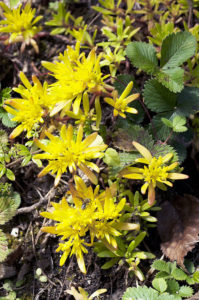
An unidentified species of Sedum, Timang, Marsyangdi Valley, Annapurna, central Nepal. Leaves of Himalayan strawberry (Fragaria nubicola) are also seen. (Photo copyright © by Kaj Halberg)
Sedum multicaule
Stems many, erect, branched from base, hairless, to 15 cm long. Leaves are linear or lanceolate, fleshy, pointed, to 2.5 cm long and 2 mm wide. The lax inflorescences are in terminal clusters, widely branched, flowers yellow, stalkless or very short-stalked, subtended by bracts, petals to 6 mm long and 2.5 mm wide, pointed.
This plant is distributed from Pakistan eastwards to western China, at elevations between 1,300 and 3,500 m. It is common in Nepal.
The specific name is Latin, meaning ‘multi-stemmed’.
Flower size and colour Petals to 6 mm long and 2.5 mm wide, yellow.
Height to 15 cm.
Habitat Forests, grasslands, mossy banks, among rocks.
Flowering Jul.-Sep.
Sedum multicaule, Solang Nallah, Manali, Himachal Pradesh. (Photos copyright © by Kaj Halberg)
Sedum oreades
Most stonecrop species have star-like flowers with spreading petals, but this species may be identified by its rather bell-shaped flowers, petals yellow, obovate or broadly lanceolate, pointed, to 12 mm long and 4 mm wide. The several stems are erect, simple or branched from the base, smooth, to 12 cm long. Leaves linear, lanceolate, or oblong, fleshy, pointed, to 9 mm long, crowded towards the apex, beneath the flowers.
This plant is found at altitudes between 3,000 and 5,500 m, from Pakistan eastwards to south-western China.
The specific name refers to a mountain nymph in Greek mythology, derived from oros (‘mountain’).
Flower size and colour Petals to 12 mm long and 4 mm wide, yellow.
Height to 12 cm.
Habitat Grasslands, among rocks.
Flowering Jun.-Sep.
Sedum oreades, photographed below the Rohtang La Pass, Himachal Pradesh. (Photo copyright © by Kaj Halberg)
Cucurbitaceae Cucumber family
An almost worldwide family, comprising somewhere between 118 and 125 genera with 825-850 species, all climbers. The vast majority are found in tropical and subtropical regions, with few species in temperate areas. About 18 wild genera occur in the Himalaya, and several others are cultivated.
Herpetospermum pedunculosum
This is the only member of the genus, occurring from Himachal Pradesh eastwards to Bhutan and the Yunnan Province, at elevations between 1,800 and 3,600 m.
The stem is several metres long, branched, with branched tendrils. Leaves are long-stalked, ovate to heart-shaped, very hairy, lobed, strongly toothed, long-pointed, to 15 cm long and 9 cm broad. Flowers are one-sexed, axillary, bright yellow, funnel-shaped, to 10 cm across, with elliptic, spreading lobes, to 5 cm long. Male flowers are in clusters, females solitary, calyx tube hairy. The fruit is ellipsoid, to 8 cm long and 4 cm wide, downy, green with yellowish longitudinal stripes.
In Nepal, the seeds are fried and eaten, and the pounded root is used for bile problems. In Tibetan medicine, the seeds are used for fever and inflammation.
The generic name is derived from Ancient Greek herpeton (a creeping animal) and sperma (‘seed’), alluding to the seeds, which somewhat resemble a small beetle. The specific name stems from the Latin pedunculus, from pedis, genitive of pes (‘foot’), in botanical context referring to the flower stalk, and osus (‘full of’), thus ‘with very long flower stalks’.
Flower size and colour To 10 cm across, bright yellow, lobes to 5 cm long.
Length several metres.
Habitat Forests, shrubberies, along trails.
Flowering Jul.-Oct.
Fruiting Sep.-Dec.
In this picture, Herpetospermum pedunculosum has completely enveloped a cultivated growth of a member of the ginger family (Zingiberaceae), Changdam, Langtang National Park, central Nepal. (Photo copyright © by Kaj Halberg)
Herpetospermum pedunculosum, Propang Danda, Langtang National Park, central Nepal. (Photo copyright © by Kaj Halberg)
Momordica
Members of this genus, comprising about 60 species, are native to tropical and subtropical Africa, Asia, and Australia. Some species are cultivated in warmer areas. About 4 species occur in the Himalaya.
The generic name is derived from the Latin mordicus (‘to bite’), alluding to the surface of the seeds, which appear as if they have been bitten.
Momordica charantia Bitter gourd
This plant may have originated in India, but is today cultivated as a vegetable in numerous warmer countries and has become naturalized many places, including the Himalaya, where it is found up to altitudes around 2,100 m.
It is a many-branched, downy climber, to 5 m long, with tendrils to 20 cm long. The leaves are long-stalked, ovate or circular in outline, with 3-7 deeply indented, roughly toothed lobes, to 12 cm across. The flowers are solitary, bright yellow, to 4 cm across, with 5 lobes to 2 cm long and 1.2 cm wide. Flowers are either male or female. The fruit is very distinctive with a warty surface, initially green, orange when mature, to 25 cm long.
All parts of the plant are used medicinally.
Flower size and colour To 4 cm across, bright yellow, lobes to 2 cm long and 1.2 cm wide.
Length to 5 m.
Habitat Forests, shrubberies, open areas.
Flowering May-Oct.
Fruiting Jun.-Nov.
Momordica charantia, Bhulbhule, Lower Marsyangdi Valley, Annapurna, central Nepal. The plant with blue flowers is goat-weed (Ageratum conyzoides, Asteraceae). (Photo copyright © by Kaj Halberg)
Mukia
A small genus with 3 species, found in tropical and subtropical areas of Asia, Africa, and Australia. A single species occurs in the Himalaya.
The generic name is derived from the Malayalam name of these plants, mukkapperam. Some authorities include them in the genus Cucumis.
Mukia maderaspatana
All parts of this climber, also known as Cucumis maderaspatanus, are covered in yellowish, stiff hairs, leaves only sparsely so. Stems are many-branched, several metres long. The stiff leaves are ovate or heart-shaped, to 9 cm long and wide, usually with 3-5 lobes, of which the middle one is largest, triangular, margin irregularly toothed. Leaves are gradually smaller up the stem. The small flowers are one-sexed, axillary, bright yellow, funnel-shaped, to 1 cm across, with elliptic, spreading lobes, to 2 mm long. Male flowers are in clusters, females usually solitary. Initially, the fruit is green with yellow longitudinal stripes, later bright red, globular, shining, to 1 cm across.
This plant is distributed in tropical and subtropical areas of Asia, Africa, and Australia. In the Himalaya, it may be observed up to elevations around 1,700 m. Ripe fruits are eaten raw.
The specific name refers to Madras, a city in Tamil Nadu, South India, today known as Chennai. Presumably, the type specimen was collected there.
Flower size and colour To 1 cm across, bright yellow, lobes to 2 mm long.
Length several metres.
Habitat Shrubberies.
Flowering Apr.-Aug.
Fruiting Aug.-Dec.
Fruiting Mukia maderaspatana, Pokhara, central Nepal. (Photo copyright © by Kaj Halberg)
Solena
A small genus with 3 species, found from Afghanistan eastwards to southern China and Taiwan, southwards to Sri Lanka and the Malayan Peninsula, with an isolated occurrence on Java. A single species occurs in the Himalaya.
Solena heterophylla
As its specific name implies, this climber has very diverse leaves. As Flora Simlensis expresses it: “exceedingly variable in shape, broadly ovate about 6 x 4 in. [15 x 10 cm], triangular-hastate about 6 x 4 in. [15 x 10 cm], more or less deeply 3-lobed about 6 x 6 in. [15 x 15 cm], or 3-5-lobed nearly to the base, lobes unequal, narrow, diverging, mid-lobe the longest, about 2-6 in. [5-15 cm], two or more forms, with intermediate forms, being sometimes borne on one plant.”
The slender tendrils are usually branched, sometimes bearing flowers. The flowers are tiny, to 7 mm across, corolla yellow or yellowish-white, segments triangular, to 1.5 mm long, male flowers in umbels with 10-20 flowers, females usually solitary. Initially, the fruit is green with white dots or longitudinal streaks, later bright red or reddish-brown, ovoid, oblong, or semi-globose, to 6 cm long and 5 cm wide.
This species, which was previously known as Zehneria umbellata, is widely distributed, from Afghanistan eastwards to Taiwan, and thence southwards to Indonesia. In the Himalaya, it occurs up to elevations around 2,600 m.
Locally, the root is used medicinally.
The obsolete generic name was given in honour of Josef Zehner, an Austrian botanical illustrator of the 19th Century.
Flower size and colour To 7 mm across, yellow or yellowish-white.
Habitat Forests, shrubberies, open areas.
Flowering May-Aug.
Fruiting Jun.-Nov.
Flower and unripe fruit of Solena heterophylla, Manali, Himachal Pradesh. (Photo copyright © by Kaj Halberg)
Trichosanthes
A large genus of about 100 species, distributed from Pakistan eastwards to Japan, southwards to Sri Lanka and Australia. About 8 species occur in the Himalaya.
The generic name is derived from the Greek trichos (‘hairy’) and anthos (‘flower’), alluding to the fringed petals of many of the species.
Trichosanthes lepiniana
An herbacious branched climber, growing several metres long with the help of branched tendrils. Leaves long-stalked, heart-shaped, to 17 cm long, with 3-7 toothed lobes, tip pointed. Male flowers are in racemes, female flowers solitary, to 8 cm across, white, bracts rounded, pale green, petals and bracts very conspicuously fringed. Fruit red, globular or ovoid, to 9 cm in diameter, smooth.
This species is found from Uttarakhand eastwards to Bhutan, growing at elevations between 600 and 2,100 m.
In Nepal, juice of the fruit is taken for liver ailments.
The specific name honours French naval apothecary Jules Joseph Lépine (1817-1884). In India, he discovered a beneficial chemical, vallarine, in the plant Hydocotyle asiatica.
Previously, it was thought that Himalayan plants belonged to T. tricuspidata. Today, this species is considered to occur only from Indochina southwards to Indonesia. Also, it was believed that it occurred east of the Himalaya, but plants from Arunachal Pradesh eastwards across Indochina to southern China are now regarded as a distinct species, T. inthanonensis.
Flower size and colour To 8 cm across, white, petals conspicuously fringed.
Length several metres.
Habitat Forests, shrubberies.
Flowering May-Aug.
Fruiting Aug.-Nov.
Fallen flowers of Trichosanthes lepiniana, Pati Bhanjyang, Helambu, central Nepal. (Photo copyright © by Kaj Halberg)
Cupressaceae Cypress family
This worldwide family of conifers contains 19 genera with about 125 species. The cones have scales, which are arranged in opposite pairs at right angles with each other. 2 genera are native to the Himalaya, others are introduced as ornamental trees.
Cupressus Cypress
About 15 species of these grand trees are distributed from the Mediterranean eastwards across the Middle East and the Himalaya to southern China and northern Indochina. 2 species are native to the Himalaya, of which C. casmeriana is restricted to Bhutan.
Previously, a number of North American trees were included in this genus, but have now been transferred to the genus Hesperocyparis.
The generic name is derived from Ancient Greek kyparissos, the classical word for the Mediterranean cypress (C. sempervirens).
Cupressus torulosa Himalayan cypress
This magnificent tree may grow to 45 m tall, with a diameter up to 3.5 m, with spreading branches and drooping branchlets. The leaves are scale-like, triangular, to 1.8 mm long, with white margins, densely overlapping. The bark often peels off in large strips. When young, the cones are bluish, globular, to 2 cm long and 1.8 cm wide, grey when older, scales separating, when the fruit dries out.
This species is distributed from Kashmir eastwards to south-eastern Tibet, mostly on calcareous soil, at altitudes between 1,800 and 3,300 m. Its foliage is often burned as incense in Hindu and Buddhist shrines.
The specific name is derived from the Latin torulus, diminutive of torus (‘swelling’), presumably alluding to the furrowed bark.
Cone size and colour See above.
Height to 45 m.
Habitat Open dry areas.
Flowering Feb.
Two magnificent specimens of Cupressus torulosa, Upper Kali Gandaki Valley, Mustang, central Nepal. (Photo copyright © by Kaj Halberg)
Branches of Cupressus torulosa with cones, young and old, Upper Kali Gandaki Valley. (Photo copyright © by Kaj Halberg)
Juniperus Juniper
This genus of c. 60 species of trees and shrubs is distributed in almost the entire Northern Hemisphere. About 5 species are found in the Himalaya. The cone is berry-like, with an outer fleshy, leathery layer.
There are various theories as to the origin of the generic name. Some authorities claim that it stems from the Latin iungere (’tie together’ or ’weave’), referring to the use of its branches in baskets and fences, whereas others maintain that it is derived from juvenis (’young’) and parere (’to produce’), referring to the fact that juniper bushes constantly are renewed by new shoots.
The words gin and genever are derived from Juniperus, attesting to the usage of juniper fruits in these beverages.
Dawa Tamang, standing next to an old juniper, possibly J. recurva (see below), Upper Ghunsa Valley, eastern Nepal. The shrubs in the background are Rhododendron campanulatum. (Photo copyright © by Kaj Halberg)
In Central Asia, juniper foliage is often burned as incense in Buddhist shrines. In the picture below, juniper branches have been brought as an offering to a shrine in the village of Kagbeni, Upper Kali Gandaki Valley, Mustang, central Nepal, together with Tibetan prayer flags and a skull of a bharal, or Himalayan blue sheep (Pseudois nayaur). The latter isa remnant of the animist Bon religion, in which horns of oxen, yak, sheep, and goats were often presented as offerings. This belief dominated in Central Asia prior to the introduction of Buddhism. You may read more about this subject on the page Religion: Animism.
(Photo copyright © by Kaj Halberg)
Juniperus communis Common juniper
This is the most widespread conifer in the world, found in almost the entire northern subarctic and temperate zones, southwards to North Africa, northern Iran, the Himalaya, Japan, and Arizona. In the Himalaya, it is distributed from Pakistan eastwards to central Nepal, at elevations between 1,800 and 3,600 m.
This species, which may grow to a large shrub, but is often prostrate, may at once be identified by it needle-like leaves, to 1.3 cm long, which have a sharp point. The cone, to 8 mm across, is bluish-black when ripe, often with a bloom.
Common juniper is much utilized in folk medicine, and also plays a substantial role in folklore, described on the page Plants: Plants in folklore and poetry.
The specific name is Latin, meaning ‘common’.
Cone size and colour See above.
Height to 1.5 m.
Habitat Open dry areas.
Flowering Apr.-May.
Juniperus communis with unripe cones, Braga, Upper Marsyangdi Valley, Annapurna, central Nepal. (Photo copyright © by Kaj Halberg)
Juniperus indica Black juniper
This high-altitude species is often a shrub, but at lower altitudes it may grow into a tree, up to 20 m tall. It has two kinds of leaves: on younger individuals, and sometimes also on lower branches of older specimens, the leaves are awl-shaped, to 6 mm long, whereas those on older branches are scale-like, to 1.5 mm long, densely overlapping in four ranks, which gives the branch a smooth appearance. The cone is brown when young, later shining blue or black, to 1.3 cm across.
This species is found at altitudes between 2,100 and 5,200 m, from Pakistan eastwards to south-western China. Its foliage is burned as incense in Hindu and Buddhist shrines, and the fruit is utilized in traditional medicine for fever and headache.
Cone size and colour See above.
Height to 20 m, but often a shrub at higher altitudes.
Habitat Open dry areas.
Flowering May.
This old and gnarled specimen of Juniperus indica is growing at an altitude of c. 3,600 m, Upper Marsyangdi Valley, Annapurna, central Nepal. (Photo copyright © by Kaj Halberg)
Shrub of Juniperus indica with unripe fruits, Bibre, Khumbu, eastern Nepal. The mountain in the background is Taboche (6367 m). (Photo copyright © by Kaj Halberg)
Juniperus indica with ripe cones, Bratang, Upper Marsyangdi Valley, Annapurna, central Nepal. (Photo copyright © by Kaj Halberg)
Juniperus recurva Drooping juniper
This species may grow into a tree, up to 20 m tall, but at higher altitudes it becomes a low shrub, often covering large areas. The bark is grey-brown, peeling off in thin strips. The growth is rather lax, and outer branches are often drooping and slightly recurved, hence the specific and common names. Leaves are awl-shaped, to 8 mm long, in whorls of 3, more or less adpressed to the branch and loosely overlapping. The cone is brown when young, later black, shining, ovoid, to 1.3 cm long.
It is distributed from Pakistan eastwards to Myanmar and the Yunnan Province, at elevations between 1,800 and 4,600 m.
Wood and foliage are burned as incense at Buddhist shrines.
Cone size and colour See above.
Height to 20 m, but often a shrub at higher altitudes.
Habitat Forests, shrubberies, open areas.
Flowering Jun.-Jul.
Fruiting All year.
A magnificent growth of Juniperus recurva, near Pangboche Monastery, Khumbu, eastern Nepal. These trees are sacred to the local Tibetan Buddhists – a remnant of the animist Bon religion (see genus caption above), in which trees, prominent rocks, etc. were often worshipped. (Photo copyright © by Kaj Halberg)
Early in the morning, foliage of Juniperus recurva and Rhododendron campanulatum (Ericaceae) is covered in rime, Magingoth, Helambu, central Nepal. (Photo copyright © by Kaj Halberg)
Juniperus recurva with unripe cones, Tengboche, Khumbu, eastern Nepal. (Photo copyright © by Kaj Halberg)
Juniperus semiglobosa
A small tree to 15 m tall, in dry areas often a shrub. It has two kinds of leaves, needle-like on young plants, to 7 mm long, often in whorls of 3, pointing forward, and scale-like leaves on older plants, adpressed, to 2.5 mm long. The cones are flattened at one end, or nearly triangular, widest near the tip.
This species is distributed from Kazakhstan southwards through western Tibet to Afghanistan, Pakistan, and Ladakh, at altitudes between 2,500 and 3,500 m.
The specific name stems from the globular cones, which are flat at one end.
Cone size and colour See above.
Height to 15 m, but often a shrub in dry areas.
Habitat Forests, shrubberies, open areas.
Fruiting All year.
Karma Tsering, standing next to a stunted Juniperus semiglobosa, Honupatta, Ladakh. (Photo copyright © by Kaj Halberg)
Foliage and unripe cones of Juniperus semiglobosa, Honupatta, Ladakh. (Photo copyright © by Kaj Halberg)
Foliage and unripe cones of Juniperus semiglobosa, Jispa, Lahaul, Himachal Pradesh. The semi-flattened cones gave rise to the specific name. (Photo copyright © by Kaj Halberg)
Diapensiaceae
A small family with 6 genera and about 15 species of shrublets or herbs, distributed in arctic and temperate areas of Eurasia and North America, with a single genus in the Himalaya.
Diapensia
4 species of shrublets, found in Asia, northern Europe, and North America. A single species occurs in the Himalaya.
According to some authorities, the generic name derives from a misprinting in De historia stirpium commentarii insignes, published in 1543 by German physician and botanist Leonhard Fuchs (1501-1566), often simply known as Kräuterbuch (‘Herbal Book’). The name intended was dispensia, from dispensare (‘to free of disease’). However, the plant he had in mind was Sanicula, an entirely different plant in the family Apiaceae. It is not known, why Swedish naturalist Carl Linnaeus (1707-1778) applied the name to a plant he found during his travels in Swedish Lapland.
Diapensia himalaica
A densely tufted, mat-forming shrublet, stems with numerous tiny, smooth, shining, green or reddish-green, obovate, spatulate, or oblong leaves, to 5 mm long and 2.5 mm wide, and terminal pink or purplish-pink, occasionally white or yellow, bell-shaped flowers, tube to 8 mm long, petals with 5 broadly rounded, notched lobes, about 6 mm long and 5 mm wide. Sepals 5, reddish-purple, enlarging in fruit.
This plant is distributed from eastern Nepal eastwards to Myanmar and the Yunnan Province, growing at elevations between 3,200 and 5,000 m. It is rare in Nepal, although rather common in the Barun Valley.
Flower size and colour Tube to 8 mm long, petals pink or purplish-pink, occasionally white or yellow, with 5 lobes, about 6 mm long and 5 mm wide.
Height to 5 cm.
Habitat Open slopes, damp rocks.
Flowering May-Jun.
Diapensia himalaica, Tematan, Barun Valley, eastern Nepal. (Photo copyright © by Kaj Halberg)
Dioscoreaceae Yam family
An almost worldwide family of twining herbs or woody vines, a few erect herbs, with about 9 genera and 715 species, widely distributed in tropical, subtropical, and temperate regions, with a core area in tropical America. 2 genera occur in the Himalaya.
Dioscorea Yam
A large, widely distributed genus of twining herbs with more than 630 species, the vast majority found in tropical and subtropical regions, with a few species in temperate areas. 13 species have been encountered in the Himalaya.
These plants form underground tubers, and some species also form bulbils in the leaf axils. These bulbils fall to the ground when ripe, and may sprout to a new plant. The tubers of some species are of great economic importance, consumed as food in some places, and ingrediences in traditional and modern medicine are produced from others.
The generic name honours Greek physician, pharmacologist, and botanist Pedanius Dioscorides (died 90 A.D.), who was the author of De Materia Medica, five volumes dealing with herbal medicine. The common name dates from the late 16th Century, either from Portuguese inhame or Spanish iñame, probably of West African origin.
Dioscorea bulbifera Air potato
The stem is twining counter-clockwise, sometimes growing to 20 m long, smooth, with many globular or ovoid, brown, warted bulbils, to 3 cm across, in the leaf axils. Leaves are alternate, long-stalked, hairless, ovate or heart-shaped, to 25 cm long and broad, margin entire or slightly wavy, tip pointed with a tail-like appendage, to 4 cm long. The fragrant flowers are tiny, appearing in greenish-white or pinkish, slender, pendent spikes, to 30 cm long, from the leaf axils. The capsule is straw-coloured with purple dots, oblong, to 2 cm long and 1 cm wide, with 3 wings to 0.7 cm broad, base and tip rounded.
It is cultivated as a food crop, especially in West Africa. The tubers, however, often have a bitter taste, but it can be removed by boiling. In Nepal, tubers and bulbils are pickled, and juice of the tuber is used to expel intestinal worms. Elsewhere, the bulbils are used in the treatment of a wide variety of ailments, including haemorrhoids, dysentery, syphilis, ulcers, cough, leprosy, diabetes, asthma, and cancer, and they are also a raw material for contraceptives.
This plant is native to warmer areas of Africa, Asia, and northern Australia, but is widely cultivated and has become naturalized in many regions. It is regarded as a noxious weed in Florida and other places. It is widely distributed in the Himalaya, found up to an altitude of 2,300 m.
The specific name naturally refers to the bulbils, which may look like tiny potatoes, hence the common name.
Flower size and colour Tiny, greenish-white or pinkish, in pendent clusters to 30 cm long.
Height/length to 20 m.
Habitat Shrubberies, open areas.
Flowering Jun.-Aug.
Pendent spikes of Dioscorea bulbifera with fruits, Bahundanda, Lower Marsyangdi Valley, Annapurna, central Nepal. (Photos copyright © by Kaj Halberg)
Dioscorea deltoidea
The stem is twining clockwise, to 3 m long, grooved. Leaves are alternate, long-stalked, very variable, green, grey-green, or blue-green, triangular, heart-shaped, or ovate, to 12 cm long and 5.5 cm wide, usually 3-lobed, the mid-lobe much longer and long-pointed. Spikes may grow to 16 cm long. The capsule is brown at maturity, to 2.2 cm long, with 3 wings, to 1.4 cm wide.
This plant is distributed from Afghanistan eastwards across the Himalaya to south-western China, and also in Bangladesh and northern Indochina. In the Himalaya, it is found at elevations between 2,000 and 3,100 m.
The fresh tuber is poisonous. It is crushed and strewn in rivers to stupefy fish. However, it is edible after boiling. It is mixed with water to wash clothes, and this soapy liquid is also used as a body wash to kill lice. In Nepal, juice of the tuber is used for constipation, and to expel roundworms. Bulbs from the upper part of the stem are boiled and the liquid drunk for gastric problems. Juice of the bulbs is taken for dysentery. Elsewhere, the tuber is used for various diseases, including asthma and arthritis, and also as a contraceptive.
The species is threatened by excessive collecting.
The specific name is derived from delta, the 4th letter in the Greek alphabet, written as a triangular. In this plant, it refers to the leaf shape.
Flower size and colour Tiny, yellow or green, in pendent clusters to 16 cm long.
Height/length to 3 m.
Habitat Shrubberies, forest margins.
Flowering May-Aug.
Fruiting Dioscorea deltoidea, climbing on a species of fig tree (Ficus), Manali, Himachal Pradesh. (Photo copyright © by Kaj Halberg)
Dipsacaceae (scabious family), see Caprifoliaceae.
Droseraceae Sundew family
This family contains 4 genera with about 200 species of insectivorous herbs, distributed almost worldwide. A single genus is found in the Himalaya.
Many other carnivorous plants are described on the page Plants: Carnivorous plants.
Drosera Sundew
These plants obtain the major part of their nutrients by catching small invertebrates by means of glandular hairs on their leaves. When an animal gets stuck in the sticky juice from these glands, the leaf envelops the unfortunate victim, whereupon enzymes dissolve its body juices, making nitrogen and other nutrients available for the plant.
The famous British naturalist Charles Darwin (1809-1882) performed much of the early research into this genus, carrying out a long series of experiments with Drosera rotundifolia, confirming that plants could be carnivorous. In a letter from 1860, he wrote, “…at the present moment, I care more about Drosera than the origin of all the species in the world.” (Source: A.M. Ellison & N.J. Gotelli 2009. Energetics and the evolution of carnivorous plants – Darwin’s ‘most wonderful plants in the world’. Journal of Experimental Botany 60 (1): 19-42)
About 180-190 species are known to science, distributed almost worldwide, with a core area in Australia. 2 species are found in the Himalaya.
The generic name is a Latinized form of the Ancient Greek droseros (‘dewy’), which, like the popular name, refers to the sticky glandular hairs, which resemble dew drops, when the sun is shining on them. Formerly, in European folk medicine, dew drops were said to possess miraculous qualities, and the glandular ‘drops’ of sundew were sold as Virgin Mary’s tears. Supposedly, they were able to cure skin diseases like warts, ringworms, and corns, besides many other ailments.
Drosera peltata Crescent-leaved sundew
Stem erect, branched, sometimes to 50 cm tall, but usually lower. The basal leaves are in a rosette, short-stalked, yellowish-green, rounded. They are sometimes absent. Stem leaves are long-stalked, yellowish-green, crescent-shaped, to 3 cm long and 5 mm broad, upperside with many sticky glands. Flowers are in few- to many-flowered terminal clusters, to 6 cm long, flowers stalked. Petals usually 5, white (rarely pink or red), wedge-shaped, to 6 mm long and 3 mm wide.
This species is distributed in montane areas, from Uttarakhand eastwards to Taiwan, and thence southwards through Indochina and Indonesia to Australia and New Zealand. In the Himalaya, it is found at altitudes between 1,500 and 3,700 m.
In Nepal, a paste of the leaves is applied to blisters.
The specific name is derived from the Latin pelta (‘a small crescent-shaped shield’), referring to the leaf shape.
Flower size and colour Petals to 6 mm long and 3 mm wide, white, rarely pink or red.
Height to 50 cm, but usually lower.
Habitat Meadows, streamsides, open areas.
Flowering Jun.-Sep.
The leaves of this Drosera peltata, observed in the Upper Langtang Valley, central Nepal, are heavy with monsoon rain. (Photos copyright © by Kaj Halberg)
Elaeagnaceae Oleaster family
A small family with 3 genera and about 90 species of shrubs or small trees, often spiny, widely distributed in the Northern Hemisphere, and also in Indonesia and north-eastern Australia. Most species grow in dry or saline habitats. 2 genera occur in the Himalaya.
Elaeagnus Oleaster, silverberry, Russian olive
This genus contains maybe c. 90 species, but further research is needed to ascertain the correct number. These plants are deciduous shrubs or small trees, some spiny. The fruit is a berry. They are distributed in Asia, southern Europe, and North America, and no less than about 55 species are endemic to China. 6 species are found in the Himalaya.
The generic name is derived from Ancient Greek elaia (‘olive’) and agnos (‘pure’), alluding to the resemblance of the fruit and foliage to those of the true olive tree (Olea europaea). The common name oleaster is Latin, likewise meaning ‘resembling the olive tree’.
Elaeagnus parvifolia
A deciduous shrub to 3 m, sparsely spiny, young branches silvery-scaly. Leaves are stalked, oblong or elliptic, to 7.5 cm long and 2.5 cm broad, silvery-scaly beneath. Flowers tubular, in small axillary clusters, tube densely scaly, yellowish-white, fragrant, to 8 mm long, with 4 small, triangular, pointed lobes, stamens 4, slightly exserted. The fruit is a fleshy, ovoid, red, silvery-scaly berry, to 8 mm long.
This plant is distributed from Afghanistan eastwards to Myanmar, growing at altitudes between 1,500 and 3,000 m.
The ripe fruit is edible. In Nepal, the unripe fruit is utilized for dysentery.
The specific name is Latin, meaning ‘small-leaved’.
Flower size and colour To 8 mm long, yellowish-white, with 4 triangular lobes.
Height to 3 m.
Habitat Shrubberies, open areas.
Flowering Mar.-Jun.
Fruiting Sep.-Nov.
Elaeagnus parvifolia, Sangam Chatti, near Uttarkashi, Uttarakhand. (Photo copyright © by Kaj Halberg)
Hippophae Sea-buckthorn
A small genus of 7 deciduous spiny shrubs or small trees, distributed in the entire Europe, and thence across the Middle East and Central Asia to south-central Siberia, Mongolia, and China, southwards to Iran, the Himalaya, and northern Indochina. 3 species occur in the Himalaya.
Male and female flowers are on separate plants, on previous year’s shoots, male flowers in small catkins, which appear before the leaves, female flowers in small clusters, appearing with the leaves. The fruit is a berry, a rich source of vitamins C, A, B, E, and K, and also of carotenoids. Lately, research has shown that it may have anti-ageing and memory-restoring properties.
The generic name is derived from Ancient Greek hippo (‘horse’) and phaos (‘light’, ‘shining’). Supposedly, leaves and young branches of sea-buckthorn were fed to horses to make their coat shine.
Hippophae rhamnoides Common sea-buckthorn
This plant is found from Ireland and southern Scandinavia southwards to the Mediterranean, eastwards across Russia to Central Asia. Subspecies turkestanica grows in drier areas, in dried-out riverbeds and on slopes bordering streams, from Kazakhstan eastwards to Mongolia, and thence southwards through Tibet to Pakistan, Ladakh, Himachal Pradesh, and Uttarakhand. It is common in Ladakh.
It usually grows to about 5 m tall, rarely to 10 m. Older shoots have a silvery-waxy coating. Leaves are green above, silvery-scaly beneath (also sometimes above), to 6 cm long and 7 mm wide. The edible berries are yellow, orange, or red, ellipsoid or obovoid, to 9 mm long and 6 mm broad, in dense clusters along branches.
A drink is made from the berries, and they are also pickled. In Ladakh, the branches are collected for firewood, and to make wolf-proof fences.
The specific name means ‘resembling Rhamnus‘, like the common name alluding to a species of buckthorn (Rhamnus). It is not clear what it refers to.
Flower size and colour Tiny, yellowish-brown.
Height usually below 5 m, rarely to 10 m.
Habitat Dry riverbeds, streamsides, open slopes.
Flowering Apr.-May.
Fruiting Sep.-Oct.
Hippophae rhamnoides, subspecies turkestanica, is common in Ladakh, here photographed at Mangyu (top), and near Ulley Topko. (Photos copyright © by Kaj Halberg)
Hippophae salicifolia Willow-leaved sea-buckthorn
Usually a shrub to 3 m tall, but occasionally a small tree to 10 m, with a trunk diameter up to 30 cm, and reddish-brown bark with deep longitudinal furrows. Young shoots are rusty-scaly. The leaves are willow-like, short-stalked, linear or oblong, to 7 cm long and 1.2 cm broad, green above, sparsely hairy, beneath with star-shaped hairs, midrib reddish-brown. Flowers appear before or with the first leaves. Flowers are yellowish-brown, male flowers to 4 mm long, female flowers smaller, stigma exserted. The globular berry comes in a variety of colours, yellow, greenish-brown, orange, or red, to 7 mm across, clustered along the branches.
This plant is a colonizer in wet landslides along streams. It is distributed from Himachal Pradesh eastwards to Bhutan and sputh-eastern Tibet, at elevations between 2,000 and 3,500 m.
The fruit is edible, and also pickled. A drink is made from the berries. In Nepal, branches are used as firewood, and the leaves for tea. The fruit is also used for polishing gold and silver.
The specific name is Latin, meaning ‘with leaves like Salix’ (willow).
Flower size and colour To 4 mm long, yellowish-brown.
Height usually below 3 m, occasionally to 10 m.
Habitat Streamsides, stony areas, landslides.
Flowering Apr.-Jun.
Fruiting Sep.-Mar.
Hippophae salicifolia with unripe berries, near Gangtok, Sikkim. (Photo copyright © by Ajai Saxena)
Hippophae tibetana Tibetan sea-buckthorn
This is a small shrub, growing to 60 cm tall, sometimes to 80 cm, densely branched, with long, stout spines at regular intervals up the stem, which are remains of old branches. Leaves are oblong or elliptic, in whorls of 3, to 2 cm long and 6 mm broad, both surfaces with numerous white or rusty scales. The flowers are stalkless, yellowish, to 4 mm long, arranged arranged in rows beneath the leaves. Berries are orange or red.
This species is found from Gansu and Qinghai, southwards through Tibet to the northern drier parts of the Himalaya, from Ladakh eastwards to Bhutan, at elevations between 3,300 and 4,700 m.
The fruit is edible, and also pickled. A drink is made from the berries. Branches are collected for fuel, and to make fences. A red cosmetic is obtained from the fruit. In Ladakh, where this plant is scarce, it is threatened by usage as fuel, and by overgrazing.
Flower size and colour To 4 mm long, yellowish.
Height to 60 cm, sometimes 80 cm.
Habitat Dry stony areas, dry riverbeds, streamsides.
Flowering Apr.-Jun.
Fruiting Aug.-Oct.
Hippophae tibetana, Langshisha (4000 m), Langtang National Park, central Nepal. (Photo copyright © by Kaj Halberg)
Ephedraceae Joint-pine family
This family of gymnosperms contains a single genus with c. 65 species of shrubs, rarely climbers, native to northern temperate and subtropical areas, and also to western South America.
Ephedra Joint-pine, joint-fir
Stems are jointed, of various colours, including green, yellowish, bluish-green, and whitish-green, and the leaves are often reduced to brown scales at the joints. Male and female flowers are on separate plants. The female cone has a naked ovule, with 1-2 seeds enclosed by swollen, fleshy, berry-like red bracts. About 9 species occur in the Himalaya.
Excavations in the Karakum Desert in Turkmenistan suggest that joint-pine may have been a component of the Zoroastrian ritual drink haoma, which is identical to the Vedic drink soma. According to the Ancients, drinking haoma ‘gives insight’ and makes you ‘wise’. (Source: Richard Rudgley 1998. The Encyclopedia of Psychoactive Substances. Little, Brown, and Co.)
These plants are often grazed to prostrate form by goats or yaks, which readily eat the fresh stems, especially in the winter. The stems are also collected for fodder, and dried plants are utilized as fuel.
The generic name is derived from Ancient Greek epi– (‘upon’) and hedra (‘seat’). However, it was also the name of horsetails (Equisetum), and stems of Ephedra species resemble those of horsetails. The popular names refer to the jointed stems. The connection to pines and firs is hard to see.
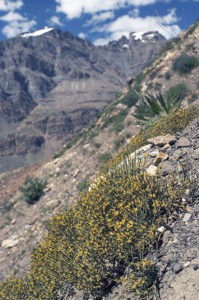
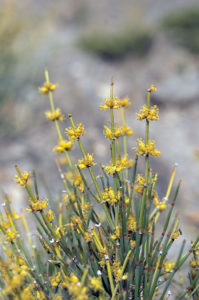
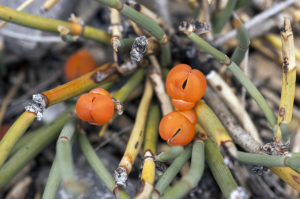
Mountain slope with an unidentified species of joint-pine, displaying male inflorescences and the orange bracts of female cones, Lossar, Spiti, Himachal Pradesh. (Photos copyright © by Kaj Halberg)
Ephedra gerardiana Gerard’s joint-pine
Usually below 50 cm, sometimes to 1 m tall. Stems dark green, smooth, longitudinally grooved, closely clustered. The leaves are reduced to brown scales at joints. Male cones are small, solitary or 2-3 together, each with 4-8 yellowish flowers. The female cone is solitary, with naked ovule, 1-2 seeds, bracts bright red.
This species is distributed from Tajikistan, Xinjiang, and Qinghai southwards across the Tibetan Plateau to Afghanistan and the drier northern areas of the Himalaya, eastwards to Sikkim. In the Himalaya, it is found at altitudes between 2,400 and 5,300 m.
An alkaloid, ephedrine, is extracted from the plant. Juice of the plant is said to stimulate the heart. In Nepal, stems are collected as fuel and for fodder. The crushed plant, mixed with water, is used to treat skin problems, asthma, and hay fever. It is also given to children to control bed-wetting. In Ayurvedic medicine, tea made from the plant is taken for colds, cough, bronchitis, asthma, and arthritis.
The specific name was applied by Danish botanist and surgeon Nathaniel Wallich (1786-1854) (see Strobilanthes atropurpurea above) in honour of English herbalist John Gerard (c. 1545-1612), who published a large work on herbal medicine, Herball or Generall Historie of Plantes.
Flower size and colour See above.
Height to 50 cm, occasionally to 1 m.
Habitat Stony, open areas.
Flowering Apr.-Jul.
Fruiting Jul.-Dec.
These people are harvesting Ephedra gerardiana from a rock wall near Marpha, Kali Gandaki Valley, Annapurna, central Nepal. The dark green foliage is a species of juniper. (Photo copyright © by Kaj Halberg)
Flowering Ephedra gerardiana, Langtang National Park, central Nepal. (Photo copyright © by Kaj Halberg)
Fruiting Ephedra gerardiana, Upper Langtang Valley, central Nepal. (Photos copyright © by Kaj Halberg)
Ephedra intermedia Persian joint-pine, Tibetan joint-pine
Stem much branched, to 1 m tall, erect or spreading, branches yellowish or bluish-green. Leaves tiny, brownish, in whorls of 3. Male cones clustered at nodes, whorled, to 8 mm long. Female cones are ellipsoid, bracts red or orange-red.
This plant is distributed from the Middle East, Turkmenistan, and Kazakhstan eastwards to southern Siberia and northern China, southwards across the Tibetan Plateau to Afghanistan, Pakistan, and Ladakh. In the Himalaya, it is growing up to altitudes around 4,600 m.
In Tibet, it is utilized for liver diseases. In traditional Chinese medicine, it is called ma huang (麻黄), meaning ’yellow hemp’. The leaves are used for treatment of a large number of ailments, including fever, cardiovascular problems, nervous disorder, pulmonary diseases, and diarrhoea. The root is used to reduce sweating due to weakness of the body. The plant also possesses anti-viral properties.
Flower size and colour See above.
Height to 1 m.
Habitat Deserts, streamsides, dry rocks.
Flowering May-Jun.
Fruiting Jul.-Aug.
Fruiting Ephedra intermedia, Gayk, Ladakh. (Photos copyright © by Kaj Halberg)
Ericaceae Heath family
A large family with about 125 genera and c. 4,000 species of trees, shrubs, climbers, or herbs, widely distributed in temperate and subarctic areas, and also at high elevations in tropical regions. The corolla has 4 or 5 fused petals, which form a funnel-, flask-, or bell-shaped flower, usually with short lobes. 12 genera are found in the Himalaya.
Agapetes
A genus with about 115 species of evergreen epiphytic shrubs, rarely trees, distributed from eastern Nepal and south-eastern Tibet eastwards to eastern China, southwards to Bangladesh, Indochina, and the Malayan Peninsula. 5 species occur in the Himalaya.
The generic name is Ancient Greek, meaning ‘delightful’, no doubt alluding to the pretty flowers.
Plants from New Guinea and the south-western Pacific, which were previously placed in this genus, have been transferred to the genus Paphia.
Agapetes serpens Himalayan lantern
The flowers of this small climber, to 60 cm long, resemble tiny lanterns, hence the common name. Leaves are crowded, short-stalked, leathery, dark green above, pale green below, narrowly ovate or oblong, sharply pointed, to 2 cm long and 8 mm wide, margin slightly recurved, toothed towards the apex. Flowers are pendent from leaf axils, single or 2-3 together, sepals bright green, forming a cup to 4 mm long, with 5 pointed lobes, to 4 mm long. The corolla is tubular, 5-angled, hairy along the ridges, to 2.8 cm long, red, orange, or pinkish-white, with reddish-purple zig-zag bands, and with triangular, recurved lobes, to 3 mm long. The berry is top-shaped, 5-winged, about 6 mm across. Ripe fruits are edible.
This plant occurs from eastern Nepal eastwards to Bhutan and south-eastern Tibet, at altitudes between 1,200 and 2,700 m.
The specific name is Latin, meaning ‘creeping’, referring to the climbing habit of this plant.
Flower size and colour See above.
Height/length to 60 cm.
Habitat Epiphytic, growing on mossy trees or rocks.
Flowering Feb.-Jun.
Agapetes serpens, photographed in the lower Ghunsa Valley, eastern Nepal. (Photo copyright © by Kaj Halberg)
Cassiope White-heather, mountain heather
About 17 species of circumboreal shrublets, found as far south as the Himalaya, China, Japan, and western United States. 2 species occur in the Himalaya.
The generic name was given in allusion to the beauty of these plants. In Greek mythology, Cassiopeia was the wife of king Cepheus, who ruled the kingdom of Aethiopia. She was arrogant and vain, boasting that she and her daughter Andromeda were more beautiful than all the Nereids, the nymph-daughters of the sea god Nereus. This brought the wrath of Poseidon, ruler of the sea, upon Aethiopia. He ordered the sea monster Cetus to destroy it, and, trying to save their kingdom, Cepheus and Cassiopeia consulted an oracle, who told them that the only way to appease Poseidon was to sacrifice their daughter Andromeda. She was chained to a rock at the sea shore and left to be killed by the sea monster, but was saved by the hero Perseus who changed Cetus into a rock. Instead, Poseidon placed Cassiopeia in the heavens, chained to a throne in a position similar to that of Andromeda at the sea.
Cassiope fastigiata
A much-branched shrublet, to 20 cm tall. Stems are initially creeping, later erect and parallel. The leathery leaves are adpressed, densely overlapping, ovate-triangular, to 6 mm long and 2 mm wide, with a silvery-white, hairy margin. Flowers are axillary, nodding, broadly bell-shaped, to 9 mm long, corolla snow-white, reddish in the throat, with short, outcurved lobes, to 4 mm long. The calyx is conspicuously reddish-brown or purplish, lobes to 5 mm long.
This species is found from Pakistan eastwards to Bhutan and south-eastern Tibet, at elevations between 2,800 and 5,000 m.
The specific name is Latin, originally meaning ‘peaked’, but in a botanical context meaning ‘with erect and parallel branches’.
Flower size and colour See above.
Height to 20 cm.
Habitat Shrubberies, open slopes, rocks.
Flowering May-Aug.
Cassiope fastigiata, Dole, Gokyo Valley, Khumbu, eastern Nepal. (Photo copyright © by Kaj Halberg)
Cassiope fastigiata, Great Himalayan National Park, Himachal Pradesh. (Photo copyright © by Kaj Halberg)
Close-up of the beautiful flowers, Dole, Gokyo Valley, Khumbu, eastern Nepal. (Photo copyright © by Kaj Halberg)
Gaultheria Wintergreen, mountain tea
These shrubs or dwarf shrubs, comprising about 135 species, are native to eastern and southern Asia, south-eastern Australia, New Zealand, and the Americas. 7 species occur in the Himalaya.
In 1748, Swedish naturalist Pehr Kalm (1716-1779), a pupil of the famous Carl Linnaeus (1707-1778), named this genus in honour of French physician, meteorologist, and botanist Jean-François Gauthier (1708-1756), also written Gaulthier, of Quebec, whose works include a botanical pharmacopoeia. He died young, during a typhoid epidemic.
Gaultheria fragrantissima Fragrant wintergreen
An evergreen shrub, usually below 2 m tall, sometimes to 4 m. Leaves very variable, elliptic, oblong, ovate, obovate, or lanceolate, 5-17 cm long and 2-6.5 cm broad, leathery, dotted with the base of bristles beneath, with 4-7 pairs of veins, margin bristly-toothed, tip pointed. The fragrant flowers are many together in axillary clusters, to 9 cm long, corolla white, globular or urn-shaped, to 5 mm long and 3 mm wide, with very short lobes. The persistent, bluish-purple, fleshy calyx is fused with the capsule, forming a berry-like fruit, to 6 mm across.
This plant is distributed from Uttarakhand eastwards to Myanmar and the Yunnan Province, southwards to Sri Lanka and western Indonesia. In the Himalaya, it is found at elevations between 1,500 and 3,200 m. It is very common in Nepal.
In Nepal, ripe fruits are eaten fresh, and alcohol is made from them. Juice of unripe fruits is taken for stomach ache, juice of the leaves for cough, and to kill intestinal worms. Oil extracted from the leaves is used for rheumatism, and also applied to scabies.
The specific name is Latin, meaning ‘indeed fragrant’.
Flower size and colour To 5 mm long and 3 mm wide, white.
Height to 2 m, occasionally to 4 m.
Habitat Forests, shrubberies.
Flowering Apr.-May.
Fruiting Jun.-Aug.
Flowering Gaultheria fragrantissima, below Burlung Bhanjyang, Shivapuri-Nagarjun National Park (top), near Brabal, Langtang National Park (centre), and near Gul Bhanjyang, Helambu, all in central Nepal. (Photos copyright © by Kaj Halberg)
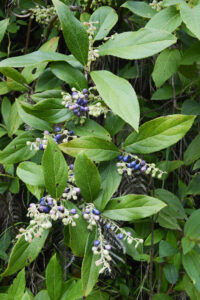
Gaultheria fragrantissima with ripening fruits, Chipling, Helambu. (Photo copyright © by Kaj Halberg)
Fruiting Gaultheria fragrantissima, Gul Bhanjyang, Helambu. (Photo copyright © by Kaj Halberg)
Young leaves of Gaultheria fragrantissima with bright red stalks, Burlung Bhanjyang. (Photo copyright © by Kaj Halberg)
Gaultheria nummularioides
This creeping, many-branched dwarf shrub is easily identified by the stems, which are covered in bristly, yellowish-brown hairs, and the small, ovate or almost circular leaves, to 1.8 cm across, with stiff hairs on the underside and along the margin. The bell-shaped flowers are solitary, pendent from the leaf axils, white, pink, or crimson, to 5 mm across, with triangular lobes to 1 mm long. The persistent, black, fleshy calyx is fused with the capsule, forming a berry-like fruit, to 7 mm across. It is edible, with a watery taste.
This plant is distributed from Himachal Pradesh eastwards to Myanmar and south-western China, and it also occurs on the Indonesian islands Sumatra and Java. In the Himalaya, it grows at elevations between 2,100 and 4,000 m.
The specific name is derived from the Latin nummulus, diminutive of nummus (‘coin’), and -oides, a Latinized form of Ancient Greek eîdos (‘likeness’), thus ‘looking like a small coin’, alluding to the leaves.
Flower size and colour To 5 mm across, white, pink, or crimson.
Length to 50 cm or more.
Habitat Forests, often on rocks, rarely epiphytic on trees.
Flowering Jul.-Sep.
Fruiting Sep.-Oct.
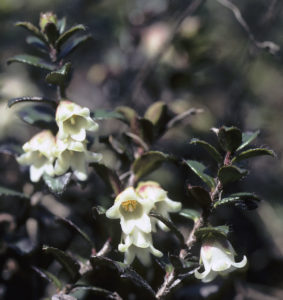
Gaultheria nummularioides, Barun Valley, Makalu-Barun National Park, eastern Nepal. (Photo copyright © by Kaj Halberg)
Gaultheria nummularioides with berries, Ghangyul (2500 m), Helambu, central Nepal. (Photo copyright © by Kaj Halberg)
New foliage of Gaultheria nummularioides is a pretty reddish. – Gul Bhanjyang, Helambu. (Photo copyright © by Kaj Halberg)
Rime covers leaves of Gaultheria nummularioides and a species of clubmoss (Lycopodium), Shermatang, Helambu. (Photo copyright © by Kaj Halberg)
Gaultheria trichophylla
Late in the summer, this many-branched, creeping shrub is easily recognized by its sky-blue, almost luminous fruits, which are edible. The elliptic leaves are very small, to 1 cm long and 5 mm broad, leathery, margin bristly-haired, tip pointed. Flowers are solitary, axillary, corolla bell-shaped, white, to 6 mm long and broad, with 5 erect lobes, to 3 mm long. The persistent, sky-blue, fleshy calyx is fused with the capsule, forming a berry-like fruit, to 1 cm across.
It is very common in many places, creeping over rocks and forested slopes at altitudes between 2,700 and 4,700 m, from Pakistan eastwards to south-western China.
In 1839, British surgeon and naturalist John Forbes Royle (1798-1858) wrote about this species: “This plant is an inhabitant of cold and lofty situations, as Jumnotri, the top of Choor, and of the mountains surrounding Cashmere, and like many plants of such situations is furnished with setae [bristles] on the younger upper parts of branches, probably to protect them from the severity of the cold. The calyx is adherent to the lower part of the capsule, becomes succulent, and forms an edible fruit in the month of September.” (Source: J.F. Royle, 1839. Illustrations of the Botany and Other Branches of the Natural History of the Himalayan Mountains, and of the Flora of Cashmere. Allen and Company, London)
The specific name is derived from Ancient Greek thrix (‘hair’) and phyllon (‘leaf’), alluding to the bristly-hairy leaf margin.
Flower size and colour To 6 mm long and broad, white.
Length to 50 cm or more.
Habitat Forest slopes, mossy rocks, tree stumps.
Flowering May-Jul.
Fruiting Jul.-Sep.
Fruiting Gaultheria trichophylla, Gopte, Langtang National Park, central Nepal. (Photo copyright © by Kaj Halberg)
Lyonia Staggerbush
About 35 species of shrubs or small trees, distributed in eastern Asia and North America. 2 species occur in the Himalaya.
The generic name was given in honour of Scottish botanist John Lyon (1765-1814), who collected plants in the United States. He died of bilious fever during his travels, only 49 years old.
The common name stems from the old days, when someone observed that if sheep ate from these poisonous plants, it would make them stagger.
Lyonia ovalifolia
This deciduous or evergreen shrub or small tree is usually lower than 4 m, but may occasionally grow to 10 m. The brown bark often peels off in thin strips. Leaves are short-stalked, very variable in shape, ovate, elliptic, or lanceolate, 3-20 cm long and 2-12 cm wide, leathery with age, smooth or downy, tip often long-pointed. The white flowers are arranged in axillary, horizontal clusters, 5-20 cm long. The corolla is flask- or urn-shaped, to 1.2 cm long, narrowed at the mouth, with 5 recurved lobes, to 1 mm long.
It is distributed from northern Pakistan eastwards to Japan and Taiwan, southwards to Bangladesh, Indochina, and the Malayan Peninsula. In the Himalaya, it grows at elevations between 1,500 and 3,400 m.
The foliage is toxic to grazing animals. In Nepal, juice of the leaves is applied to scabies and itching, and they are also used as an insecticide.
Flower size and colour To 1.2 cm long, white.
Height usually lower than 4 m, occasionally to 10 m.
Habitat Forests, shrubberies, open slopes.
Flowering Apr.-Jun.
Flowering Lyonia ovalifolia, between Bharku and Shyabru, Langtang National Park, central Nepal. (Photos copyright © by Kaj Halberg)
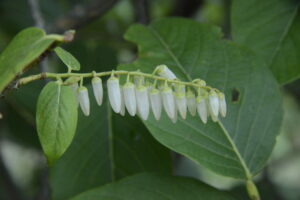
Young inflorescence of Lyonia ovalifolia, Gul Bhanjyang, Helambu, central Nepal. The leaves are are bright green when young, later becoming leathery and shining.(Photo copyright © by Kaj Halberg)
Lyonia villosa
Much like L. ovalifolia, but the leaves are generally smaller and more hairy below, to 7 cm long and 4 cm wide, not long-pointed, the rounded apex often with a tiny tooth. The flower clusters are shorter, to 7 cm long, corolla broadly bell-shaped or urn-shaped, to 8 mm long.
It is distributed from Uttarakhand eastwards to south-western China, in the Himalaya growing at elevations between 2,100 and 3,900 m.
The specific name is Latin, meaning ‘very hairy’, presumably alluding to the leaves being hairy below.
Flower size and colour To 8 mm long, white.
Height to 10 m, but usually lower.
Habitat Forests, shrubberies.
Flowering May-Aug.
Lyonia villosa, Phortse, Khumbu, eastern Nepal. Note the tiny tooth at the apex of the leaves. (Photo copyright © by Kaj Halberg)
Pieris Andromeda
A small genus of shrubs or small trees, comprising 7 species, native to central and eastern Asia, eastern North America, and Cuba. A single species occurs in the Himalaya.
The generic name is derived from Pieria, in Greek mythology the abode of the Muses. Like the common name, it undoubtedly refers to the beauty of these plants.
Pieris formosa
Usually a shrub 1-5 m tall, but may occasionally grow to 10 m. Leaves are dark green, leathery, shining, often reddish when young, blade lanceolate, elliptic, or oblong, 5-15 cm long and to 2 cm wide, margin conspicuously toothed from the base to the pointed tip. Inflorescences are large, spike-like, terminal clusters, corolla white, bell-shaped, to 8 mm long, constricted at the tip, with 5 tiny recurved lobes.
This plant is found from central Nepal eastwards to China and northern Vietnam. In the Himalaya, it grows at elevations between 1,500 and 3,000 m. It is highly toxic, and is thus avoided by grazing animals. For this reason, it is often very common in eroded areas or fallow fields. In Nepal, juice of the leaves is applied to scabies.
The specific name is Latin, meaning ‘beautiful’. A suitable name!
Flower size and colour To 8 mm long, white.
Height usually 1-5 m, occasionally to 10 m.
Habitat Shrubberies, open slopes.
Flowering Mar.-Jun.
Spring foliage of Pieris formosa is often a pretty reddish. These pictures were taken at the village of Chipling, Helambu, central Nepal. (Photos copyright © by Kaj Halberg)
Rhododendron
A huge, almost worldwide genus with c. 1,025 species of evergreen trees, shrubs, shrublets, or climbers, with the largest concentrations in China, the Himalaya, Malaysia, Borneo, and New Guinea. China is the absolute stronghold of the genus, with no less than c. 571 species, of which 409 are endemic. The Himalaya is home to more than 100 species, and a tiny country like Bhutan harbours more than 60. The further west you go in the Himalaya, the fewer species you may observe. Eastern Nepal is home to c. 30 species, western Nepal to 7, and Kashmir to only 4.
Pictures, depicting rhododendrons from other parts of the world, are presented on the page Plants: Rhododendron.
In Ancient Greek, rhododendron means ‘rose tree’, and, from a distance, the flower clusters of certain species may resemble roses.
Rhododendron anthopogon
This small, fragrant shrub, to 1 m tall, usually forms dense thickets on open slopes, often covering large areas. Young branches are covered in brown scales. Leaves are elliptic or oval, to 4 cm long and 2.5 cm wide, base rounded, tip pointed or rounded, upper surface dark green, sparsely scaly, underside covered in overlapping scales, dark reddish-brown or dark yellow-brown, or often both colours. Calyx lobes to 6 mm long, margin densely hairy. The corolla is funnel-shaped, densely hairy in the throat, whitish, yellowish, or pinkish, to 1.2 cm long and 2 cm across, with 5 large, shaggy, almost transparent lobes.
It grows at altitudes between 3,000 and 5,100 m, from Pakistan eastwards to Bhutan and south-eastern Tibet. In Nepal, where it is called sun pathi, dried flowers are utilized as tea, and the branches are burned as dhup (incense) in temples and on house altars. Vapours from boiled leaves are inhaled to relieve cough and colds.
The specific name derived from Ancient Greek anthos (‘flower’) and pogon (‘beard’), probably alluding to the hairy throat of the flower.
Flower size and colour To 1.2 cm long and 2 cm across, whitish, yellowish, or pinkish.
Height to 1 m.
Habitat Shrubberies, open slopes, rocks.
Flowering Apr.-Jul.
Rhododendron anthopogon, Gokyo Valley, Khumbu, eastern Nepal. (Photo copyright © by Kaj Halberg)
This man from the Gosainkund area of central Nepal shows a tray, full of dried sun pathi flowers. (Photo copyright © by Kaj Halberg)
Rhododendron arboreum
This is one of the largest species of the genus in the Himalaya, growing to about 15 m tall. The bark is reddish or brown. Leaves are oblong or lanceolate, to 20 cm long and 4.5 cm wide, glossy green, underside covered in a dense felt of whitish, fawn-, cinnamon-, or rusty-coloured hairs, veins on upper surface grooved. Flowers bright red, pink, or white, in clusters of 10-20, corolla bell-shaped, to 5 cm long and across, with 5 lobes to 1.7 cm long. The intensity of the red colour decreases with altitude, and white flowers are only observed near the upper limit of its distribution. It is very common, and in March-April, when the flowering is at its peak, it adds a reddish or pinkish tinge to the forest in numerous places, stemming from millions of flowers.
In Nepal, this tree is the national plant, called lali guras (‘red rhododendron’), and the flowers are brought as offerings in Hindu and Buddhist shrines. The petals are edible, utilized for sore throat and cough, and also pickled. Juice of the bark is taken for diarrhoea, dysentery, and cough, a paste of the leaves for headache, juice of the flowers for menstrual problems and dysentery. Juice of the leaves is spread on beds to get rid of vermin, and young leaves are used to stupefy fish in streams. The wood is utilized for making furniture, fences, and charcoal, and as fuel, and dried leaves serve as compost.
In its widest sense, this species has an extensive distribution in Asia, from Pakistan eastwards to montane areas of northern Thailand and Vietnam, with isolated subspecies in mountains of South India and Sri Lanka, which are regarded as separate species by some authorities. In the Himalaya, it grows at elevations between 1,500 and 3,800 m.
The specific name is Latin, meaning ‘tree-like’, referring to the large size.
Flower size and colour To 5 cm long and across, red, pink, or white, lobes to 1.7 cm long.
Height to 15 m.
Habitat Forests, open slopes.
Flowering Feb.-May.
Rhododendron arboreum can grow to 15 m tall. – Tadapani, Annapurna, central Nepal. (Photo copyright © by Kaj Halberg)
When flowering, Rhododendron arboreum adds a reddish or pinkish tinge to the forest in numerous places, stemming from millions of flowers. These pictures were taken near Ghorepani, Annapurna, central Nepal. (Photos copyright © by Kaj Halberg)
Rhododendron arboreum with crimson flowers, Shyabru, Langtang National Park, central Nepal. The mountain range in the background is Ganesh Himal. (Photo copyright © by Kaj Halberg)
Rhododendron arboreum with dark pink flowers, Ghorepani, Annapurna, central Nepal. (Photo copyright © by Kaj Halberg)
Rhododendron arboreum with pale pink flowers, Lukla, Khumbu, eastern Nepal. (Photo copyright © by Kaj Halberg)
Rhododendron arboreum with white flowers, Kutumsang, Langtang National Park, central Nepal. (Photo copyright © by Kaj Halberg)
The flowers of Rhododendron arboreum produce a profusion of pollen, and they are much visited by various bird species. In this picture, a striated laughing-thrush (Grammatophila striata) is feeding in a flower, Sinuwa, Modi Khola Valley, Annapurna, central Nepal. (Photo copyright © by Kaj Halberg)
Fruits of Rhododendron arboreum from the previous year, with a few hailstones, Magingoth, Helambu, central Nepal. Note the rusty-felted underside of the leaves. (Photo copyright © by Kaj Halberg)
Rhododendron barbatum
From a distance, this species, growing to 6 m tall, is quite similar to R. arboreum (above), but a closer look reveals distinctive glandular bristles on twigs and leaf-stalk, and the bark is peeling off in thin, cinnamon-coloured or greyish flakes. Above, the leaves are rather similar to those of R. arboreum. Young leaves are woolly below, but become hairless with age. The crimson flowers are clustered in a dense umbel, to 13 cm across, the bell-shaped corolla to 3.6 cm long, with 5 blackish-red nectar pouches at the base.
This plant is very common in the Himalaya, found from Uttarakhand eastwards to Bhutan and south-eastern Tibet, often forming pure stands at altitudes between 2,400 and 3,600 m.
The specific name is Latin, meaning ‘bearded’, alluding to the bristles on twigs and leaf-stalk.
Flower size and colour To 3.6 cm long, crimson.
Height to 6 m.
Habitat Forests.
Flowering Apr.-Jun.
Dense Rhododendron barbatum forest, Kutumsang, Langtang National Park, central Nepal. (Photos copyright © by Kaj Halberg)
Rhododendron barbatum, Ghorepani, Annapurna, central Nepal. Note the pale green underside of the leaves, without felt. (Photo copyright © by Kaj Halberg)
This picture from Helambu, central Nepal, shows the distinctive bristles on the leaf-stalks of Rhododendron barbatum. (Photo copyright © by Kaj Halberg)
The bark of Rhododendron barbatum peels off in thin, cinnamon-coloured flakes. These trunks were photographed near Tharepati, Langtang National Park, central Nepal. (Photos copyright © by Kaj Halberg)
Rhododendron campanulatum
As its specific name, derived from the Latin campanula (‘little bell’), implies, this attractive shrub, to 8 m tall, has broadly bell-shaped flowers, clustered in umbels with up to 12 flowers, corolla mauve, rose-coloured, lilac, or purple, rarely white, to 4 cm long, with 5 rounded lobes. Leaves are leathery, broadly elliptic or oval, to 15 cm long and 6 cm wide, tip rounded, with a rusty-coloured layer of hairs below.
This plant is very common from Pakistan eastwards to Bhutan and south-eastern Tibet, often forming dense thickets at altitudes between 2,800 and 4,300 m. In Nepal, the wood is collected for fuel, and juice of the leaves is used for rheumatism and syphilis.
Flower size and colour To 4 cm long, mauve, rose-coloured, lilac, or purple, rarely white.
Height to 8 m, but often only 1-2 m.
Habitat Shrubberies, open slopes.
Flowering Apr.-Jul.
Rhododendron campanulatum, Kyanjin Gompa, Langtang National Park, central Nepal. The mountain in the background is Langtang II (7227 m). (Photo copyright © by Kaj Halberg)
Raindrops cling to these flowers of Rhododendron campanulatum, Ghunsa Valley, eastern Nepal. (Photos copyright © by Kaj Halberg)
One characteristic of Rhododendron campanulatum is the rusty-coloured layer of hairs on the underside of the leaves. – Tharepati, Langtang National Park, central Nepal (top), and Ghunsa Valley, eastern Nepal. (Photos copyright © by Kaj Halberg)
Rhododendron campylocarpum
This shrub, to 3 m tall, is very common from eastern Nepal eastwards to south-western China, at altitudes between 3,000 and 4,000 m. In places, it brightens large tracts of forest with its beautiful pale yellow inflorescences.
Young branches are greenish, older branches greyish, with flaking bark. Leaves are green and shining above, greenish below, rounded or elliptic, to 8.5 cm long and 4 cm wide, margin slightly recurved, tip rounded. Flowers are in terminal umbels, up to 7 together, bell-shaped, pale yellow, to 4 cm long and across, with 5 lobes to 2 cm long.
The specific name is derived from Ancient Greek kampylos (‘curved’) and karpos (‘fruit’), alluding to the curved capsules of this plant.
Flower size and colour To 4 cm long and across, pale yellow.
Height to 3 m.
Habitat Forests, shrubberies.
Flowering May-Jun.
Rhododendron campylocarpum is very common in the Khumbu area, eastern Nepal, where these pictures were taken. (Photos copyright © by Kaj Halberg)
Rhododendron ciliatum
A small shrub to 2 m tall, often growing on rocks. Leaves are leathery, elliptic or oblong, to 9 cm long and 3.7 cm wide, with bristly margin, and along the midrib, scaly below. Flowers are in small terminal clusters, 2-4 together, corolla funnel-shaped, to 5 cm long, white, often tinged with pink, with 5 notched, overlapping lobes, flower-stalks bristly.
This plant has a rather limited distribution, found from eastern Nepal eastwards to Bhutan and south-eastern Tibet, growing at altitudes between 2,700 and 3,900 m.
The specific name is Latin, meaning ‘ciliate’, alluding to the bristly leaf margin and flower-stalk.
Flower size and colour To 5 cm long, white, often tinged with pink, with 5 overlapping lobes.
Height to 2 m.
Habitat Shrubberies, rocks.
Flowering May-Jun.
Rhododendron ciliatum, Mumbuk, Barun Valley, Makalu-Barun National Park, eastern Nepal. (Photos copyright © by Kaj Halberg)
Rhododendron cinnabarinum
This shrub, to 5 m tall, can be identified by its tubular, waxy, fleshy, often pendent flowers, to 5 cm long, which are usually crimson, but sometimes pinkish, yellow, or purplish, with 5 rather upright lobes, to 1.7 cm long. Leaves are leathery, elliptic, oblong, or ovate, to 10 cm long and 5 cm broad, glossy green above, bluish-green and scaly below.
This species grows at altitudes between 3,000 and 4,000 m, from eastern Nepal eastwards to Myanmar and the Yunnan Province. In Nepal, the wood is collected for fuel.
The specific name is derived from Ancient Greek kinnabaris, indicating a bright red colour, tinted with orange. The name of course alludes to the flower colour.
Flower size and colour To 5 cm long, usually crimson, sometimes pinkish, yellow, or purplish.
Height to 5 m.
Habitat Forests, shrubberies.
Flowering May-Jun.
Rhododendron cinnabarinum is common in the Upper Ghunsa Valley, eastern Nepal, where this picture was taken. Its branches are draped with old-man’s-beard lichens (Usnea). (Photo copyright © by Kaj Halberg)
Usually, the flowers of Rhododendron cinnabarinum are dark red, but occasionally paler flowers occur, as those in the lower picture. – Ghunsa Valley. (Photos copyright © by Kaj Halberg)
Rhododendron dalhousiae
In April-May, this epiphytic species, to 2 m long, displays a profusion of large, fragrant, yellow or lemon-coloured flowers, which later turn white. Corolla is to 10 cm long and wide, with 5 large recurved lobes. Young shoots are bristly-scaly. Leaves are oblong or oblanceolate, to 15 cm long and 5 cm wide, with grooved veins on the upper side, underside bluish-green and scaly.
It is distributed from central Nepal eastwards to Arunachal Pradesh and south-eastern Tibet, and it is also found in Bangladesh. It is cultivated elsewhere as an ornamental, and is threatened by excessive collecting. In the Himalaya, it grows at elevations between 1,500 and 2,600 m. In Nepal, juice of young leaves is applied to wounds on cattle.
This gorgeous plant was named by British botanist Joseph Dalton Hooker (see below) in honour of Lady Dalhousie, wife of George Ramsay, the 9th Earl of Dalhousie, who was governor-general in India in the first half of the 1800s. Lady Dalhousie was an avid collector of plants.
Rhododendron lindleyi is similar, but the calyx is fringed with soft white hairs.
Flower size and colour To 10 cm long and wide, initially yellow or lemon-coloured, later turning white.
Height/length to 2 m.
Habitat Epiphyte on trees, or on rocks.
Flowering Apr.-Jun.
Rhododendron dalhousiae, Tashigaon, Arun Valley, eastern Nepal. (Photos copyright © by Kaj Halberg)
On this specimen of Rhododendron dalhousiae, the flower colour has changed to snow-white, Gyapla, Ghunsa Valley, eastern Nepal. (Photo copyright © by Kaj Halberg)
Joseph Dalton Hooker
Joseph Dalton Hooker (1817-1911) was a British botanist, one of the founders of geographical botany. He participated in several botanical expeditions, to Antarctica 1839-1843, to the Himalaya and India 1847-1851, to Palestine 1860, to Morocco 1871, and to the western United States 1877.
In 1865, he was appointed Director of the Royal Botanic Gardens, Kew, holding the post for twenty years. He was a close friend of the famous Charles Darwin (1809-1882).
During his stay in Asia, he described no less than 22 new rhododendron species from Sikkim and other parts of the eastern Himalaya.
Joseph Dalton Hooker was one of the most eminent botanists of the 19th Century. (Photo: Public domain)
Rhododendron fulgens
This shrub, to 4 m tall, has a rather limited distribution, found from eastern Nepal eastwards to Bhutan and south-eastern Tibet, growing at altitudes between 3,300 and 4,500 m. Leaves are leathery, oblong or broadly ovate, to 11 cm long and 7 cm wide, base rounded or heart-shaped, tip rounded, glossy-green above, covered in reddish-brown felt below. Flowers are blood-red, bell-shaped or tubular, to 4 cm long and across, with 5 dark nectar pouches in the throat. Anthers are chocolate-brown.
In Nepal, the wood is collected for fuel.
The specific name is Latin, meaning ‘shining’, probably alluding to the glossy leaves.
Flower size and colour To 4 cm long and across, blood-red.
Height to 4 m.
Habitat Forests, shrubberies.
Flowering Apr.-Jun.
Early in the morning, the flowers of this Rhododendron fulgens, observed in the Barun Valley, eastern Nepal, are covered in rime. (Photo copyright © by Kaj Halberg)
Rhododendron hodgsonii
This large shrub, which grows to 7 m tall, is easily identified by its dense, flat-topped inflorescences and large leaves. It has a rather limited distribution, from eastern Nepal eastwards to Arunachal Pradesh and south-eastern Tibet, often forming pure stands at altitudes between 3,000 and 4,000 m.
The leaves are leathery, oblong-elliptic or oblanceolate, to 30 cm long and 12 cm wide, dark-green above, woolly-haired beneath, base and apex rounded, leaf-stalk thick. Flowers are in very dense, flat-topped clusters, 15-20-flowered, corolla tubular or bell-shaped, magenta, purple, pink, pale pink, or whitish, to 4 cm long and 5 cm across, with 7-8 small lobes and darker basal blotches in the throat.
In Nepal, the wood is used as fuel.
The specific name was applied by Joseph Dalton Hooker (see R. dalhousiae above) in honour of his friend, British naturalist and ethnologist Brian Houghton Hodgson (1801-1894), who described numerous new species of birds and mammals in the Himalaya.
Flower size and colour To 4 cm long and 5 cm across, magenta, purple, pink, pale pink, or whitish.
Height to 7 m.
Habitat Forests, shrubberies.
Flowering Apr.-Jun.
Dense forest of Rhododendron hodgsonii, Lower Barun Valley, Makalu-Barun National Park, eastern Nepal. (Photo copyright © by Kaj Halberg)
The flower colour of Rhododendron hodgsonii varies from magenta to whitish. Here, my guide Saila Tamang is standing in a dense growth in the Lower Barun Valley. (Photo copyright © by Kaj Halberg)
Rhododendron hodgsonii is common in eastern Nepal. These pictures are from the Barun Valley (top) and the Ghunsa Valley, both in eastern Nepal. (Photos copyright © by Kaj Halberg)
Rhododendron lepidotum
Flowers of this dwarf shrub, to 1.5 m tall, vary in colour, from red or purple to pink or white. Occasionally, a form with pale yellow flowers may also be observed. They are axillary, long-stalked, broadly bell-shaped, to 1.7 cm long and 2.5 cm across, often terminal, solitary or up to 4 together. The leaf shape also varies quite a lot, obovate, elliptic, oblong, or lanceolate, to 3.8 cm long and 1.8 cm wide, scaly on both surfaces, tip rounded or pointed, sometimes with a short spine.
This is one of the most widespread and common Himalayan rhododendron species, distributed from Pakistan eastwards to south-western China. It also has a wide altitudinal range, found between 2,000 and 4,700 m.
In Nepal, dried leaves are burned as dhup (incense) in temples. Tea made from the leaves is taken as a blood purifier. Pounded leaves are spread on beds to get rid of vermin.
The specific name is derived from Ancient Greek lepis (‘scale’), alluding to the abundance of scales on both sides of the leaves.
Flower size and colour To 1.7 cm long and 2.5 cm across, red, purple, pink, or white, sometimes pale yellow.
Height to 1.5 m.
Habitat Open slopes, shrubberies, open forests.
Flowering May-Aug.
Shrubs of red-flowered Rhododendron lepidotum, Ghumtarao, Great Himalayan National Park, Himachal Pradesh (top), and Mundo, Upper Langtang Valley, central Nepal. (Photos copyright © by Kaj Halberg)
Red-flowered form, Langtang National Park, central Nepal. Note the ant in the flower. (Photo copyright © by Kaj Halberg)
White-flowered form, Pole, Ghunsa Valley, eastern Nepal. (Photos copyright © by Kaj Halberg)
The rare yellowish form, observed in the Gokyo Valley, Khumbu, eastern Nepal. (Photo copyright © by Kaj Halberg)
Rhododendron nivale
The alpine zone of the Himalaya, above the tree limit, is home to several species of dwarf rhododendron, including this plant, which is distributed from western Nepal eastwards to south-western China, at altitudes between 4,500 and 5,600 m, mainly growing in drier areas.
A low, compact, many-branched shrub, prostrate or sometimes to 90 cm tall, leaves to 1.5 cm long and 6 mm wide, elliptic, ovate, or rounded, tip blunt, base broadly triangular, scaly on both sides, underside yellowish or fawn. Flowers are solitary or up to 3 together, calyx tiny or missing, corolla varying in colour, purple, magenta, lilac or pink, broadly funnel-shaped, to 1.3 cm across, tube to 6 mm long.
It is quite similar to R. setosum (below), but the leaf margin of that species usually has bristles, and its flowers are larger.
The specific name is derived from the Latin nix (‘snow’) and the suffix alis, thus ‘found in snow’, referring to the fact that this plant grows at very high altitudes.
Flower size and colour To 2 cm across, violet, occasionally pink.
Height to 1 m, but usually lower.
Habitat Rocky slopes, screes.
Flowering Jun.-Aug.
Rhododendron nivale, photographed in the Khumbu region, eastern Nepal. (Photos copyright © by Kaj Halberg)
Rhododendron pumilum
This shrub rarely grows taller than 10 cm, reflected in its specific name, which is derived from the Latin pumilio (‘dwarf’). The leaves are leathery, ovate or elliptic, scaly beneath, to 2 cm long and 1.2 cm broad, base rounded, tip rounded or pointed, often with a short spine. The pink, tubular or bell-shaped flowers are on scaly stalks to 2.6 cm long, solitary or up to 3 together, nodding, corolla to 2 cm long, downy on the outside.
It is distributed from eastern Nepal eastwards to Myanmar and south-western China, growing at altitudes between 3,300 and 4,300 m. It is rather rare in Nepal, but is prominent in the Barun Valley.
Flower size and colour To 2 cm long, pink.
Height to 25 cm, but usually below 10 cm.
Habitat Open slopes, rocks.
Flowering Apr.-Jul.
Rhododendron pumilum, Barun Valley, eastern Nepal. (Photos copyright © by Kaj Halberg)
Rhododendron setosum
A dwarf shrub to 50 cm tall, branches bristly-hairy, leaves elliptic, oblong, or obovate, to 1.5 cm long and 8 mm wide, tip and base rounded, upperside dark green, with golden scales, margin usually with bristly hairs, sometimes inrolled, underside pale green, densely scaly. Flowers are single or up to 4 together, calyx deeply lobed, lobes rounded, to 8 mm long, scaly, corolla widely funnel-shaped, pale violet, purplish-pink, or sometimes pale pink, to 1.8 cm across, tube to 8 mm long, stamens 10, long and spreading.
It is found on alpine slopes at altitudes between 3,600 and 4,800 m, from central Nepal eastwards to Bhutan and a single place in southern Tibet. It is very common in the Khumbu area, eastern Nepal.
In Nepal, dried leaves are used as tea.
The specific name is derived from the Latin saeta (‘bristle’), referring to the bristly leaf margin.
It is quite similar to R. nivale (above), but its leaf margin usually has bristles, and the flowers are larger and more pinkish.
Flower size and colour To 2.5 cm across, reddish-violet, rarely pink.
Height to 1 m, but usually lower.
Habitat Grasslands, open slopes, shrubberies.
Flowering Apr.-Jul.
Rhododendron setosum, Machhermo, Gokyo Valley, Khumbu, eastern Nepal. Tibetan prayer flags are seen in the background. (Photo copyright © by Kaj Halberg)
Rhododendron setosum, photographed in front of a mountain named Taboche (6367 m), Khumbu. (Photo copyright © by Kaj Halberg)
The pink-flowered form, next to flowers of the normal reddish-violet colour, Khumbu. (Photo copyright © by Kaj Halberg)
Close-up of the flowers and the scaly leaves, Khumbu. (Photo copyright © by Kaj Halberg)
Rhododendron thomsonii
This shrub, growing to 5 m tall, is easily identified by its broadly bell-shaped, waxy, fleshy, blood-red flowers, to 6 cm long, and by the pinkish-red, fleshy calyx. The leaves are stalked, oval or almost circular, bright green above and bluish-green below, to 7 cm long and 6 cm wide. The flowers are in dense, terminal, flat-topped, 4-8-flowered umbels, the corolla with 5 large, rounded, notched lobes.
It grows in open areas, preferably near streams, at altitudes between 2,900 and 4,000 m, from eastern Nepal eastwards to Bhutan and south-eastern Tibet.
The specific name was applied by Joseph Dalton Hooker (see R. dalhousiae above) in honour of his friend, British surgeon and botanist Thomas Thomson (1817-1878), who assisted in writing the first volume of Flora Indica.
Flower size and colour To 6 cm long, blood-red, calyx pinkish-red.
Height to 5 m.
Habitat Forests, shrubberies, open slopes, mainly along water courses.
Flowering May-Jun.
Rhododendron thomsonii is quite common in the Upper Ghunsa Valley, eastern Nepal, where these picture were taken. The plants with pink flowers are Rhododendron campanulatum, and the tree with new foliage is an east Himalayan larch (Larix griffithii). (Photos copyright © by Kaj Halberg)
Rhododendron triflorum
An evergreen or sometimes deciduous shrub to 4 m tall, whose bark peels off in thin, cinnamon-coloured flakes. Young shoots are scaly. Leaves are variable, ovate, oblong, or lanceolate, to 8 cm long and 2.5 cm wide, base rounded or heart-shaped, tip pointed, shiny and smooth above, glandular and scaly below. The flowers are terminal among new shoots, in clusters of 3, as indicated by the specific name, corolla pale yellow with a greenish tinge, green- or brown-spotted within, bell-shaped, to 3.5 cm long and 5 cm across.
This species is found from eastern Nepal eastwards to Bhutan and the Yunnan Province, at altitudes from 2,400 to 3,700 m.
In Nepal, the wood is used as fuel.
Flower size and colour To 3.5 cm long and 5 cm across, pale yellow with a greenish tinge, brown-spotted within.
Height to 4 m.
Habitat Shrubberies, forests.
Flowering Apr.-May.
Rhododendron triflorum, Pole, Ghunsa Valley, eastern Nepal. (Photos copyright © by Kaj Halberg)
Rhododendron wallichii
This shrub, to 4 m tall, closely resembles R. campanulatum (above) and was previously regarded as a variety of it. However, the leaves are not felt-haired below, and the bell-shaped flowers are generally pure white, sometimes with a pinkish or violet tinge.
It is distributed from eastern Nepal eastwards to Bhutan and south-eastern Tibet, at elevations between 3,000 and 4,300 m.
The specific name was given in honour of Danish physician and botanist Nathaniel Wallich (1786-1854), who studied the Indian and Himalayan flora in the early 1800s (see Strobilanthes atropurpurea above).
Flower size and colour To 5 cm long, white, sometimes with a pinkish or violet tinge.
Height to 4 m.
Habitat Forests, shrubberies, open slopes.
Flowering May-Jun.
These pictures are from the Khumbu area, eastern Nepal, where Rhododendron wallichii is very common. (Photos copyright © by Kaj Halberg)
Rhododendron wightii
This plant, which grows to 4 m tall, forms thickets many places in the eastern Himalaya, from eastern Nepal eastwards to Bhutan and south-eastern Tibet, between 3,300 and 4,300 m altitude. The leaves are large, leathery, oblong or elliptic, pointed, to 20 cm long and 7 cm wide, with felt-like, rusty hairs beneath. The bell-shaped flowers are in lax, 10-20-flowered umbels, corolla very pale yellow, to 4.5 cm long and 5 cm across, with crimson blotches at the base within.
In Nepal, the wood is collected for fuel.
The specific name was given in honour of Scottish surgeon and botanist Robert Wight (1796-1872), who spent most of his life in southern India, where he was the leading botanical taxonomist, describing 110 new genera and 1,267 new species. He published a series of illustrated works in Madras, including the six-volume Icones Plantarum Indiae Orientalis (1838–53), the Illustrations of Indian Botany (1838–50), and Spicilegium Neilgherrense (1845–51).
Flower size and colour To 4.5 cm long and 5 cm across, very pale yellow with crimson blotches at the base within.
Height to 4 m.
Habitat Shrubberies, open slopes.
Flowering May-Jun.
Rhododendron wightii, Barun Valley, eastern Nepal. In the upper picture, it is photographed in front of a dark rock, named Neh. (Photos copyright © by Kaj Halberg)
Vaccinium Blueberry, bilberry
A huge genus with about 450 species of shrubs or shrublets, found throughout the Northern Hemisphere. Also in tropical mountains of Asia and Central and South America, and a few species in Africa and on Madagascar. 6 species occur in the Himalaya.
The generic name is the classical Latin name of blueberries.
Vaccinium nummularia
An evergreen shrub, epiphytic or on rocks, with pendent, brown, much-branched, densely hairy stems, to about 1 m long. Leaves dense, sessile, ovate or elliptic, to 2.3 cm long and 1.2 cm wide, leathery, smooth, margins recurved and bristly-haired. Flowers are in dense terminal clusters, to 5 cm long and wide, corolla flask-shaped, white with reddish streaks and mouth, to 6 mm long, lobes erect or reflexed, to 0.8 mm long. Berries are initially red, then black, globular, to 6 mm across.
This plant is distributed from central Nepal eastwards to Myanmar and the Yunnan Province, at elevations between 2,000 and 4,000 m. It is common in eastern Nepal.
The specific name is derived from the Latin nummulus, diminutive of nummus (‘coin’), alluding to the leaf shape.
Flower size and colour To 6 mm long, white with reddish streaks, and also in the mouth.
Height/length to 1 m.
Habitat Epiphytic or on rocks.
Flowering Apr.-Jun.
Fruiting Jun.-Aug.
Vaccinium nummularia, above Pole, Ghunsa Valley, eastern Nepal. (Photo copyright © by Kaj Halberg)
Vaccinium retusum
Much like the above species, but young branches are finely hairy, older branches hairless. Leaves are larger, to 3 cm long, blunt, narrowed to a short stalk. Flowers are arranged in terminal, spike-like clusters, corolla pink with reddish stripes, to 4 mm long, subtended by a transparent bract, as long as or longer than the flower. Berries are blackish-purple, to 5 mm across.
It is found from central Nepal eastwards to Myanmar and the Yunnan Province, at altitudes between 1,400 and 3,600 m.
The specific name is Latin, meaning ‘blunt’, probably referring to the blunt leaves.
Flower size and colour To 4 mm long, pink with reddish stripes, subtended by a transparent bract, as long as or longer than the flower.
Height/length to 50 cm.
Habitat Epiphytic or on rocks.
Flowering Apr.-May.
Fruiting Jun.-Jul.
Vaccinium retusum, between Gyapla and Amjilassa, Ghunsa Valley, eastern Nepal. (Photo copyright © by Kaj Halberg)
Vaccinium vacciniaceum
An evergreen shrub, epiphytic or on rocks, to about 50 cm long, branched. The leathery leaves are elliptic or oblong, to 5 cm long and 1.4 cm wide, with toothed lobes along the margin. Flowers are borne in stalked clusters, to 6 cm across, at the end of branches, corolla greenish, yellowish, or pinkish, urn-shaped, to 6 mm long, with lobes about 0.6 mm long.
This plant is distributed from eastern Nepal eastwards to Myanmar and south-eastern Tibet, at elevations between 1,200 and 2,800 m. It is common in the Arun and Tamur valleys, eastern Nepal.
Flower size and colour To 6 mm long, greenish, yellowish, or pinkish, lobes about 0.6 mm long.
Height/length to 50 cm.
Habitat Epiphytic or on rocks.
Flowering Apr.-Jun.
Fruiting Jun.-Aug.
Vaccinium vacciniaceum, Arun Valley, eastern Nepal. (Photo copyright © by Kaj Halberg)
Euphorbiaceae Spurge family
This huge, almost worldwide family contains more than 300 genera and close to 9,000 species of herbs, shrubs, or trees, rarely climbers. About 32 genera occur in the Himalaya.
Euphorbia Spurge
This is by far the largest genus in the family, comprising about 2,000 species of herbs, shrubs, or small trees, some succulent and/or spiny, most with a milky sap. About 30 species are found in the Himalaya.
The floral structure of these plants, the cyathium, is cup-like, consisting of fused bracts with nectary glands along the margin. These bracts are surrounding a ring of male flowers, each with one stamen, and a single female flower is in the centre. Together, these flowers resemble a single flower. The fruit is a capsule, with 3 valves.
King Juba II (c. 50 B.C. – 19 A.D.) of Numidia (in present-day Algeria and Tunisia) had an interest in plants and often described them, including a thorny, succulent plant from the Atlas Mountains in Morocco, whose latex was a powerful laxative. He named this plant Euphorbea in honour of his Greek chief physician, Euphorbus. In 1753, Swedish naturalist Carl Linnaeus (1707-1778) adopted this name, in the form Euphorbia, for the entire genus.
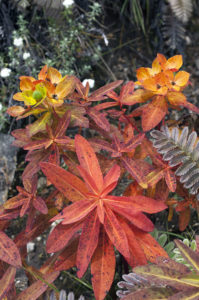
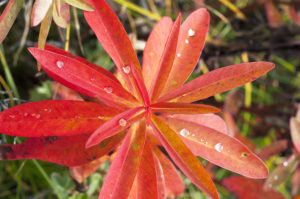
The leaves of some Euphorbia species turn bright red in autumn. This unidentified species was photographed near Dukpu, Langtang National Park, central Nepal. (Photos copyright © by Kaj Halberg)
Autumn colours of another unidentified species, Koto (2600 m), Upper Marsyangdi Valley, Annapurna, central Nepal. (Photo copyright © by Kaj Halberg)
Young leaves of an unidentified species, Namche, Khumbu, eastern Nepal. (Photo copyright © by Kaj Halberg)
Euphorbia donii
This plant, also known as E. longifolia, has a single or several stems, nearly smooth, to 70 cm tall, branched above. Leaves are alternate, leathery, linear, oblong, or elliptic, to 10 cm long and 1.1 cm broad, margin entire. The leaves turn a pretty red in autumn. Involucral bracts are yellow or greenish-yellow, ovate or elliptic, pointed, to 6 cm long and 1 cm wide, pointed, cyathium yellow, bell-shaped, c. 3 mm across, white-haired within.
It is found from western Nepal eastwards to Bhutan and south-eastern Tibet, at elevations between 1,700 and 2,900 m.
The specific name honours Scottish botanist David Don (1799-1841), who described a large number of plants, including several genera from the Himalaya. The former name longifolia is Latin, meaning ‘long-leaved’.
Flower size and colour Involucral bracts to 6 cm long and 1 cm wide, yellow or greenish-yellow, cyathium yellow.
Height to 70 cm.
Habitat Open slopes, fallow fields.
Flowering Mar.-Jul.
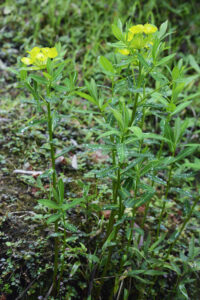
Euphorbia donii with numerous rain drops, near Magingoth, Langtang National Park, central Nepal. (Photo copyright © by Kaj Halberg)
Euphorbia donii with unripe fruits, Deorali, Solu, eastern Nepal. (Photo copyright © by Kaj Halberg)
Euphorbia milii Crown-of-Thorns
This striking plant, formerly named E. splendens, is easily identified by its very spiny, brown, woody branches, and scarlet, rounded involucral bracts in pairs, to 1 cm long and 1.5 cm wide, with a tiny spine at the tip, cyathium deep red. (In some cultivars, the bracts may be pink, white, or yellow.)
It is native to Madagascar, but due to its beautiful bracts it has been widely cultivated elsewhere as an ornamental for hundreds of years. It is also used medicinally. In China, it is utilized for treatment of cancer and hepatitis. In Nepal, the latex is applied to sprains, in Brazil to warts. It may also possess antifungal and pain-killing properties.
In the Himalaya, and elsewhere, it is much planted as a goat-proof hedge due to its vicious thorns, which gave rise to the popular name Crown-of-Thorns. According to legend, a spiny crown was placed on the head of Jesus Christ prior to his crucifixion.
The specific name commemorates Baron Pierre Bernard Milius (1773-1829), governor of Réunion, and later administrator of Cayenne, who introduced the plant to France in 1821.
Flower size and colour Involucral bracts to 1 cm long and 1.5 cm wide, scarlet, cyathium deep red.
Height to 90 cm.
Habitat Villages, along trails, on walls.
Flowering Mar.-Sep.
Euphorbia milii, planted on a stone wall near the village of Tipling, Lower Kali Gandaki Valley, Annapurna, central Nepal. A garden nasturtium (Tropaeolum majus) is climbing over the shrub. (Photos copyright © by Kaj Halberg)
Euphorbia royleana
This cactus-like spurge sometimes grows into a small tree, to 7 m tall. The stem is green, 4-7 cm thick, branching in the upper part. It has 5-7 ribs with tubercles, each armed with 2 short spines. In spring and autumn, it has fleshy, spathulate leaves, to 15 cm long and 4 cm wide, clustered towards the apex. They are shed during the hot and cold seasons. Involucral bracts and cyathium bright yellow or yellowish-green, entire involucre tiny, to 2.5 mm across.
This plant is distributed from Pakistan eastwards across the Himalaya to southern China and Taiwan. In the Himalaya, it grows up to an altitude of 1,800 m. It is sometimes cultivated as a hedge, and in some areas it is regarded as a magical plant, which can protect houses against lightning.
The pith is edible, boiled and pickled. The latex is utilized to stupefy fish. In Nepal, the boiled pith is used for stomach and gastric problems, and a paste of the leaves is applied to wounds. Juice of the leaves is used for fever, and also dripped into the ears to remove pus. The latex is applied to boils and pimples, and also used for sprains, cough, and asthma, and to expel intestinal worms. It is applied to fungi between the toes, caused by walking barefoot in water during the rainy season. In Ayurvedic medicine, it is used to treat leukaemia.
The specific name was given in honour of British surgeon and naturalist John Forbes Royle (1798-1858), who is chiefly known for his works Illustrations of the Botany and other branches of Natural History of the Himalayan Mountains, and Flora of Cashmere.
Flower size and colour Entire involucre to 2.5 mm across, bracts and cyathium bright yellow or yellowish-green.
Height to 7 m.
Habitat Dry slopes, rocks.
Flowering Mar.-Jun.
Flowering Euphorbia royleana, growing on a rocky slope above a reservoir, Uttarkashi, Uttarakhand. (Photos copyright © by Kaj Halberg)
Euphorbia sikkimensis Sikkim spurge
This herb has a single or several smooth stems, to 80 cm tall, branched towards the apex. Leaves are very short-stalked, alternate, oblong, to 10 cm long and 2 cm wide, smooth, margin entire, nerves prominent, forked towards the leaf margin. Involucral bracts bright yellow, sometimes with a greenish tinge, elliptic or ovate, pointed, to 5 cm long and 2 cm wide, cyathium bright yellow.
It is distributed from Nepal eastwards to western China, in the Himalaya found at elevations between 2,400 and 4,500 m. It is very common in eastern Nepal and Sikkim. In Nepal, the root is used medicinally.
Flower size and colour Involucral bracts to 5 cm long and 2 cm wide, bright yellow, cyathium bright yellow.
Height to 80 cm.
Habitat Shrubberies, grasslands, open areas.
Flowering Apr.-Jul.
Euphorbia sikkimensis, Ghat, Khumbu, eastern Nepal. The vividly coloured stone in the background is a mani stone with carved Buddhist mantras. Such structures are described in detail on the page Religion: Buddhism. (Photo copyright © by Kaj Halberg)
Euphorbia sikkimensis, Tharo Kosi River, Khumbu, eastern Nepal. (Photo copyright © by Kaj Halberg)
Euphorbia stracheyi
The purple, reddish, or yellowish, smooth stems of this prostrate plant are often in a rosette, mostly creeping, sometimes ascending, to 50 cm long, but usually much shorter. Leaves many, stalkless, ovate or elliptic, to 2.7 cm long and 1 cm wide, margin entire, tip rounded or pointed. Involucral bracts usually 4, pale green, red, or purple, ovate or obovate, to 8 mm long and 6 mm broad, apex rounded, cyathium egg-yolk-yellow or red, 5-lobed, lobes to 4 mm long and wide.
This plant is distributed from Kashmir eastwards to Bhutan and western China, in the Himalaya found at elevations between 3,300 and 4,900 m. In Nepal, a paste of the root is taken to cure diarrhoea.
The specific name commemorates British soldier and plant collector Richard Strachey (1817-1908).
Flower size and colour Involucral bracts to 8 mm long and 6 mm broad, pale green, red, or purple, cyathium egg-yolk-yellow or red.
Height/length to 50 cm, but often much shorter.
Habitat Meadows, shrubberies, open areas.
Flowering May-Jul.
Euphorbia stracheyi, Shomare, Khumbu, eastern Nepal. (Photo copyright © by Kaj Halberg)
Euphorbia stracheyi, Machhermo, Gokyo Valley, Khumbu, eastern Nepal. (Photo copyright © by Kaj Halberg)
Euphorbia wallichii
This herb has a single or several stems, to 1 m tall, but often much lower, unbranched, very leafy, smooth. Leaves are alternate, linear to elliptic, entire, to 10 cm long and 3 cm broad, many-veined, gradually changing in colour from bluish-green to green to yellowish-green to yellow up the stem, merging into the 5-7 yellow, ovate, pointed involucral bracts, to 6 cm long and 3.5 cm broad. The cyathium is golden-yellow, broadly bell-shaped, to 7 mm across, white-haired within.
This plant is distributed from Afghanistan eastwards to south-western China, found at elevations between 1,800 and 4,700 m. It is very common in Nepal, where the latex is often applied to treat goitre.
The specific name was given in honour of Danish physician and botanist Nathaniel Wallich (1786-1854), who studied the Indian and Himalayan flora in the early 1800s (see Strobilanthes atropurpurea above).
Flower size and colour Involucral bracts to 6 cm long and 3.5 cm broad, cyathium bright yellow.
Height to 1 m, but often much lower.
Habitat Grasslands, shrubberies, open slopes.
Flowering Apr.-Aug.
Euphorbia wallichii, growing on a slope above the Dudh Kosi River, near Mondzo, Khumbu, eastern Nepal. (Photo copyright © by Kaj Halberg)
Euphorbia wallichii, Kyangjuma, Khumbu, eastern Nepal. The plant with chocolate-brown flowers is Thermopsis barbata (Fabaceae). (Photo copyright © by Kaj Halberg)
Close-up of Euphorbia wallichii, Namche Bazaar, Khumbu, eastern Nepal. (Photo copyright © by Kaj Halberg)
Euphorbia wallichii, displaying autumn colours, Dukpu, Langtang National Park, central Nepal. (Photo copyright © by Kaj Halberg)
Falconeria insignis
In the Himalaya, this deciduous tree is usually less than 18 m tall, but may grow to a large tree in the tropical lowlands. It was formerly known as Sapium insigne, but has been transferred to the genus Falconeria – the only member of that genus. It is widely distributed, from India and Sri Lanka eastwards to southern China, and thence southwards to the Malaccan Peninsula. It grows in forests and open areas, in the Himalaya up to an elevation of about 1,800 m.
On older trees, the bark is very thick and rough, and the branches have many scars from shed foliage. Leaves are stalked, elliptic, to 20 cm long and 11 cm wide, pointed, margin toothed, with many lateral veins. The flowers appear early in spring, before the leaves. They are tiny, red or yellow, clustered in terminal upright spikes, to 10 cm long, which may be either male or female, or males and females on the same spike, males above and females below. The fruits are chocolate-brown, globular, to 8 mm across, clustered on spikes up to 50 cm long.
The latex is poisonous, utilized for stupefying fish. According to a tribal medicine man, it is so toxic that it can blind a person. The fruits are a popular food item of green pigeons of the genus Treron.
The generic name was given in honour of Scottish geologist, botanist, and palaeontologist Hugh Falconer (1808-1865), who studied flora, fauna, and geology of India and Myanmar. He was the first to discover the Siwalik fossil beds, and may also have been the first person to unearth a fossil ape.
The specific name is Latin, meaning ‘remarkable’.
Flower size and colour See above.
Height to 18 m, rarely more in the Himalaya.
Habitat Forests, shrubberies, open areas.
Flowering Mar.-Apr.
Fruiting May-Dec.
Flowering Falconeria insignis, Lower Marsyangdi Valley, Annapurna, central Nepal. The bird is a rufous treepie (Dendrocitta vagabunda), presented on the page Animals – Birds: Corvids. (Photos copyright © by Kaj Halberg)
Fruiting Falconeria insignis, Num, Arun Valley, eastern Nepal. (Photo copyright © by Kaj Halberg)
Ricinus communis Castor oil plant
The sole member of the genus. Fossil remains suggest that it may have originated in Egypt. At an early stage, it was widely cultivated elsewhere, and today it has become naturalized worldwide in tropical, subtropical, and warmer temperate regions, and is sometimes regarded as an invasive plant. In the Himalaya, it is common up to an altitude of about 2,400 m.
This plant is a shrub to 5 m tall, or even sometimes treelike, to 10 m tall, stem often reddish or purplish. The leaves are very large, long-stalked, red when young, later green with reddish veins, palmate, to 50 cm, or sometimes even 1 m across, 7-11-lobed, lobes lanceolate, pointed, deeply cut, margin deeply toothed. The flowers are in terminal spikes to 30 cm long, upper ones female, red, lower ones male, white. The fruit is a capsule, ellipsoid or ovoid, to 2.5 cm long, covered in spines to 5 mm long.
In Ancient Egypt, where the plant was cultivated as far back as 6,000 years ago, the seed oil was used for lamps. Today, this oil is an effective engine lubricant. The seeds are highly toxic, but the poison stays in the residue after pressing. In Nepal, the seeds are fed to mad dogs to kill them. Necklaces and bracelets are made from the seeds, and the dried plant is utilized as fuel.
Research has shown that this species possesses anti-inflammatory, analgesic, antipyretic, anti-asthmatic, and anti-histamine properties. In Nepal, the plant is utilized for numerous ailments. Juice of the root is used for skin problems, diarrhoea and dysentery, and as a purgative. Powder from the dried root is used for jaundice and nervous disorders. A paste of the bark is applied to cuts and wounds. A poultice of the leaves is applied to treat boils and rheumatism, and also to the forehead to relieve fever and headache. A paste of the flowers is applied to infected wounds. Oil from the seeds is used for haemorrhoids, liver problems, rheumatism, diarrhoea, gout, and skin diseases, such as ringworm. Cotyledons are given to infants to expel intestinal worms, and a paste of them is used for scabies and gout. In the Nepal lowland, women eat one cotyledon per day as a contraceptive.
The generic name is Latin for ‘tick’, referring to the seed, which resembles certain species of ticks. The specific name means ‘common’. The name castor oil plant was given in allusion to the former usage of the seed oil as a powerful laxative, whereas another popular name, Palm of Christ, refers to the similarity between Christ and this plant: As the belief in Christ can help psychological problems, Ricinus oil is able to cure a variety of physical ailments.
Flower size and colour Tiny, upper ones female, red, lower ones male, white.
Height to 5 m, sometimes more.
Habitat Villages, fallow fields, waste areas.
Flowering Most of the year.
Large growth of Ricinus communis with fruits, Bahundanda, Lower Marsyangdi Valley, Annapurna, central Nepal. (Photo copyright © by Kaj Halberg)
Flowering Ricinus communis, red female flowers above, white male flowers below, Lower Marsyangdi Valley. (Photos copyright © by Kaj Halberg)
Some botanical terms
Leaf shape
1 needle-shaped, e.g. conifers
2 oblong
3 lanceolate
4 elliptic
5 ovate
6 egg-shaped, pointed
7 heart-shaped
8 kidney-shaped
9 diamond-shaped
10 spear-shaped
11 arrow-shaped
spatulate shaped like a narrow spoon
Leaf indentation
1 toothed or serrated
2 lobed
3 palmate, with more than 3 leaflets arising from the same point, spread out fan-like
4 pinnately divided all the way to the rachis (the mid-rib), often with a tendril, e.g. Vicia
5 pinnately divided almost to the rachis
6 palmately divided
7 trifoliate, e.g. clover (Trifolium)
8 digitate
entire margin not lobed, serrated, or toothed
bipinnate twice pinnate
Nos. 4 and 7 show stipules (leaf-like appendages at the base of the leaf-stalk)
Flower
Sepals are leaf-like bracts, usually green, enclosing the flower. They are often fused to form a calyx. Sepals are missing in some flower types. In others, they are coloured and resemble the petals, the coloured bracts surrounding the flower. In some species, the petals are missing, replaced by coloured sepals. On this page, to simplify matters, they are labelled petals.
Male organs in a flower are called stamens, divided into a long, thread-like filament and a terminal anther, from which the pollen, tiny grains containing the male cells, is spread.
The female organ is called a carpel, comprising the egg-producing ovary, an often long, columnar style, on the end of which sits the stigma, which receives the pollen during fertilization.
Inflorescence
1 spike long inflorescence with sessile (stalkless) flowers. In some flower types, e.g. grasses, the spike consists of numerous smaller spikes, the spikelets.
2 raceme long inflorescence with stalked flowers
3 branched raceme
4 cyme symmetric, forked inflorescence
5 scorpioid cyme one-sided, curved inflorescence
6 compound umbel, explained under Apiaceae
7 simple umbel
8 branched, umbel-like inflorescence
9 composite, explained under Asteraceae
Glossary
Below, the ‘technical’ botanical terms used on this page are explained.
Achene 1-seeded fruit, often many together in a cylindrical or globular head (e.g. Ranunculus).
Anther Top part of the stamen (q.v.), containing the pollen (q.v.).
Apex, apical At the end or peak.
Aril Outer covering of a seed, often fleshy (e.g. Taxus, Zingiberaceae).
Auricle Ear-like extension at base of leaf.
Axil Angle between a branch or a leaf-stalk, and the stem.
Axillary Growing from an axil.
Beak Projection on a fruit.
Beard A tuft of hairs on the outer petals (q.v.) of some species of Iris.
Bipinnate Twice pinnate (q.v.).
Bloom Wax-like coating.
Bract Much reduced leaf, often scale-like.
Calyx Sepals (q.v.) collectively, often fused to form a tube.
Capsule Dry fruit consisting of 2 or more fused carpels (q.v.), splitting open when ripe. (Fig. xx)
Carpel Leaf-like, seed-bearing part of female flower. 2 or more carpels are often fused together to form a capsule.
Catkin Inflorescence of numerous tiny flowers, clustered around a central axis, usually pendent.
Column Fusion of stamens (q.v.) and ovary (q.v.) in Orchidaceae. Anthers (q.v.) and stigma (q.v.) are separated by a beak-like structure, the rostellum.
Cone Fruit, usually woody (sometimes leathery), consisting of many overlapping scales, opening when seeds are ripe (e.g. Alnus, Pinaceae).
Corm Storage organ, consisting of the swollen stem-base.
Corolla Petals (q.v.) collectively, often fused to form a funnel-like structure, the corolla-tube.
Crest Elevated irregular ridge, e.g. in flower of Iris.
Cyathium Cup-like floral structure, consisting of several true flowers resembling a single flower (e.g. Euphorbia).
Deciduous Shedding leaves at a certain season, mostly winter.
Decurrent Leaf-blade extending down stem or leaf-stem, creating a ‘wing’.
Drupe, drupelet Fleshy fruit with an inner hard stone, enclosing the seed (e.g. Juglans, Prunus).
Elliptic, ellipsoid Oval in outline or shape, with rounded ends.
Entire Margin not lobed, serrated, or toothed.
Epicalyx A number of bracts on the outer surface of the true calyx (q.v.), and resembling it (e.g. Malvaceae, Rosaceae).
Epiphyte Plant growing on another plant, in most cases without harming it.
Fall 3 outer, down-pointed petals (q.v.) of Iris.
Family See Genus.
Farinose Covered with farina, i.e. tiny, flour-like grains.
Filament Thread-like stalk of the male flower, with the button-like anther (q.v.) at the apex.
Fringed Margin with twisted threads or strips.
Follicle Fruit resembling a pod (q.v.), but opening along 1 seam only (e.g. Crassulaceae, Paeonia).
Genus Group of closely related species, several genera (sometimes only one genus) comprising a family.
Globular Globe-shaped.
Inflorescence Flower, flower-stalk, and bract (q.v.), collectively.
Lanceolate Lance-shaped, with broadest part near the base, and narrowed to a pointed tip.
Latex Milky sap.
Linear Long and narrow, with parallel sides.
Lip Large lower lobe on the corolla (q.v.) (e.g. Lamiaceae, Orchidaceae, Zingiberaceae).
Mucronate Rounded in outline, with a short, sharp tip.
Node Point on the stem, from where a leaf or a flower-stalk grows, often swollen.
Nut, nutlet 1-seeded fruit with a hard outer shell.
Ob- Prefix that indicates inverted form, with broadest part near the tip.
Obcordate Inverted heart-shaped.
Oblong Longer than broad, with nearly parallel sides.
Ovary Lower part of the female flower containing ovules (q.v.) and, later, seeds.
Ovate, ovoid Outline or shape resembling a hen’s egg, broadest at the base.
Ovule Part of the female flower containing egg-cells.
Palmate Leaf-shape with more than 3 leaflets arising from the same point, spread out fan-like.
Panicle Long, branched inflorescence (q.v.), consisting of several racemes (q.v.).
Petal One of several sterile blades surrounding the fertile part of the flower. Often strongly coloured.
Pinnate Leaf-blade divided into 2 rows of pinnae on either side of the rachis (the continuation of the leaf-stalk). Sometimes the pinnae are again divided, making the leaf bipinnate.
Pinnatifid Cleft in a pinnate manner.
Pistil Female organ of the flower, consisting of ovary, style (q.v.), and stigma (q.v.).
Pod Long, cylindric or flattened fruit, at maturity splitting open along 2 seams (e.g. Fabaceae).
Pollen Tiny grains containing the male cells.
Pome Fruit of 5 capsules (q.v.), surrounded by a fleshy layer (e.g. Cotoneaster, Pyrus, Sorbus).
Prostrate Stem(s) on or close to the ground.
Pseudobulb Bulb-like stem above the ground, or on epiphytes (e.g. Orchidaceae).
Pseudostem Stem-like structure, consisting of densely packed leaves or sheaths (e.g. Zingiberaceae).
Raceme Long unbranched inflorescence (q.v.) with stalked flowers, lower ones unfolding first.
Rachis See Pinnate.
Rhizome Root-like underground or basic stem, often scaly or with remains of old leaves.
Rootstock Part of the rhizome, which is above the ground.
Rostellum See Column.
Scale Small, modified leaf, sometimes transparent.
Sepal One of several outer blades on a flower, protecting the bud. Usually green, rarely coloured.
Sessile Without a stalk.
Sheath Tubular structure, mostly around stem.
Spadix Club-shaped structure inside the spathe (q.v.) of Araceae, on which the flowers are clustered.
Spathe Large bract (q.v.), covering the flower or the inflorescence (e.g. Alliaceae, Araceae, Iridaceae).
Spatulate Shaped like a narrow spoon.
Spike Long cluster of numerous stalkless flowers, or a cluster of spikelets.
Stamen Part of the male flower bearing the pollen (q.v.), consisting of the thread-like filament (q.v.) and the button-like anther (q.v.).
Standard Upper petal (q.v.) in most flowers of Fabaceae. 3 inner, erect petals of Iris.
Stigma Top part of the female flower that receives the pollen.
Stipule Scale-like or leaf-like appendage at the base of a leaf-stalk.
Style Elongated part of the female flower, with the stigma (q.v.) on top.
Tepal Term used collectively for petals (q.v.) and sepals (q.v.), when similar. For simplicity, the term petal is used on this page, when petals and sepals are similar.
Trifoliate With 3 leaflets.
Umbel Inflorescence (q.v.) with several stalks arising from a common point (e.g. Alliaceae, Apiaceae, Araliaceae).
(Uploaded September 2018)
(Latest update March 2024)
